Quick filters:
Sporange Stock Photos and Images
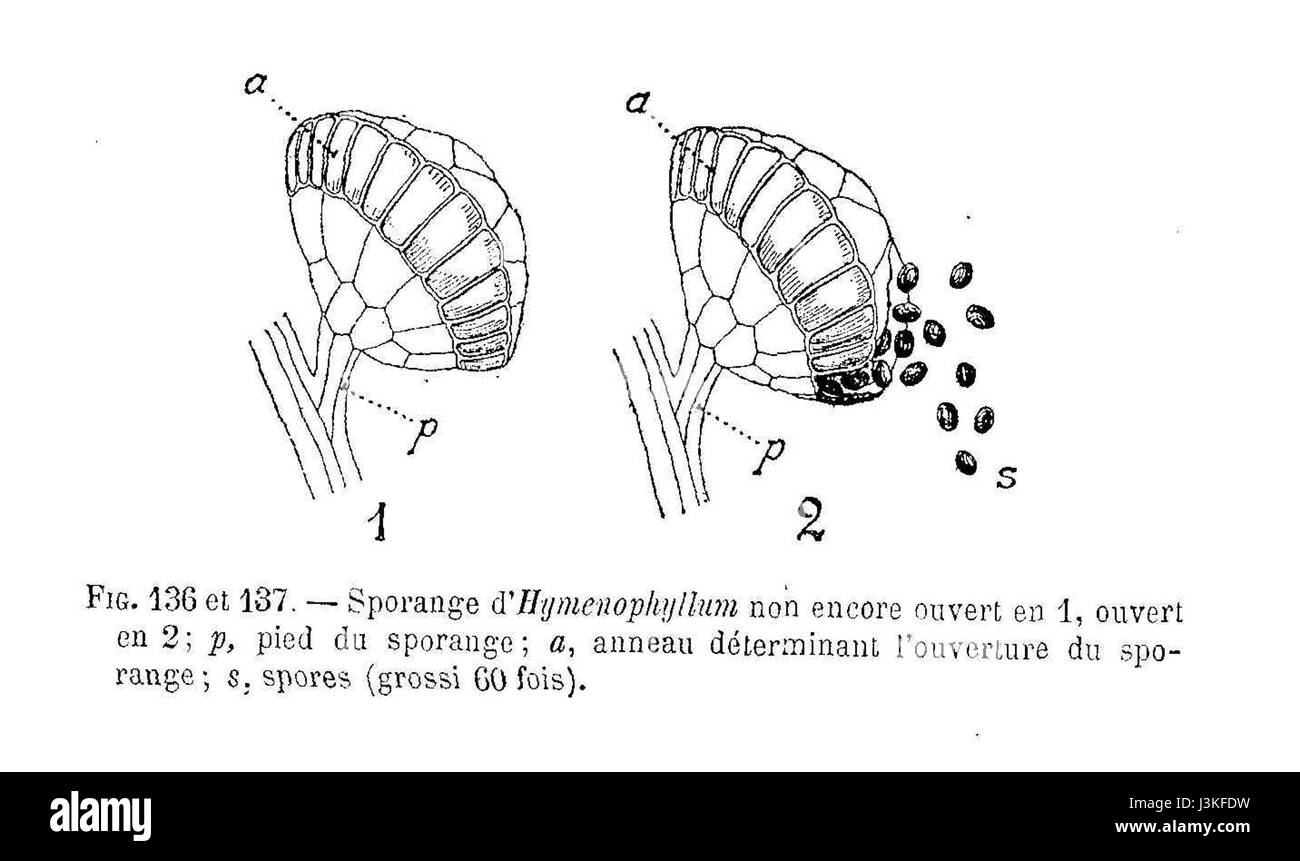 Hymenophyllum sporange Stock Photohttps://www.alamy.com/image-license-details/?v=1https://www.alamy.com/stock-photo-hymenophyllum-sporange-139956149.html
Hymenophyllum sporange Stock Photohttps://www.alamy.com/image-license-details/?v=1https://www.alamy.com/stock-photo-hymenophyllum-sporange-139956149.htmlRMJ3KFDW–Hymenophyllum sporange
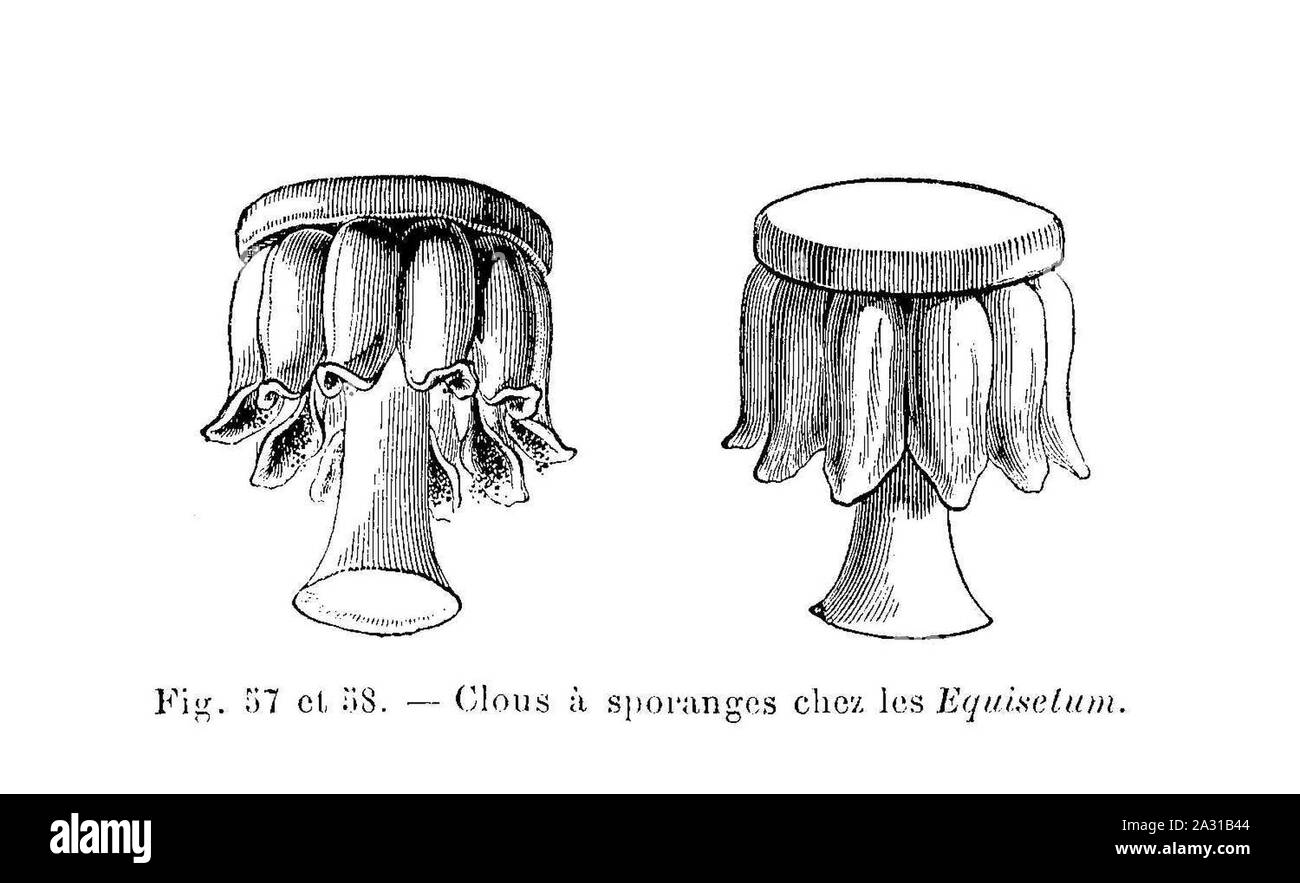 Equisetum - clou à sporange. Stock Photohttps://www.alamy.com/image-license-details/?v=1https://www.alamy.com/equisetum-clou-sporange-image328871652.html
Equisetum - clou à sporange. Stock Photohttps://www.alamy.com/image-license-details/?v=1https://www.alamy.com/equisetum-clou-sporange-image328871652.htmlRM2A31B44–Equisetum - clou à sporange.
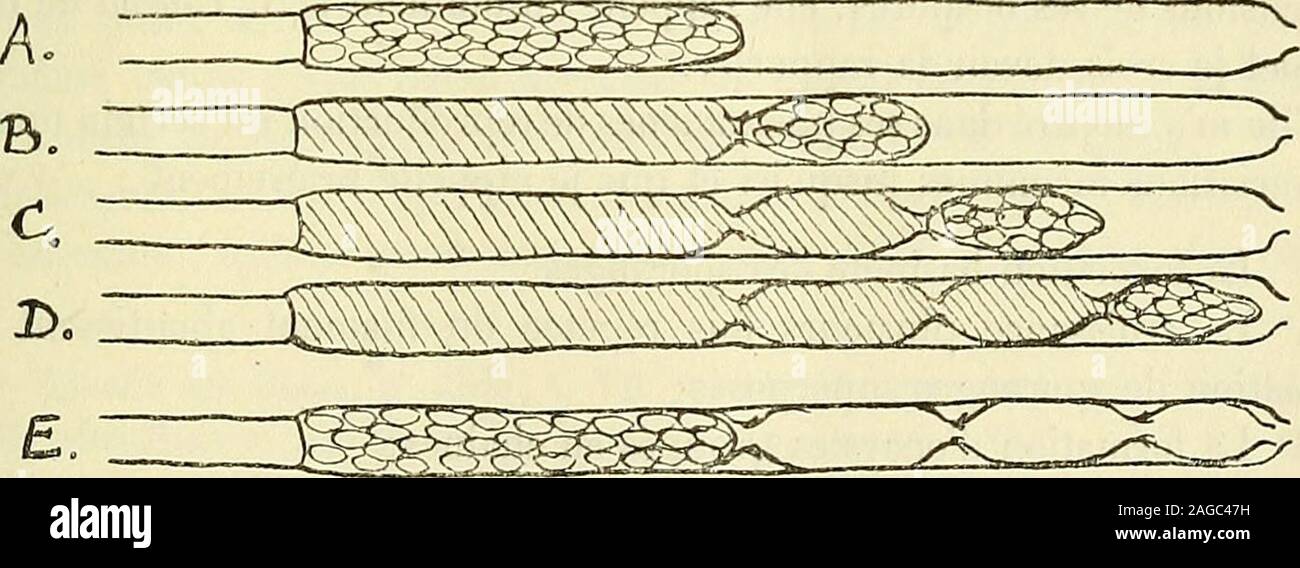 . Bulletin du Muséum national d'histoire naturelle. Fig. 3. — Saprolegnia Thureti : Formation des sporanges secondaires,superposés les uns aux autres. Ensuite un troisième et dernier sporange se forme comme lavait fait ledeuxième (fig. 3D). Quelquefois les trois sporanges ainsi produits peuvent demeurer à létatde repos durant un temps plus ou moins long (fig. 3 E). Transportésdans leau distdlée, ils produisent des spores et les évacuent lune aprèslautre (fig. 3 F). Troisième mode de formation des sporanges secondaires. Lorsque les sporanges primaires sont très allongés, les sporanges secon-dai Stock Photohttps://www.alamy.com/image-license-details/?v=1https://www.alamy.com/bulletin-du-musum-national-dhistoire-naturelle-fig-3-saprolegnia-thureti-formation-des-sporanges-secondairessuperposs-les-uns-aux-autres-ensuite-un-troisime-et-dernier-sporange-se-forme-comme-lavait-fait-ledeuxime-fig-3d-quelquefois-les-trois-sporanges-ainsi-produits-peuvent-demeurer-ltatde-repos-durant-un-temps-plus-ou-moins-long-fig-3-e-transportsdans-leau-distdle-ils-produisent-des-spores-et-les-vacuent-lune-aprslautre-fig-3-f-troisime-mode-de-formation-des-sporanges-secondaires-lorsque-les-sporanges-primaires-sont-trs-allongs-les-sporanges-secon-dai-image337098261.html
. Bulletin du Muséum national d'histoire naturelle. Fig. 3. — Saprolegnia Thureti : Formation des sporanges secondaires,superposés les uns aux autres. Ensuite un troisième et dernier sporange se forme comme lavait fait ledeuxième (fig. 3D). Quelquefois les trois sporanges ainsi produits peuvent demeurer à létatde repos durant un temps plus ou moins long (fig. 3 E). Transportésdans leau distdlée, ils produisent des spores et les évacuent lune aprèslautre (fig. 3 F). Troisième mode de formation des sporanges secondaires. Lorsque les sporanges primaires sont très allongés, les sporanges secon-dai Stock Photohttps://www.alamy.com/image-license-details/?v=1https://www.alamy.com/bulletin-du-musum-national-dhistoire-naturelle-fig-3-saprolegnia-thureti-formation-des-sporanges-secondairessuperposs-les-uns-aux-autres-ensuite-un-troisime-et-dernier-sporange-se-forme-comme-lavait-fait-ledeuxime-fig-3d-quelquefois-les-trois-sporanges-ainsi-produits-peuvent-demeurer-ltatde-repos-durant-un-temps-plus-ou-moins-long-fig-3-e-transportsdans-leau-distdle-ils-produisent-des-spores-et-les-vacuent-lune-aprslautre-fig-3-f-troisime-mode-de-formation-des-sporanges-secondaires-lorsque-les-sporanges-primaires-sont-trs-allongs-les-sporanges-secon-dai-image337098261.htmlRM2AGC47H–. Bulletin du Muséum national d'histoire naturelle. Fig. 3. — Saprolegnia Thureti : Formation des sporanges secondaires,superposés les uns aux autres. Ensuite un troisième et dernier sporange se forme comme lavait fait ledeuxième (fig. 3D). Quelquefois les trois sporanges ainsi produits peuvent demeurer à létatde repos durant un temps plus ou moins long (fig. 3 E). Transportésdans leau distdlée, ils produisent des spores et les évacuent lune aprèslautre (fig. 3 F). Troisième mode de formation des sporanges secondaires. Lorsque les sporanges primaires sont très allongés, les sporanges secon-dai
 Hymenophyllum - sporange. Stock Photohttps://www.alamy.com/image-license-details/?v=1https://www.alamy.com/hymenophyllum-sporange-image356433701.html
Hymenophyllum - sporange. Stock Photohttps://www.alamy.com/image-license-details/?v=1https://www.alamy.com/hymenophyllum-sporange-image356433701.htmlRM2BKTXR1–Hymenophyllum - sporange.
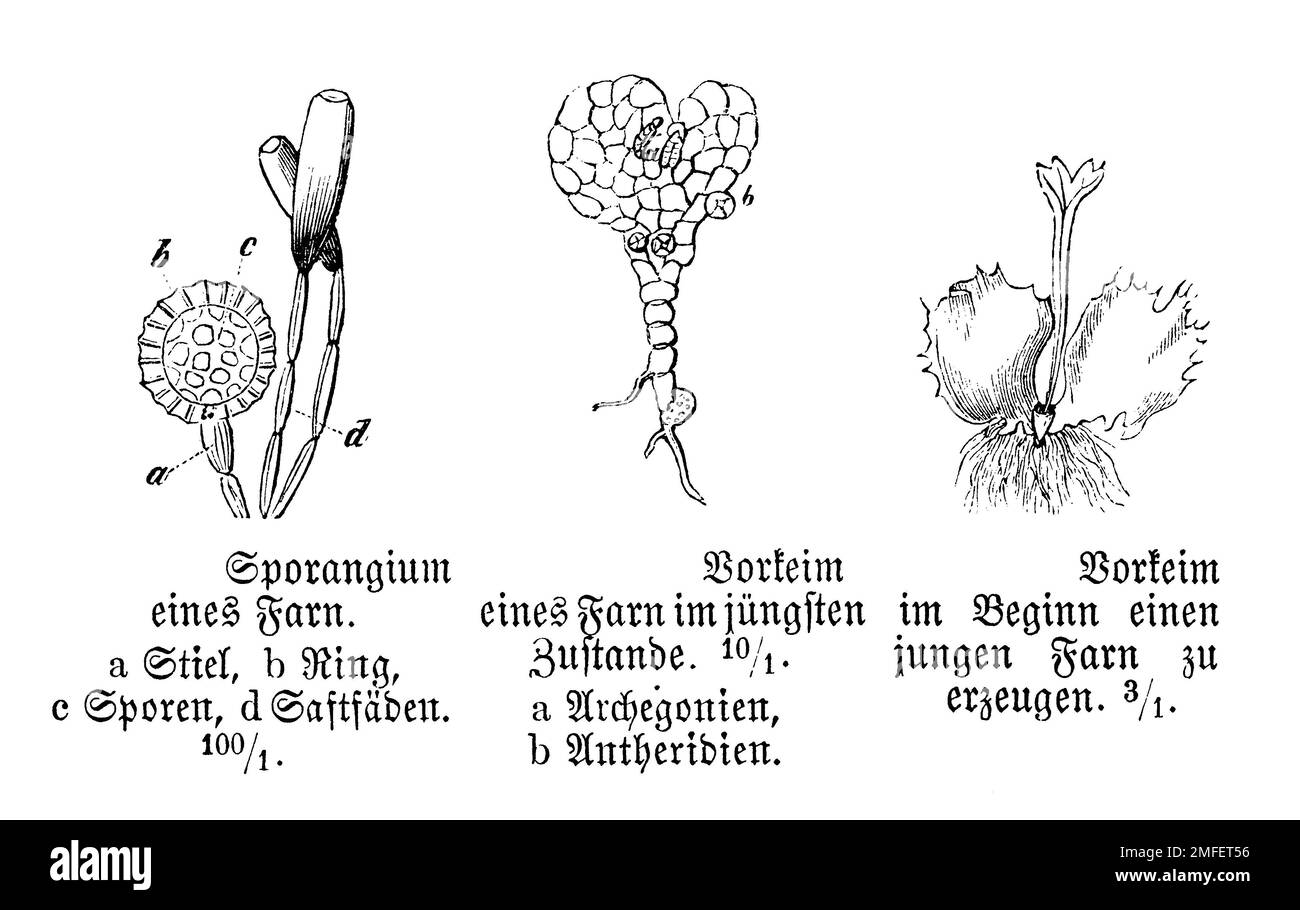 polypody, sporangium and pro-germ, Polypodium vulgare, anonym (biology book, 1893), Tüpfelfarn, Sporangium und Vorkeim, Polypode, sporange et pro-germe Stock Photohttps://www.alamy.com/image-license-details/?v=1https://www.alamy.com/polypody-sporangium-and-pro-germ-polypodium-vulgare-anonym-biology-book-1893-tpfelfarn-sporangium-und-vorkeim-polypode-sporange-et-pro-germe-image508646802.html
polypody, sporangium and pro-germ, Polypodium vulgare, anonym (biology book, 1893), Tüpfelfarn, Sporangium und Vorkeim, Polypode, sporange et pro-germe Stock Photohttps://www.alamy.com/image-license-details/?v=1https://www.alamy.com/polypody-sporangium-and-pro-germ-polypodium-vulgare-anonym-biology-book-1893-tpfelfarn-sporangium-und-vorkeim-polypode-sporange-et-pro-germe-image508646802.htmlRM2MFET56–polypody, sporangium and pro-germ, Polypodium vulgare, anonym (biology book, 1893), Tüpfelfarn, Sporangium und Vorkeim, Polypode, sporange et pro-germe
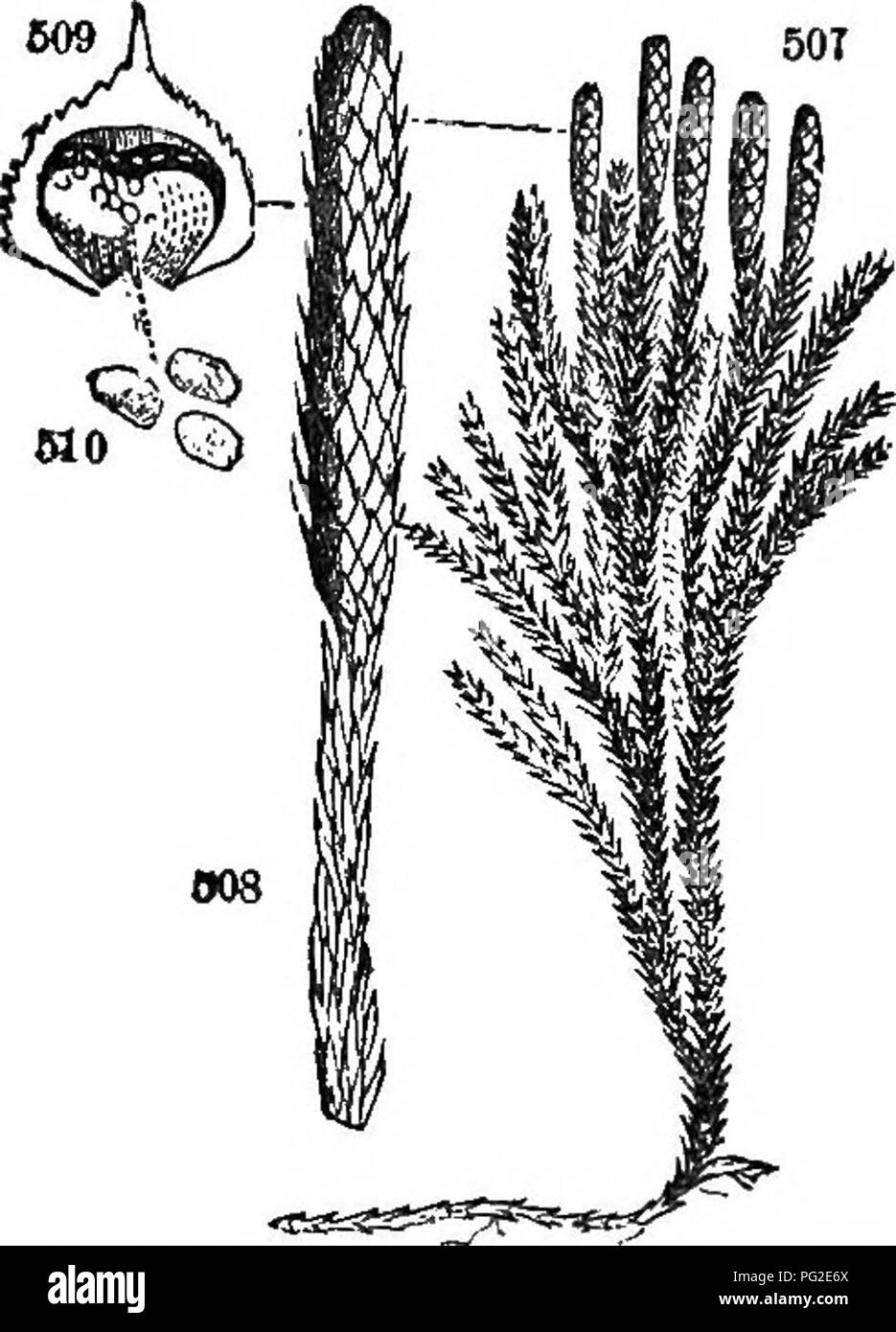 . Class-book of botany : being outlines of the structure, physiology, and classification of plants ; with a flora of the United States and Canada . Botany; Botany; Botany. 504 S06 002 603 502, Equiaetam arvense. 503, E. Bylvaticum. 504. Section of the spike. 505, A sporange. 506, A epore witli its elators coiled.. 807, Lycopodium dendroideum. 60S, A single spike. 609, a scale with Its sporange barsting. 510, Spores. 624. Classes. The tribe last mentioned are embraced in the class Acrogens, so named by Lindley from their manner of growth (anpov, point or summit), lengthening into an axis. The r Stock Photohttps://www.alamy.com/image-license-details/?v=1https://www.alamy.com/class-book-of-botany-being-outlines-of-the-structure-physiology-and-classification-of-plants-with-a-flora-of-the-united-states-and-canada-botany-botany-botany-504-s06-002-603-502-equiaetam-arvense-503-e-bylvaticum-504-section-of-the-spike-505-a-sporange-506-a-epore-witli-its-elators-coiled-807-lycopodium-dendroideum-60s-a-single-spike-609-a-scale-with-its-sporange-barsting-510-spores-624-classes-the-tribe-last-mentioned-are-embraced-in-the-class-acrogens-so-named-by-lindley-from-their-manner-of-growth-anpov-point-or-summit-lengthening-into-an-axis-the-r-image216413986.html
. Class-book of botany : being outlines of the structure, physiology, and classification of plants ; with a flora of the United States and Canada . Botany; Botany; Botany. 504 S06 002 603 502, Equiaetam arvense. 503, E. Bylvaticum. 504. Section of the spike. 505, A sporange. 506, A epore witli its elators coiled.. 807, Lycopodium dendroideum. 60S, A single spike. 609, a scale with Its sporange barsting. 510, Spores. 624. Classes. The tribe last mentioned are embraced in the class Acrogens, so named by Lindley from their manner of growth (anpov, point or summit), lengthening into an axis. The r Stock Photohttps://www.alamy.com/image-license-details/?v=1https://www.alamy.com/class-book-of-botany-being-outlines-of-the-structure-physiology-and-classification-of-plants-with-a-flora-of-the-united-states-and-canada-botany-botany-botany-504-s06-002-603-502-equiaetam-arvense-503-e-bylvaticum-504-section-of-the-spike-505-a-sporange-506-a-epore-witli-its-elators-coiled-807-lycopodium-dendroideum-60s-a-single-spike-609-a-scale-with-its-sporange-barsting-510-spores-624-classes-the-tribe-last-mentioned-are-embraced-in-the-class-acrogens-so-named-by-lindley-from-their-manner-of-growth-anpov-point-or-summit-lengthening-into-an-axis-the-r-image216413986.htmlRMPG2E6X–. Class-book of botany : being outlines of the structure, physiology, and classification of plants ; with a flora of the United States and Canada . Botany; Botany; Botany. 504 S06 002 603 502, Equiaetam arvense. 503, E. Bylvaticum. 504. Section of the spike. 505, A sporange. 506, A epore witli its elators coiled.. 807, Lycopodium dendroideum. 60S, A single spike. 609, a scale with Its sporange barsting. 510, Spores. 624. Classes. The tribe last mentioned are embraced in the class Acrogens, so named by Lindley from their manner of growth (anpov, point or summit), lengthening into an axis. The r
![. Dictionnaire d'horticulture illustré / par D. Bois préface de Maxime Cornu avec la collaboration de E. André ... [et al.]. . Fig. 56L. â Marattia Kaulfussii J. Sm. MARATTIA Smith. (Fougères, Marattiacées.) Plantes à frondes bi- ou tripinnées, portant inft. des sores constitués par des sporanges soudés, sur deux rangs, en un sporange unique, bivalve ou cyathiforme, à déhiscence fissurale. M. alata Sm. â Hook. Gen. Fil. 26. â Amér. trop. â Rhizome court. Frondes tripinnées, d'environ 50 cm., à stipe peu écailleux, à pin- nules oblongues, cunéiformes à la base, denti- culées, po Stock Photo . Dictionnaire d'horticulture illustré / par D. Bois préface de Maxime Cornu avec la collaboration de E. André ... [et al.]. . Fig. 56L. â Marattia Kaulfussii J. Sm. MARATTIA Smith. (Fougères, Marattiacées.) Plantes à frondes bi- ou tripinnées, portant inft. des sores constitués par des sporanges soudés, sur deux rangs, en un sporange unique, bivalve ou cyathiforme, à déhiscence fissurale. M. alata Sm. â Hook. Gen. Fil. 26. â Amér. trop. â Rhizome court. Frondes tripinnées, d'environ 50 cm., à stipe peu écailleux, à pin- nules oblongues, cunéiformes à la base, denti- culées, po Stock Photo](https://c8.alamy.com/comp/MEK1JG/dictionnaire-dhorticulture-illustr-par-d-bois-prface-de-maxime-cornu-avec-la-collaboration-de-e-andr-et-al-fig-56l-marattia-kaulfussii-j-sm-marattia-smith-fougres-marattiaces-plantes-frondes-bi-ou-tripinnes-portant-inft-des-sores-constitus-par-des-sporanges-souds-sur-deux-rangs-en-un-sporange-unique-bivalve-ou-cyathiforme-dhiscence-fissurale-m-alata-sm-hook-gen-fil-26-amr-trop-rhizome-court-frondes-tripinnes-denviron-50-cm-stipe-peu-cailleux-pin-nules-oblongues-cuniformes-la-base-denti-cules-po-MEK1JG.jpg) . Dictionnaire d'horticulture illustré / par D. Bois préface de Maxime Cornu avec la collaboration de E. André ... [et al.]. . Fig. 56L. â Marattia Kaulfussii J. Sm. MARATTIA Smith. (Fougères, Marattiacées.) Plantes à frondes bi- ou tripinnées, portant inft. des sores constitués par des sporanges soudés, sur deux rangs, en un sporange unique, bivalve ou cyathiforme, à déhiscence fissurale. M. alata Sm. â Hook. Gen. Fil. 26. â Amér. trop. â Rhizome court. Frondes tripinnées, d'environ 50 cm., à stipe peu écailleux, à pin- nules oblongues, cunéiformes à la base, denti- culées, po Stock Photohttps://www.alamy.com/image-license-details/?v=1https://www.alamy.com/dictionnaire-dhorticulture-illustr-par-d-bois-prface-de-maxime-cornu-avec-la-collaboration-de-e-andr-et-al-fig-56l-marattia-kaulfussii-j-sm-marattia-smith-fougres-marattiaces-plantes-frondes-bi-ou-tripinnes-portant-inft-des-sores-constitus-par-des-sporanges-souds-sur-deux-rangs-en-un-sporange-unique-bivalve-ou-cyathiforme-dhiscence-fissurale-m-alata-sm-hook-gen-fil-26-amr-trop-rhizome-court-frondes-tripinnes-denviron-50-cm-stipe-peu-cailleux-pin-nules-oblongues-cuniformes-la-base-denti-cules-po-image181127256.html
. Dictionnaire d'horticulture illustré / par D. Bois préface de Maxime Cornu avec la collaboration de E. André ... [et al.]. . Fig. 56L. â Marattia Kaulfussii J. Sm. MARATTIA Smith. (Fougères, Marattiacées.) Plantes à frondes bi- ou tripinnées, portant inft. des sores constitués par des sporanges soudés, sur deux rangs, en un sporange unique, bivalve ou cyathiforme, à déhiscence fissurale. M. alata Sm. â Hook. Gen. Fil. 26. â Amér. trop. â Rhizome court. Frondes tripinnées, d'environ 50 cm., à stipe peu écailleux, à pin- nules oblongues, cunéiformes à la base, denti- culées, po Stock Photohttps://www.alamy.com/image-license-details/?v=1https://www.alamy.com/dictionnaire-dhorticulture-illustr-par-d-bois-prface-de-maxime-cornu-avec-la-collaboration-de-e-andr-et-al-fig-56l-marattia-kaulfussii-j-sm-marattia-smith-fougres-marattiaces-plantes-frondes-bi-ou-tripinnes-portant-inft-des-sores-constitus-par-des-sporanges-souds-sur-deux-rangs-en-un-sporange-unique-bivalve-ou-cyathiforme-dhiscence-fissurale-m-alata-sm-hook-gen-fil-26-amr-trop-rhizome-court-frondes-tripinnes-denviron-50-cm-stipe-peu-cailleux-pin-nules-oblongues-cuniformes-la-base-denti-cules-po-image181127256.htmlRMMEK1JG–. Dictionnaire d'horticulture illustré / par D. Bois préface de Maxime Cornu avec la collaboration de E. André ... [et al.]. . Fig. 56L. â Marattia Kaulfussii J. Sm. MARATTIA Smith. (Fougères, Marattiacées.) Plantes à frondes bi- ou tripinnées, portant inft. des sores constitués par des sporanges soudés, sur deux rangs, en un sporange unique, bivalve ou cyathiforme, à déhiscence fissurale. M. alata Sm. â Hook. Gen. Fil. 26. â Amér. trop. â Rhizome court. Frondes tripinnées, d'environ 50 cm., à stipe peu écailleux, à pin- nules oblongues, cunéiformes à la base, denti- culées, po
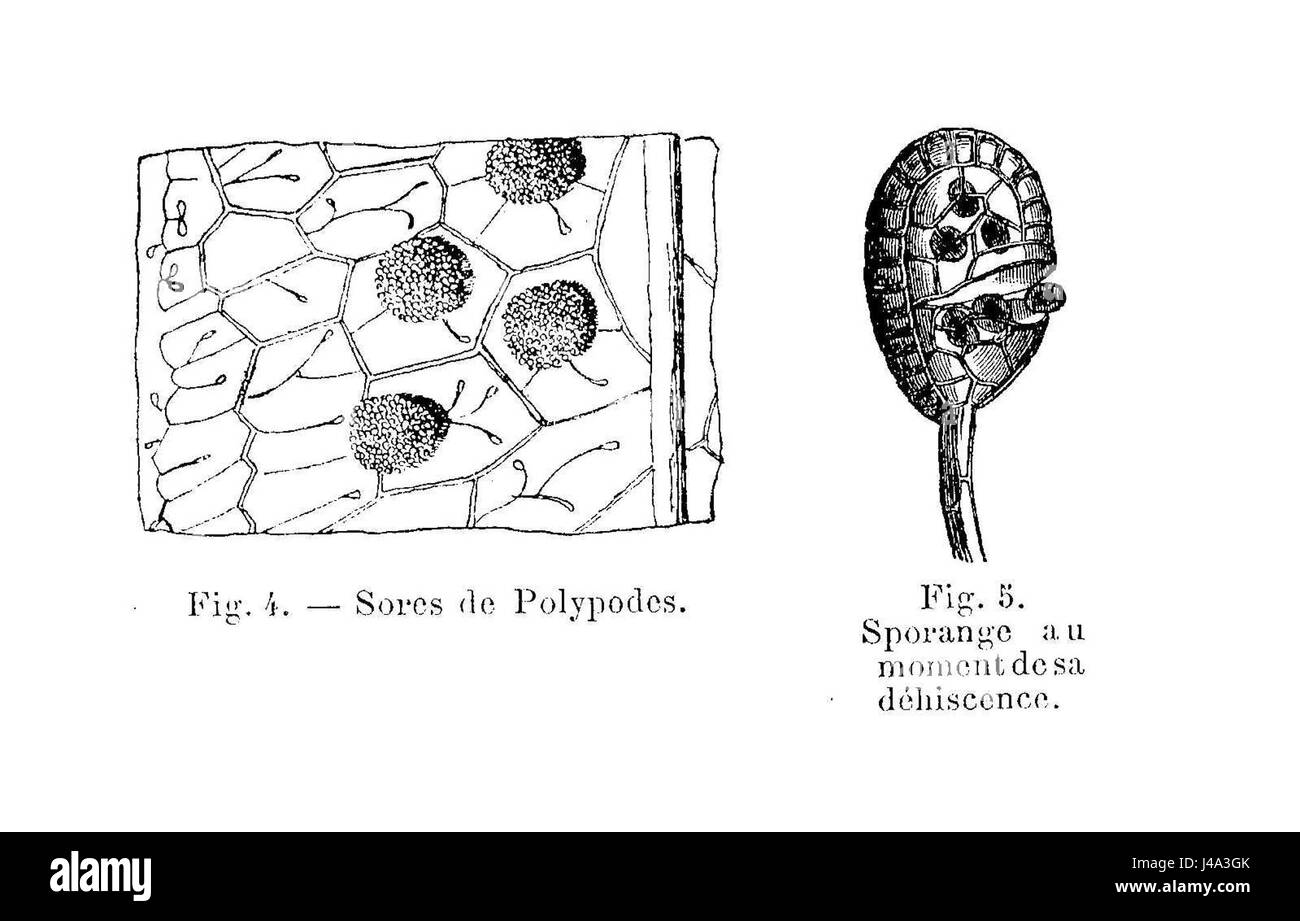 Polypodes sores & sporange Stock Photohttps://www.alamy.com/image-license-details/?v=1https://www.alamy.com/stock-photo-polypodes-sores-sporange-140363907.html
Polypodes sores & sporange Stock Photohttps://www.alamy.com/image-license-details/?v=1https://www.alamy.com/stock-photo-polypodes-sores-sporange-140363907.htmlRMJ4A3GK–Polypodes sores & sporange
![Revue des sciences naturelles . abularia Lamx, Neomeris Lamx, et enfin le Bornetella éioMi parM. Munier aux dépens de certaines espèces de Neomeris [N. nitidaHarv.),dans lesquelles la position du sporange est difFérentede celle quelleoccupe dans les Neomeris types. Le même savant sest occupé depuis des Ovulites, rangés jusque-làpar les paléontologistes parmi les Foraminifères monothalamiens. Ila reconnu que ces organismes sont encore des Algues Siphonées identiquesou très voisines des Coralliodendron [PeniciUus], des Espéra et desRhipocephahcs, qui vivent dans les mers chaudes ou tempérées. Le Stock Photo Revue des sciences naturelles . abularia Lamx, Neomeris Lamx, et enfin le Bornetella éioMi parM. Munier aux dépens de certaines espèces de Neomeris [N. nitidaHarv.),dans lesquelles la position du sporange est difFérentede celle quelleoccupe dans les Neomeris types. Le même savant sest occupé depuis des Ovulites, rangés jusque-làpar les paléontologistes parmi les Foraminifères monothalamiens. Ila reconnu que ces organismes sont encore des Algues Siphonées identiquesou très voisines des Coralliodendron [PeniciUus], des Espéra et desRhipocephahcs, qui vivent dans les mers chaudes ou tempérées. Le Stock Photo](https://c8.alamy.com/comp/2AX66DW/revue-des-sciences-naturelles-abularia-lamx-neomeris-lamx-et-enfin-le-bornetella-iomi-parm-munier-aux-dpens-de-certaines-espces-de-neomeris-n-nitidaharvdans-lesquelles-la-position-du-sporange-est-diffrentede-celle-quelleoccupe-dans-les-neomeris-types-le-mme-savant-sest-occup-depuis-des-ovulites-rangs-jusque-lpar-les-palontologistes-parmi-les-foraminifres-monothalamiens-ila-reconnu-que-ces-organismes-sont-encore-des-algues-siphones-identiquesou-trs-voisines-des-coralliodendron-peniciuus-des-espra-et-desrhipocephahcs-qui-vivent-dans-les-mers-chaudes-ou-tempres-le-2AX66DW.jpg) Revue des sciences naturelles . abularia Lamx, Neomeris Lamx, et enfin le Bornetella éioMi parM. Munier aux dépens de certaines espèces de Neomeris [N. nitidaHarv.),dans lesquelles la position du sporange est difFérentede celle quelleoccupe dans les Neomeris types. Le même savant sest occupé depuis des Ovulites, rangés jusque-làpar les paléontologistes parmi les Foraminifères monothalamiens. Ila reconnu que ces organismes sont encore des Algues Siphonées identiquesou très voisines des Coralliodendron [PeniciUus], des Espéra et desRhipocephahcs, qui vivent dans les mers chaudes ou tempérées. Le Stock Photohttps://www.alamy.com/image-license-details/?v=1https://www.alamy.com/revue-des-sciences-naturelles-abularia-lamx-neomeris-lamx-et-enfin-le-bornetella-iomi-parm-munier-aux-dpens-de-certaines-espces-de-neomeris-n-nitidaharvdans-lesquelles-la-position-du-sporange-est-diffrentede-celle-quelleoccupe-dans-les-neomeris-types-le-mme-savant-sest-occup-depuis-des-ovulites-rangs-jusque-lpar-les-palontologistes-parmi-les-foraminifres-monothalamiens-ila-reconnu-que-ces-organismes-sont-encore-des-algues-siphones-identiquesou-trs-voisines-des-coralliodendron-peniciuus-des-espra-et-desrhipocephahcs-qui-vivent-dans-les-mers-chaudes-ou-tempres-le-image343114853.html
Revue des sciences naturelles . abularia Lamx, Neomeris Lamx, et enfin le Bornetella éioMi parM. Munier aux dépens de certaines espèces de Neomeris [N. nitidaHarv.),dans lesquelles la position du sporange est difFérentede celle quelleoccupe dans les Neomeris types. Le même savant sest occupé depuis des Ovulites, rangés jusque-làpar les paléontologistes parmi les Foraminifères monothalamiens. Ila reconnu que ces organismes sont encore des Algues Siphonées identiquesou très voisines des Coralliodendron [PeniciUus], des Espéra et desRhipocephahcs, qui vivent dans les mers chaudes ou tempérées. Le Stock Photohttps://www.alamy.com/image-license-details/?v=1https://www.alamy.com/revue-des-sciences-naturelles-abularia-lamx-neomeris-lamx-et-enfin-le-bornetella-iomi-parm-munier-aux-dpens-de-certaines-espces-de-neomeris-n-nitidaharvdans-lesquelles-la-position-du-sporange-est-diffrentede-celle-quelleoccupe-dans-les-neomeris-types-le-mme-savant-sest-occup-depuis-des-ovulites-rangs-jusque-lpar-les-palontologistes-parmi-les-foraminifres-monothalamiens-ila-reconnu-que-ces-organismes-sont-encore-des-algues-siphones-identiquesou-trs-voisines-des-coralliodendron-peniciuus-des-espra-et-desrhipocephahcs-qui-vivent-dans-les-mers-chaudes-ou-tempres-le-image343114853.htmlRM2AX66DW–Revue des sciences naturelles . abularia Lamx, Neomeris Lamx, et enfin le Bornetella éioMi parM. Munier aux dépens de certaines espèces de Neomeris [N. nitidaHarv.),dans lesquelles la position du sporange est difFérentede celle quelleoccupe dans les Neomeris types. Le même savant sest occupé depuis des Ovulites, rangés jusque-làpar les paléontologistes parmi les Foraminifères monothalamiens. Ila reconnu que ces organismes sont encore des Algues Siphonées identiquesou très voisines des Coralliodendron [PeniciUus], des Espéra et desRhipocephahcs, qui vivent dans les mers chaudes ou tempérées. Le
 Equisetum - clou à sporange Stock Photohttps://www.alamy.com/image-license-details/?v=1https://www.alamy.com/stock-photo-equisetum-clou-sporange-147505903.html
Equisetum - clou à sporange Stock Photohttps://www.alamy.com/image-license-details/?v=1https://www.alamy.com/stock-photo-equisetum-clou-sporange-147505903.htmlRMJFYD7Y–Equisetum - clou à sporange
 Larousse universel en 2 volumes; nouveau dictionnaire encyclopédique publié sous la direction de Claude Augé . ris-po n m du prêtde sporange). Membram qui environne le i u*preproducteurs des fougères el plus communéim ûlappelée indusis. périsporiacées [ris-po, se a. f, pi Famille de champignons ascomycètes, i-acacleiis. s |i:ir unpérithèce meuibraneux, dont les asques ne commu? tiquent pas avec le milieu extérieur: la truffe estune péri sporiacée. périsprit [ris-pWJ n. m. (du préf, péri, el dulat. spiritus. esprit). Daprès les spirites, enveloppefluidique, qui sert de lien entre le corps el I Stock Photohttps://www.alamy.com/image-license-details/?v=1https://www.alamy.com/larousse-universel-en-2-volumes-nouveau-dictionnaire-encyclopdique-publi-sous-la-direction-de-claude-aug-ris-po-n-m-du-prtde-sporange-membram-qui-environne-le-i-upreproducteurs-des-fougres-el-plus-communim-lappele-indusis-prisporiaces-ris-po-se-a-f-pi-famille-de-champignons-ascomyctes-i-acacleiis-s-iir-unprithce-meuibraneux-dont-les-asques-ne-commu-tiquent-pas-avec-le-milieu-extrieur-la-truffe-estune-pri-sporiace-prisprit-ris-pwj-n-m-du-prf-pri-el-dulat-spiritus-esprit-daprs-les-spirites-enveloppefluidique-qui-sert-de-lien-entre-le-corps-el-i-image339341640.html
Larousse universel en 2 volumes; nouveau dictionnaire encyclopédique publié sous la direction de Claude Augé . ris-po n m du prêtde sporange). Membram qui environne le i u*preproducteurs des fougères el plus communéim ûlappelée indusis. périsporiacées [ris-po, se a. f, pi Famille de champignons ascomycètes, i-acacleiis. s |i:ir unpérithèce meuibraneux, dont les asques ne commu? tiquent pas avec le milieu extérieur: la truffe estune péri sporiacée. périsprit [ris-pWJ n. m. (du préf, péri, el dulat. spiritus. esprit). Daprès les spirites, enveloppefluidique, qui sert de lien entre le corps el I Stock Photohttps://www.alamy.com/image-license-details/?v=1https://www.alamy.com/larousse-universel-en-2-volumes-nouveau-dictionnaire-encyclopdique-publi-sous-la-direction-de-claude-aug-ris-po-n-m-du-prtde-sporange-membram-qui-environne-le-i-upreproducteurs-des-fougres-el-plus-communim-lappele-indusis-prisporiaces-ris-po-se-a-f-pi-famille-de-champignons-ascomyctes-i-acacleiis-s-iir-unprithce-meuibraneux-dont-les-asques-ne-commu-tiquent-pas-avec-le-milieu-extrieur-la-truffe-estune-pri-sporiace-prisprit-ris-pwj-n-m-du-prf-pri-el-dulat-spiritus-esprit-daprs-les-spirites-enveloppefluidique-qui-sert-de-lien-entre-le-corps-el-i-image339341640.htmlRM2AM29M8–Larousse universel en 2 volumes; nouveau dictionnaire encyclopédique publié sous la direction de Claude Augé . ris-po n m du prêtde sporange). Membram qui environne le i u*preproducteurs des fougères el plus communéim ûlappelée indusis. périsporiacées [ris-po, se a. f, pi Famille de champignons ascomycètes, i-acacleiis. s |i:ir unpérithèce meuibraneux, dont les asques ne commu? tiquent pas avec le milieu extérieur: la truffe estune péri sporiacée. périsprit [ris-pWJ n. m. (du préf, péri, el dulat. spiritus. esprit). Daprès les spirites, enveloppefluidique, qui sert de lien entre le corps el I
 . Mires de la Soci impale des sciences naturelles de Cherbourg. (Gross. de 230 diam.). Planche IV. Fig. 1, 2, 3. — Cruoria pellita Fries. — 1. Fragment de lacoupe transversale de la fronde. (Gross. de 73 diam.). —2. Deux filaments fructifères, lun portant un tétraspore,lautre un sporange vide. (Gross. de 230 diam.). On voitque les tétraspores sont latéraux et insérés immédiatementsur les filaments. Je ne les ai jamais trouvés pédicellés ,comme les représentent MM. lïarvcy (Nat. Hist. Review,IV, pi. XIII, B ) et Crouan ( Ann. se. natur. , 4^ série ,T. IX, pi. 3, fig. 3, B). — 3. Antliéridics. ( Stock Photohttps://www.alamy.com/image-license-details/?v=1https://www.alamy.com/mires-de-la-soci-impale-des-sciences-naturelles-de-cherbourg-gross-de-230-diam-planche-iv-fig-1-2-3-cruoria-pellita-fries-1-fragment-de-lacoupe-transversale-de-la-fronde-gross-de-73-diam-2-deux-filaments-fructifres-lun-portant-un-ttrasporelautre-un-sporange-vide-gross-de-230-diam-on-voitque-les-ttraspores-sont-latraux-et-insrs-immdiatementsur-les-filaments-je-ne-les-ai-jamais-trouvs-pdicells-comme-les-reprsentent-mm-larvcy-nat-hist-reviewiv-pi-xiii-b-et-crouan-ann-se-natur-4-srie-t-ix-pi-3-fig-3-b-3-antliridics-image336966513.html
. Mires de la Soci impale des sciences naturelles de Cherbourg. (Gross. de 230 diam.). Planche IV. Fig. 1, 2, 3. — Cruoria pellita Fries. — 1. Fragment de lacoupe transversale de la fronde. (Gross. de 73 diam.). —2. Deux filaments fructifères, lun portant un tétraspore,lautre un sporange vide. (Gross. de 230 diam.). On voitque les tétraspores sont latéraux et insérés immédiatementsur les filaments. Je ne les ai jamais trouvés pédicellés ,comme les représentent MM. lïarvcy (Nat. Hist. Review,IV, pi. XIII, B ) et Crouan ( Ann. se. natur. , 4^ série ,T. IX, pi. 3, fig. 3, B). — 3. Antliéridics. ( Stock Photohttps://www.alamy.com/image-license-details/?v=1https://www.alamy.com/mires-de-la-soci-impale-des-sciences-naturelles-de-cherbourg-gross-de-230-diam-planche-iv-fig-1-2-3-cruoria-pellita-fries-1-fragment-de-lacoupe-transversale-de-la-fronde-gross-de-73-diam-2-deux-filaments-fructifres-lun-portant-un-ttrasporelautre-un-sporange-vide-gross-de-230-diam-on-voitque-les-ttraspores-sont-latraux-et-insrs-immdiatementsur-les-filaments-je-ne-les-ai-jamais-trouvs-pdicells-comme-les-reprsentent-mm-larvcy-nat-hist-reviewiv-pi-xiii-b-et-crouan-ann-se-natur-4-srie-t-ix-pi-3-fig-3-b-3-antliridics-image336966513.htmlRM2AG6469–. Mires de la Soci impale des sciences naturelles de Cherbourg. (Gross. de 230 diam.). Planche IV. Fig. 1, 2, 3. — Cruoria pellita Fries. — 1. Fragment de lacoupe transversale de la fronde. (Gross. de 73 diam.). —2. Deux filaments fructifères, lun portant un tétraspore,lautre un sporange vide. (Gross. de 230 diam.). On voitque les tétraspores sont latéraux et insérés immédiatementsur les filaments. Je ne les ai jamais trouvés pédicellés ,comme les représentent MM. lïarvcy (Nat. Hist. Review,IV, pi. XIII, B ) et Crouan ( Ann. se. natur. , 4^ série ,T. IX, pi. 3, fig. 3, B). — 3. Antliéridics. (
 . The microscope and its revelations. ontinued over the summit of the sporange, so as to form a projectingring, which is known as the annulus (fig. 519). This ring has anelasticity superior to that of all the rest of the wall of the capsule,causing it to split across when mature, so that the contained sporesmay escape ; and in many instances the two halves of the sporange arecarried widely apart from each other, the fissure extending to such adepth as to separate them completely. In Osmunda (the so-called flowering fern or royal fern ) and Ophioglossum (adders tongue)the sporaiiges have no ann Stock Photohttps://www.alamy.com/image-license-details/?v=1https://www.alamy.com/the-microscope-and-its-revelations-ontinued-over-the-summit-of-the-sporange-so-as-to-form-a-projectingring-which-is-known-as-the-annulus-fig-519-this-ring-has-anelasticity-superior-to-that-of-all-the-rest-of-the-wall-of-the-capsulecausing-it-to-split-across-when-mature-so-that-the-contained-sporesmay-escape-and-in-many-instances-the-two-halves-of-the-sporange-arecarried-widely-apart-from-each-other-the-fissure-extending-to-such-adepth-as-to-separate-them-completely-in-osmunda-the-so-called-flowering-fern-or-royal-fern-and-ophioglossum-adders-tonguethe-sporaiiges-have-no-ann-image370782404.html
. The microscope and its revelations. ontinued over the summit of the sporange, so as to form a projectingring, which is known as the annulus (fig. 519). This ring has anelasticity superior to that of all the rest of the wall of the capsule,causing it to split across when mature, so that the contained sporesmay escape ; and in many instances the two halves of the sporange arecarried widely apart from each other, the fissure extending to such adepth as to separate them completely. In Osmunda (the so-called flowering fern or royal fern ) and Ophioglossum (adders tongue)the sporaiiges have no ann Stock Photohttps://www.alamy.com/image-license-details/?v=1https://www.alamy.com/the-microscope-and-its-revelations-ontinued-over-the-summit-of-the-sporange-so-as-to-form-a-projectingring-which-is-known-as-the-annulus-fig-519-this-ring-has-anelasticity-superior-to-that-of-all-the-rest-of-the-wall-of-the-capsulecausing-it-to-split-across-when-mature-so-that-the-contained-sporesmay-escape-and-in-many-instances-the-two-halves-of-the-sporange-arecarried-widely-apart-from-each-other-the-fissure-extending-to-such-adepth-as-to-separate-them-completely-in-osmunda-the-so-called-flowering-fern-or-royal-fern-and-ophioglossum-adders-tonguethe-sporaiiges-have-no-ann-image370782404.htmlRM2CF6GMM–. The microscope and its revelations. ontinued over the summit of the sporange, so as to form a projectingring, which is known as the annulus (fig. 519). This ring has anelasticity superior to that of all the rest of the wall of the capsule,causing it to split across when mature, so that the contained sporesmay escape ; and in many instances the two halves of the sporange arecarried widely apart from each other, the fissure extending to such adepth as to separate them completely. In Osmunda (the so-called flowering fern or royal fern ) and Ophioglossum (adders tongue)the sporaiiges have no ann
 . The microscope and its revelations. OF HIGHER CRYPTOGAMS it exhibits in different genera of mosses—varieties whose existenceand readiness of recognition render them characters of extreme valueto the systematic botanist, whilst they furnish objects of greatinterest and beauty for the microscopist. The peristome seemsalways to be originally double, one layer springing from the outer,and the other from the inner, of two layers of cells which may bealways distinguished in the immature sporange; but one or other ofthese is frequently wanting at the time of maturity, and sometimesboth are oblitera Stock Photohttps://www.alamy.com/image-license-details/?v=1https://www.alamy.com/the-microscope-and-its-revelations-of-higher-cryptogams-it-exhibits-in-different-genera-of-mossesvarieties-whose-existenceand-readiness-of-recognition-render-them-characters-of-extreme-valueto-the-systematic-botanist-whilst-they-furnish-objects-of-greatinterest-and-beauty-for-the-microscopist-the-peristome-seemsalways-to-be-originally-double-one-layer-springing-from-the-outerand-the-other-from-the-inner-of-two-layers-of-cells-which-may-bealways-distinguished-in-the-immature-sporange-but-one-or-other-ofthese-is-frequently-wanting-at-the-time-of-maturity-and-sometimesboth-are-oblitera-image370783062.html
. The microscope and its revelations. OF HIGHER CRYPTOGAMS it exhibits in different genera of mosses—varieties whose existenceand readiness of recognition render them characters of extreme valueto the systematic botanist, whilst they furnish objects of greatinterest and beauty for the microscopist. The peristome seemsalways to be originally double, one layer springing from the outer,and the other from the inner, of two layers of cells which may bealways distinguished in the immature sporange; but one or other ofthese is frequently wanting at the time of maturity, and sometimesboth are oblitera Stock Photohttps://www.alamy.com/image-license-details/?v=1https://www.alamy.com/the-microscope-and-its-revelations-of-higher-cryptogams-it-exhibits-in-different-genera-of-mossesvarieties-whose-existenceand-readiness-of-recognition-render-them-characters-of-extreme-valueto-the-systematic-botanist-whilst-they-furnish-objects-of-greatinterest-and-beauty-for-the-microscopist-the-peristome-seemsalways-to-be-originally-double-one-layer-springing-from-the-outerand-the-other-from-the-inner-of-two-layers-of-cells-which-may-bealways-distinguished-in-the-immature-sporange-but-one-or-other-ofthese-is-frequently-wanting-at-the-time-of-maturity-and-sometimesboth-are-oblitera-image370783062.htmlRM2CF6HG6–. The microscope and its revelations. OF HIGHER CRYPTOGAMS it exhibits in different genera of mosses—varieties whose existenceand readiness of recognition render them characters of extreme valueto the systematic botanist, whilst they furnish objects of greatinterest and beauty for the microscopist. The peristome seemsalways to be originally double, one layer springing from the outer,and the other from the inner, of two layers of cells which may bealways distinguished in the immature sporange; but one or other ofthese is frequently wanting at the time of maturity, and sometimesboth are oblitera
 . Paléontologie végétale cryptogames cellulaires et cryptogames vasculaires . même genre, on connaît une seule sorte despores, très petites, souvent encore groupées en tétrades,et très nombreuses dans chaque sporange. Il sembleinfiniment probable, néanmoins, que tous les Lepido-strobus ont dûêtrehétérosporés, et que, chez ceux dontil vient dêtre question, outre les microspores que Tonconnaît, il existait aussi des macrospores *. Lep. Veltheimianus. — Un exemple très net de stro-biles hétérosporés est fourni par les fructifications duLepidodendron Veltheirnianum Sternb. (LepidostrobusVelthei Stock Photohttps://www.alamy.com/image-license-details/?v=1https://www.alamy.com/paleontologie-vegetale-cryptogames-cellulaires-et-cryptogames-vasculaires-mme-genre-on-connat-une-seule-sorte-despores-trs-petites-souvent-encore-groupes-en-ttradeset-trs-nombreuses-dans-chaque-sporange-il-sembleinfiniment-probable-nanmoins-que-tous-les-lepido-strobus-ont-dtrehtrospors-et-que-chez-ceux-dontil-vient-dtre-question-outre-les-microspores-que-tonconnat-il-existait-aussi-des-macrospores-lep-veltheimianus-un-exemple-trs-net-de-stro-biles-htrospors-est-fourni-par-les-fructifications-dulepidodendron-veltheirnianum-sternb-lepidostrobusvelthei-image372346616.html
. Paléontologie végétale cryptogames cellulaires et cryptogames vasculaires . même genre, on connaît une seule sorte despores, très petites, souvent encore groupées en tétrades,et très nombreuses dans chaque sporange. Il sembleinfiniment probable, néanmoins, que tous les Lepido-strobus ont dûêtrehétérosporés, et que, chez ceux dontil vient dêtre question, outre les microspores que Tonconnaît, il existait aussi des macrospores *. Lep. Veltheimianus. — Un exemple très net de stro-biles hétérosporés est fourni par les fructifications duLepidodendron Veltheirnianum Sternb. (LepidostrobusVelthei Stock Photohttps://www.alamy.com/image-license-details/?v=1https://www.alamy.com/paleontologie-vegetale-cryptogames-cellulaires-et-cryptogames-vasculaires-mme-genre-on-connat-une-seule-sorte-despores-trs-petites-souvent-encore-groupes-en-ttradeset-trs-nombreuses-dans-chaque-sporange-il-sembleinfiniment-probable-nanmoins-que-tous-les-lepido-strobus-ont-dtrehtrospors-et-que-chez-ceux-dontil-vient-dtre-question-outre-les-microspores-que-tonconnat-il-existait-aussi-des-macrospores-lep-veltheimianus-un-exemple-trs-net-de-stro-biles-htrospors-est-fourni-par-les-fructifications-dulepidodendron-veltheirnianum-sternb-lepidostrobusvelthei-image372346616.htmlRM2CHNRWC–. Paléontologie végétale cryptogames cellulaires et cryptogames vasculaires . même genre, on connaît une seule sorte despores, très petites, souvent encore groupées en tétrades,et très nombreuses dans chaque sporange. Il sembleinfiniment probable, néanmoins, que tous les Lepido-strobus ont dûêtrehétérosporés, et que, chez ceux dontil vient dêtre question, outre les microspores que Tonconnaît, il existait aussi des macrospores *. Lep. Veltheimianus. — Un exemple très net de stro-biles hétérosporés est fourni par les fructifications duLepidodendron Veltheirnianum Sternb. (LepidostrobusVelthei
 . Paléontologie végétale cryptogames cellulaires et cryptogames vasculaires . l ; — 3, coupe schématique dun synangium (daprès Stur). B. Renaultia ; 1, pinnule fertile ; — 2, sporange isolé (daprès Zeiller). C. Dactylotheca : 1, pinnule fertile ; — 2, sporange isolé (daprès Zeiller). D. Sturiella ; coupe transversale dune pinnule montrant un synangium.— a, faisceau ligneux arqué de ladite pinnule; — c, poils; — 6, dt cel-lules différenciées en vue de la déhiscence des sporanges (daprès RenaultJ. E. Sore dOUgocarpia (daprès Stur). F. Crossotheca (microsporanges de Ptéridospermées) : daprès M Stock Photohttps://www.alamy.com/image-license-details/?v=1https://www.alamy.com/paleontologie-vegetale-cryptogames-cellulaires-et-cryptogames-vasculaires-l-3-coupe-schmatique-dun-synangium-daprs-stur-b-renaultia-1-pinnule-fertile-2-sporange-isol-daprs-zeiller-c-dactylotheca-1-pinnule-fertile-2-sporange-isol-daprs-zeiller-d-sturiella-coupe-transversale-dune-pinnule-montrant-un-synangium-a-faisceau-ligneux-arqu-de-ladite-pinnule-c-poils-6-dt-cel-lules-diffrencies-en-vue-de-la-dhiscence-des-sporanges-daprs-renaultj-e-sore-dougocarpia-daprs-stur-f-crossotheca-microsporanges-de-ptridospermes-daprs-m-image372318928.html
. Paléontologie végétale cryptogames cellulaires et cryptogames vasculaires . l ; — 3, coupe schématique dun synangium (daprès Stur). B. Renaultia ; 1, pinnule fertile ; — 2, sporange isolé (daprès Zeiller). C. Dactylotheca : 1, pinnule fertile ; — 2, sporange isolé (daprès Zeiller). D. Sturiella ; coupe transversale dune pinnule montrant un synangium.— a, faisceau ligneux arqué de ladite pinnule; — c, poils; — 6, dt cel-lules différenciées en vue de la déhiscence des sporanges (daprès RenaultJ. E. Sore dOUgocarpia (daprès Stur). F. Crossotheca (microsporanges de Ptéridospermées) : daprès M Stock Photohttps://www.alamy.com/image-license-details/?v=1https://www.alamy.com/paleontologie-vegetale-cryptogames-cellulaires-et-cryptogames-vasculaires-l-3-coupe-schmatique-dun-synangium-daprs-stur-b-renaultia-1-pinnule-fertile-2-sporange-isol-daprs-zeiller-c-dactylotheca-1-pinnule-fertile-2-sporange-isol-daprs-zeiller-d-sturiella-coupe-transversale-dune-pinnule-montrant-un-synangium-a-faisceau-ligneux-arqu-de-ladite-pinnule-c-poils-6-dt-cel-lules-diffrencies-en-vue-de-la-dhiscence-des-sporanges-daprs-renaultj-e-sore-dougocarpia-daprs-stur-f-crossotheca-microsporanges-de-ptridospermes-daprs-m-image372318928.htmlRM2CHMGGG–. Paléontologie végétale cryptogames cellulaires et cryptogames vasculaires . l ; — 3, coupe schématique dun synangium (daprès Stur). B. Renaultia ; 1, pinnule fertile ; — 2, sporange isolé (daprès Zeiller). C. Dactylotheca : 1, pinnule fertile ; — 2, sporange isolé (daprès Zeiller). D. Sturiella ; coupe transversale dune pinnule montrant un synangium.— a, faisceau ligneux arqué de ladite pinnule; — c, poils; — 6, dt cel-lules différenciées en vue de la déhiscence des sporanges (daprès RenaultJ. E. Sore dOUgocarpia (daprès Stur). F. Crossotheca (microsporanges de Ptéridospermées) : daprès M
![. Paléontologie végétale cryptogames cellulaires et cryptogames vasculaires . 7. ;— Se nfte nber g ici elegans Corda, du Westphalien deBohême. A, fragment de penne fertile ; — B, sporange isolé (daprès M. Zeiller). épaisseur unique de cellules dans cette calotte qui estexceptionnelle ]. Ainsi, les divers sporanges dont n a été question jus-quici semblent bien constituer une série continue, lesMarattiacées étant reliées aux Osmondacées par lesDiplolabis et les Discopteris, et les Osmondacées étantelles-mêmes reliées aux Schizéacées par les Senften-bergia. Klukia Raciborski. — Signalons encor Stock Photo . Paléontologie végétale cryptogames cellulaires et cryptogames vasculaires . 7. ;— Se nfte nber g ici elegans Corda, du Westphalien deBohême. A, fragment de penne fertile ; — B, sporange isolé (daprès M. Zeiller). épaisseur unique de cellules dans cette calotte qui estexceptionnelle ]. Ainsi, les divers sporanges dont n a été question jus-quici semblent bien constituer une série continue, lesMarattiacées étant reliées aux Osmondacées par lesDiplolabis et les Discopteris, et les Osmondacées étantelles-mêmes reliées aux Schizéacées par les Senften-bergia. Klukia Raciborski. — Signalons encor Stock Photo](https://c8.alamy.com/comp/2CHM40Y/paleontologie-vegetale-cryptogames-cellulaires-et-cryptogames-vasculaires-7-se-nfte-nber-g-ici-elegans-corda-du-westphalien-debohme-a-fragment-de-penne-fertile-b-sporange-isol-daprs-m-zeiller-paisseur-unique-de-cellules-dans-cette-calotte-qui-estexceptionnelle-ainsi-les-divers-sporanges-dont-n-a-t-question-jus-quici-semblent-bien-constituer-une-srie-continue-lesmarattiaces-tant-relies-aux-osmondaces-par-lesdiplolabis-et-les-discopteris-et-les-osmondaces-tantelles-mmes-relies-aux-schizaces-par-les-senften-bergia-klukia-raciborski-signalons-encor-2CHM40Y.jpg) . Paléontologie végétale cryptogames cellulaires et cryptogames vasculaires . 7. ;— Se nfte nber g ici elegans Corda, du Westphalien deBohême. A, fragment de penne fertile ; — B, sporange isolé (daprès M. Zeiller). épaisseur unique de cellules dans cette calotte qui estexceptionnelle ]. Ainsi, les divers sporanges dont n a été question jus-quici semblent bien constituer une série continue, lesMarattiacées étant reliées aux Osmondacées par lesDiplolabis et les Discopteris, et les Osmondacées étantelles-mêmes reliées aux Schizéacées par les Senften-bergia. Klukia Raciborski. — Signalons encor Stock Photohttps://www.alamy.com/image-license-details/?v=1https://www.alamy.com/paleontologie-vegetale-cryptogames-cellulaires-et-cryptogames-vasculaires-7-se-nfte-nber-g-ici-elegans-corda-du-westphalien-debohme-a-fragment-de-penne-fertile-b-sporange-isol-daprs-m-zeiller-paisseur-unique-de-cellules-dans-cette-calotte-qui-estexceptionnelle-ainsi-les-divers-sporanges-dont-n-a-t-question-jus-quici-semblent-bien-constituer-une-srie-continue-lesmarattiaces-tant-relies-aux-osmondaces-par-lesdiplolabis-et-les-discopteris-et-les-osmondaces-tantelles-mmes-relies-aux-schizaces-par-les-senften-bergia-klukia-raciborski-signalons-encor-image372309083.html
. Paléontologie végétale cryptogames cellulaires et cryptogames vasculaires . 7. ;— Se nfte nber g ici elegans Corda, du Westphalien deBohême. A, fragment de penne fertile ; — B, sporange isolé (daprès M. Zeiller). épaisseur unique de cellules dans cette calotte qui estexceptionnelle ]. Ainsi, les divers sporanges dont n a été question jus-quici semblent bien constituer une série continue, lesMarattiacées étant reliées aux Osmondacées par lesDiplolabis et les Discopteris, et les Osmondacées étantelles-mêmes reliées aux Schizéacées par les Senften-bergia. Klukia Raciborski. — Signalons encor Stock Photohttps://www.alamy.com/image-license-details/?v=1https://www.alamy.com/paleontologie-vegetale-cryptogames-cellulaires-et-cryptogames-vasculaires-7-se-nfte-nber-g-ici-elegans-corda-du-westphalien-debohme-a-fragment-de-penne-fertile-b-sporange-isol-daprs-m-zeiller-paisseur-unique-de-cellules-dans-cette-calotte-qui-estexceptionnelle-ainsi-les-divers-sporanges-dont-n-a-t-question-jus-quici-semblent-bien-constituer-une-srie-continue-lesmarattiaces-tant-relies-aux-osmondaces-par-lesdiplolabis-et-les-discopteris-et-les-osmondaces-tantelles-mmes-relies-aux-schizaces-par-les-senften-bergia-klukia-raciborski-signalons-encor-image372309083.htmlRM2CHM40Y–. Paléontologie végétale cryptogames cellulaires et cryptogames vasculaires . 7. ;— Se nfte nber g ici elegans Corda, du Westphalien deBohême. A, fragment de penne fertile ; — B, sporange isolé (daprès M. Zeiller). épaisseur unique de cellules dans cette calotte qui estexceptionnelle ]. Ainsi, les divers sporanges dont n a été question jus-quici semblent bien constituer une série continue, lesMarattiacées étant reliées aux Osmondacées par lesDiplolabis et les Discopteris, et les Osmondacées étantelles-mêmes reliées aux Schizéacées par les Senften-bergia. Klukia Raciborski. — Signalons encor
 . Paléontologie végétale cryptogames cellulaires et cryptogames vasculaires . Fig. 69. — A, Sore d} Oligocarpia Gnlbieri Gœppert, du Houiller de Saxe(daprès M Zeiller). — B, Oligocarpia lindsœoides Ettingshausen, sp., duHouiller de Bohême : sporange vu de profil (daprès Slur). dont les cellules, beaucoup plus grandes que celles dureste de la paroi, ont leurs membranes à peine plusépaissies que celles de ces dernières. Il est intéressant de constater que, dans le mondeactuel, chez les Mertensia glaucescens Willd., dichotomaWilld, Sieberi Près!., également, lanneau clés sporanges,au lieu dêtr Stock Photohttps://www.alamy.com/image-license-details/?v=1https://www.alamy.com/paleontologie-vegetale-cryptogames-cellulaires-et-cryptogames-vasculaires-fig-69-a-sore-d-oligocarpia-gnlbieri-gppert-du-houiller-de-saxedaprs-m-zeiller-b-oligocarpia-lindsoides-ettingshausen-sp-duhouiller-de-bohme-sporange-vu-de-profil-daprs-slur-dont-les-cellules-beaucoup-plus-grandes-que-celles-dureste-de-la-paroi-ont-leurs-membranes-peine-pluspaissies-que-celles-de-ces-dernires-il-est-intressant-de-constater-que-dans-le-mondeactuel-chez-les-mertensia-glaucescens-willd-dichotomawilld-sieberi-prs!-galement-lanneau-cls-sporangesau-lieu-dtr-image372307562.html
. Paléontologie végétale cryptogames cellulaires et cryptogames vasculaires . Fig. 69. — A, Sore d} Oligocarpia Gnlbieri Gœppert, du Houiller de Saxe(daprès M Zeiller). — B, Oligocarpia lindsœoides Ettingshausen, sp., duHouiller de Bohême : sporange vu de profil (daprès Slur). dont les cellules, beaucoup plus grandes que celles dureste de la paroi, ont leurs membranes à peine plusépaissies que celles de ces dernières. Il est intéressant de constater que, dans le mondeactuel, chez les Mertensia glaucescens Willd., dichotomaWilld, Sieberi Près!., également, lanneau clés sporanges,au lieu dêtr Stock Photohttps://www.alamy.com/image-license-details/?v=1https://www.alamy.com/paleontologie-vegetale-cryptogames-cellulaires-et-cryptogames-vasculaires-fig-69-a-sore-d-oligocarpia-gnlbieri-gppert-du-houiller-de-saxedaprs-m-zeiller-b-oligocarpia-lindsoides-ettingshausen-sp-duhouiller-de-bohme-sporange-vu-de-profil-daprs-slur-dont-les-cellules-beaucoup-plus-grandes-que-celles-dureste-de-la-paroi-ont-leurs-membranes-peine-pluspaissies-que-celles-de-ces-dernires-il-est-intressant-de-constater-que-dans-le-mondeactuel-chez-les-mertensia-glaucescens-willd-dichotomawilld-sieberi-prs!-galement-lanneau-cls-sporangesau-lieu-dtr-image372307562.htmlRM2CHM22J–. Paléontologie végétale cryptogames cellulaires et cryptogames vasculaires . Fig. 69. — A, Sore d} Oligocarpia Gnlbieri Gœppert, du Houiller de Saxe(daprès M Zeiller). — B, Oligocarpia lindsœoides Ettingshausen, sp., duHouiller de Bohême : sporange vu de profil (daprès Slur). dont les cellules, beaucoup plus grandes que celles dureste de la paroi, ont leurs membranes à peine plusépaissies que celles de ces dernières. Il est intéressant de constater que, dans le mondeactuel, chez les Mertensia glaucescens Willd., dichotomaWilld, Sieberi Près!., également, lanneau clés sporanges,au lieu dêtr
![. Paléontologie végétale cryptogames cellulaires et cryptogames vasculaires . Fig. 57. ;— Se nfte nber g ici elegans Corda, du Westphalien deBohême. A, fragment de penne fertile ; — B, sporange isolé (daprès M. Zeiller). épaisseur unique de cellules dans cette calotte qui estexceptionnelle ]. Ainsi, les divers sporanges dont n a été question jus-quici semblent bien constituer une série continue, lesMarattiacées étant reliées aux Osmondacées par lesDiplolabis et les Discopteris, et les Osmondacées étantelles-mêmes reliées aux Schizéacées par les Senften-bergia. Klukia Raciborski. — Signalons Stock Photo . Paléontologie végétale cryptogames cellulaires et cryptogames vasculaires . Fig. 57. ;— Se nfte nber g ici elegans Corda, du Westphalien deBohême. A, fragment de penne fertile ; — B, sporange isolé (daprès M. Zeiller). épaisseur unique de cellules dans cette calotte qui estexceptionnelle ]. Ainsi, les divers sporanges dont n a été question jus-quici semblent bien constituer une série continue, lesMarattiacées étant reliées aux Osmondacées par lesDiplolabis et les Discopteris, et les Osmondacées étantelles-mêmes reliées aux Schizéacées par les Senften-bergia. Klukia Raciborski. — Signalons Stock Photo](https://c8.alamy.com/comp/2CHM543/paleontologie-vegetale-cryptogames-cellulaires-et-cryptogames-vasculaires-fig-57-se-nfte-nber-g-ici-elegans-corda-du-westphalien-debohme-a-fragment-de-penne-fertile-b-sporange-isol-daprs-m-zeiller-paisseur-unique-de-cellules-dans-cette-calotte-qui-estexceptionnelle-ainsi-les-divers-sporanges-dont-n-a-t-question-jus-quici-semblent-bien-constituer-une-srie-continue-lesmarattiaces-tant-relies-aux-osmondaces-par-lesdiplolabis-et-les-discopteris-et-les-osmondaces-tantelles-mmes-relies-aux-schizaces-par-les-senften-bergia-klukia-raciborski-signalons-2CHM543.jpg) . Paléontologie végétale cryptogames cellulaires et cryptogames vasculaires . Fig. 57. ;— Se nfte nber g ici elegans Corda, du Westphalien deBohême. A, fragment de penne fertile ; — B, sporange isolé (daprès M. Zeiller). épaisseur unique de cellules dans cette calotte qui estexceptionnelle ]. Ainsi, les divers sporanges dont n a été question jus-quici semblent bien constituer une série continue, lesMarattiacées étant reliées aux Osmondacées par lesDiplolabis et les Discopteris, et les Osmondacées étantelles-mêmes reliées aux Schizéacées par les Senften-bergia. Klukia Raciborski. — Signalons Stock Photohttps://www.alamy.com/image-license-details/?v=1https://www.alamy.com/paleontologie-vegetale-cryptogames-cellulaires-et-cryptogames-vasculaires-fig-57-se-nfte-nber-g-ici-elegans-corda-du-westphalien-debohme-a-fragment-de-penne-fertile-b-sporange-isol-daprs-m-zeiller-paisseur-unique-de-cellules-dans-cette-calotte-qui-estexceptionnelle-ainsi-les-divers-sporanges-dont-n-a-t-question-jus-quici-semblent-bien-constituer-une-srie-continue-lesmarattiaces-tant-relies-aux-osmondaces-par-lesdiplolabis-et-les-discopteris-et-les-osmondaces-tantelles-mmes-relies-aux-schizaces-par-les-senften-bergia-klukia-raciborski-signalons-image372309955.html
. Paléontologie végétale cryptogames cellulaires et cryptogames vasculaires . Fig. 57. ;— Se nfte nber g ici elegans Corda, du Westphalien deBohême. A, fragment de penne fertile ; — B, sporange isolé (daprès M. Zeiller). épaisseur unique de cellules dans cette calotte qui estexceptionnelle ]. Ainsi, les divers sporanges dont n a été question jus-quici semblent bien constituer une série continue, lesMarattiacées étant reliées aux Osmondacées par lesDiplolabis et les Discopteris, et les Osmondacées étantelles-mêmes reliées aux Schizéacées par les Senften-bergia. Klukia Raciborski. — Signalons Stock Photohttps://www.alamy.com/image-license-details/?v=1https://www.alamy.com/paleontologie-vegetale-cryptogames-cellulaires-et-cryptogames-vasculaires-fig-57-se-nfte-nber-g-ici-elegans-corda-du-westphalien-debohme-a-fragment-de-penne-fertile-b-sporange-isol-daprs-m-zeiller-paisseur-unique-de-cellules-dans-cette-calotte-qui-estexceptionnelle-ainsi-les-divers-sporanges-dont-n-a-t-question-jus-quici-semblent-bien-constituer-une-srie-continue-lesmarattiaces-tant-relies-aux-osmondaces-par-lesdiplolabis-et-les-discopteris-et-les-osmondaces-tantelles-mmes-relies-aux-schizaces-par-les-senften-bergia-klukia-raciborski-signalons-image372309955.htmlRM2CHM543–. Paléontologie végétale cryptogames cellulaires et cryptogames vasculaires . Fig. 57. ;— Se nfte nber g ici elegans Corda, du Westphalien deBohême. A, fragment de penne fertile ; — B, sporange isolé (daprès M. Zeiller). épaisseur unique de cellules dans cette calotte qui estexceptionnelle ]. Ainsi, les divers sporanges dont n a été question jus-quici semblent bien constituer une série continue, lesMarattiacées étant reliées aux Osmondacées par lesDiplolabis et les Discopteris, et les Osmondacées étantelles-mêmes reliées aux Schizéacées par les Senften-bergia. Klukia Raciborski. — Signalons
 . Paléontologie végétale cryptogames cellulaires et cryptogames vasculaires . écemment % une norrvrelle espècede Sphenophyllum (S. char déformé) provenant de laveine Franziska, Hruschau, en Autriche, et caractériséepar ce fait que les parties fructifiées ny étaient pas dis-posées en épis. Chez cette espèce, les bractées fertilessupportaient au moins 2 sporangiophores, à lextré-mité desquels pendait, semble-t-il, un sporange unique,comme chez le S. cuneifolium (Bowmanites Dawsoni). II. — CHEIROSTROBÉES Avant de rechercher les affinités des Sphénophyliées, ilimporte détudier la famille des Ch Stock Photohttps://www.alamy.com/image-license-details/?v=1https://www.alamy.com/paleontologie-vegetale-cryptogames-cellulaires-et-cryptogames-vasculaires-cemment-une-norrvrelle-espcede-sphenophyllum-s-char-dform-provenant-de-laveine-franziska-hruschau-en-autriche-et-caractrisepar-ce-fait-que-les-parties-fructifies-ny-taient-pas-dis-poses-en-pis-chez-cette-espce-les-bractes-fertilessupportaient-au-moins-2-sporangiophores-lextr-mit-desquels-pendait-semble-t-il-un-sporange-uniquecomme-chez-le-s-cuneifolium-bowmanites-dawsoni-ii-cheirostrobes-avant-de-rechercher-les-affinits-des-sphnophylies-ilimporte-dtudier-la-famille-des-ch-image372350868.html
. Paléontologie végétale cryptogames cellulaires et cryptogames vasculaires . écemment % une norrvrelle espècede Sphenophyllum (S. char déformé) provenant de laveine Franziska, Hruschau, en Autriche, et caractériséepar ce fait que les parties fructifiées ny étaient pas dis-posées en épis. Chez cette espèce, les bractées fertilessupportaient au moins 2 sporangiophores, à lextré-mité desquels pendait, semble-t-il, un sporange unique,comme chez le S. cuneifolium (Bowmanites Dawsoni). II. — CHEIROSTROBÉES Avant de rechercher les affinités des Sphénophyliées, ilimporte détudier la famille des Ch Stock Photohttps://www.alamy.com/image-license-details/?v=1https://www.alamy.com/paleontologie-vegetale-cryptogames-cellulaires-et-cryptogames-vasculaires-cemment-une-norrvrelle-espcede-sphenophyllum-s-char-dform-provenant-de-laveine-franziska-hruschau-en-autriche-et-caractrisepar-ce-fait-que-les-parties-fructifies-ny-taient-pas-dis-poses-en-pis-chez-cette-espce-les-bractes-fertilessupportaient-au-moins-2-sporangiophores-lextr-mit-desquels-pendait-semble-t-il-un-sporange-uniquecomme-chez-le-s-cuneifolium-bowmanites-dawsoni-ii-cheirostrobes-avant-de-rechercher-les-affinits-des-sphnophylies-ilimporte-dtudier-la-famille-des-ch-image372350868.htmlRM2CHP198–. Paléontologie végétale cryptogames cellulaires et cryptogames vasculaires . écemment % une norrvrelle espècede Sphenophyllum (S. char déformé) provenant de laveine Franziska, Hruschau, en Autriche, et caractériséepar ce fait que les parties fructifiées ny étaient pas dis-posées en épis. Chez cette espèce, les bractées fertilessupportaient au moins 2 sporangiophores, à lextré-mité desquels pendait, semble-t-il, un sporange unique,comme chez le S. cuneifolium (Bowmanites Dawsoni). II. — CHEIROSTROBÉES Avant de rechercher les affinités des Sphénophyliées, ilimporte détudier la famille des Ch
 . Paléontologie végétale cryptogames cellulaires et cryptogames vasculaires . Fig. 60. — A gauche : Bolryopteris forensis B. Renault, du Sté- phanien.A, sporange vu de profil, et sectionné longitudinaleraent ; — B, sporange sectionné transversalement (a, bande de cellules différenciées en vue de la déhiscence). A droite : Zygopteris pinnata GrandEury du Stéphanien. A, groupe de sporanges ; — B, coupe transversale dun sporange (a, bande de cellules différenciées en vue de la déhiscence) (daprèsB. Renault). Ces deux bandes sétendent de la base du sporangeà son sommet, où elles ne se rejoignen Stock Photohttps://www.alamy.com/image-license-details/?v=1https://www.alamy.com/paleontologie-vegetale-cryptogames-cellulaires-et-cryptogames-vasculaires-fig-60-a-gauche-bolryopteris-forensis-b-renault-du-st-phaniena-sporange-vu-de-profil-et-sectionn-longitudinaleraent-b-sporange-sectionn-transversalement-a-bande-de-cellules-diffrencies-en-vue-de-la-dhiscence-a-droite-zygopteris-pinnata-grandeury-du-stphanien-a-groupe-de-sporanges-b-coupe-transversale-dun-sporange-a-bande-de-cellules-diffrencies-en-vue-de-la-dhiscence-daprsb-renault-ces-deux-bandes-stendent-de-la-base-du-sporange-son-sommet-o-elles-ne-se-rejoignen-image372306557.html
. Paléontologie végétale cryptogames cellulaires et cryptogames vasculaires . Fig. 60. — A gauche : Bolryopteris forensis B. Renault, du Sté- phanien.A, sporange vu de profil, et sectionné longitudinaleraent ; — B, sporange sectionné transversalement (a, bande de cellules différenciées en vue de la déhiscence). A droite : Zygopteris pinnata GrandEury du Stéphanien. A, groupe de sporanges ; — B, coupe transversale dun sporange (a, bande de cellules différenciées en vue de la déhiscence) (daprèsB. Renault). Ces deux bandes sétendent de la base du sporangeà son sommet, où elles ne se rejoignen Stock Photohttps://www.alamy.com/image-license-details/?v=1https://www.alamy.com/paleontologie-vegetale-cryptogames-cellulaires-et-cryptogames-vasculaires-fig-60-a-gauche-bolryopteris-forensis-b-renault-du-st-phaniena-sporange-vu-de-profil-et-sectionn-longitudinaleraent-b-sporange-sectionn-transversalement-a-bande-de-cellules-diffrencies-en-vue-de-la-dhiscence-a-droite-zygopteris-pinnata-grandeury-du-stphanien-a-groupe-de-sporanges-b-coupe-transversale-dun-sporange-a-bande-de-cellules-diffrencies-en-vue-de-la-dhiscence-daprsb-renault-ces-deux-bandes-stendent-de-la-base-du-sporange-son-sommet-o-elles-ne-se-rejoignen-image372306557.htmlRM2CHM0PN–. Paléontologie végétale cryptogames cellulaires et cryptogames vasculaires . Fig. 60. — A gauche : Bolryopteris forensis B. Renault, du Sté- phanien.A, sporange vu de profil, et sectionné longitudinaleraent ; — B, sporange sectionné transversalement (a, bande de cellules différenciées en vue de la déhiscence). A droite : Zygopteris pinnata GrandEury du Stéphanien. A, groupe de sporanges ; — B, coupe transversale dun sporange (a, bande de cellules différenciées en vue de la déhiscence) (daprèsB. Renault). Ces deux bandes sétendent de la base du sporangeà son sommet, où elles ne se rejoignen
 . Paléontologie végétale cryptogames cellulaires et cryptogames vasculaires . tées de poils unicellulaires plus ou moinssinueux. La présence de ces poils est particulièrementintéressante, car on ne la constatée que chez un nombrede Fougères extrêmement restreint. Le groupe de cellules dont il vient dêtre question seprolonge sur la face externe du sporange, jusque vers lemilieu de la hauteur de celui-ci, par une bandelongitudinale déléments à parois également épais-sies. Par la disposition de ses sporanges, ainsi que par la i. Renault, Cours de Botanique fossile, 3e année, p. 122-123, et pi. Stock Photohttps://www.alamy.com/image-license-details/?v=1https://www.alamy.com/paleontologie-vegetale-cryptogames-cellulaires-et-cryptogames-vasculaires-tes-de-poils-unicellulaires-plus-ou-moinssinueux-la-prsence-de-ces-poils-est-particulirementintressante-car-on-ne-la-constate-que-chez-un-nombrede-fougres-extrmement-restreint-le-groupe-de-cellules-dont-il-vient-dtre-question-seprolonge-sur-la-face-externe-du-sporange-jusque-vers-lemilieu-de-la-hauteur-de-celui-ci-par-une-bandelongitudinale-dlments-parois-galement-pais-sies-par-la-disposition-de-ses-sporanges-ainsi-que-par-la-i-renault-cours-de-botanique-fossile-3e-anne-p-122-123-et-pi-image372315903.html
. Paléontologie végétale cryptogames cellulaires et cryptogames vasculaires . tées de poils unicellulaires plus ou moinssinueux. La présence de ces poils est particulièrementintéressante, car on ne la constatée que chez un nombrede Fougères extrêmement restreint. Le groupe de cellules dont il vient dêtre question seprolonge sur la face externe du sporange, jusque vers lemilieu de la hauteur de celui-ci, par une bandelongitudinale déléments à parois également épais-sies. Par la disposition de ses sporanges, ainsi que par la i. Renault, Cours de Botanique fossile, 3e année, p. 122-123, et pi. Stock Photohttps://www.alamy.com/image-license-details/?v=1https://www.alamy.com/paleontologie-vegetale-cryptogames-cellulaires-et-cryptogames-vasculaires-tes-de-poils-unicellulaires-plus-ou-moinssinueux-la-prsence-de-ces-poils-est-particulirementintressante-car-on-ne-la-constate-que-chez-un-nombrede-fougres-extrmement-restreint-le-groupe-de-cellules-dont-il-vient-dtre-question-seprolonge-sur-la-face-externe-du-sporange-jusque-vers-lemilieu-de-la-hauteur-de-celui-ci-par-une-bandelongitudinale-dlments-parois-galement-pais-sies-par-la-disposition-de-ses-sporanges-ainsi-que-par-la-i-renault-cours-de-botanique-fossile-3e-anne-p-122-123-et-pi-image372315903.htmlRM2CHMCMF–. Paléontologie végétale cryptogames cellulaires et cryptogames vasculaires . tées de poils unicellulaires plus ou moinssinueux. La présence de ces poils est particulièrementintéressante, car on ne la constatée que chez un nombrede Fougères extrêmement restreint. Le groupe de cellules dont il vient dêtre question seprolonge sur la face externe du sporange, jusque vers lemilieu de la hauteur de celui-ci, par une bandelongitudinale déléments à parois également épais-sies. Par la disposition de ses sporanges, ainsi que par la i. Renault, Cours de Botanique fossile, 3e année, p. 122-123, et pi.
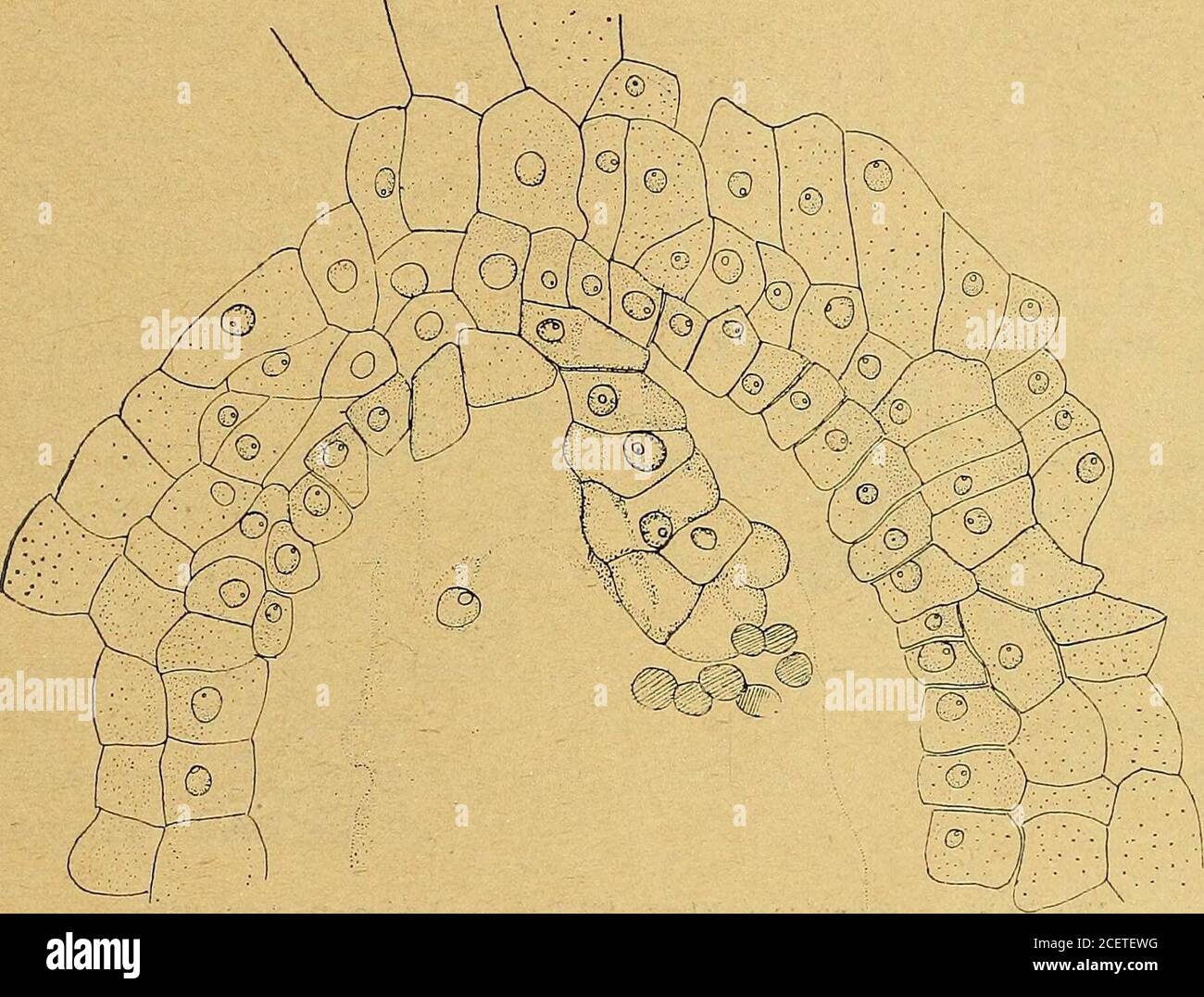 . Bulletin de la Société botanique de Genève. Fig. 22 bis — Symplocos Klotzschii Brd. —Ovule enveloppé par le tégument, avec tétra-sporange, dont la mégaspore commence à sedifférencier. Nous avons rencontré des embryons adventifs qui paraissaientprocéder des cellules du tégument. Le fruit est une espèce de drupe au début, puis la paroi formée parPhypanthium se sclérifie. Il y a une ou deux semences à albumenréduit. Nous avons fait cette recherche embryologique dans le but de (43) M. CHIRT01U. LACISTEMACEES ET SYMPLOCACÉES 359 préciser les affinités des Symplocos avec les autres Gamopétales ou Stock Photohttps://www.alamy.com/image-license-details/?v=1https://www.alamy.com/bulletin-de-la-socit-botanique-de-genve-fig-22-bis-symplocos-klotzschii-brd-ovule-envelopp-par-le-tgument-avec-ttra-sporange-dont-la-mgaspore-commence-sediffrencier-nous-avons-rencontr-des-embryons-adventifs-qui-paraissaientprocder-des-cellules-du-tgument-le-fruit-est-une-espce-de-drupe-au-dbut-puis-la-paroi-forme-parphypanthium-se-sclrifie-il-y-a-une-ou-deux-semences-albumenrduit-nous-avons-fait-cette-recherche-embryologique-dans-le-but-de-43-m-chirt01u-lacistemacees-et-symplocaces-359-prciser-les-affinits-des-symplocos-avec-les-autres-gamoptales-ou-image370561452.html
. Bulletin de la Société botanique de Genève. Fig. 22 bis — Symplocos Klotzschii Brd. —Ovule enveloppé par le tégument, avec tétra-sporange, dont la mégaspore commence à sedifférencier. Nous avons rencontré des embryons adventifs qui paraissaientprocéder des cellules du tégument. Le fruit est une espèce de drupe au début, puis la paroi formée parPhypanthium se sclérifie. Il y a une ou deux semences à albumenréduit. Nous avons fait cette recherche embryologique dans le but de (43) M. CHIRT01U. LACISTEMACEES ET SYMPLOCACÉES 359 préciser les affinités des Symplocos avec les autres Gamopétales ou Stock Photohttps://www.alamy.com/image-license-details/?v=1https://www.alamy.com/bulletin-de-la-socit-botanique-de-genve-fig-22-bis-symplocos-klotzschii-brd-ovule-envelopp-par-le-tgument-avec-ttra-sporange-dont-la-mgaspore-commence-sediffrencier-nous-avons-rencontr-des-embryons-adventifs-qui-paraissaientprocder-des-cellules-du-tgument-le-fruit-est-une-espce-de-drupe-au-dbut-puis-la-paroi-forme-parphypanthium-se-sclrifie-il-y-a-une-ou-deux-semences-albumenrduit-nous-avons-fait-cette-recherche-embryologique-dans-le-but-de-43-m-chirt01u-lacistemacees-et-symplocaces-359-prciser-les-affinits-des-symplocos-avec-les-autres-gamoptales-ou-image370561452.htmlRM2CETEWG–. Bulletin de la Société botanique de Genève. Fig. 22 bis — Symplocos Klotzschii Brd. —Ovule enveloppé par le tégument, avec tétra-sporange, dont la mégaspore commence à sedifférencier. Nous avons rencontré des embryons adventifs qui paraissaientprocéder des cellules du tégument. Le fruit est une espèce de drupe au début, puis la paroi formée parPhypanthium se sclérifie. Il y a une ou deux semences à albumenréduit. Nous avons fait cette recherche embryologique dans le but de (43) M. CHIRT01U. LACISTEMACEES ET SYMPLOCACÉES 359 préciser les affinités des Symplocos avec les autres Gamopétales ou
 . Paléontologie végétale cryptogames cellulaires et cryptogames vasculaires . rieur de chaque sporange,partant de sa ligne dinsertion sur le sporophylle, unebande de tissu stérile qui se dichotomise fréquemment àson extrémité supérieure. Les microspores, très nombreuses dans chaque mi-crosporange, nont jamais plus de o mm. 02 de dia-mètre. Quant aux macrospores, elles ont toujours undiamètre dau moins o mm. 8; leur nombre, danschaque macrosporange, peut avoir été de huit seulement ;en tout cas, il na certainement pas dépassé seize 1. Chacune delles présente, à lexamen microscopique,une memb Stock Photohttps://www.alamy.com/image-license-details/?v=1https://www.alamy.com/paleontologie-vegetale-cryptogames-cellulaires-et-cryptogames-vasculaires-rieur-de-chaque-sporangepartant-de-sa-ligne-dinsertion-sur-le-sporophylle-unebande-de-tissu-strile-qui-se-dichotomise-frquemment-son-extrmit-suprieure-les-microspores-trs-nombreuses-dans-chaque-mi-crosporange-nont-jamais-plus-de-o-mm-02-de-dia-mtre-quant-aux-macrospores-elles-ont-toujours-undiamtre-dau-moins-o-mm-8-leur-nombre-danschaque-macrosporange-peut-avoir-t-de-huit-seulement-en-tout-cas-il-na-certainement-pas-dpass-seize-1-chacune-delles-prsente-lexamen-microscopiqueune-memb-image372345222.html
. Paléontologie végétale cryptogames cellulaires et cryptogames vasculaires . rieur de chaque sporange,partant de sa ligne dinsertion sur le sporophylle, unebande de tissu stérile qui se dichotomise fréquemment àson extrémité supérieure. Les microspores, très nombreuses dans chaque mi-crosporange, nont jamais plus de o mm. 02 de dia-mètre. Quant aux macrospores, elles ont toujours undiamètre dau moins o mm. 8; leur nombre, danschaque macrosporange, peut avoir été de huit seulement ;en tout cas, il na certainement pas dépassé seize 1. Chacune delles présente, à lexamen microscopique,une memb Stock Photohttps://www.alamy.com/image-license-details/?v=1https://www.alamy.com/paleontologie-vegetale-cryptogames-cellulaires-et-cryptogames-vasculaires-rieur-de-chaque-sporangepartant-de-sa-ligne-dinsertion-sur-le-sporophylle-unebande-de-tissu-strile-qui-se-dichotomise-frquemment-son-extrmit-suprieure-les-microspores-trs-nombreuses-dans-chaque-mi-crosporange-nont-jamais-plus-de-o-mm-02-de-dia-mtre-quant-aux-macrospores-elles-ont-toujours-undiamtre-dau-moins-o-mm-8-leur-nombre-danschaque-macrosporange-peut-avoir-t-de-huit-seulement-en-tout-cas-il-na-certainement-pas-dpass-seize-1-chacune-delles-prsente-lexamen-microscopiqueune-memb-image372345222.htmlRM2CHNP3J–. Paléontologie végétale cryptogames cellulaires et cryptogames vasculaires . rieur de chaque sporange,partant de sa ligne dinsertion sur le sporophylle, unebande de tissu stérile qui se dichotomise fréquemment àson extrémité supérieure. Les microspores, très nombreuses dans chaque mi-crosporange, nont jamais plus de o mm. 02 de dia-mètre. Quant aux macrospores, elles ont toujours undiamètre dau moins o mm. 8; leur nombre, danschaque macrosporange, peut avoir été de huit seulement ;en tout cas, il na certainement pas dépassé seize 1. Chacune delles présente, à lexamen microscopique,une memb
 . Bulletin de la Société botanique de Genève . r. 7-8 fi largeur 5-8 ju 5-6 rr. Chlamydospores . . longueui 20-30 fj, 10-30 ir. largeur 10-20 u 9-20 //. Ces deux Mucors ont des sporangiophores formant un ga/on s(rr(.ramifié irrégulièrement en grappes. Ces ramifications, très inégales,sont terminées, chez le Mucor lufii/anicua, par des sporanges ou dessporangioles et sont quelquefois un pcn circiuées (fig. 1, 5, 7, 17).La membrane du sporange nest pas diflliiente, mais 1res fragile etlaisse une collerette (fig. 1-6). Elle est ornée de lincs incnisialions.Les columelles sont libres, s|)héiiques Stock Photohttps://www.alamy.com/image-license-details/?v=1https://www.alamy.com/bulletin-de-la-socit-botanique-de-genve-r-7-8-fi-largeur-5-8-ju-5-6-rr-chlamydospores-longueui-20-30-fj-10-30-ir-largeur-10-20-u-9-20-ces-deux-mucors-ont-des-sporangiophores-formant-un-gaon-srrramifi-irrgulirement-en-grappes-ces-ramifications-trs-ingalessont-termines-chez-le-mucor-lufiianicua-par-des-sporanges-ou-dessporangioles-et-sont-quelquefois-un-pcn-circiues-fig-1-5-7-17la-membrane-du-sporange-nest-pas-diflliiente-mais-1res-fragile-etlaisse-une-collerette-fig-1-6-elle-est-orne-de-lincs-incnisialionsles-columelles-sont-libres-shiiques-image370118529.html
. Bulletin de la Société botanique de Genève . r. 7-8 fi largeur 5-8 ju 5-6 rr. Chlamydospores . . longueui 20-30 fj, 10-30 ir. largeur 10-20 u 9-20 //. Ces deux Mucors ont des sporangiophores formant un ga/on s(rr(.ramifié irrégulièrement en grappes. Ces ramifications, très inégales,sont terminées, chez le Mucor lufii/anicua, par des sporanges ou dessporangioles et sont quelquefois un pcn circiuées (fig. 1, 5, 7, 17).La membrane du sporange nest pas diflliiente, mais 1res fragile etlaisse une collerette (fig. 1-6). Elle est ornée de lincs incnisialions.Les columelles sont libres, s|)héiiques Stock Photohttps://www.alamy.com/image-license-details/?v=1https://www.alamy.com/bulletin-de-la-socit-botanique-de-genve-r-7-8-fi-largeur-5-8-ju-5-6-rr-chlamydospores-longueui-20-30-fj-10-30-ir-largeur-10-20-u-9-20-ces-deux-mucors-ont-des-sporangiophores-formant-un-gaon-srrramifi-irrgulirement-en-grappes-ces-ramifications-trs-ingalessont-termines-chez-le-mucor-lufiianicua-par-des-sporanges-ou-dessporangioles-et-sont-quelquefois-un-pcn-circiues-fig-1-5-7-17la-membrane-du-sporange-nest-pas-diflliiente-mais-1res-fragile-etlaisse-une-collerette-fig-1-6-elle-est-orne-de-lincs-incnisialionsles-columelles-sont-libres-shiiques-image370118529.htmlRM2CE49XW–. Bulletin de la Société botanique de Genève . r. 7-8 fi largeur 5-8 ju 5-6 rr. Chlamydospores . . longueui 20-30 fj, 10-30 ir. largeur 10-20 u 9-20 //. Ces deux Mucors ont des sporangiophores formant un ga/on s(rr(.ramifié irrégulièrement en grappes. Ces ramifications, très inégales,sont terminées, chez le Mucor lufii/anicua, par des sporanges ou dessporangioles et sont quelquefois un pcn circiuées (fig. 1, 5, 7, 17).La membrane du sporange nest pas diflliiente, mais 1res fragile etlaisse une collerette (fig. 1-6). Elle est ornée de lincs incnisialions.Les columelles sont libres, s|)héiiques
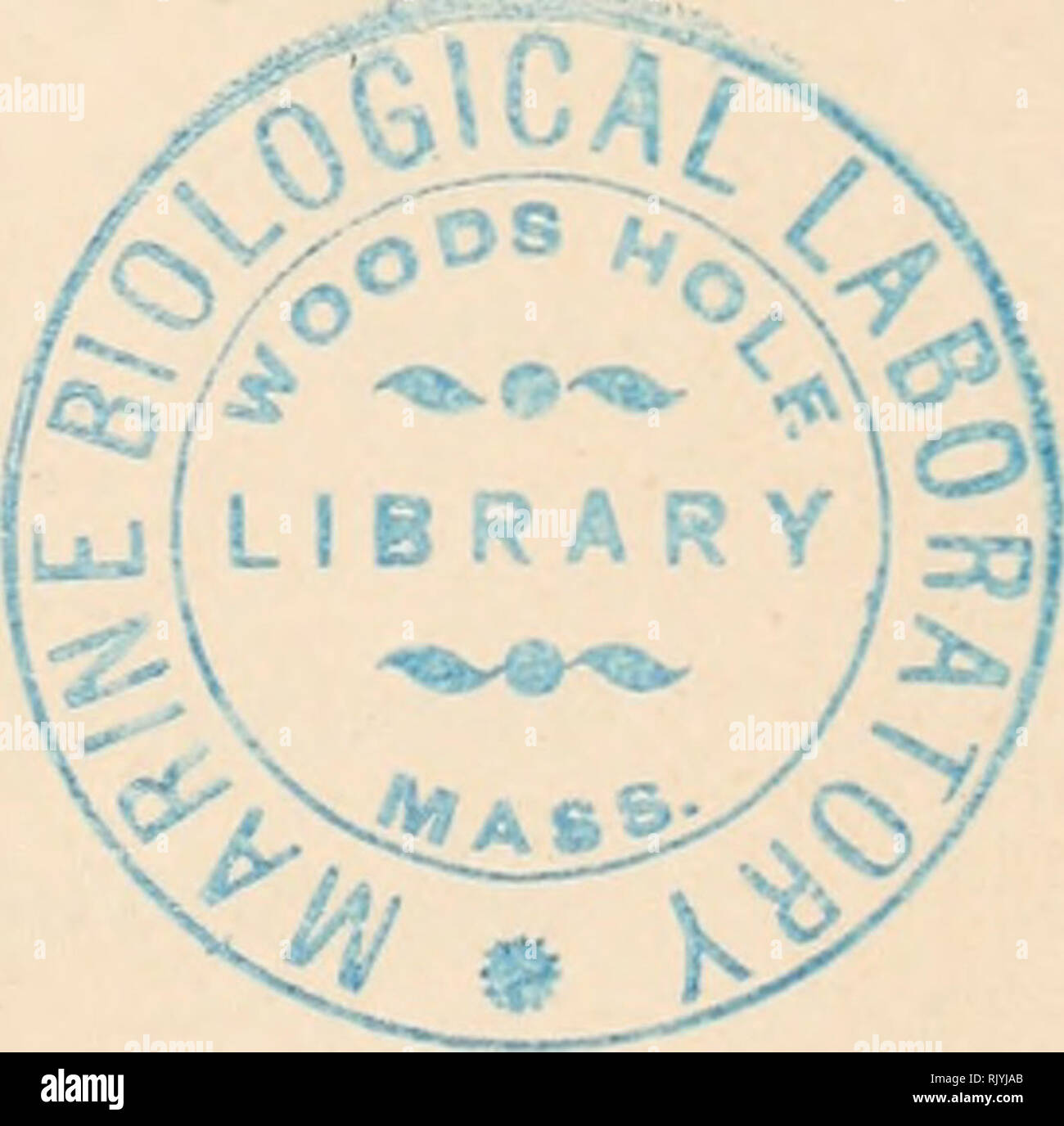 . Atlas de microbiologie ... Roussel, Georges; Microbiology. Fig. 5. Sporange de Phycomijces nitens (gr. 180 diam.). La figure 4 représente l'aspect des spores ovalaires du Phycomyces. Please note that these images are extracted from scanned page images that may have been digitally enhanced for readability - coloration and appearance of these illustrations may not perfectly resemble the original work.. Doyen, E. Paris Stock Photohttps://www.alamy.com/image-license-details/?v=1https://www.alamy.com/atlas-de-microbiologie-roussel-georges-microbiology-fig-5-sporange-de-phycomijces-nitens-gr-180-diam-la-figure-4-reprsente-laspect-des-spores-ovalaires-du-phycomyces-please-note-that-these-images-are-extracted-from-scanned-page-images-that-may-have-been-digitally-enhanced-for-readability-coloration-and-appearance-of-these-illustrations-may-not-perfectly-resemble-the-original-work-doyen-e-paris-image235405699.html
. Atlas de microbiologie ... Roussel, Georges; Microbiology. Fig. 5. Sporange de Phycomijces nitens (gr. 180 diam.). La figure 4 représente l'aspect des spores ovalaires du Phycomyces. Please note that these images are extracted from scanned page images that may have been digitally enhanced for readability - coloration and appearance of these illustrations may not perfectly resemble the original work.. Doyen, E. Paris Stock Photohttps://www.alamy.com/image-license-details/?v=1https://www.alamy.com/atlas-de-microbiologie-roussel-georges-microbiology-fig-5-sporange-de-phycomijces-nitens-gr-180-diam-la-figure-4-reprsente-laspect-des-spores-ovalaires-du-phycomyces-please-note-that-these-images-are-extracted-from-scanned-page-images-that-may-have-been-digitally-enhanced-for-readability-coloration-and-appearance-of-these-illustrations-may-not-perfectly-resemble-the-original-work-doyen-e-paris-image235405699.htmlRMRJYJAB–. Atlas de microbiologie ... Roussel, Georges; Microbiology. Fig. 5. Sporange de Phycomijces nitens (gr. 180 diam.). La figure 4 représente l'aspect des spores ovalaires du Phycomyces. Please note that these images are extracted from scanned page images that may have been digitally enhanced for readability - coloration and appearance of these illustrations may not perfectly resemble the original work.. Doyen, E. Paris
 . Botanique cryptogamique, ou Histoire des familles naturelles des plantes infrieures. (Poil.) f Sporange et coiffe.). Please note that these images are extracted from scanned page images that may have been digitally enhanced for readability - coloration and appearance of these illustrations may not perfectly resemble the original work.. Payer, J. -B. (Jean-Baptiste), 1818-1860; Baillon, H. (Henri), 1827-1895. Paris : F. Savy Stock Photohttps://www.alamy.com/image-license-details/?v=1https://www.alamy.com/botanique-cryptogamique-ou-histoire-des-familles-naturelles-des-plantes-infrieures-poil-f-sporange-et-coiffe-please-note-that-these-images-are-extracted-from-scanned-page-images-that-may-have-been-digitally-enhanced-for-readability-coloration-and-appearance-of-these-illustrations-may-not-perfectly-resemble-the-original-work-payer-j-b-jean-baptiste-1818-1860-baillon-h-henri-1827-1895-paris-f-savy-image234401751.html
. Botanique cryptogamique, ou Histoire des familles naturelles des plantes infrieures. (Poil.) f Sporange et coiffe.). Please note that these images are extracted from scanned page images that may have been digitally enhanced for readability - coloration and appearance of these illustrations may not perfectly resemble the original work.. Payer, J. -B. (Jean-Baptiste), 1818-1860; Baillon, H. (Henri), 1827-1895. Paris : F. Savy Stock Photohttps://www.alamy.com/image-license-details/?v=1https://www.alamy.com/botanique-cryptogamique-ou-histoire-des-familles-naturelles-des-plantes-infrieures-poil-f-sporange-et-coiffe-please-note-that-these-images-are-extracted-from-scanned-page-images-that-may-have-been-digitally-enhanced-for-readability-coloration-and-appearance-of-these-illustrations-may-not-perfectly-resemble-the-original-work-payer-j-b-jean-baptiste-1818-1860-baillon-h-henri-1827-1895-paris-f-savy-image234401751.htmlRMRH9WR3–. Botanique cryptogamique, ou Histoire des familles naturelles des plantes infrieures. (Poil.) f Sporange et coiffe.). Please note that these images are extracted from scanned page images that may have been digitally enhanced for readability - coloration and appearance of these illustrations may not perfectly resemble the original work.. Payer, J. -B. (Jean-Baptiste), 1818-1860; Baillon, H. (Henri), 1827-1895. Paris : F. Savy
 . A handbook of cryptogamic botany. Cryptogams. 74 VASCULAR CRYPTOGAMS development, the parenchyme of the fertile (apical) part of the leaf, giving the appearance of a panicled or thyrsoid inflorescence. The sf orange is usually stalked, and has an elliptical form, or that of a battle- dore or racket-bat. The sides are commonly thin and membranous, and- the sporange dehisces either longitudinally or transversely, generally from the elasticity of an annulus or ring of brown thick-walled cells running along or across it. The position of this annulus, and its more or less complete development or Stock Photohttps://www.alamy.com/image-license-details/?v=1https://www.alamy.com/a-handbook-of-cryptogamic-botany-cryptogams-74-vascular-cryptogams-development-the-parenchyme-of-the-fertile-apical-part-of-the-leaf-giving-the-appearance-of-a-panicled-or-thyrsoid-inflorescence-the-sf-orange-is-usually-stalked-and-has-an-elliptical-form-or-that-of-a-battle-dore-or-racket-bat-the-sides-are-commonly-thin-and-membranous-and-the-sporange-dehisces-either-longitudinally-or-transversely-generally-from-the-elasticity-of-an-annulus-or-ring-of-brown-thick-walled-cells-running-along-or-across-it-the-position-of-this-annulus-and-its-more-or-less-complete-development-or-image232422427.html
. A handbook of cryptogamic botany. Cryptogams. 74 VASCULAR CRYPTOGAMS development, the parenchyme of the fertile (apical) part of the leaf, giving the appearance of a panicled or thyrsoid inflorescence. The sf orange is usually stalked, and has an elliptical form, or that of a battle- dore or racket-bat. The sides are commonly thin and membranous, and- the sporange dehisces either longitudinally or transversely, generally from the elasticity of an annulus or ring of brown thick-walled cells running along or across it. The position of this annulus, and its more or less complete development or Stock Photohttps://www.alamy.com/image-license-details/?v=1https://www.alamy.com/a-handbook-of-cryptogamic-botany-cryptogams-74-vascular-cryptogams-development-the-parenchyme-of-the-fertile-apical-part-of-the-leaf-giving-the-appearance-of-a-panicled-or-thyrsoid-inflorescence-the-sf-orange-is-usually-stalked-and-has-an-elliptical-form-or-that-of-a-battle-dore-or-racket-bat-the-sides-are-commonly-thin-and-membranous-and-the-sporange-dehisces-either-longitudinally-or-transversely-generally-from-the-elasticity-of-an-annulus-or-ring-of-brown-thick-walled-cells-running-along-or-across-it-the-position-of-this-annulus-and-its-more-or-less-complete-development-or-image232422427.htmlRMRE3N4Y–. A handbook of cryptogamic botany. Cryptogams. 74 VASCULAR CRYPTOGAMS development, the parenchyme of the fertile (apical) part of the leaf, giving the appearance of a panicled or thyrsoid inflorescence. The sf orange is usually stalked, and has an elliptical form, or that of a battle- dore or racket-bat. The sides are commonly thin and membranous, and- the sporange dehisces either longitudinally or transversely, generally from the elasticity of an annulus or ring of brown thick-walled cells running along or across it. The position of this annulus, and its more or less complete development or
 . A handbook of cryptogamic botany. Cryptogams. 7° VASCULAR CRYPTOGAMS the substitutionary growths which accompany the arrest of spore-forma-' tion are restricted to the sporanges themselves. These are replaced by ' pseudo-bulbils ' of a pear-like form, presenting but little resemblance to ordinary prothallia, but demonstrating their oophytic character by pro- ducing antherids. In other examples the prothalloid growths are by no means restricted to the sporange ; they may either arise from the sorus itself, or may appear at points quite distinct from the sori, and even on fronds which bear no Stock Photohttps://www.alamy.com/image-license-details/?v=1https://www.alamy.com/a-handbook-of-cryptogamic-botany-cryptogams-7-vascular-cryptogams-the-substitutionary-growths-which-accompany-the-arrest-of-spore-forma-tion-are-restricted-to-the-sporanges-themselves-these-are-replaced-by-pseudo-bulbils-of-a-pear-like-form-presenting-but-little-resemblance-to-ordinary-prothallia-but-demonstrating-their-oophytic-character-by-pro-ducing-antherids-in-other-examples-the-prothalloid-growths-are-by-no-means-restricted-to-the-sporange-they-may-either-arise-from-the-sorus-itself-or-may-appear-at-points-quite-distinct-from-the-sori-and-even-on-fronds-which-bear-no-image232422450.html
. A handbook of cryptogamic botany. Cryptogams. 7° VASCULAR CRYPTOGAMS the substitutionary growths which accompany the arrest of spore-forma-' tion are restricted to the sporanges themselves. These are replaced by ' pseudo-bulbils ' of a pear-like form, presenting but little resemblance to ordinary prothallia, but demonstrating their oophytic character by pro- ducing antherids. In other examples the prothalloid growths are by no means restricted to the sporange ; they may either arise from the sorus itself, or may appear at points quite distinct from the sori, and even on fronds which bear no Stock Photohttps://www.alamy.com/image-license-details/?v=1https://www.alamy.com/a-handbook-of-cryptogamic-botany-cryptogams-7-vascular-cryptogams-the-substitutionary-growths-which-accompany-the-arrest-of-spore-forma-tion-are-restricted-to-the-sporanges-themselves-these-are-replaced-by-pseudo-bulbils-of-a-pear-like-form-presenting-but-little-resemblance-to-ordinary-prothallia-but-demonstrating-their-oophytic-character-by-pro-ducing-antherids-in-other-examples-the-prothalloid-growths-are-by-no-means-restricted-to-the-sporange-they-may-either-arise-from-the-sorus-itself-or-may-appear-at-points-quite-distinct-from-the-sori-and-even-on-fronds-which-bear-no-image232422450.htmlRMRE3N5P–. A handbook of cryptogamic botany. Cryptogams. 7° VASCULAR CRYPTOGAMS the substitutionary growths which accompany the arrest of spore-forma-' tion are restricted to the sporanges themselves. These are replaced by ' pseudo-bulbils ' of a pear-like form, presenting but little resemblance to ordinary prothallia, but demonstrating their oophytic character by pro- ducing antherids. In other examples the prothalloid growths are by no means restricted to the sporange ; they may either arise from the sorus itself, or may appear at points quite distinct from the sori, and even on fronds which bear no
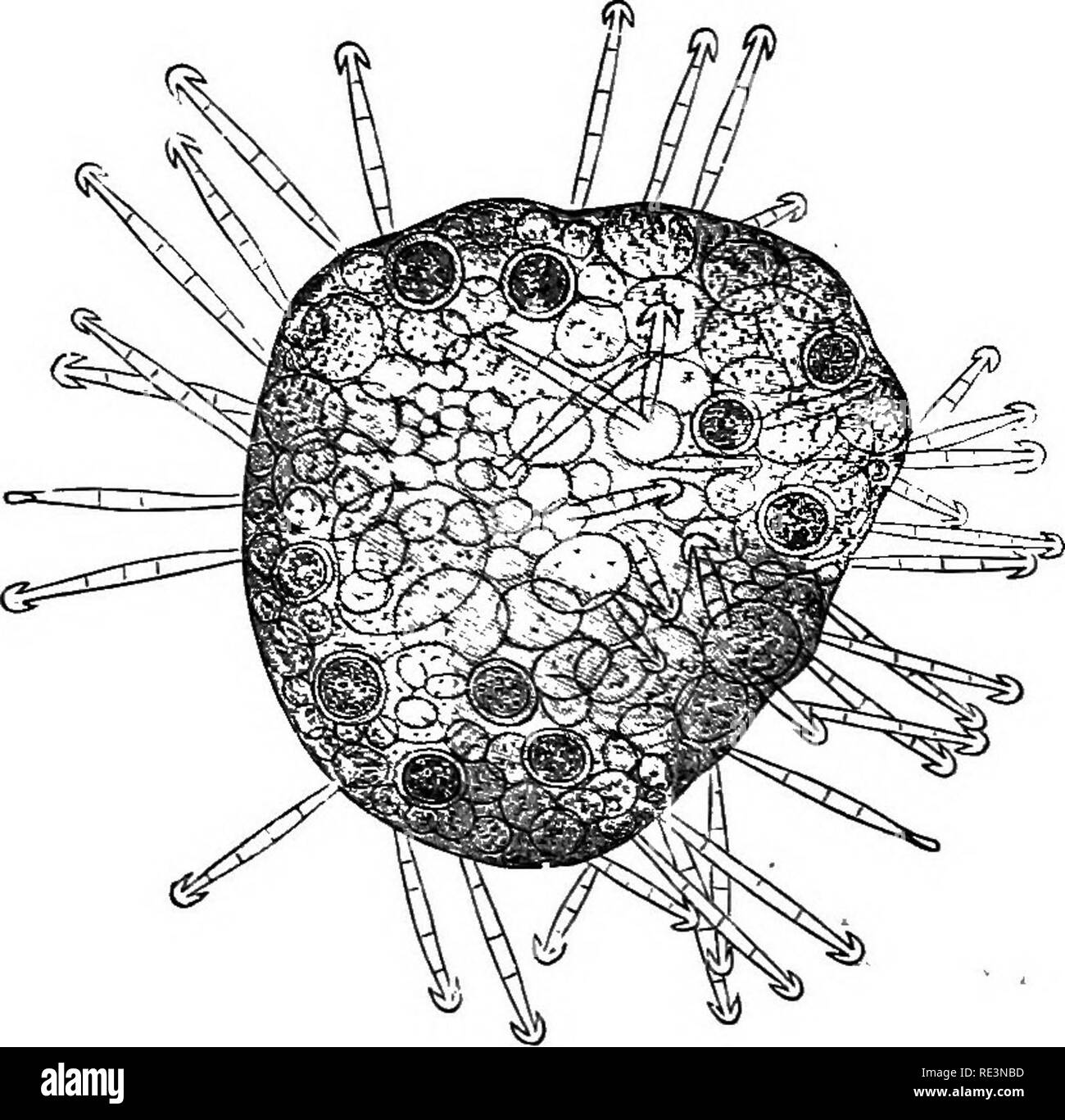 . A handbook of cryptogamic botany. Cryptogams. 30 VASCULAR CRYPTOGAMS stouter pedicels, and ari^e from the apex of the columel. In the fonna- tion of the pedicels of the megasporanges longitudinal cell-division takes place, as well as transverse. The mode of formation of the spores within each kind of sporange has already been described in general terms, after the preliminary separation of a single external layer of cells which develops into the wall of the sporange. The sixty-four micro- spores appear to be disposed without any arrangement in the cavity of the microsporange. A large nucleus Stock Photohttps://www.alamy.com/image-license-details/?v=1https://www.alamy.com/a-handbook-of-cryptogamic-botany-cryptogams-30-vascular-cryptogams-stouter-pedicels-and-arie-from-the-apex-of-the-columel-in-the-fonna-tion-of-the-pedicels-of-the-megasporanges-longitudinal-cell-division-takes-place-as-well-as-transverse-the-mode-of-formation-of-the-spores-within-each-kind-of-sporange-has-already-been-described-in-general-terms-after-the-preliminary-separation-of-a-single-external-layer-of-cells-which-develops-into-the-wall-of-the-sporange-the-sixty-four-micro-spores-appear-to-be-disposed-without-any-arrangement-in-the-cavity-of-the-microsporange-a-large-nucleus-image232422609.html
. A handbook of cryptogamic botany. Cryptogams. 30 VASCULAR CRYPTOGAMS stouter pedicels, and ari^e from the apex of the columel. In the fonna- tion of the pedicels of the megasporanges longitudinal cell-division takes place, as well as transverse. The mode of formation of the spores within each kind of sporange has already been described in general terms, after the preliminary separation of a single external layer of cells which develops into the wall of the sporange. The sixty-four micro- spores appear to be disposed without any arrangement in the cavity of the microsporange. A large nucleus Stock Photohttps://www.alamy.com/image-license-details/?v=1https://www.alamy.com/a-handbook-of-cryptogamic-botany-cryptogams-30-vascular-cryptogams-stouter-pedicels-and-arie-from-the-apex-of-the-columel-in-the-fonna-tion-of-the-pedicels-of-the-megasporanges-longitudinal-cell-division-takes-place-as-well-as-transverse-the-mode-of-formation-of-the-spores-within-each-kind-of-sporange-has-already-been-described-in-general-terms-after-the-preliminary-separation-of-a-single-external-layer-of-cells-which-develops-into-the-wall-of-the-sporange-the-sixty-four-micro-spores-appear-to-be-disposed-without-any-arrangement-in-the-cavity-of-the-microsporange-a-large-nucleus-image232422609.htmlRMRE3NBD–. A handbook of cryptogamic botany. Cryptogams. 30 VASCULAR CRYPTOGAMS stouter pedicels, and ari^e from the apex of the columel. In the fonna- tion of the pedicels of the megasporanges longitudinal cell-division takes place, as well as transverse. The mode of formation of the spores within each kind of sporange has already been described in general terms, after the preliminary separation of a single external layer of cells which develops into the wall of the sporange. The sixty-four micro- spores appear to be disposed without any arrangement in the cavity of the microsporange. A large nucleus
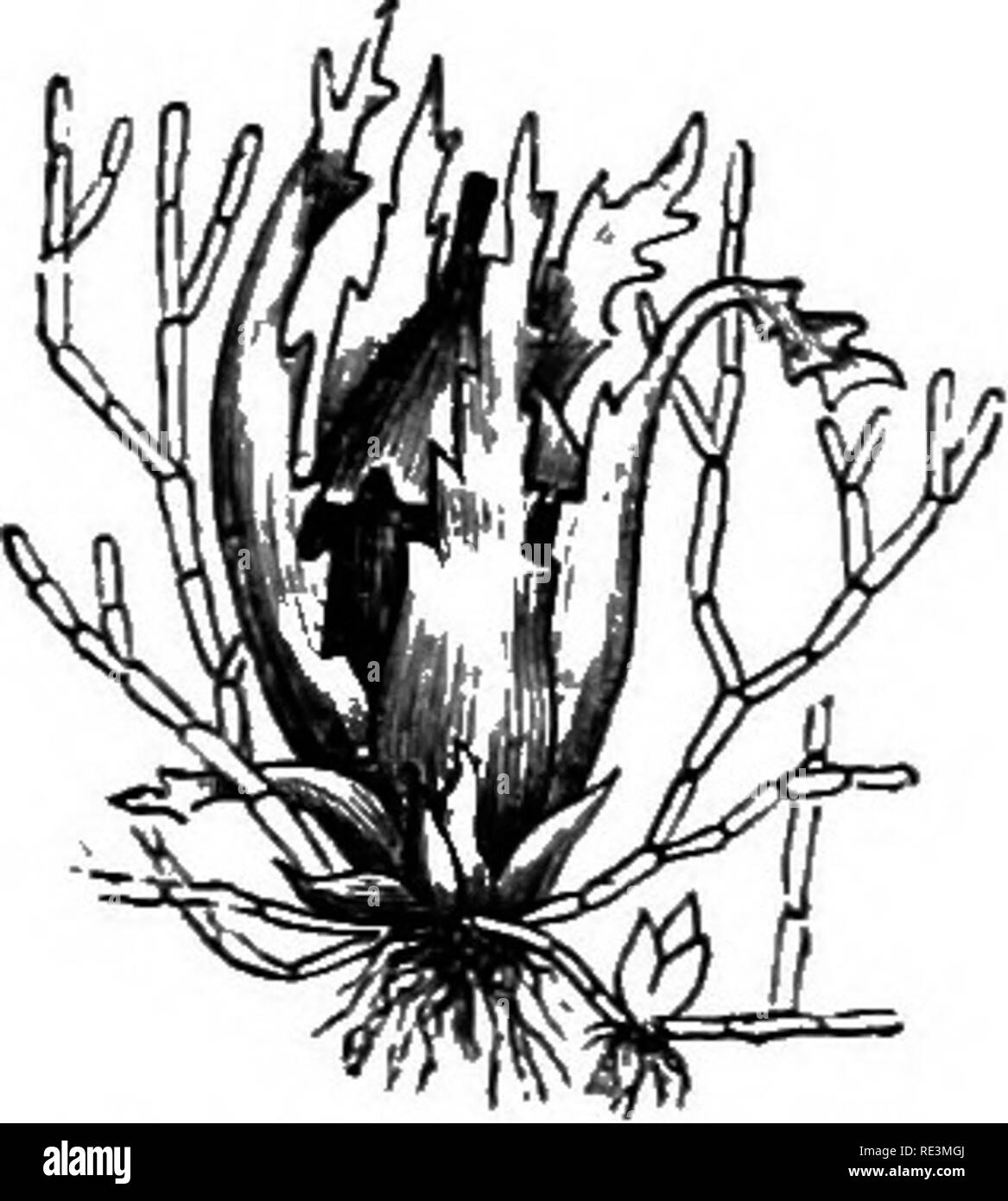 . A handbook of cryptogamic botany. Cryptogams. ISO MUSCINE.'E Order 2.—Phascace^. In the small order of Phascacese the roundish sporange dehisces neither by the detachment of an opercule nor by longitudinal slits, but decays to allow of the escape of the spores; the calypter is ruptured laterally without being raised up as a cap; the columel is sometimes wanting. According to Leitgeb, Archidium (Brid.) resembles the Hepaticae more closely than the Bryacese in the processes which lead to the formation of the spores, especially in the differ- entiation of the archespore into spore-mother-cell Stock Photohttps://www.alamy.com/image-license-details/?v=1https://www.alamy.com/a-handbook-of-cryptogamic-botany-cryptogams-iso-muscinee-order-2phascace-in-the-small-order-of-phascacese-the-roundish-sporange-dehisces-neither-by-the-detachment-of-an-opercule-nor-by-longitudinal-slits-but-decays-to-allow-of-the-escape-of-the-spores-the-calypter-is-ruptured-laterally-without-being-raised-up-as-a-cap-the-columel-is-sometimes-wanting-according-to-leitgeb-archidium-brid-resembles-the-hepaticae-more-closely-than-the-bryacese-in-the-processes-which-lead-to-the-formation-of-the-spores-especially-in-the-differ-entiation-of-the-archespore-into-spore-mother-cell-image232421970.html
. A handbook of cryptogamic botany. Cryptogams. ISO MUSCINE.'E Order 2.—Phascace^. In the small order of Phascacese the roundish sporange dehisces neither by the detachment of an opercule nor by longitudinal slits, but decays to allow of the escape of the spores; the calypter is ruptured laterally without being raised up as a cap; the columel is sometimes wanting. According to Leitgeb, Archidium (Brid.) resembles the Hepaticae more closely than the Bryacese in the processes which lead to the formation of the spores, especially in the differ- entiation of the archespore into spore-mother-cell Stock Photohttps://www.alamy.com/image-license-details/?v=1https://www.alamy.com/a-handbook-of-cryptogamic-botany-cryptogams-iso-muscinee-order-2phascace-in-the-small-order-of-phascacese-the-roundish-sporange-dehisces-neither-by-the-detachment-of-an-opercule-nor-by-longitudinal-slits-but-decays-to-allow-of-the-escape-of-the-spores-the-calypter-is-ruptured-laterally-without-being-raised-up-as-a-cap-the-columel-is-sometimes-wanting-according-to-leitgeb-archidium-brid-resembles-the-hepaticae-more-closely-than-the-bryacese-in-the-processes-which-lead-to-the-formation-of-the-spores-especially-in-the-differ-entiation-of-the-archespore-into-spore-mother-cell-image232421970.htmlRMRE3MGJ–. A handbook of cryptogamic botany. Cryptogams. ISO MUSCINE.'E Order 2.—Phascace^. In the small order of Phascacese the roundish sporange dehisces neither by the detachment of an opercule nor by longitudinal slits, but decays to allow of the escape of the spores; the calypter is ruptured laterally without being raised up as a cap; the columel is sometimes wanting. According to Leitgeb, Archidium (Brid.) resembles the Hepaticae more closely than the Bryacese in the processes which lead to the formation of the spores, especially in the differ- entiation of the archespore into spore-mother-cell
 . A handbook of cryptogamic botany. Cryptogams. 46 VASCULAR CRVPTOGAMS reduced to only one. Each fertile leaf or sporophyll subtends only a single sporange, which is borne on the stem above the leaf-axil. The sporanges are of considerable size in proportion to that of the leaf, and are formed from a group of superficial cells at the growing point of the stem. They make their first appearance as flat, afterwards spherical or club-shaped, swellings, completely covered by the epiderm, which subsequently forms, by tangential divisions, the wall of the sporange, composed of three layers. By subsequ Stock Photohttps://www.alamy.com/image-license-details/?v=1https://www.alamy.com/a-handbook-of-cryptogamic-botany-cryptogams-46-vascular-crvptogams-reduced-to-only-one-each-fertile-leaf-or-sporophyll-subtends-only-a-single-sporange-which-is-borne-on-the-stem-above-the-leaf-axil-the-sporanges-are-of-considerable-size-in-proportion-to-that-of-the-leaf-and-are-formed-from-a-group-of-superficial-cells-at-the-growing-point-of-the-stem-they-make-their-first-appearance-as-flat-afterwards-spherical-or-club-shaped-swellings-completely-covered-by-the-epiderm-which-subsequently-forms-by-tangential-divisions-the-wall-of-the-sporange-composed-of-three-layers-by-subsequ-image232422552.html
. A handbook of cryptogamic botany. Cryptogams. 46 VASCULAR CRVPTOGAMS reduced to only one. Each fertile leaf or sporophyll subtends only a single sporange, which is borne on the stem above the leaf-axil. The sporanges are of considerable size in proportion to that of the leaf, and are formed from a group of superficial cells at the growing point of the stem. They make their first appearance as flat, afterwards spherical or club-shaped, swellings, completely covered by the epiderm, which subsequently forms, by tangential divisions, the wall of the sporange, composed of three layers. By subsequ Stock Photohttps://www.alamy.com/image-license-details/?v=1https://www.alamy.com/a-handbook-of-cryptogamic-botany-cryptogams-46-vascular-crvptogams-reduced-to-only-one-each-fertile-leaf-or-sporophyll-subtends-only-a-single-sporange-which-is-borne-on-the-stem-above-the-leaf-axil-the-sporanges-are-of-considerable-size-in-proportion-to-that-of-the-leaf-and-are-formed-from-a-group-of-superficial-cells-at-the-growing-point-of-the-stem-they-make-their-first-appearance-as-flat-afterwards-spherical-or-club-shaped-swellings-completely-covered-by-the-epiderm-which-subsequently-forms-by-tangential-divisions-the-wall-of-the-sporange-composed-of-three-layers-by-subsequ-image232422552.htmlRMRE3N9C–. A handbook of cryptogamic botany. Cryptogams. 46 VASCULAR CRVPTOGAMS reduced to only one. Each fertile leaf or sporophyll subtends only a single sporange, which is borne on the stem above the leaf-axil. The sporanges are of considerable size in proportion to that of the leaf, and are formed from a group of superficial cells at the growing point of the stem. They make their first appearance as flat, afterwards spherical or club-shaped, swellings, completely covered by the epiderm, which subsequently forms, by tangential divisions, the wall of the sporange, composed of three layers. By subsequ
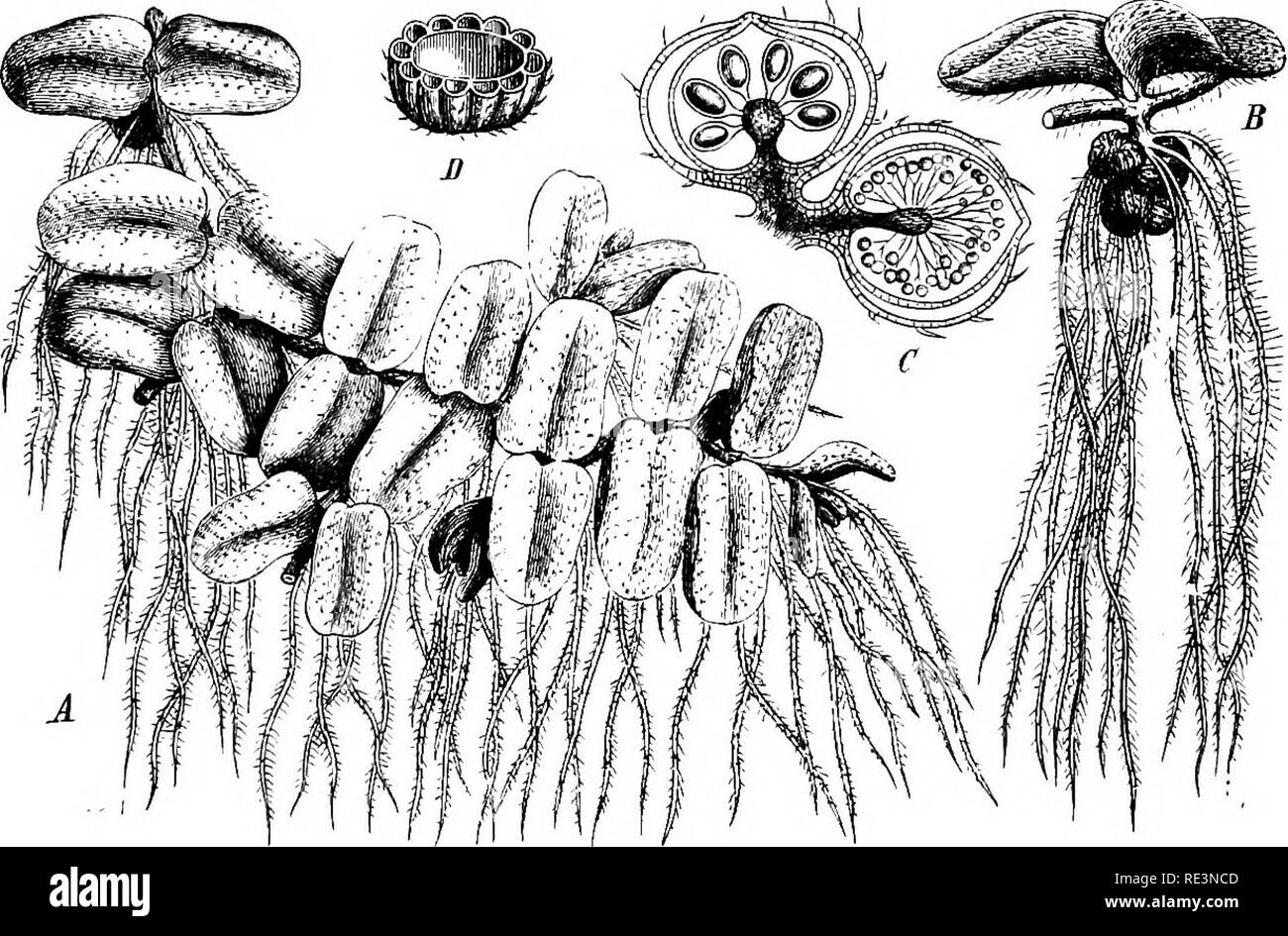 . A handbook of cryptogamic botany. Cryptogams. RHIZOCARPEyE 23 hardening of mucilage derived from the disorganisation and deliques- cence of a portion of the contents of the sporange. The female prothal- lium is formed within the apical papilla of the megaspore, and is exposed by the bursting of the enveloping epispore. It never completely frees itself from the megaspore, and is usually altogether destitute of chlorophyll. It bears one or more archegones, differing from one another in smaller points of structure in the different genera. The microspores do not give birth to a male prothallium, Stock Photohttps://www.alamy.com/image-license-details/?v=1https://www.alamy.com/a-handbook-of-cryptogamic-botany-cryptogams-rhizocarpeye-23-hardening-of-mucilage-derived-from-the-disorganisation-and-deliques-cence-of-a-portion-of-the-contents-of-the-sporange-the-female-prothal-lium-is-formed-within-the-apical-papilla-of-the-megaspore-and-is-exposed-by-the-bursting-of-the-enveloping-epispore-it-never-completely-frees-itself-from-the-megaspore-and-is-usually-altogether-destitute-of-chlorophyll-it-bears-one-or-more-archegones-differing-from-one-another-in-smaller-points-of-structure-in-the-different-genera-the-microspores-do-not-give-birth-to-a-male-prothallium-image232422637.html
. A handbook of cryptogamic botany. Cryptogams. RHIZOCARPEyE 23 hardening of mucilage derived from the disorganisation and deliques- cence of a portion of the contents of the sporange. The female prothal- lium is formed within the apical papilla of the megaspore, and is exposed by the bursting of the enveloping epispore. It never completely frees itself from the megaspore, and is usually altogether destitute of chlorophyll. It bears one or more archegones, differing from one another in smaller points of structure in the different genera. The microspores do not give birth to a male prothallium, Stock Photohttps://www.alamy.com/image-license-details/?v=1https://www.alamy.com/a-handbook-of-cryptogamic-botany-cryptogams-rhizocarpeye-23-hardening-of-mucilage-derived-from-the-disorganisation-and-deliques-cence-of-a-portion-of-the-contents-of-the-sporange-the-female-prothal-lium-is-formed-within-the-apical-papilla-of-the-megaspore-and-is-exposed-by-the-bursting-of-the-enveloping-epispore-it-never-completely-frees-itself-from-the-megaspore-and-is-usually-altogether-destitute-of-chlorophyll-it-bears-one-or-more-archegones-differing-from-one-another-in-smaller-points-of-structure-in-the-different-genera-the-microspores-do-not-give-birth-to-a-male-prothallium-image232422637.htmlRMRE3NCD–. A handbook of cryptogamic botany. Cryptogams. RHIZOCARPEyE 23 hardening of mucilage derived from the disorganisation and deliques- cence of a portion of the contents of the sporange. The female prothal- lium is formed within the apical papilla of the megaspore, and is exposed by the bursting of the enveloping epispore. It never completely frees itself from the megaspore, and is usually altogether destitute of chlorophyll. It bears one or more archegones, differing from one another in smaller points of structure in the different genera. The microspores do not give birth to a male prothallium,
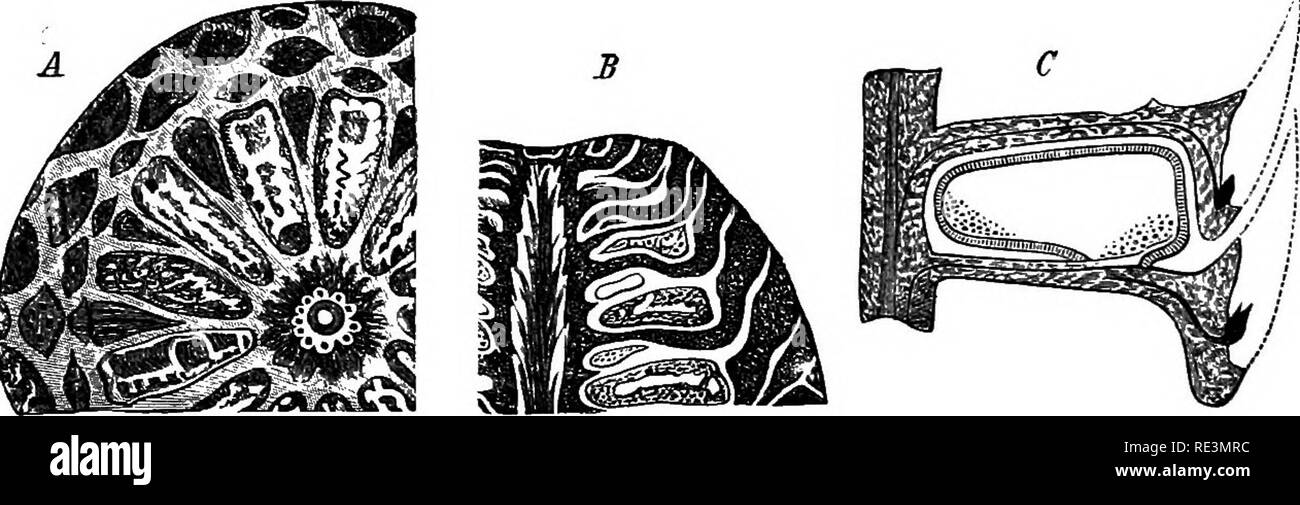 . A handbook of cryptogamic botany. Cryptogams. ii6 VASCULAR CRYPTOGAMS central 'vascular' cylinder can be detected, consisting of scalariform tracheides. There is distinct evidence of a secondary growth in thick- ness. The branching was always dichotomous. The leaves were very similar to those of Lycopodium, and were penetrated by a single ' vascular' bundle. The fructifications known as Lepidostrobus are cone-like structures, not unlike fir-cones in appearance, consisting of densely packed sporo- phylls. On the upper side of each leaf is a single sporange, often of considerable size. The con Stock Photohttps://www.alamy.com/image-license-details/?v=1https://www.alamy.com/a-handbook-of-cryptogamic-botany-cryptogams-ii6-vascular-cryptogams-central-vascular-cylinder-can-be-detected-consisting-of-scalariform-tracheides-there-is-distinct-evidence-of-a-secondary-growth-in-thick-ness-the-branching-was-always-dichotomous-the-leaves-were-very-similar-to-those-of-lycopodium-and-were-penetrated-by-a-single-vascular-bundle-the-fructifications-known-as-lepidostrobus-are-cone-like-structures-not-unlike-fir-cones-in-appearance-consisting-of-densely-packed-sporo-phylls-on-the-upper-side-of-each-leaf-is-a-single-sporange-often-of-considerable-size-the-con-image232422160.html
. A handbook of cryptogamic botany. Cryptogams. ii6 VASCULAR CRYPTOGAMS central 'vascular' cylinder can be detected, consisting of scalariform tracheides. There is distinct evidence of a secondary growth in thick- ness. The branching was always dichotomous. The leaves were very similar to those of Lycopodium, and were penetrated by a single ' vascular' bundle. The fructifications known as Lepidostrobus are cone-like structures, not unlike fir-cones in appearance, consisting of densely packed sporo- phylls. On the upper side of each leaf is a single sporange, often of considerable size. The con Stock Photohttps://www.alamy.com/image-license-details/?v=1https://www.alamy.com/a-handbook-of-cryptogamic-botany-cryptogams-ii6-vascular-cryptogams-central-vascular-cylinder-can-be-detected-consisting-of-scalariform-tracheides-there-is-distinct-evidence-of-a-secondary-growth-in-thick-ness-the-branching-was-always-dichotomous-the-leaves-were-very-similar-to-those-of-lycopodium-and-were-penetrated-by-a-single-vascular-bundle-the-fructifications-known-as-lepidostrobus-are-cone-like-structures-not-unlike-fir-cones-in-appearance-consisting-of-densely-packed-sporo-phylls-on-the-upper-side-of-each-leaf-is-a-single-sporange-often-of-considerable-size-the-con-image232422160.htmlRMRE3MRC–. A handbook of cryptogamic botany. Cryptogams. ii6 VASCULAR CRYPTOGAMS central 'vascular' cylinder can be detected, consisting of scalariform tracheides. There is distinct evidence of a secondary growth in thick- ness. The branching was always dichotomous. The leaves were very similar to those of Lycopodium, and were penetrated by a single ' vascular' bundle. The fructifications known as Lepidostrobus are cone-like structures, not unlike fir-cones in appearance, consisting of densely packed sporo- phylls. On the upper side of each leaf is a single sporange, often of considerable size. The con
 . A handbook of cryptogamic botany. Cryptogams. KiG. 27.—Section of megasporange of ^. itupquttli/olia, showing double wall of sporange, layer of tapetal cells, and mega- spores. (After Goebel, magnified.) comes to be placed in the axil or even on the base of the leaf. The ' vascular' bundle of the leaf passes beneath the sporange without sending a branch into it. As in the other heterosporous families, the two kinds of sporange present no differentiation in their early stages. The archespore is the terminal hypodermal cell of an axial row. This divides into the sporogenous tissue surrounded b Stock Photohttps://www.alamy.com/image-license-details/?v=1https://www.alamy.com/a-handbook-of-cryptogamic-botany-cryptogams-kig-27section-of-megasporange-of-itupquttliolia-showing-double-wall-of-sporange-layer-of-tapetal-cells-and-mega-spores-after-goebel-magnified-comes-to-be-placed-in-the-axil-or-even-on-the-base-of-the-leaf-the-vascular-bundle-of-the-leaf-passes-beneath-the-sporange-without-sending-a-branch-into-it-as-in-the-other-heterosporous-families-the-two-kinds-of-sporange-present-no-differentiation-in-their-early-stages-the-archespore-is-the-terminal-hypodermal-cell-of-an-axial-row-this-divides-into-the-sporogenous-tissue-surrounded-b-image232422548.html
. A handbook of cryptogamic botany. Cryptogams. KiG. 27.—Section of megasporange of ^. itupquttli/olia, showing double wall of sporange, layer of tapetal cells, and mega- spores. (After Goebel, magnified.) comes to be placed in the axil or even on the base of the leaf. The ' vascular' bundle of the leaf passes beneath the sporange without sending a branch into it. As in the other heterosporous families, the two kinds of sporange present no differentiation in their early stages. The archespore is the terminal hypodermal cell of an axial row. This divides into the sporogenous tissue surrounded b Stock Photohttps://www.alamy.com/image-license-details/?v=1https://www.alamy.com/a-handbook-of-cryptogamic-botany-cryptogams-kig-27section-of-megasporange-of-itupquttliolia-showing-double-wall-of-sporange-layer-of-tapetal-cells-and-mega-spores-after-goebel-magnified-comes-to-be-placed-in-the-axil-or-even-on-the-base-of-the-leaf-the-vascular-bundle-of-the-leaf-passes-beneath-the-sporange-without-sending-a-branch-into-it-as-in-the-other-heterosporous-families-the-two-kinds-of-sporange-present-no-differentiation-in-their-early-stages-the-archespore-is-the-terminal-hypodermal-cell-of-an-axial-row-this-divides-into-the-sporogenous-tissue-surrounded-b-image232422548.htmlRMRE3N98–. A handbook of cryptogamic botany. Cryptogams. KiG. 27.—Section of megasporange of ^. itupquttli/olia, showing double wall of sporange, layer of tapetal cells, and mega- spores. (After Goebel, magnified.) comes to be placed in the axil or even on the base of the leaf. The ' vascular' bundle of the leaf passes beneath the sporange without sending a branch into it. As in the other heterosporous families, the two kinds of sporange present no differentiation in their early stages. The archespore is the terminal hypodermal cell of an axial row. This divides into the sporogenous tissue surrounded b
![. Class-book of botany [microform] : being outlines of the structure, physiology, and classification of plants : with a flora of the United States and Canada. Botany; Botany; Plants; Plants; Botanique; Botanique; Plantes; Botanique. 5"', Lycopodiiun dendroidenm. .10$, A siuglo spike. 509, ii scale with its sporange bursting 610, Spores.. Please note that these images are extracted from scanned page images that may have been digitally enhanced for readability - coloration and appearance of these illustrations may not perfectly resemble the original work.. Wood, Alphonso, 1810-1881. New Yor Stock Photo . Class-book of botany [microform] : being outlines of the structure, physiology, and classification of plants : with a flora of the United States and Canada. Botany; Botany; Plants; Plants; Botanique; Botanique; Plantes; Botanique. 5"', Lycopodiiun dendroidenm. .10$, A siuglo spike. 509, ii scale with its sporange bursting 610, Spores.. Please note that these images are extracted from scanned page images that may have been digitally enhanced for readability - coloration and appearance of these illustrations may not perfectly resemble the original work.. Wood, Alphonso, 1810-1881. New Yor Stock Photo](https://c8.alamy.com/comp/REPM5J/class-book-of-botany-microform-being-outlines-of-the-structure-physiology-and-classification-of-plants-with-a-flora-of-the-united-states-and-canada-botany-botany-plants-plants-botanique-botanique-plantes-botanique-5quot-lycopodiiun-dendroidenm-10-a-siuglo-spike-509-ii-scale-with-its-sporange-bursting-610-spores-please-note-that-these-images-are-extracted-from-scanned-page-images-that-may-have-been-digitally-enhanced-for-readability-coloration-and-appearance-of-these-illustrations-may-not-perfectly-resemble-the-original-work-wood-alphonso-1810-1881-new-yor-REPM5J.jpg) . Class-book of botany [microform] : being outlines of the structure, physiology, and classification of plants : with a flora of the United States and Canada. Botany; Botany; Plants; Plants; Botanique; Botanique; Plantes; Botanique. 5"', Lycopodiiun dendroidenm. .10$, A siuglo spike. 509, ii scale with its sporange bursting 610, Spores.. Please note that these images are extracted from scanned page images that may have been digitally enhanced for readability - coloration and appearance of these illustrations may not perfectly resemble the original work.. Wood, Alphonso, 1810-1881. New Yor Stock Photohttps://www.alamy.com/image-license-details/?v=1https://www.alamy.com/class-book-of-botany-microform-being-outlines-of-the-structure-physiology-and-classification-of-plants-with-a-flora-of-the-united-states-and-canada-botany-botany-plants-plants-botanique-botanique-plantes-botanique-5quot-lycopodiiun-dendroidenm-10-a-siuglo-spike-509-ii-scale-with-its-sporange-bursting-610-spores-please-note-that-these-images-are-extracted-from-scanned-page-images-that-may-have-been-digitally-enhanced-for-readability-coloration-and-appearance-of-these-illustrations-may-not-perfectly-resemble-the-original-work-wood-alphonso-1810-1881-new-yor-image232838750.html
. Class-book of botany [microform] : being outlines of the structure, physiology, and classification of plants : with a flora of the United States and Canada. Botany; Botany; Plants; Plants; Botanique; Botanique; Plantes; Botanique. 5"', Lycopodiiun dendroidenm. .10$, A siuglo spike. 509, ii scale with its sporange bursting 610, Spores.. Please note that these images are extracted from scanned page images that may have been digitally enhanced for readability - coloration and appearance of these illustrations may not perfectly resemble the original work.. Wood, Alphonso, 1810-1881. New Yor Stock Photohttps://www.alamy.com/image-license-details/?v=1https://www.alamy.com/class-book-of-botany-microform-being-outlines-of-the-structure-physiology-and-classification-of-plants-with-a-flora-of-the-united-states-and-canada-botany-botany-plants-plants-botanique-botanique-plantes-botanique-5quot-lycopodiiun-dendroidenm-10-a-siuglo-spike-509-ii-scale-with-its-sporange-bursting-610-spores-please-note-that-these-images-are-extracted-from-scanned-page-images-that-may-have-been-digitally-enhanced-for-readability-coloration-and-appearance-of-these-illustrations-may-not-perfectly-resemble-the-original-work-wood-alphonso-1810-1881-new-yor-image232838750.htmlRMREPM5J–. Class-book of botany [microform] : being outlines of the structure, physiology, and classification of plants : with a flora of the United States and Canada. Botany; Botany; Plants; Plants; Botanique; Botanique; Plantes; Botanique. 5"', Lycopodiiun dendroidenm. .10$, A siuglo spike. 509, ii scale with its sporange bursting 610, Spores.. Please note that these images are extracted from scanned page images that may have been digitally enhanced for readability - coloration and appearance of these illustrations may not perfectly resemble the original work.. Wood, Alphonso, 1810-1881. New Yor
![. The Cambridge natural history. Zoology. 98 PROTOZOA 1. Myxosporidiaceae.âNaked parasites in cold-blooded animals. Spore- formation due to an aggi'egation of cytoplasm around a single nucleus to form an archespore, which then produces a complex of cells â 'ithin which two daughter-cells form the spores and accessory nematocysts. ]Ty:i:idium'Bntsch.; Myxohohis Butsch.; Henneguya Thelohna ; Nosema Nageli (= Olugea Th.). 2. AcTiNOMYXiDiACEAE.iâApocyte resolved into a sporange, containing eight secondary sporanges (so-called spores), of ternary symmetry and provided with three polar nematocyst Stock Photo . The Cambridge natural history. Zoology. 98 PROTOZOA 1. Myxosporidiaceae.âNaked parasites in cold-blooded animals. Spore- formation due to an aggi'egation of cytoplasm around a single nucleus to form an archespore, which then produces a complex of cells â 'ithin which two daughter-cells form the spores and accessory nematocysts. ]Ty:i:idium'Bntsch.; Myxohohis Butsch.; Henneguya Thelohna ; Nosema Nageli (= Olugea Th.). 2. AcTiNOMYXiDiACEAE.iâApocyte resolved into a sporange, containing eight secondary sporanges (so-called spores), of ternary symmetry and provided with three polar nematocyst Stock Photo](https://c8.alamy.com/comp/RDKY4T/the-cambridge-natural-history-zoology-98-protozoa-1-myxosporidiaceaenaked-parasites-in-cold-blooded-animals-spore-formation-due-to-an-aggiegation-of-cytoplasm-around-a-single-nucleus-to-form-an-archespore-which-then-produces-a-complex-of-cells-ithin-which-two-daughter-cells-form-the-spores-and-accessory-nematocysts-tyiidiumbntsch-myxohohis-butsch-henneguya-thelohna-nosema-nageli-=-olugea-th-2-actinomyxidiaceaeiapocyte-resolved-into-a-sporange-containing-eight-secondary-sporanges-so-called-spores-of-ternary-symmetry-and-provided-with-three-polar-nematocyst-RDKY4T.jpg) . The Cambridge natural history. Zoology. 98 PROTOZOA 1. Myxosporidiaceae.âNaked parasites in cold-blooded animals. Spore- formation due to an aggi'egation of cytoplasm around a single nucleus to form an archespore, which then produces a complex of cells â 'ithin which two daughter-cells form the spores and accessory nematocysts. ]Ty:i:idium'Bntsch.; Myxohohis Butsch.; Henneguya Thelohna ; Nosema Nageli (= Olugea Th.). 2. AcTiNOMYXiDiACEAE.iâApocyte resolved into a sporange, containing eight secondary sporanges (so-called spores), of ternary symmetry and provided with three polar nematocyst Stock Photohttps://www.alamy.com/image-license-details/?v=1https://www.alamy.com/the-cambridge-natural-history-zoology-98-protozoa-1-myxosporidiaceaenaked-parasites-in-cold-blooded-animals-spore-formation-due-to-an-aggiegation-of-cytoplasm-around-a-single-nucleus-to-form-an-archespore-which-then-produces-a-complex-of-cells-ithin-which-two-daughter-cells-form-the-spores-and-accessory-nematocysts-tyiidiumbntsch-myxohohis-butsch-henneguya-thelohna-nosema-nageli-=-olugea-th-2-actinomyxidiaceaeiapocyte-resolved-into-a-sporange-containing-eight-secondary-sporanges-so-called-spores-of-ternary-symmetry-and-provided-with-three-polar-nematocyst-image232163704.html
. The Cambridge natural history. Zoology. 98 PROTOZOA 1. Myxosporidiaceae.âNaked parasites in cold-blooded animals. Spore- formation due to an aggi'egation of cytoplasm around a single nucleus to form an archespore, which then produces a complex of cells â 'ithin which two daughter-cells form the spores and accessory nematocysts. ]Ty:i:idium'Bntsch.; Myxohohis Butsch.; Henneguya Thelohna ; Nosema Nageli (= Olugea Th.). 2. AcTiNOMYXiDiACEAE.iâApocyte resolved into a sporange, containing eight secondary sporanges (so-called spores), of ternary symmetry and provided with three polar nematocyst Stock Photohttps://www.alamy.com/image-license-details/?v=1https://www.alamy.com/the-cambridge-natural-history-zoology-98-protozoa-1-myxosporidiaceaenaked-parasites-in-cold-blooded-animals-spore-formation-due-to-an-aggiegation-of-cytoplasm-around-a-single-nucleus-to-form-an-archespore-which-then-produces-a-complex-of-cells-ithin-which-two-daughter-cells-form-the-spores-and-accessory-nematocysts-tyiidiumbntsch-myxohohis-butsch-henneguya-thelohna-nosema-nageli-=-olugea-th-2-actinomyxidiaceaeiapocyte-resolved-into-a-sporange-containing-eight-secondary-sporanges-so-called-spores-of-ternary-symmetry-and-provided-with-three-polar-nematocyst-image232163704.htmlRMRDKY4T–. The Cambridge natural history. Zoology. 98 PROTOZOA 1. Myxosporidiaceae.âNaked parasites in cold-blooded animals. Spore- formation due to an aggi'egation of cytoplasm around a single nucleus to form an archespore, which then produces a complex of cells â 'ithin which two daughter-cells form the spores and accessory nematocysts. ]Ty:i:idium'Bntsch.; Myxohohis Butsch.; Henneguya Thelohna ; Nosema Nageli (= Olugea Th.). 2. AcTiNOMYXiDiACEAE.iâApocyte resolved into a sporange, containing eight secondary sporanges (so-called spores), of ternary symmetry and provided with three polar nematocyst
 . A handbook of cryptogamic botany. Cryptogams. Fig. 67.—Mucilage-gland from Osmunda. r£^a/w (magnified). (After Gardiner.) from the entire absorption of the mesophyll of the fertile part of the leaf. In some species of Todea the leaf con- sists of only a single layer of cells. In Osmunda there are. Fig. 68.—Sporange of Osmunda (magnified). abundant mucilage-cells at the base of the leaf-stalk. The ' vascular ' bundles of the stem are collateral, as con- trasted with the concentric bundles of typical ferns, and their course bears more resemblance to that in Gymnosperms and in Dicotyledons. In Stock Photohttps://www.alamy.com/image-license-details/?v=1https://www.alamy.com/a-handbook-of-cryptogamic-botany-cryptogams-fig-67mucilage-gland-from-osmunda-raw-magnified-after-gardiner-from-the-entire-absorption-of-the-mesophyll-of-the-fertile-part-of-the-leaf-in-some-species-of-todea-the-leaf-con-sists-of-only-a-single-layer-of-cells-in-osmunda-there-are-fig-68sporange-of-osmunda-magnified-abundant-mucilage-cells-at-the-base-of-the-leaf-stalk-the-vascular-bundles-of-the-stem-are-collateral-as-con-trasted-with-the-concentric-bundles-of-typical-ferns-and-their-course-bears-more-resemblance-to-that-in-gymnosperms-and-in-dicotyledons-in-image232422360.html
. A handbook of cryptogamic botany. Cryptogams. Fig. 67.—Mucilage-gland from Osmunda. r£^a/w (magnified). (After Gardiner.) from the entire absorption of the mesophyll of the fertile part of the leaf. In some species of Todea the leaf con- sists of only a single layer of cells. In Osmunda there are. Fig. 68.—Sporange of Osmunda (magnified). abundant mucilage-cells at the base of the leaf-stalk. The ' vascular ' bundles of the stem are collateral, as con- trasted with the concentric bundles of typical ferns, and their course bears more resemblance to that in Gymnosperms and in Dicotyledons. In Stock Photohttps://www.alamy.com/image-license-details/?v=1https://www.alamy.com/a-handbook-of-cryptogamic-botany-cryptogams-fig-67mucilage-gland-from-osmunda-raw-magnified-after-gardiner-from-the-entire-absorption-of-the-mesophyll-of-the-fertile-part-of-the-leaf-in-some-species-of-todea-the-leaf-con-sists-of-only-a-single-layer-of-cells-in-osmunda-there-are-fig-68sporange-of-osmunda-magnified-abundant-mucilage-cells-at-the-base-of-the-leaf-stalk-the-vascular-bundles-of-the-stem-are-collateral-as-con-trasted-with-the-concentric-bundles-of-typical-ferns-and-their-course-bears-more-resemblance-to-that-in-gymnosperms-and-in-dicotyledons-in-image232422360.htmlRMRE3N2G–. A handbook of cryptogamic botany. Cryptogams. Fig. 67.—Mucilage-gland from Osmunda. r£^a/w (magnified). (After Gardiner.) from the entire absorption of the mesophyll of the fertile part of the leaf. In some species of Todea the leaf con- sists of only a single layer of cells. In Osmunda there are. Fig. 68.—Sporange of Osmunda (magnified). abundant mucilage-cells at the base of the leaf-stalk. The ' vascular ' bundles of the stem are collateral, as con- trasted with the concentric bundles of typical ferns, and their course bears more resemblance to that in Gymnosperms and in Dicotyledons. In
 . A handbook of cryptogamic botany. Cryptogams. Fig. izi.—EpkemerwH serratum Hampe; mature plant with persistent protoneme (magnified). (After Luerssen.). Fig. 122.—Pltttridium sitbulatum Rabenh. sporange (magnified). (After Luerssen. irregularly interspersed among cells that remain sterile. The spore- mother-cells do not number more than from one to seven in each spo- range ; in each of them four spores are formed tetrahedrally. The Phascacese are csespitose in their habit; the protoneme persists until the maturity of the sporogone. Principal genera :—Phascum (L.), Archidium (Brid.), Ephemeru Stock Photohttps://www.alamy.com/image-license-details/?v=1https://www.alamy.com/a-handbook-of-cryptogamic-botany-cryptogams-fig-iziepkemerwh-serratum-hampe-mature-plant-with-persistent-protoneme-magnified-after-luerssen-fig-122pltttridium-sitbulatum-rabenh-sporange-magnified-after-luerssen-irregularly-interspersed-among-cells-that-remain-sterile-the-spore-mother-cells-do-not-number-more-than-from-one-to-seven-in-each-spo-range-in-each-of-them-four-spores-are-formed-tetrahedrally-the-phascacese-are-csespitose-in-their-habit-the-protoneme-persists-until-the-maturity-of-the-sporogone-principal-genera-phascum-l-archidium-brid-ephemeru-image232421955.html
. A handbook of cryptogamic botany. Cryptogams. Fig. izi.—EpkemerwH serratum Hampe; mature plant with persistent protoneme (magnified). (After Luerssen.). Fig. 122.—Pltttridium sitbulatum Rabenh. sporange (magnified). (After Luerssen. irregularly interspersed among cells that remain sterile. The spore- mother-cells do not number more than from one to seven in each spo- range ; in each of them four spores are formed tetrahedrally. The Phascacese are csespitose in their habit; the protoneme persists until the maturity of the sporogone. Principal genera :—Phascum (L.), Archidium (Brid.), Ephemeru Stock Photohttps://www.alamy.com/image-license-details/?v=1https://www.alamy.com/a-handbook-of-cryptogamic-botany-cryptogams-fig-iziepkemerwh-serratum-hampe-mature-plant-with-persistent-protoneme-magnified-after-luerssen-fig-122pltttridium-sitbulatum-rabenh-sporange-magnified-after-luerssen-irregularly-interspersed-among-cells-that-remain-sterile-the-spore-mother-cells-do-not-number-more-than-from-one-to-seven-in-each-spo-range-in-each-of-them-four-spores-are-formed-tetrahedrally-the-phascacese-are-csespitose-in-their-habit-the-protoneme-persists-until-the-maturity-of-the-sporogone-principal-genera-phascum-l-archidium-brid-ephemeru-image232421955.htmlRMRE3MG3–. A handbook of cryptogamic botany. Cryptogams. Fig. izi.—EpkemerwH serratum Hampe; mature plant with persistent protoneme (magnified). (After Luerssen.). Fig. 122.—Pltttridium sitbulatum Rabenh. sporange (magnified). (After Luerssen. irregularly interspersed among cells that remain sterile. The spore- mother-cells do not number more than from one to seven in each spo- range ; in each of them four spores are formed tetrahedrally. The Phascacese are csespitose in their habit; the protoneme persists until the maturity of the sporogone. Principal genera :—Phascum (L.), Archidium (Brid.), Ephemeru
 . A handbook of cryptogamic botany. Cryptogams. FILICES 79 an annulus the sporange dehisces by a fissure at right angles to it; in the Marattiacese it opens by an apical pore. The dehiscence is due to unequal contraction in drying of the unequally thickened portions of the cell-walls of the annulus. On one side of the sporange of a considerable number of ferns are two, three, or four cells of peculiar form, with lignified cell-walls, the lip-cells, between which the dehis- cence always begins, and which ap- pear to guide its direction. These cells together are sometimes called the ' stomium.' Stock Photohttps://www.alamy.com/image-license-details/?v=1https://www.alamy.com/a-handbook-of-cryptogamic-botany-cryptogams-filices-79-an-annulus-the-sporange-dehisces-by-a-fissure-at-right-angles-to-it-in-the-marattiacese-it-opens-by-an-apical-pore-the-dehiscence-is-due-to-unequal-contraction-in-drying-of-the-unequally-thickened-portions-of-the-cell-walls-of-the-annulus-on-one-side-of-the-sporange-of-a-considerable-number-of-ferns-are-two-three-or-four-cells-of-peculiar-form-with-lignified-cell-walls-the-lip-cells-between-which-the-dehis-cence-always-begins-and-which-ap-pear-to-guide-its-direction-these-cells-together-are-sometimes-called-the-stomium-image232422415.html
. A handbook of cryptogamic botany. Cryptogams. FILICES 79 an annulus the sporange dehisces by a fissure at right angles to it; in the Marattiacese it opens by an apical pore. The dehiscence is due to unequal contraction in drying of the unequally thickened portions of the cell-walls of the annulus. On one side of the sporange of a considerable number of ferns are two, three, or four cells of peculiar form, with lignified cell-walls, the lip-cells, between which the dehis- cence always begins, and which ap- pear to guide its direction. These cells together are sometimes called the ' stomium.' Stock Photohttps://www.alamy.com/image-license-details/?v=1https://www.alamy.com/a-handbook-of-cryptogamic-botany-cryptogams-filices-79-an-annulus-the-sporange-dehisces-by-a-fissure-at-right-angles-to-it-in-the-marattiacese-it-opens-by-an-apical-pore-the-dehiscence-is-due-to-unequal-contraction-in-drying-of-the-unequally-thickened-portions-of-the-cell-walls-of-the-annulus-on-one-side-of-the-sporange-of-a-considerable-number-of-ferns-are-two-three-or-four-cells-of-peculiar-form-with-lignified-cell-walls-the-lip-cells-between-which-the-dehis-cence-always-begins-and-which-ap-pear-to-guide-its-direction-these-cells-together-are-sometimes-called-the-stomium-image232422415.htmlRMRE3N4F–. A handbook of cryptogamic botany. Cryptogams. FILICES 79 an annulus the sporange dehisces by a fissure at right angles to it; in the Marattiacese it opens by an apical pore. The dehiscence is due to unequal contraction in drying of the unequally thickened portions of the cell-walls of the annulus. On one side of the sporange of a considerable number of ferns are two, three, or four cells of peculiar form, with lignified cell-walls, the lip-cells, between which the dehis- cence always begins, and which ap- pear to guide its direction. These cells together are sometimes called the ' stomium.'
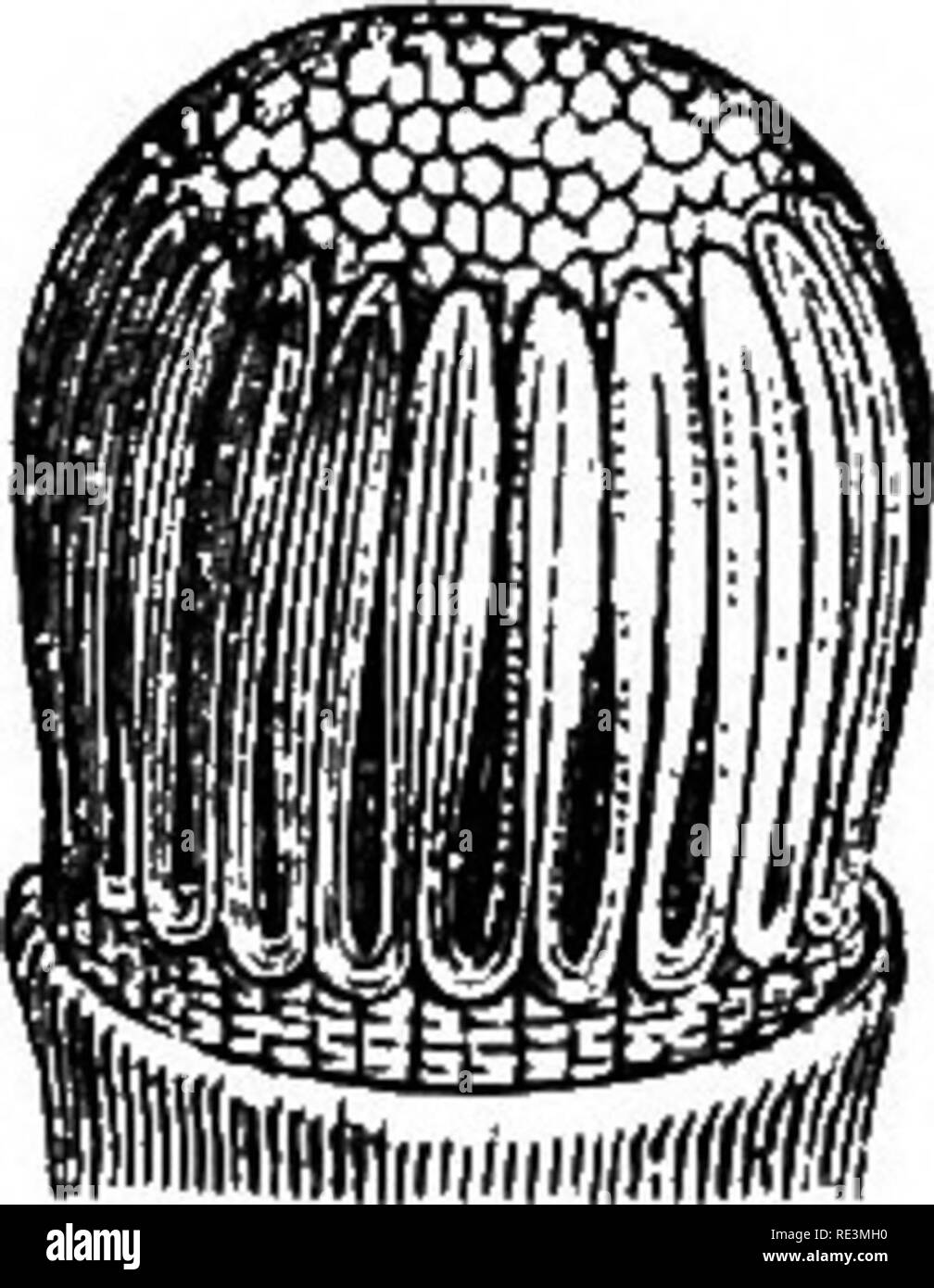 . A handbook of cryptogamic botany. Cryptogams. MUSCI 149 In most Bryaceae the tissue of the leaf is nearly homogeneous, with the exception of the margin and an elementary midrib composed of elongated prosenchymatous cells; but in Leucobryum (Hpe.) the small chloro- FlG. 117.—Sporange of Polytrichunt commune, showing epiphragm. A, covered by calypter; B, with calypter removed ; C, with opercule removed (magnified). Fig. 118.—Sporange of Hypnum populeum, showing peristome (magnified). phyllous cells interlace among large empty cells with circular orifices in their walls, as in Sphagnum. The ver Stock Photohttps://www.alamy.com/image-license-details/?v=1https://www.alamy.com/a-handbook-of-cryptogamic-botany-cryptogams-musci-149-in-most-bryaceae-the-tissue-of-the-leaf-is-nearly-homogeneous-with-the-exception-of-the-margin-and-an-elementary-midrib-composed-of-elongated-prosenchymatous-cells-but-in-leucobryum-hpe-the-small-chloro-flg-117sporange-of-polytrichunt-commune-showing-epiphragm-a-covered-by-calypter-b-with-calypter-removed-c-with-opercule-removed-magnified-fig-118sporange-of-hypnum-populeum-showing-peristome-magnified-phyllous-cells-interlace-among-large-empty-cells-with-circular-orifices-in-their-walls-as-in-sphagnum-the-ver-image232421980.html
. A handbook of cryptogamic botany. Cryptogams. MUSCI 149 In most Bryaceae the tissue of the leaf is nearly homogeneous, with the exception of the margin and an elementary midrib composed of elongated prosenchymatous cells; but in Leucobryum (Hpe.) the small chloro- FlG. 117.—Sporange of Polytrichunt commune, showing epiphragm. A, covered by calypter; B, with calypter removed ; C, with opercule removed (magnified). Fig. 118.—Sporange of Hypnum populeum, showing peristome (magnified). phyllous cells interlace among large empty cells with circular orifices in their walls, as in Sphagnum. The ver Stock Photohttps://www.alamy.com/image-license-details/?v=1https://www.alamy.com/a-handbook-of-cryptogamic-botany-cryptogams-musci-149-in-most-bryaceae-the-tissue-of-the-leaf-is-nearly-homogeneous-with-the-exception-of-the-margin-and-an-elementary-midrib-composed-of-elongated-prosenchymatous-cells-but-in-leucobryum-hpe-the-small-chloro-flg-117sporange-of-polytrichunt-commune-showing-epiphragm-a-covered-by-calypter-b-with-calypter-removed-c-with-opercule-removed-magnified-fig-118sporange-of-hypnum-populeum-showing-peristome-magnified-phyllous-cells-interlace-among-large-empty-cells-with-circular-orifices-in-their-walls-as-in-sphagnum-the-ver-image232421980.htmlRMRE3MH0–. A handbook of cryptogamic botany. Cryptogams. MUSCI 149 In most Bryaceae the tissue of the leaf is nearly homogeneous, with the exception of the margin and an elementary midrib composed of elongated prosenchymatous cells; but in Leucobryum (Hpe.) the small chloro- FlG. 117.—Sporange of Polytrichunt commune, showing epiphragm. A, covered by calypter; B, with calypter removed ; C, with opercule removed (magnified). Fig. 118.—Sporange of Hypnum populeum, showing peristome (magnified). phyllous cells interlace among large empty cells with circular orifices in their walls, as in Sphagnum. The ver
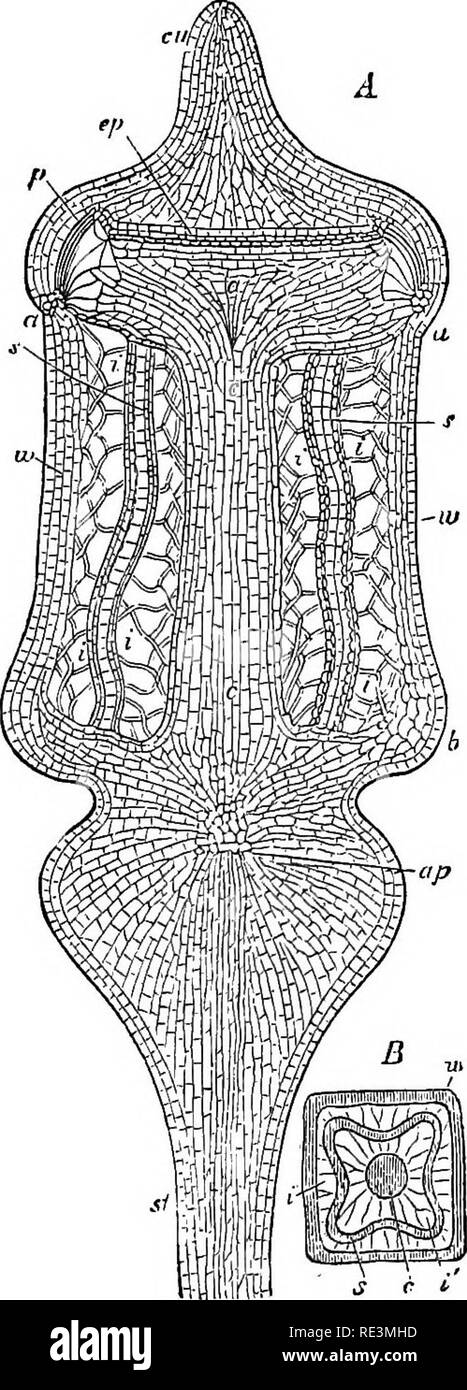 . A handbook of cryptogamic botany. Cryptogams. MVSCI 147 â which for a time fills the spore-sac, composed of two or three layers of barren cells immediately enclosing the mass of spores. Between the spore-sac and the wall of the mature sporange is an annular air-cavity, tra- versed horizontally by rows of chloro- phyllous cells, the trabecules. The opercule is simply a piece of the epi- derm of the sporange. In most genera a portion of the wall of the sporange, situated near the base of the columel, consists of an assimilating system composed of spongy or palisade- parenchyme, containing chlo Stock Photohttps://www.alamy.com/image-license-details/?v=1https://www.alamy.com/a-handbook-of-cryptogamic-botany-cryptogams-mvsci-147-which-for-a-time-fills-the-spore-sac-composed-of-two-or-three-layers-of-barren-cells-immediately-enclosing-the-mass-of-spores-between-the-spore-sac-and-the-wall-of-the-mature-sporange-is-an-annular-air-cavity-tra-versed-horizontally-by-rows-of-chloro-phyllous-cells-the-trabecules-the-opercule-is-simply-a-piece-of-the-epi-derm-of-the-sporange-in-most-genera-a-portion-of-the-wall-of-the-sporange-situated-near-the-base-of-the-columel-consists-of-an-assimilating-system-composed-of-spongy-or-palisade-parenchyme-containing-chlo-image232421993.html
. A handbook of cryptogamic botany. Cryptogams. MVSCI 147 â which for a time fills the spore-sac, composed of two or three layers of barren cells immediately enclosing the mass of spores. Between the spore-sac and the wall of the mature sporange is an annular air-cavity, tra- versed horizontally by rows of chloro- phyllous cells, the trabecules. The opercule is simply a piece of the epi- derm of the sporange. In most genera a portion of the wall of the sporange, situated near the base of the columel, consists of an assimilating system composed of spongy or palisade- parenchyme, containing chlo Stock Photohttps://www.alamy.com/image-license-details/?v=1https://www.alamy.com/a-handbook-of-cryptogamic-botany-cryptogams-mvsci-147-which-for-a-time-fills-the-spore-sac-composed-of-two-or-three-layers-of-barren-cells-immediately-enclosing-the-mass-of-spores-between-the-spore-sac-and-the-wall-of-the-mature-sporange-is-an-annular-air-cavity-tra-versed-horizontally-by-rows-of-chloro-phyllous-cells-the-trabecules-the-opercule-is-simply-a-piece-of-the-epi-derm-of-the-sporange-in-most-genera-a-portion-of-the-wall-of-the-sporange-situated-near-the-base-of-the-columel-consists-of-an-assimilating-system-composed-of-spongy-or-palisade-parenchyme-containing-chlo-image232421993.htmlRMRE3MHD–. A handbook of cryptogamic botany. Cryptogams. MVSCI 147 â which for a time fills the spore-sac, composed of two or three layers of barren cells immediately enclosing the mass of spores. Between the spore-sac and the wall of the mature sporange is an annular air-cavity, tra- versed horizontally by rows of chloro- phyllous cells, the trabecules. The opercule is simply a piece of the epi- derm of the sporange. In most genera a portion of the wall of the sporange, situated near the base of the columel, consists of an assimilating system composed of spongy or palisade- parenchyme, containing chlo
 . A handbook of cryptogamic botany. Cryptogams. 166 muscinea: thallus; while in Oxymitra (Bisch.) they are raised above the surface. The sporange is a thin-walled spherical capsule, occasionally produced under water, entirely filled with spores without true elaters or columel, and, with its calypter, depressed in the thallus. It is much less differ- entiated in its structure than in the other orders. In all the genera except Riccia and Ox;ymitra the elaters are represented by sterile cells among the spore-mother-cells. The spo- range bursts irregularly when ripe, but the spores are only set fr Stock Photohttps://www.alamy.com/image-license-details/?v=1https://www.alamy.com/a-handbook-of-cryptogamic-botany-cryptogams-166-muscinea-thallus-while-in-oxymitra-bisch-they-are-raised-above-the-surface-the-sporange-is-a-thin-walled-spherical-capsule-occasionally-produced-under-water-entirely-filled-with-spores-without-true-elaters-or-columel-and-with-its-calypter-depressed-in-the-thallus-it-is-much-less-differ-entiated-in-its-structure-than-in-the-other-orders-in-all-the-genera-except-riccia-and-oxymitra-the-elaters-are-represented-by-sterile-cells-among-the-spore-mother-cells-the-spo-range-bursts-irregularly-when-ripe-but-the-spores-are-only-set-fr-image232421816.html
. A handbook of cryptogamic botany. Cryptogams. 166 muscinea: thallus; while in Oxymitra (Bisch.) they are raised above the surface. The sporange is a thin-walled spherical capsule, occasionally produced under water, entirely filled with spores without true elaters or columel, and, with its calypter, depressed in the thallus. It is much less differ- entiated in its structure than in the other orders. In all the genera except Riccia and Ox;ymitra the elaters are represented by sterile cells among the spore-mother-cells. The spo- range bursts irregularly when ripe, but the spores are only set fr Stock Photohttps://www.alamy.com/image-license-details/?v=1https://www.alamy.com/a-handbook-of-cryptogamic-botany-cryptogams-166-muscinea-thallus-while-in-oxymitra-bisch-they-are-raised-above-the-surface-the-sporange-is-a-thin-walled-spherical-capsule-occasionally-produced-under-water-entirely-filled-with-spores-without-true-elaters-or-columel-and-with-its-calypter-depressed-in-the-thallus-it-is-much-less-differ-entiated-in-its-structure-than-in-the-other-orders-in-all-the-genera-except-riccia-and-oxymitra-the-elaters-are-represented-by-sterile-cells-among-the-spore-mother-cells-the-spo-range-bursts-irregularly-when-ripe-but-the-spores-are-only-set-fr-image232421816.htmlRMRE3MB4–. A handbook of cryptogamic botany. Cryptogams. 166 muscinea: thallus; while in Oxymitra (Bisch.) they are raised above the surface. The sporange is a thin-walled spherical capsule, occasionally produced under water, entirely filled with spores without true elaters or columel, and, with its calypter, depressed in the thallus. It is much less differ- entiated in its structure than in the other orders. In all the genera except Riccia and Ox;ymitra the elaters are represented by sterile cells among the spore-mother-cells. The spo- range bursts irregularly when ripe, but the spores are only set fr
 . Class-book of botany : being outlines of the structure, physiology and classification of plants : with a flora of the United States and Canada . Botany; Botany; Botany. Hepaticae. 523, Marohantia, sterile plant. 524—5, Fertile plant. 526, Vertical section of the fertll-receptacle; 52T, of a perianth, showing the sporange bursting. 528, One of the elators "With four spores. 529, Portion of it highly magni&ed. of the flowering plants. In the mosses, liver- worts, etc., they appear only on the full-grown plant; In the ferns, Equisetaceje, etc., they ap- pear only on the prothallus, the Stock Photohttps://www.alamy.com/image-license-details/?v=1https://www.alamy.com/class-book-of-botany-being-outlines-of-the-structure-physiology-and-classification-of-plants-with-a-flora-of-the-united-states-and-canada-botany-botany-botany-hepaticae-523-marohantia-sterile-plant-5245-fertile-plant-526-vertical-section-of-the-fertll-receptacle-52t-of-a-perianth-showing-the-sporange-bursting-528-one-of-the-elators-quotwith-four-spores-529-portion-of-it-highly-magniamped-of-the-flowering-plants-in-the-mosses-liver-worts-etc-they-appear-only-on-the-full-grown-plant-in-the-ferns-equisetaceje-etc-they-ap-pear-only-on-the-prothallus-the-image232372935.html
. Class-book of botany : being outlines of the structure, physiology and classification of plants : with a flora of the United States and Canada . Botany; Botany; Botany. Hepaticae. 523, Marohantia, sterile plant. 524—5, Fertile plant. 526, Vertical section of the fertll-receptacle; 52T, of a perianth, showing the sporange bursting. 528, One of the elators "With four spores. 529, Portion of it highly magni&ed. of the flowering plants. In the mosses, liver- worts, etc., they appear only on the full-grown plant; In the ferns, Equisetaceje, etc., they ap- pear only on the prothallus, the Stock Photohttps://www.alamy.com/image-license-details/?v=1https://www.alamy.com/class-book-of-botany-being-outlines-of-the-structure-physiology-and-classification-of-plants-with-a-flora-of-the-united-states-and-canada-botany-botany-botany-hepaticae-523-marohantia-sterile-plant-5245-fertile-plant-526-vertical-section-of-the-fertll-receptacle-52t-of-a-perianth-showing-the-sporange-bursting-528-one-of-the-elators-quotwith-four-spores-529-portion-of-it-highly-magniamped-of-the-flowering-plants-in-the-mosses-liver-worts-etc-they-appear-only-on-the-full-grown-plant-in-the-ferns-equisetaceje-etc-they-ap-pear-only-on-the-prothallus-the-image232372935.htmlRMRE1E1B–. Class-book of botany : being outlines of the structure, physiology and classification of plants : with a flora of the United States and Canada . Botany; Botany; Botany. Hepaticae. 523, Marohantia, sterile plant. 524—5, Fertile plant. 526, Vertical section of the fertll-receptacle; 52T, of a perianth, showing the sporange bursting. 528, One of the elators "With four spores. 529, Portion of it highly magni&ed. of the flowering plants. In the mosses, liver- worts, etc., they appear only on the full-grown plant; In the ferns, Equisetaceje, etc., they ap- pear only on the prothallus, the
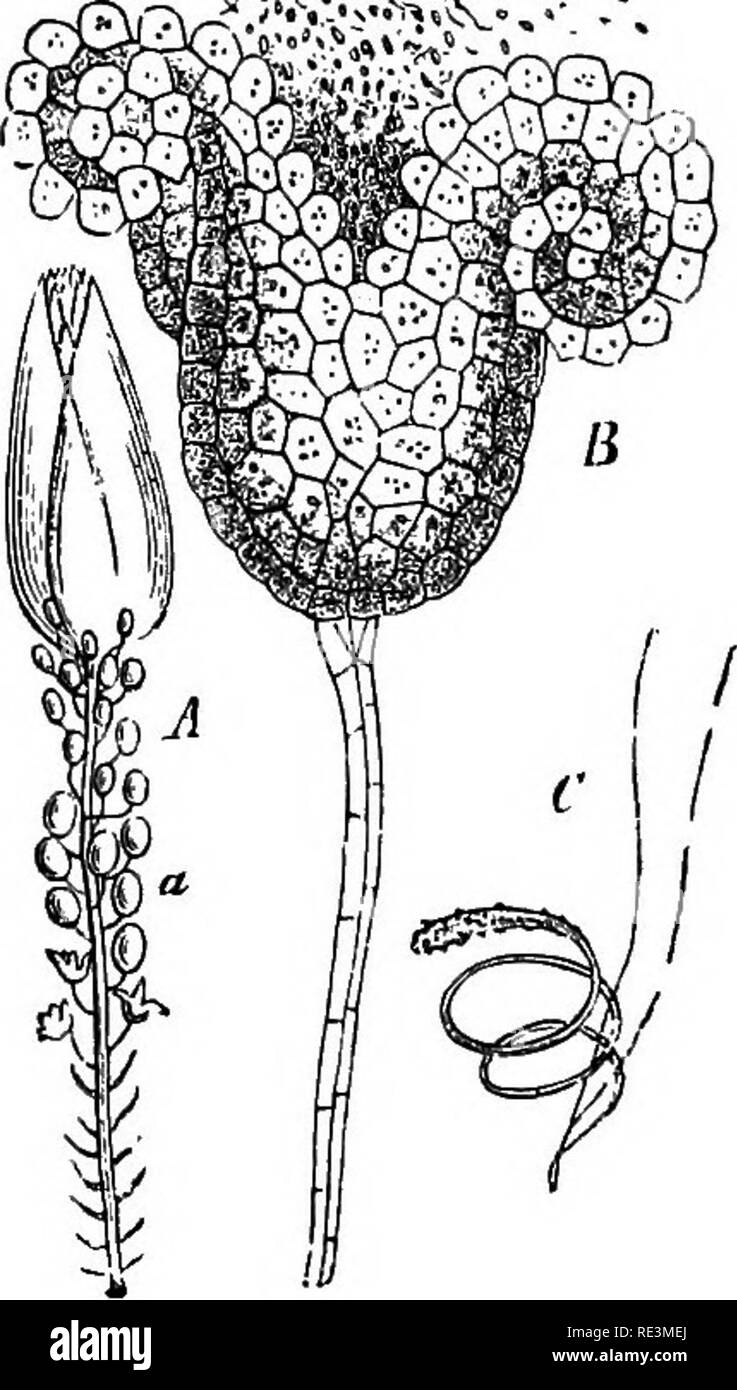 . A handbook of cryptogamic botany. Cryptogams. MUSCI T55 frill to the base of the sporange, which dehisces by a transverse slit near the apex, detaching a strongly convex opercule. There is no peristome nor annulus. A portion of the contents of the sporange remains un- differentiated in the form of a low columel not reaching to the apex. The remainder is converted into spores^ which differ from those of other mosses in being of two kinds, megaspores and microspores (see fig. 125). According to Warnstorf (' Hedwigia,' 1886, p. 89 ; and ' Verhandl. Bot.. Fig. 130.— ^. acutifolium. A, male branc Stock Photohttps://www.alamy.com/image-license-details/?v=1https://www.alamy.com/a-handbook-of-cryptogamic-botany-cryptogams-musci-t55-frill-to-the-base-of-the-sporange-which-dehisces-by-a-transverse-slit-near-the-apex-detaching-a-strongly-convex-opercule-there-is-no-peristome-nor-annulus-a-portion-of-the-contents-of-the-sporange-remains-un-differentiated-in-the-form-of-a-low-columel-not-reaching-to-the-apex-the-remainder-is-converted-into-spores-which-differ-from-those-of-other-mosses-in-being-of-two-kinds-megaspores-and-microspores-see-fig-125-according-to-warnstorf-hedwigia-1886-p-89-and-verhandl-bot-fig-130-acutifolium-a-male-branc-image232421914.html
. A handbook of cryptogamic botany. Cryptogams. MUSCI T55 frill to the base of the sporange, which dehisces by a transverse slit near the apex, detaching a strongly convex opercule. There is no peristome nor annulus. A portion of the contents of the sporange remains un- differentiated in the form of a low columel not reaching to the apex. The remainder is converted into spores^ which differ from those of other mosses in being of two kinds, megaspores and microspores (see fig. 125). According to Warnstorf (' Hedwigia,' 1886, p. 89 ; and ' Verhandl. Bot.. Fig. 130.— ^. acutifolium. A, male branc Stock Photohttps://www.alamy.com/image-license-details/?v=1https://www.alamy.com/a-handbook-of-cryptogamic-botany-cryptogams-musci-t55-frill-to-the-base-of-the-sporange-which-dehisces-by-a-transverse-slit-near-the-apex-detaching-a-strongly-convex-opercule-there-is-no-peristome-nor-annulus-a-portion-of-the-contents-of-the-sporange-remains-un-differentiated-in-the-form-of-a-low-columel-not-reaching-to-the-apex-the-remainder-is-converted-into-spores-which-differ-from-those-of-other-mosses-in-being-of-two-kinds-megaspores-and-microspores-see-fig-125-according-to-warnstorf-hedwigia-1886-p-89-and-verhandl-bot-fig-130-acutifolium-a-male-branc-image232421914.htmlRMRE3MEJ–. A handbook of cryptogamic botany. Cryptogams. MUSCI T55 frill to the base of the sporange, which dehisces by a transverse slit near the apex, detaching a strongly convex opercule. There is no peristome nor annulus. A portion of the contents of the sporange remains un- differentiated in the form of a low columel not reaching to the apex. The remainder is converted into spores^ which differ from those of other mosses in being of two kinds, megaspores and microspores (see fig. 125). According to Warnstorf (' Hedwigia,' 1886, p. 89 ; and ' Verhandl. Bot.. Fig. 130.— ^. acutifolium. A, male branc
 . Class-book of botany : being outlines of the structure, physiology and classification of plants : with a flora of the United States and Canada. Botany; Botany; Botany. HepaticsB. 523, Marchantia, sterile plant. 524—5, Fertile plant. 526, Vertical section of the fertil-receptaclc ; 527, of a perianth, showing the sporange bursting. 52S, One of tho elator* with four spores. 529, Portion of it highly magnified. of the flowering plants. In the mosses, liver- worts, etc., they appear only on the full-grown plant; in the ferns, Equisetacese, etc., they ap- pear only on the prothallus, the earliest Stock Photohttps://www.alamy.com/image-license-details/?v=1https://www.alamy.com/class-book-of-botany-being-outlines-of-the-structure-physiology-and-classification-of-plants-with-a-flora-of-the-united-states-and-canada-botany-botany-botany-hepaticsb-523-marchantia-sterile-plant-5245-fertile-plant-526-vertical-section-of-the-fertil-receptaclc-527-of-a-perianth-showing-the-sporange-bursting-52s-one-of-tho-elator-with-four-spores-529-portion-of-it-highly-magnified-of-the-flowering-plants-in-the-mosses-liver-worts-etc-they-appear-only-on-the-full-grown-plant-in-the-ferns-equisetacese-etc-they-ap-pear-only-on-the-prothallus-the-earliest-image232773223.html
. Class-book of botany : being outlines of the structure, physiology and classification of plants : with a flora of the United States and Canada. Botany; Botany; Botany. HepaticsB. 523, Marchantia, sterile plant. 524—5, Fertile plant. 526, Vertical section of the fertil-receptaclc ; 527, of a perianth, showing the sporange bursting. 52S, One of tho elator* with four spores. 529, Portion of it highly magnified. of the flowering plants. In the mosses, liver- worts, etc., they appear only on the full-grown plant; in the ferns, Equisetacese, etc., they ap- pear only on the prothallus, the earliest Stock Photohttps://www.alamy.com/image-license-details/?v=1https://www.alamy.com/class-book-of-botany-being-outlines-of-the-structure-physiology-and-classification-of-plants-with-a-flora-of-the-united-states-and-canada-botany-botany-botany-hepaticsb-523-marchantia-sterile-plant-5245-fertile-plant-526-vertical-section-of-the-fertil-receptaclc-527-of-a-perianth-showing-the-sporange-bursting-52s-one-of-tho-elator-with-four-spores-529-portion-of-it-highly-magnified-of-the-flowering-plants-in-the-mosses-liver-worts-etc-they-appear-only-on-the-full-grown-plant-in-the-ferns-equisetacese-etc-they-ap-pear-only-on-the-prothallus-the-earliest-image232773223.htmlRMREKMHB–. Class-book of botany : being outlines of the structure, physiology and classification of plants : with a flora of the United States and Canada. Botany; Botany; Botany. HepaticsB. 523, Marchantia, sterile plant. 524—5, Fertile plant. 526, Vertical section of the fertil-receptaclc ; 527, of a perianth, showing the sporange bursting. 52S, One of tho elator* with four spores. 529, Portion of it highly magnified. of the flowering plants. In the mosses, liver- worts, etc., they appear only on the full-grown plant; in the ferns, Equisetacese, etc., they ap- pear only on the prothallus, the earliest
 . Class-book of botany: being outlines of the structure, physiology and classification of plants; with a flora of the United States and Canada. Botany; Plants; Plants. Hepatic*. 523, Marchantia, sterile plant. 524—5, Fertile plant. 52G, Vertical section of the fertil-receptacle ; 527, of a perianth, showing the sporange bursting. 528, One of the elators with four spores. 529, Portion of it highly magnified. 543 544 of the flowering plants. In the mosses, liver- worts, etc., they appear only on the fall-grown plant; in the ferns, Equisetacese, etc., they ap- pear only on the prothallus, the ear Stock Photohttps://www.alamy.com/image-license-details/?v=1https://www.alamy.com/class-book-of-botany-being-outlines-of-the-structure-physiology-and-classification-of-plants-with-a-flora-of-the-united-states-and-canada-botany-plants-plants-hepatic-523-marchantia-sterile-plant-5245-fertile-plant-52g-vertical-section-of-the-fertil-receptacle-527-of-a-perianth-showing-the-sporange-bursting-528-one-of-the-elators-with-four-spores-529-portion-of-it-highly-magnified-543-544-of-the-flowering-plants-in-the-mosses-liver-worts-etc-they-appear-only-on-the-fall-grown-plant-in-the-ferns-equisetacese-etc-they-ap-pear-only-on-the-prothallus-the-ear-image232773603.html
. Class-book of botany: being outlines of the structure, physiology and classification of plants; with a flora of the United States and Canada. Botany; Plants; Plants. Hepatic*. 523, Marchantia, sterile plant. 524—5, Fertile plant. 52G, Vertical section of the fertil-receptacle ; 527, of a perianth, showing the sporange bursting. 528, One of the elators with four spores. 529, Portion of it highly magnified. 543 544 of the flowering plants. In the mosses, liver- worts, etc., they appear only on the fall-grown plant; in the ferns, Equisetacese, etc., they ap- pear only on the prothallus, the ear Stock Photohttps://www.alamy.com/image-license-details/?v=1https://www.alamy.com/class-book-of-botany-being-outlines-of-the-structure-physiology-and-classification-of-plants-with-a-flora-of-the-united-states-and-canada-botany-plants-plants-hepatic-523-marchantia-sterile-plant-5245-fertile-plant-52g-vertical-section-of-the-fertil-receptacle-527-of-a-perianth-showing-the-sporange-bursting-528-one-of-the-elators-with-four-spores-529-portion-of-it-highly-magnified-543-544-of-the-flowering-plants-in-the-mosses-liver-worts-etc-they-appear-only-on-the-fall-grown-plant-in-the-ferns-equisetacese-etc-they-ap-pear-only-on-the-prothallus-the-ear-image232773603.htmlRMREKN2Y–. Class-book of botany: being outlines of the structure, physiology and classification of plants; with a flora of the United States and Canada. Botany; Plants; Plants. Hepatic*. 523, Marchantia, sterile plant. 524—5, Fertile plant. 52G, Vertical section of the fertil-receptacle ; 527, of a perianth, showing the sporange bursting. 528, One of the elators with four spores. 529, Portion of it highly magnified. 543 544 of the flowering plants. In the mosses, liver- worts, etc., they appear only on the fall-grown plant; in the ferns, Equisetacese, etc., they ap- pear only on the prothallus, the ear
 . Class-book of botany : being outlines of the structure, physiology and classification of plants : with a flora of the United States and Canada . Botany; Botany; Botany. THE CRTPTOGAMIA OB FLOWERLESS PLANTS. 625 524 127. Hepaticae. 523, Marohantia, sterile plant. 524—5, Fertile plant. 526, Vertical section of the fertll-receptacle; 52T, of a perianth, showing the sporange bursting. 528, One of the elators "With four spores. 529, Portion of it highly magni&ed. of the flowering plants. In the mosses, liver- worts, etc., they appear only on the full-grown plant; In the ferns, Equisetace Stock Photohttps://www.alamy.com/image-license-details/?v=1https://www.alamy.com/class-book-of-botany-being-outlines-of-the-structure-physiology-and-classification-of-plants-with-a-flora-of-the-united-states-and-canada-botany-botany-botany-the-crtptogamia-ob-flowerless-plants-625-524-127-hepaticae-523-marohantia-sterile-plant-5245-fertile-plant-526-vertical-section-of-the-fertll-receptacle-52t-of-a-perianth-showing-the-sporange-bursting-528-one-of-the-elators-quotwith-four-spores-529-portion-of-it-highly-magniamped-of-the-flowering-plants-in-the-mosses-liver-worts-etc-they-appear-only-on-the-full-grown-plant-in-the-ferns-equisetace-image232372939.html
. Class-book of botany : being outlines of the structure, physiology and classification of plants : with a flora of the United States and Canada . Botany; Botany; Botany. THE CRTPTOGAMIA OB FLOWERLESS PLANTS. 625 524 127. Hepaticae. 523, Marohantia, sterile plant. 524—5, Fertile plant. 526, Vertical section of the fertll-receptacle; 52T, of a perianth, showing the sporange bursting. 528, One of the elators "With four spores. 529, Portion of it highly magni&ed. of the flowering plants. In the mosses, liver- worts, etc., they appear only on the full-grown plant; In the ferns, Equisetace Stock Photohttps://www.alamy.com/image-license-details/?v=1https://www.alamy.com/class-book-of-botany-being-outlines-of-the-structure-physiology-and-classification-of-plants-with-a-flora-of-the-united-states-and-canada-botany-botany-botany-the-crtptogamia-ob-flowerless-plants-625-524-127-hepaticae-523-marohantia-sterile-plant-5245-fertile-plant-526-vertical-section-of-the-fertll-receptacle-52t-of-a-perianth-showing-the-sporange-bursting-528-one-of-the-elators-quotwith-four-spores-529-portion-of-it-highly-magniamped-of-the-flowering-plants-in-the-mosses-liver-worts-etc-they-appear-only-on-the-full-grown-plant-in-the-ferns-equisetace-image232372939.htmlRMRE1E1F–. Class-book of botany : being outlines of the structure, physiology and classification of plants : with a flora of the United States and Canada . Botany; Botany; Botany. THE CRTPTOGAMIA OB FLOWERLESS PLANTS. 625 524 127. Hepaticae. 523, Marohantia, sterile plant. 524—5, Fertile plant. 526, Vertical section of the fertll-receptacle; 52T, of a perianth, showing the sporange bursting. 528, One of the elators "With four spores. 529, Portion of it highly magni&ed. of the flowering plants. In the mosses, liver- worts, etc., they appear only on the full-grown plant; In the ferns, Equisetace
 . A handbook of cryptogamic botany. Cryptogams. Fig. 144.—Antkoceros l(nfhj.^ male plant (natural size). Fig. t.^^,—Monoclea Forsieri Hook, (magnified). Fig. 145. —A, Itevis. a, dehiscent sporange (X 2). Order 3.—Anthoceroteae. The vegetative structure consists of a flat ribbon-like thallus, the irregular dichotomous ramifications of which form a circular disc composed of one or more layers of cells, each cell containing only a. Please note that these images are extracted from scanned page images that may have been digitally enhanced for readability - coloration and appearance of these illust Stock Photohttps://www.alamy.com/image-license-details/?v=1https://www.alamy.com/a-handbook-of-cryptogamic-botany-cryptogams-fig-144antkoceros-lnfhj-male-plant-natural-size-fig-tmonoclea-forsieri-hook-magnified-fig-145-a-itevis-a-dehiscent-sporange-x-2-order-3anthoceroteae-the-vegetative-structure-consists-of-a-flat-ribbon-like-thallus-the-irregular-dichotomous-ramifications-of-which-form-a-circular-disc-composed-of-one-or-more-layers-of-cells-each-cell-containing-only-a-please-note-that-these-images-are-extracted-from-scanned-page-images-that-may-have-been-digitally-enhanced-for-readability-coloration-and-appearance-of-these-illust-image232421823.html
. A handbook of cryptogamic botany. Cryptogams. Fig. 144.—Antkoceros l(nfhj.^ male plant (natural size). Fig. t.^^,—Monoclea Forsieri Hook, (magnified). Fig. 145. —A, Itevis. a, dehiscent sporange (X 2). Order 3.—Anthoceroteae. The vegetative structure consists of a flat ribbon-like thallus, the irregular dichotomous ramifications of which form a circular disc composed of one or more layers of cells, each cell containing only a. Please note that these images are extracted from scanned page images that may have been digitally enhanced for readability - coloration and appearance of these illust Stock Photohttps://www.alamy.com/image-license-details/?v=1https://www.alamy.com/a-handbook-of-cryptogamic-botany-cryptogams-fig-144antkoceros-lnfhj-male-plant-natural-size-fig-tmonoclea-forsieri-hook-magnified-fig-145-a-itevis-a-dehiscent-sporange-x-2-order-3anthoceroteae-the-vegetative-structure-consists-of-a-flat-ribbon-like-thallus-the-irregular-dichotomous-ramifications-of-which-form-a-circular-disc-composed-of-one-or-more-layers-of-cells-each-cell-containing-only-a-please-note-that-these-images-are-extracted-from-scanned-page-images-that-may-have-been-digitally-enhanced-for-readability-coloration-and-appearance-of-these-illust-image232421823.htmlRMRE3MBB–. A handbook of cryptogamic botany. Cryptogams. Fig. 144.—Antkoceros l(nfhj.^ male plant (natural size). Fig. t.^^,—Monoclea Forsieri Hook, (magnified). Fig. 145. —A, Itevis. a, dehiscent sporange (X 2). Order 3.—Anthoceroteae. The vegetative structure consists of a flat ribbon-like thallus, the irregular dichotomous ramifications of which form a circular disc composed of one or more layers of cells, each cell containing only a. Please note that these images are extracted from scanned page images that may have been digitally enhanced for readability - coloration and appearance of these illust
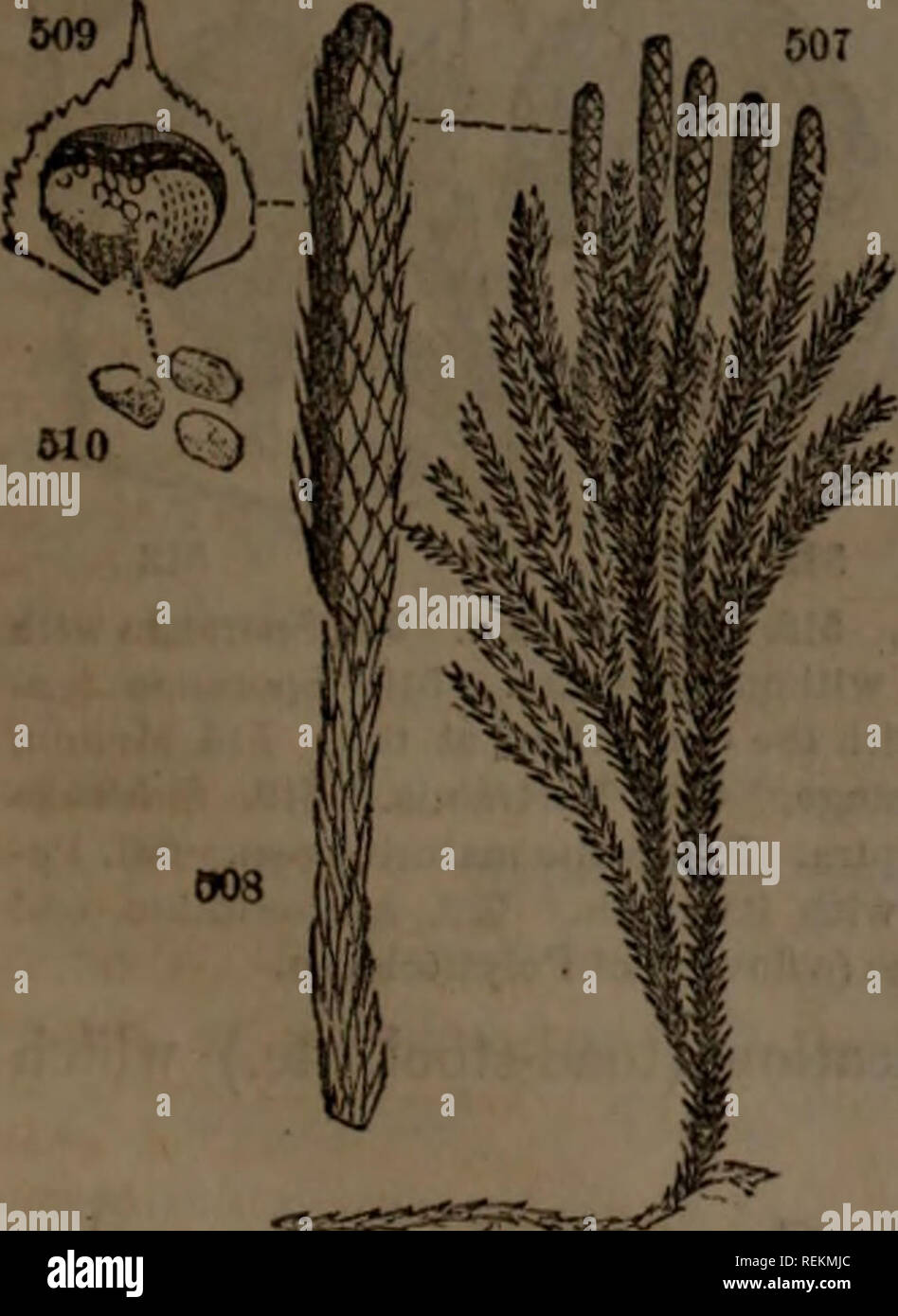 . Class-book of botany : being outlines of the structure, physiology and classification of plants : with a flora of the United States and Canada. Botany; Botany; Botany. 502 503 502, Equisetum aryense. 60S, E. sylvaticuni. 604. Section of the spike. 505, A sporange. 506, A spore with its elators coiled. 504 506. 507, Lycopodinm dendroideutn. 50S, A single spike. 509, a scale with its sporange bursting 510, Spores. 624. Classes. The tribe last mentioned are embraced in the class Acrogens, so named by Lindley from their manner of growth (drcpov, point or summit), lengthening into an axis. The re Stock Photohttps://www.alamy.com/image-license-details/?v=1https://www.alamy.com/class-book-of-botany-being-outlines-of-the-structure-physiology-and-classification-of-plants-with-a-flora-of-the-united-states-and-canada-botany-botany-botany-502-503-502-equisetum-aryense-60s-e-sylvaticuni-604-section-of-the-spike-505-a-sporange-506-a-spore-with-its-elators-coiled-504-506-507-lycopodinm-dendroideutn-50s-a-single-spike-509-a-scale-with-its-sporange-bursting-510-spores-624-classes-the-tribe-last-mentioned-are-embraced-in-the-class-acrogens-so-named-by-lindley-from-their-manner-of-growth-drcpov-point-or-summit-lengthening-into-an-axis-the-re-image232773252.html
. Class-book of botany : being outlines of the structure, physiology and classification of plants : with a flora of the United States and Canada. Botany; Botany; Botany. 502 503 502, Equisetum aryense. 60S, E. sylvaticuni. 604. Section of the spike. 505, A sporange. 506, A spore with its elators coiled. 504 506. 507, Lycopodinm dendroideutn. 50S, A single spike. 509, a scale with its sporange bursting 510, Spores. 624. Classes. The tribe last mentioned are embraced in the class Acrogens, so named by Lindley from their manner of growth (drcpov, point or summit), lengthening into an axis. The re Stock Photohttps://www.alamy.com/image-license-details/?v=1https://www.alamy.com/class-book-of-botany-being-outlines-of-the-structure-physiology-and-classification-of-plants-with-a-flora-of-the-united-states-and-canada-botany-botany-botany-502-503-502-equisetum-aryense-60s-e-sylvaticuni-604-section-of-the-spike-505-a-sporange-506-a-spore-with-its-elators-coiled-504-506-507-lycopodinm-dendroideutn-50s-a-single-spike-509-a-scale-with-its-sporange-bursting-510-spores-624-classes-the-tribe-last-mentioned-are-embraced-in-the-class-acrogens-so-named-by-lindley-from-their-manner-of-growth-drcpov-point-or-summit-lengthening-into-an-axis-the-re-image232773252.htmlRMREKMJC–. Class-book of botany : being outlines of the structure, physiology and classification of plants : with a flora of the United States and Canada. Botany; Botany; Botany. 502 503 502, Equisetum aryense. 60S, E. sylvaticuni. 604. Section of the spike. 505, A sporange. 506, A spore with its elators coiled. 504 506. 507, Lycopodinm dendroideutn. 50S, A single spike. 509, a scale with its sporange bursting 510, Spores. 624. Classes. The tribe last mentioned are embraced in the class Acrogens, so named by Lindley from their manner of growth (drcpov, point or summit), lengthening into an axis. The re
 . A handbook of cryptogamic botany. Cryptogams. 238 ALGM from its own mother-cell, or an opening is formed at the apex of the sporange through which all the zoospores escape after dissolution of the septa. The zoospores are in all cases imbedded in mucilage ; no differ-. FlG. 212.—Giraudia spkacelarioides D. and S. a, upper portion of thallus (x 250) ; h, lower portion with multilocular sporanges(x 250). (After Areschoug.) c, portion of filament with unilocular sporanges ( x 6o3). (After Hauck.). Please note that these images are extracted from scanned page images that may have been digitally Stock Photohttps://www.alamy.com/image-license-details/?v=1https://www.alamy.com/a-handbook-of-cryptogamic-botany-cryptogams-238-algm-from-its-own-mother-cell-or-an-opening-is-formed-at-the-apex-of-the-sporange-through-which-all-the-zoospores-escape-after-dissolution-of-the-septa-the-zoospores-are-in-all-cases-imbedded-in-mucilage-no-differ-flg-212giraudia-spkacelarioides-d-and-s-a-upper-portion-of-thallus-x-250-h-lower-portion-with-multilocular-sporangesx-250-after-areschoug-c-portion-of-filament-with-unilocular-sporanges-x-6o3-after-hauck-please-note-that-these-images-are-extracted-from-scanned-page-images-that-may-have-been-digitally-image232382845.html
. A handbook of cryptogamic botany. Cryptogams. 238 ALGM from its own mother-cell, or an opening is formed at the apex of the sporange through which all the zoospores escape after dissolution of the septa. The zoospores are in all cases imbedded in mucilage ; no differ-. FlG. 212.—Giraudia spkacelarioides D. and S. a, upper portion of thallus (x 250) ; h, lower portion with multilocular sporanges(x 250). (After Areschoug.) c, portion of filament with unilocular sporanges ( x 6o3). (After Hauck.). Please note that these images are extracted from scanned page images that may have been digitally Stock Photohttps://www.alamy.com/image-license-details/?v=1https://www.alamy.com/a-handbook-of-cryptogamic-botany-cryptogams-238-algm-from-its-own-mother-cell-or-an-opening-is-formed-at-the-apex-of-the-sporange-through-which-all-the-zoospores-escape-after-dissolution-of-the-septa-the-zoospores-are-in-all-cases-imbedded-in-mucilage-no-differ-flg-212giraudia-spkacelarioides-d-and-s-a-upper-portion-of-thallus-x-250-h-lower-portion-with-multilocular-sporangesx-250-after-areschoug-c-portion-of-filament-with-unilocular-sporanges-x-6o3-after-hauck-please-note-that-these-images-are-extracted-from-scanned-page-images-that-may-have-been-digitally-image232382845.htmlRMRE1XK9–. A handbook of cryptogamic botany. Cryptogams. 238 ALGM from its own mother-cell, or an opening is formed at the apex of the sporange through which all the zoospores escape after dissolution of the septa. The zoospores are in all cases imbedded in mucilage ; no differ-. FlG. 212.—Giraudia spkacelarioides D. and S. a, upper portion of thallus (x 250) ; h, lower portion with multilocular sporanges(x 250). (After Areschoug.) c, portion of filament with unilocular sporanges ( x 6o3). (After Hauck.). Please note that these images are extracted from scanned page images that may have been digitally
 . Class-book of botany : being outlines of the structure, physiology and classification of plants : with a flora of the United States and Canada. Botany; Botany; Botany. THE CRYPTOGAMIA OR FLOWERLESS PLANTS. 127 526. HepaticsB. 523, Marchantia, sterile plant. 524—5, Fertile plant. 526, Vertical section of the fertil-receptaclc ; 527, of a perianth, showing the sporange bursting. 52S, One of tho elator* with four spores. 529, Portion of it highly magnified. of the flowering plants. In the mosses, liver- worts, etc., they appear only on the full-grown plant; in the ferns, Equisetacese, etc., the Stock Photohttps://www.alamy.com/image-license-details/?v=1https://www.alamy.com/class-book-of-botany-being-outlines-of-the-structure-physiology-and-classification-of-plants-with-a-flora-of-the-united-states-and-canada-botany-botany-botany-the-cryptogamia-or-flowerless-plants-127-526-hepaticsb-523-marchantia-sterile-plant-5245-fertile-plant-526-vertical-section-of-the-fertil-receptaclc-527-of-a-perianth-showing-the-sporange-bursting-52s-one-of-tho-elator-with-four-spores-529-portion-of-it-highly-magnified-of-the-flowering-plants-in-the-mosses-liver-worts-etc-they-appear-only-on-the-full-grown-plant-in-the-ferns-equisetacese-etc-the-image232773229.html
. Class-book of botany : being outlines of the structure, physiology and classification of plants : with a flora of the United States and Canada. Botany; Botany; Botany. THE CRYPTOGAMIA OR FLOWERLESS PLANTS. 127 526. HepaticsB. 523, Marchantia, sterile plant. 524—5, Fertile plant. 526, Vertical section of the fertil-receptaclc ; 527, of a perianth, showing the sporange bursting. 52S, One of tho elator* with four spores. 529, Portion of it highly magnified. of the flowering plants. In the mosses, liver- worts, etc., they appear only on the full-grown plant; in the ferns, Equisetacese, etc., the Stock Photohttps://www.alamy.com/image-license-details/?v=1https://www.alamy.com/class-book-of-botany-being-outlines-of-the-structure-physiology-and-classification-of-plants-with-a-flora-of-the-united-states-and-canada-botany-botany-botany-the-cryptogamia-or-flowerless-plants-127-526-hepaticsb-523-marchantia-sterile-plant-5245-fertile-plant-526-vertical-section-of-the-fertil-receptaclc-527-of-a-perianth-showing-the-sporange-bursting-52s-one-of-tho-elator-with-four-spores-529-portion-of-it-highly-magnified-of-the-flowering-plants-in-the-mosses-liver-worts-etc-they-appear-only-on-the-full-grown-plant-in-the-ferns-equisetacese-etc-the-image232773229.htmlRMREKMHH–. Class-book of botany : being outlines of the structure, physiology and classification of plants : with a flora of the United States and Canada. Botany; Botany; Botany. THE CRYPTOGAMIA OR FLOWERLESS PLANTS. 127 526. HepaticsB. 523, Marchantia, sterile plant. 524—5, Fertile plant. 526, Vertical section of the fertil-receptaclc ; 527, of a perianth, showing the sporange bursting. 52S, One of tho elator* with four spores. 529, Portion of it highly magnified. of the flowering plants. In the mosses, liver- worts, etc., they appear only on the full-grown plant; in the ferns, Equisetacese, etc., the
 . Class-book of botany: being outlines of the structure, physiology and classification of plants; with a flora of the United States and Canada. Botany; Plants; Plants. THE CRYPTOGAMIA OR FLOWERLESS PLANTS. 127 525. Hepatic*. 523, Marchantia, sterile plant. 524—5, Fertile plant. 52G, Vertical section of the fertil-receptacle ; 527, of a perianth, showing the sporange bursting. 528, One of the elators with four spores. 529, Portion of it highly magnified. 543 544 of the flowering plants. In the mosses, liver- worts, etc., they appear only on the fall-grown plant; in the ferns, Equisetacese, etc. Stock Photohttps://www.alamy.com/image-license-details/?v=1https://www.alamy.com/class-book-of-botany-being-outlines-of-the-structure-physiology-and-classification-of-plants-with-a-flora-of-the-united-states-and-canada-botany-plants-plants-the-cryptogamia-or-flowerless-plants-127-525-hepatic-523-marchantia-sterile-plant-5245-fertile-plant-52g-vertical-section-of-the-fertil-receptacle-527-of-a-perianth-showing-the-sporange-bursting-528-one-of-the-elators-with-four-spores-529-portion-of-it-highly-magnified-543-544-of-the-flowering-plants-in-the-mosses-liver-worts-etc-they-appear-only-on-the-fall-grown-plant-in-the-ferns-equisetacese-etc-image232773610.html
. Class-book of botany: being outlines of the structure, physiology and classification of plants; with a flora of the United States and Canada. Botany; Plants; Plants. THE CRYPTOGAMIA OR FLOWERLESS PLANTS. 127 525. Hepatic*. 523, Marchantia, sterile plant. 524—5, Fertile plant. 52G, Vertical section of the fertil-receptacle ; 527, of a perianth, showing the sporange bursting. 528, One of the elators with four spores. 529, Portion of it highly magnified. 543 544 of the flowering plants. In the mosses, liver- worts, etc., they appear only on the fall-grown plant; in the ferns, Equisetacese, etc. Stock Photohttps://www.alamy.com/image-license-details/?v=1https://www.alamy.com/class-book-of-botany-being-outlines-of-the-structure-physiology-and-classification-of-plants-with-a-flora-of-the-united-states-and-canada-botany-plants-plants-the-cryptogamia-or-flowerless-plants-127-525-hepatic-523-marchantia-sterile-plant-5245-fertile-plant-52g-vertical-section-of-the-fertil-receptacle-527-of-a-perianth-showing-the-sporange-bursting-528-one-of-the-elators-with-four-spores-529-portion-of-it-highly-magnified-543-544-of-the-flowering-plants-in-the-mosses-liver-worts-etc-they-appear-only-on-the-fall-grown-plant-in-the-ferns-equisetacese-etc-image232773610.htmlRMREKN36–. Class-book of botany: being outlines of the structure, physiology and classification of plants; with a flora of the United States and Canada. Botany; Plants; Plants. THE CRYPTOGAMIA OR FLOWERLESS PLANTS. 127 525. Hepatic*. 523, Marchantia, sterile plant. 524—5, Fertile plant. 52G, Vertical section of the fertil-receptacle ; 527, of a perianth, showing the sporange bursting. 528, One of the elators with four spores. 529, Portion of it highly magnified. 543 544 of the flowering plants. In the mosses, liver- worts, etc., they appear only on the fall-grown plant; in the ferns, Equisetacese, etc.
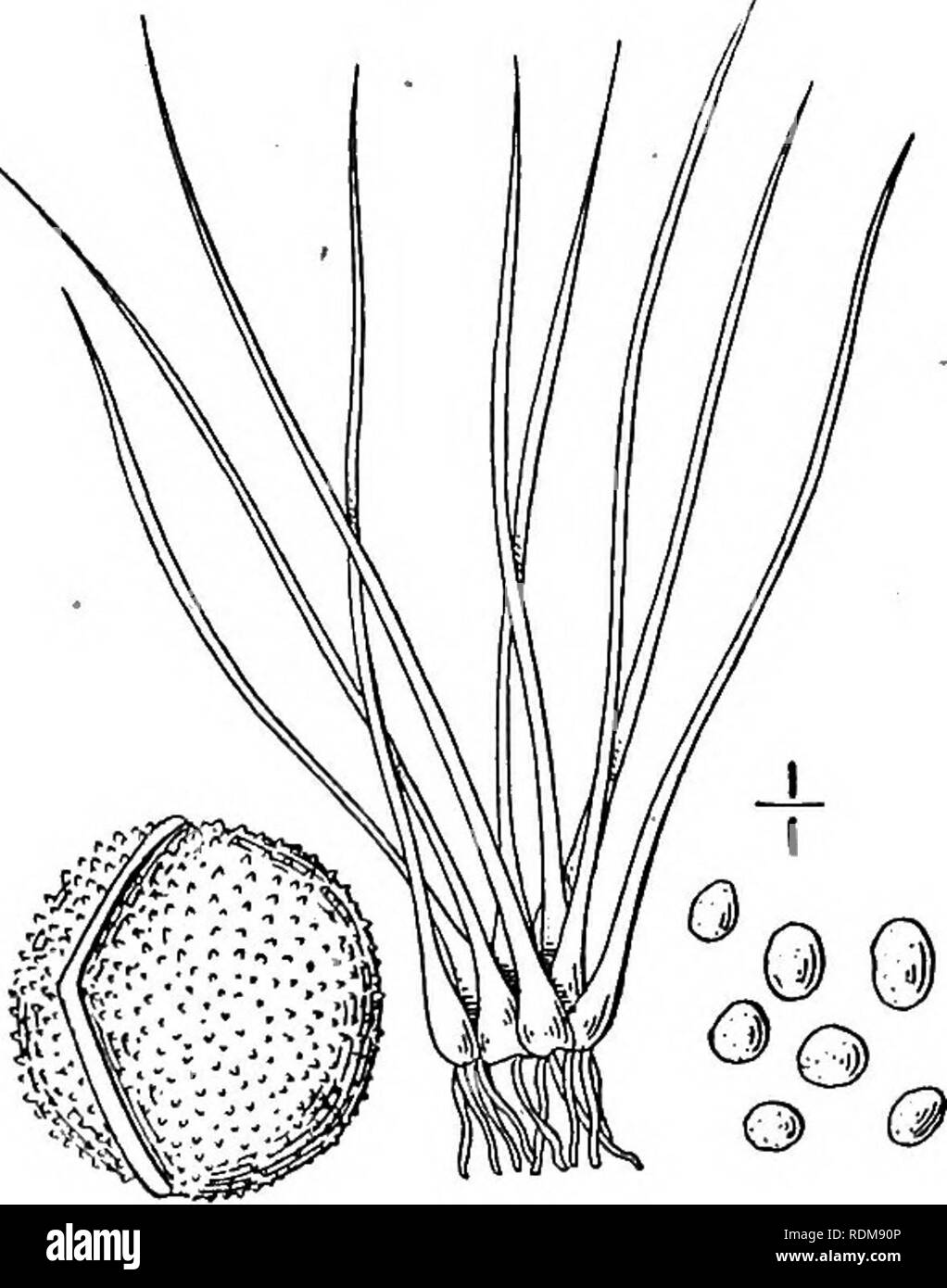 . An illustrated flora of the northern United States, Canada and the British possessions, from Newfoundland to the parallel of the southern boundary of Virginia, and from the Atlantic Ocean westward to the 102d meridian. Botany; Botany. 52 ISOETACEAE. Vol. I.. 5. Isoetes saccharata Engelm. Sugary Quill- wort. Fig. 122. Isoetes saccharata Engelm. in A. Gray, Man. Ed. 5, 676. 1867. Amphibious or uliginous with a flat depressed trunk. Leaves' 10-30, green, pale at the base, spreading, 2-3' long, quadrangular, bearing numerous stomata; sporange oblong, unspotted, with a narrow velum covering only Stock Photohttps://www.alamy.com/image-license-details/?v=1https://www.alamy.com/an-illustrated-flora-of-the-northern-united-states-canada-and-the-british-possessions-from-newfoundland-to-the-parallel-of-the-southern-boundary-of-virginia-and-from-the-atlantic-ocean-westward-to-the-102d-meridian-botany-botany-52-isoetaceae-vol-i-5-isoetes-saccharata-engelm-sugary-quill-wort-fig-122-isoetes-saccharata-engelm-in-a-gray-man-ed-5-676-1867-amphibious-or-uliginous-with-a-flat-depressed-trunk-leaves-10-30-green-pale-at-the-base-spreading-2-3-long-quadrangular-bearing-numerous-stomata-sporange-oblong-unspotted-with-a-narrow-velum-covering-only-image232171430.html
. An illustrated flora of the northern United States, Canada and the British possessions, from Newfoundland to the parallel of the southern boundary of Virginia, and from the Atlantic Ocean westward to the 102d meridian. Botany; Botany. 52 ISOETACEAE. Vol. I.. 5. Isoetes saccharata Engelm. Sugary Quill- wort. Fig. 122. Isoetes saccharata Engelm. in A. Gray, Man. Ed. 5, 676. 1867. Amphibious or uliginous with a flat depressed trunk. Leaves' 10-30, green, pale at the base, spreading, 2-3' long, quadrangular, bearing numerous stomata; sporange oblong, unspotted, with a narrow velum covering only Stock Photohttps://www.alamy.com/image-license-details/?v=1https://www.alamy.com/an-illustrated-flora-of-the-northern-united-states-canada-and-the-british-possessions-from-newfoundland-to-the-parallel-of-the-southern-boundary-of-virginia-and-from-the-atlantic-ocean-westward-to-the-102d-meridian-botany-botany-52-isoetaceae-vol-i-5-isoetes-saccharata-engelm-sugary-quill-wort-fig-122-isoetes-saccharata-engelm-in-a-gray-man-ed-5-676-1867-amphibious-or-uliginous-with-a-flat-depressed-trunk-leaves-10-30-green-pale-at-the-base-spreading-2-3-long-quadrangular-bearing-numerous-stomata-sporange-oblong-unspotted-with-a-narrow-velum-covering-only-image232171430.htmlRMRDM90P–. An illustrated flora of the northern United States, Canada and the British possessions, from Newfoundland to the parallel of the southern boundary of Virginia, and from the Atlantic Ocean westward to the 102d meridian. Botany; Botany. 52 ISOETACEAE. Vol. I.. 5. Isoetes saccharata Engelm. Sugary Quill- wort. Fig. 122. Isoetes saccharata Engelm. in A. Gray, Man. Ed. 5, 676. 1867. Amphibious or uliginous with a flat depressed trunk. Leaves' 10-30, green, pale at the base, spreading, 2-3' long, quadrangular, bearing numerous stomata; sporange oblong, unspotted, with a narrow velum covering only
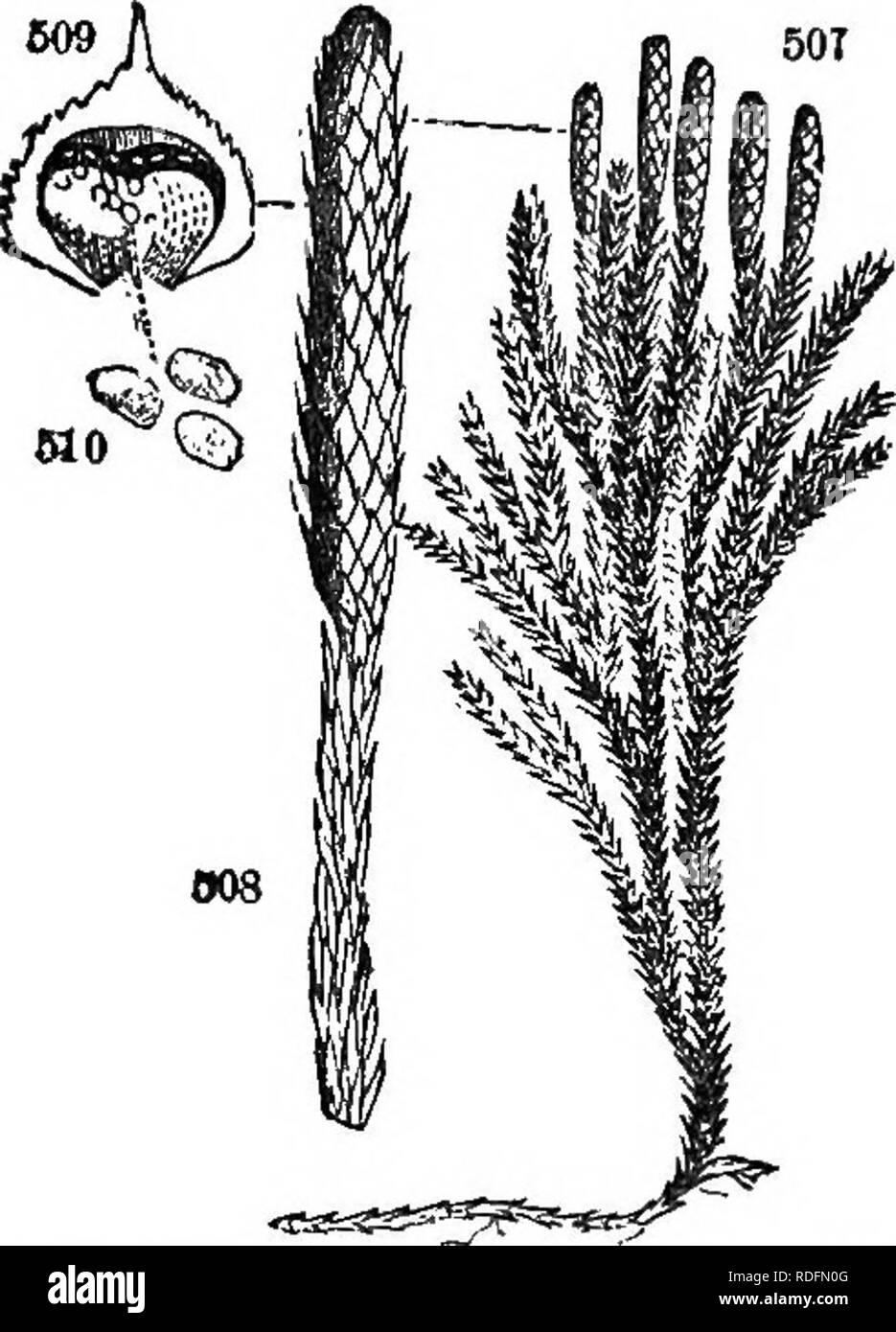 . Class-book of botany : being outlines of the structure, physiology, and classification of plants ; with a flora of the United States and Canada . Botany; Botany; Botany. 504 S06 002 603 502, Equiaetam arvense. 503, E. Bylvaticum. 504. Section of the spike. 505, A sporange. 506, A epore witli its elators coiled.. 807, Lycopodium dendroideum. 60S, A single spike. 609, a scale with Its sporange barsting. 510, Spores. 624. Classes. The tribe last mentioned are embraced in the class Acrogens, so named by Lindley from their manner of growth (anpov, point or summit), lengthening into an axis. The r Stock Photohttps://www.alamy.com/image-license-details/?v=1https://www.alamy.com/class-book-of-botany-being-outlines-of-the-structure-physiology-and-classification-of-plants-with-a-flora-of-the-united-states-and-canada-botany-botany-botany-504-s06-002-603-502-equiaetam-arvense-503-e-bylvaticum-504-section-of-the-spike-505-a-sporange-506-a-epore-witli-its-elators-coiled-807-lycopodium-dendroideum-60s-a-single-spike-609-a-scale-with-its-sporange-barsting-510-spores-624-classes-the-tribe-last-mentioned-are-embraced-in-the-class-acrogens-so-named-by-lindley-from-their-manner-of-growth-anpov-point-or-summit-lengthening-into-an-axis-the-r-image232071072.html
. Class-book of botany : being outlines of the structure, physiology, and classification of plants ; with a flora of the United States and Canada . Botany; Botany; Botany. 504 S06 002 603 502, Equiaetam arvense. 503, E. Bylvaticum. 504. Section of the spike. 505, A sporange. 506, A epore witli its elators coiled.. 807, Lycopodium dendroideum. 60S, A single spike. 609, a scale with Its sporange barsting. 510, Spores. 624. Classes. The tribe last mentioned are embraced in the class Acrogens, so named by Lindley from their manner of growth (anpov, point or summit), lengthening into an axis. The r Stock Photohttps://www.alamy.com/image-license-details/?v=1https://www.alamy.com/class-book-of-botany-being-outlines-of-the-structure-physiology-and-classification-of-plants-with-a-flora-of-the-united-states-and-canada-botany-botany-botany-504-s06-002-603-502-equiaetam-arvense-503-e-bylvaticum-504-section-of-the-spike-505-a-sporange-506-a-epore-witli-its-elators-coiled-807-lycopodium-dendroideum-60s-a-single-spike-609-a-scale-with-its-sporange-barsting-510-spores-624-classes-the-tribe-last-mentioned-are-embraced-in-the-class-acrogens-so-named-by-lindley-from-their-manner-of-growth-anpov-point-or-summit-lengthening-into-an-axis-the-r-image232071072.htmlRMRDFN0G–. Class-book of botany : being outlines of the structure, physiology, and classification of plants ; with a flora of the United States and Canada . Botany; Botany; Botany. 504 S06 002 603 502, Equiaetam arvense. 503, E. Bylvaticum. 504. Section of the spike. 505, A sporange. 506, A epore witli its elators coiled.. 807, Lycopodium dendroideum. 60S, A single spike. 609, a scale with Its sporange barsting. 510, Spores. 624. Classes. The tribe last mentioned are embraced in the class Acrogens, so named by Lindley from their manner of growth (anpov, point or summit), lengthening into an axis. The r
![. Class-book of botany [microform] : being outlines of the structures, physiology, and classification of plants : with a flora of the United States and Canada. Botany; Botany; Plants; Plants; Botanique; Botanique; Plantes; Botanique. f)02, Eqiiisetuin arvenso. 503, E. sylvaticum. 504. Section of tlie spike. 505, A sporange. 506, A spore witli its elators coiled.. 507, Lycopodiuin dendroideuin. 603, A siugie spike. 509, a scale with its sporange bursting 510, iSpores. 624. Classes. The tribe last mentioned are e'ubraced in the class Acrogens, so named by Lindley from their manner of growth [uKp Stock Photo . Class-book of botany [microform] : being outlines of the structures, physiology, and classification of plants : with a flora of the United States and Canada. Botany; Botany; Plants; Plants; Botanique; Botanique; Plantes; Botanique. f)02, Eqiiisetuin arvenso. 503, E. sylvaticum. 504. Section of tlie spike. 505, A sporange. 506, A spore witli its elators coiled.. 507, Lycopodiuin dendroideuin. 603, A siugie spike. 509, a scale with its sporange bursting 510, iSpores. 624. Classes. The tribe last mentioned are e'ubraced in the class Acrogens, so named by Lindley from their manner of growth [uKp Stock Photo](https://c8.alamy.com/comp/RJ18ME/class-book-of-botany-microform-being-outlines-of-the-structures-physiology-and-classification-of-plants-with-a-flora-of-the-united-states-and-canada-botany-botany-plants-plants-botanique-botanique-plantes-botanique-f02-eqiiisetuin-arvenso-503-e-sylvaticum-504-section-of-tlie-spike-505-a-sporange-506-a-spore-witli-its-elators-coiled-507-lycopodiuin-dendroideuin-603-a-siugie-spike-509-a-scale-with-its-sporange-bursting-510-ispores-624-classes-the-tribe-last-mentioned-are-eubraced-in-the-class-acrogens-so-named-by-lindley-from-their-manner-of-growth-ukp-RJ18ME.jpg) . Class-book of botany [microform] : being outlines of the structures, physiology, and classification of plants : with a flora of the United States and Canada. Botany; Botany; Plants; Plants; Botanique; Botanique; Plantes; Botanique. f)02, Eqiiisetuin arvenso. 503, E. sylvaticum. 504. Section of tlie spike. 505, A sporange. 506, A spore witli its elators coiled.. 507, Lycopodiuin dendroideuin. 603, A siugie spike. 509, a scale with its sporange bursting 510, iSpores. 624. Classes. The tribe last mentioned are e'ubraced in the class Acrogens, so named by Lindley from their manner of growth [uKp Stock Photohttps://www.alamy.com/image-license-details/?v=1https://www.alamy.com/class-book-of-botany-microform-being-outlines-of-the-structures-physiology-and-classification-of-plants-with-a-flora-of-the-united-states-and-canada-botany-botany-plants-plants-botanique-botanique-plantes-botanique-f02-eqiiisetuin-arvenso-503-e-sylvaticum-504-section-of-tlie-spike-505-a-sporange-506-a-spore-witli-its-elators-coiled-507-lycopodiuin-dendroideuin-603-a-siugie-spike-509-a-scale-with-its-sporange-bursting-510-ispores-624-classes-the-tribe-last-mentioned-are-eubraced-in-the-class-acrogens-so-named-by-lindley-from-their-manner-of-growth-ukp-image234827390.html
. Class-book of botany [microform] : being outlines of the structures, physiology, and classification of plants : with a flora of the United States and Canada. Botany; Botany; Plants; Plants; Botanique; Botanique; Plantes; Botanique. f)02, Eqiiisetuin arvenso. 503, E. sylvaticum. 504. Section of tlie spike. 505, A sporange. 506, A spore witli its elators coiled.. 507, Lycopodiuin dendroideuin. 603, A siugie spike. 509, a scale with its sporange bursting 510, iSpores. 624. Classes. The tribe last mentioned are e'ubraced in the class Acrogens, so named by Lindley from their manner of growth [uKp Stock Photohttps://www.alamy.com/image-license-details/?v=1https://www.alamy.com/class-book-of-botany-microform-being-outlines-of-the-structures-physiology-and-classification-of-plants-with-a-flora-of-the-united-states-and-canada-botany-botany-plants-plants-botanique-botanique-plantes-botanique-f02-eqiiisetuin-arvenso-503-e-sylvaticum-504-section-of-tlie-spike-505-a-sporange-506-a-spore-witli-its-elators-coiled-507-lycopodiuin-dendroideuin-603-a-siugie-spike-509-a-scale-with-its-sporange-bursting-510-ispores-624-classes-the-tribe-last-mentioned-are-eubraced-in-the-class-acrogens-so-named-by-lindley-from-their-manner-of-growth-ukp-image234827390.htmlRMRJ18ME–. Class-book of botany [microform] : being outlines of the structures, physiology, and classification of plants : with a flora of the United States and Canada. Botany; Botany; Plants; Plants; Botanique; Botanique; Plantes; Botanique. f)02, Eqiiisetuin arvenso. 503, E. sylvaticum. 504. Section of tlie spike. 505, A sporange. 506, A spore witli its elators coiled.. 507, Lycopodiuin dendroideuin. 603, A siugie spike. 509, a scale with its sporange bursting 510, iSpores. 624. Classes. The tribe last mentioned are e'ubraced in the class Acrogens, so named by Lindley from their manner of growth [uKp
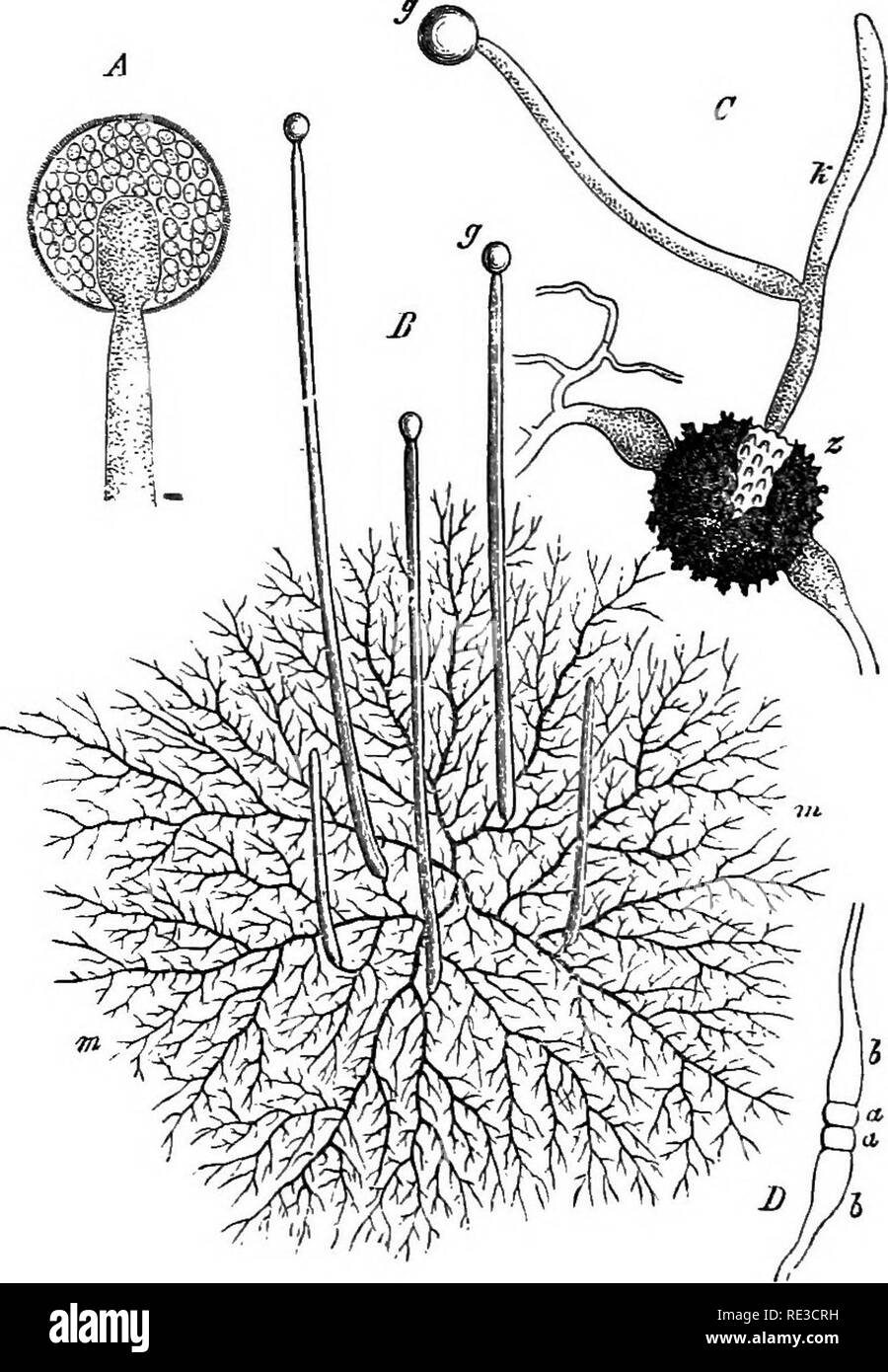 . A handbook of cryptogamic botany. Cryptogams. 336 FUNGI its formation either, by their simple fusion, themselves constitute the zygosperm, or this body is the direct offspring (daughter-cell) of the union. The spores are produced either in terminal sporanges or singly at the apex of a sporophore, or again serially in like fashion to the last. In a considerable number of cases the zygosperms are unknown, and it. Fig. 293.—B^ Phycomyces nitetts Kze. Plant grown on decoction of plums ; mycele, in, spo- rophore, g. A, C, and Z>, Mucor Mitcedo L. A, sporange in optical longitudinal seclion. C, Stock Photohttps://www.alamy.com/image-license-details/?v=1https://www.alamy.com/a-handbook-of-cryptogamic-botany-cryptogams-336-fungi-its-formation-either-by-their-simple-fusion-themselves-constitute-the-zygosperm-or-this-body-is-the-direct-offspring-daughter-cell-of-the-union-the-spores-are-produced-either-in-terminal-sporanges-or-singly-at-the-apex-of-a-sporophore-or-again-serially-in-like-fashion-to-the-last-in-a-considerable-number-of-cases-the-zygosperms-are-unknown-and-it-fig-293b-phycomyces-nitetts-kze-plant-grown-on-decoction-of-plums-mycele-in-spo-rophore-g-a-c-and-zgt-mucor-mitcedo-l-a-sporange-in-optical-longitudinal-seclion-c-image232415893.html
. A handbook of cryptogamic botany. Cryptogams. 336 FUNGI its formation either, by their simple fusion, themselves constitute the zygosperm, or this body is the direct offspring (daughter-cell) of the union. The spores are produced either in terminal sporanges or singly at the apex of a sporophore, or again serially in like fashion to the last. In a considerable number of cases the zygosperms are unknown, and it. Fig. 293.—B^ Phycomyces nitetts Kze. Plant grown on decoction of plums ; mycele, in, spo- rophore, g. A, C, and Z>, Mucor Mitcedo L. A, sporange in optical longitudinal seclion. C, Stock Photohttps://www.alamy.com/image-license-details/?v=1https://www.alamy.com/a-handbook-of-cryptogamic-botany-cryptogams-336-fungi-its-formation-either-by-their-simple-fusion-themselves-constitute-the-zygosperm-or-this-body-is-the-direct-offspring-daughter-cell-of-the-union-the-spores-are-produced-either-in-terminal-sporanges-or-singly-at-the-apex-of-a-sporophore-or-again-serially-in-like-fashion-to-the-last-in-a-considerable-number-of-cases-the-zygosperms-are-unknown-and-it-fig-293b-phycomyces-nitetts-kze-plant-grown-on-decoction-of-plums-mycele-in-spo-rophore-g-a-c-and-zgt-mucor-mitcedo-l-a-sporange-in-optical-longitudinal-seclion-c-image232415893.htmlRMRE3CRH–. A handbook of cryptogamic botany. Cryptogams. 336 FUNGI its formation either, by their simple fusion, themselves constitute the zygosperm, or this body is the direct offspring (daughter-cell) of the union. The spores are produced either in terminal sporanges or singly at the apex of a sporophore, or again serially in like fashion to the last. In a considerable number of cases the zygosperms are unknown, and it. Fig. 293.—B^ Phycomyces nitetts Kze. Plant grown on decoction of plums ; mycele, in, spo- rophore, g. A, C, and Z>, Mucor Mitcedo L. A, sporange in optical longitudinal seclion. C,
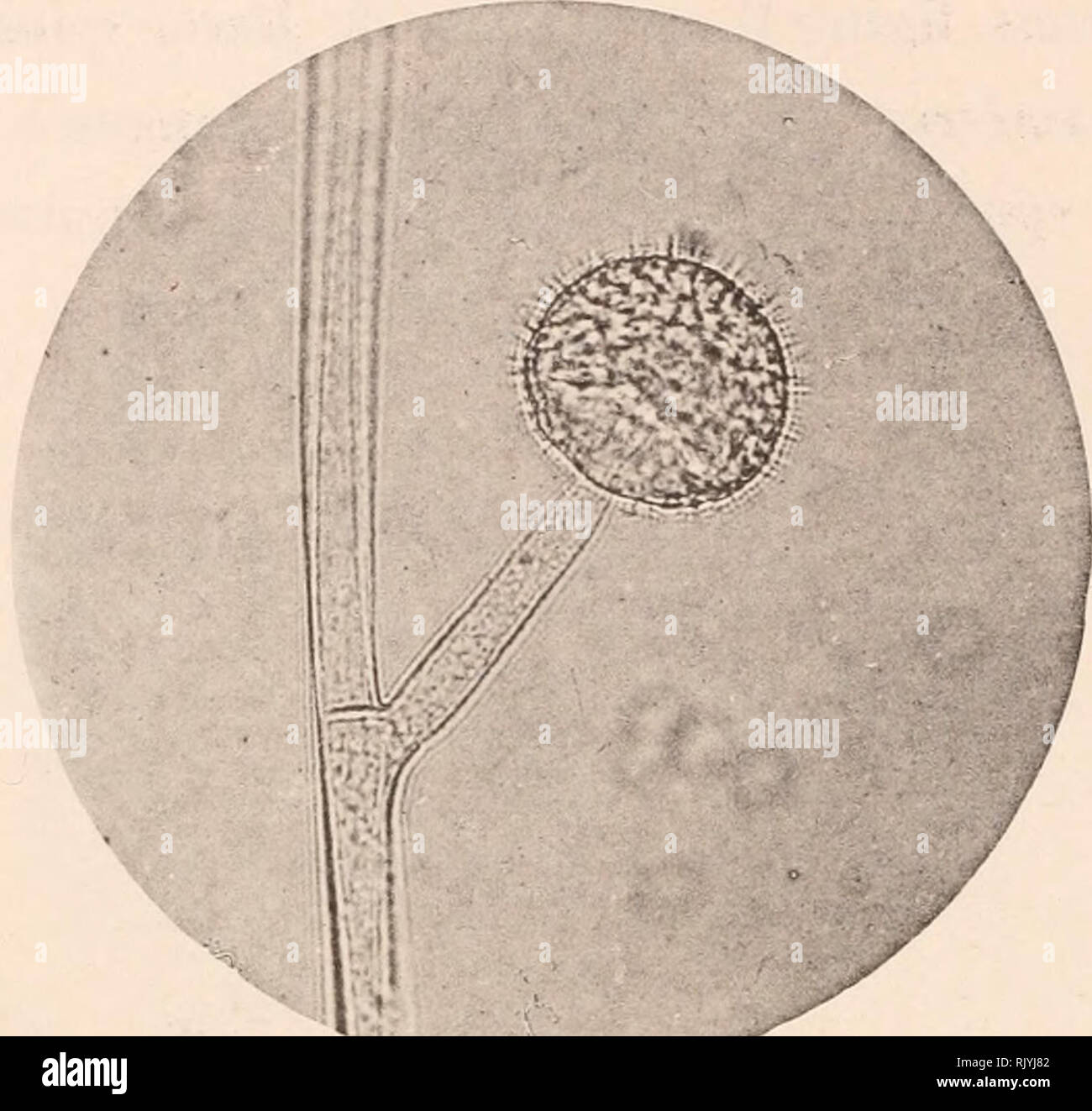 . Atlas de microbiologie ... Roussel, Georges; Microbiology. 12 ATLAS DE MICROBIOLOGIE à la surface des liquides sucrés et des milieux de culture solides, non. Fig. 7. Sporange jeune de Mucor spinosus (gr. 400 diam.). plus des tiges droites comme celles du Phycomyces nitens, du Mucor *r*' "'"j".. Please note that these images are extracted from scanned page images that may have been digitally enhanced for readability - coloration and appearance of these illustrations may not perfectly resemble the original work.. Doyen, E. Paris Stock Photohttps://www.alamy.com/image-license-details/?v=1https://www.alamy.com/atlas-de-microbiologie-roussel-georges-microbiology-12-atlas-de-microbiologie-la-surface-des-liquides-sucrs-et-des-milieux-de-culture-solides-non-fig-7-sporange-jeune-de-mucor-spinosus-gr-400-diam-plus-des-tiges-droites-comme-celles-du-phycomyces-nitens-du-mucor-r-quotquotjquot-please-note-that-these-images-are-extracted-from-scanned-page-images-that-may-have-been-digitally-enhanced-for-readability-coloration-and-appearance-of-these-illustrations-may-not-perfectly-resemble-the-original-work-doyen-e-paris-image235405634.html
. Atlas de microbiologie ... Roussel, Georges; Microbiology. 12 ATLAS DE MICROBIOLOGIE à la surface des liquides sucrés et des milieux de culture solides, non. Fig. 7. Sporange jeune de Mucor spinosus (gr. 400 diam.). plus des tiges droites comme celles du Phycomyces nitens, du Mucor *r*' "'"j".. Please note that these images are extracted from scanned page images that may have been digitally enhanced for readability - coloration and appearance of these illustrations may not perfectly resemble the original work.. Doyen, E. Paris Stock Photohttps://www.alamy.com/image-license-details/?v=1https://www.alamy.com/atlas-de-microbiologie-roussel-georges-microbiology-12-atlas-de-microbiologie-la-surface-des-liquides-sucrs-et-des-milieux-de-culture-solides-non-fig-7-sporange-jeune-de-mucor-spinosus-gr-400-diam-plus-des-tiges-droites-comme-celles-du-phycomyces-nitens-du-mucor-r-quotquotjquot-please-note-that-these-images-are-extracted-from-scanned-page-images-that-may-have-been-digitally-enhanced-for-readability-coloration-and-appearance-of-these-illustrations-may-not-perfectly-resemble-the-original-work-doyen-e-paris-image235405634.htmlRMRJYJ82–. Atlas de microbiologie ... Roussel, Georges; Microbiology. 12 ATLAS DE MICROBIOLOGIE à la surface des liquides sucrés et des milieux de culture solides, non. Fig. 7. Sporange jeune de Mucor spinosus (gr. 400 diam.). plus des tiges droites comme celles du Phycomyces nitens, du Mucor *r*' "'"j".. Please note that these images are extracted from scanned page images that may have been digitally enhanced for readability - coloration and appearance of these illustrations may not perfectly resemble the original work.. Doyen, E. Paris
 . Bulletin du Muséum national d'histoire naturelle. Natural history. ^ ;«*. g?-*- s^-?-; ^* W^ y^gg?. Fig. 3. â Bacillus ozodeus ad!)érent à la membrane interne d'un sporange de Fougère. a, b. Bacilles adultes. c. Bacilles en voie de développement.. Please note that these images are extracted from scanned page images that may have been digitally enhanced for readability - coloration and appearance of these illustrations may not perfectly resemble the original work.. Muséum national d'histoire naturelle (France). Paris : Imprimerie nationale Stock Photohttps://www.alamy.com/image-license-details/?v=1https://www.alamy.com/bulletin-du-musum-national-dhistoire-naturelle-natural-history-g-s-w-ygg-fig-3-bacillus-ozodeus-ad!rent-la-membrane-interne-dun-sporange-de-fougre-a-b-bacilles-adultes-c-bacilles-en-voie-de-dveloppement-please-note-that-these-images-are-extracted-from-scanned-page-images-that-may-have-been-digitally-enhanced-for-readability-coloration-and-appearance-of-these-illustrations-may-not-perfectly-resemble-the-original-work-musum-national-dhistoire-naturelle-france-paris-imprimerie-nationale-image234027447.html
. Bulletin du Muséum national d'histoire naturelle. Natural history. ^ ;«*. g?-*- s^-?-; ^* W^ y^gg?. Fig. 3. â Bacillus ozodeus ad!)érent à la membrane interne d'un sporange de Fougère. a, b. Bacilles adultes. c. Bacilles en voie de développement.. Please note that these images are extracted from scanned page images that may have been digitally enhanced for readability - coloration and appearance of these illustrations may not perfectly resemble the original work.. Muséum national d'histoire naturelle (France). Paris : Imprimerie nationale Stock Photohttps://www.alamy.com/image-license-details/?v=1https://www.alamy.com/bulletin-du-musum-national-dhistoire-naturelle-natural-history-g-s-w-ygg-fig-3-bacillus-ozodeus-ad!rent-la-membrane-interne-dun-sporange-de-fougre-a-b-bacilles-adultes-c-bacilles-en-voie-de-dveloppement-please-note-that-these-images-are-extracted-from-scanned-page-images-that-may-have-been-digitally-enhanced-for-readability-coloration-and-appearance-of-these-illustrations-may-not-perfectly-resemble-the-original-work-musum-national-dhistoire-naturelle-france-paris-imprimerie-nationale-image234027447.htmlRMRGMTB3–. Bulletin du Muséum national d'histoire naturelle. Natural history. ^ ;«*. g?-*- s^-?-; ^* W^ y^gg?. Fig. 3. â Bacillus ozodeus ad!)érent à la membrane interne d'un sporange de Fougère. a, b. Bacilles adultes. c. Bacilles en voie de développement.. Please note that these images are extracted from scanned page images that may have been digitally enhanced for readability - coloration and appearance of these illustrations may not perfectly resemble the original work.. Muséum national d'histoire naturelle (France). Paris : Imprimerie nationale
 . An illustrated flora of the northern United States, Canada and the British possessions, from Newfoundland to the parallel of the southern boundary of Virginia, and from the Atlantic Ocean westward to the 102d meridian. Botany; Botany. Q^o 3. Isoetes hieroglyphica A. A. Eaton. Warty Quillwort. Fig. 120. Isoetes hieroglyphica A. A. Eaton, Fernwort Papers 10. 1900. Submerged with a bilobed trunk. Leaves 10-20, 2i'-3' long, blunt at the apex, without stomata; sporange spotted with dark cells, covered one-third to two-thirds by the velum; macrospores 486-720 p in diameter, polished, covered with Stock Photohttps://www.alamy.com/image-license-details/?v=1https://www.alamy.com/an-illustrated-flora-of-the-northern-united-states-canada-and-the-british-possessions-from-newfoundland-to-the-parallel-of-the-southern-boundary-of-virginia-and-from-the-atlantic-ocean-westward-to-the-102d-meridian-botany-botany-qo-3-isoetes-hieroglyphica-a-a-eaton-warty-quillwort-fig-120-isoetes-hieroglyphica-a-a-eaton-fernwort-papers-10-1900-submerged-with-a-bilobed-trunk-leaves-10-20-2i-3-long-blunt-at-the-apex-without-stomata-sporange-spotted-with-dark-cells-covered-one-third-to-two-thirds-by-the-velum-macrospores-486-720-p-in-diameter-polished-covered-with-image232171438.html
. An illustrated flora of the northern United States, Canada and the British possessions, from Newfoundland to the parallel of the southern boundary of Virginia, and from the Atlantic Ocean westward to the 102d meridian. Botany; Botany. Q^o 3. Isoetes hieroglyphica A. A. Eaton. Warty Quillwort. Fig. 120. Isoetes hieroglyphica A. A. Eaton, Fernwort Papers 10. 1900. Submerged with a bilobed trunk. Leaves 10-20, 2i'-3' long, blunt at the apex, without stomata; sporange spotted with dark cells, covered one-third to two-thirds by the velum; macrospores 486-720 p in diameter, polished, covered with Stock Photohttps://www.alamy.com/image-license-details/?v=1https://www.alamy.com/an-illustrated-flora-of-the-northern-united-states-canada-and-the-british-possessions-from-newfoundland-to-the-parallel-of-the-southern-boundary-of-virginia-and-from-the-atlantic-ocean-westward-to-the-102d-meridian-botany-botany-qo-3-isoetes-hieroglyphica-a-a-eaton-warty-quillwort-fig-120-isoetes-hieroglyphica-a-a-eaton-fernwort-papers-10-1900-submerged-with-a-bilobed-trunk-leaves-10-20-2i-3-long-blunt-at-the-apex-without-stomata-sporange-spotted-with-dark-cells-covered-one-third-to-two-thirds-by-the-velum-macrospores-486-720-p-in-diameter-polished-covered-with-image232171438.htmlRMRDM912–. An illustrated flora of the northern United States, Canada and the British possessions, from Newfoundland to the parallel of the southern boundary of Virginia, and from the Atlantic Ocean westward to the 102d meridian. Botany; Botany. Q^o 3. Isoetes hieroglyphica A. A. Eaton. Warty Quillwort. Fig. 120. Isoetes hieroglyphica A. A. Eaton, Fernwort Papers 10. 1900. Submerged with a bilobed trunk. Leaves 10-20, 2i'-3' long, blunt at the apex, without stomata; sporange spotted with dark cells, covered one-third to two-thirds by the velum; macrospores 486-720 p in diameter, polished, covered with
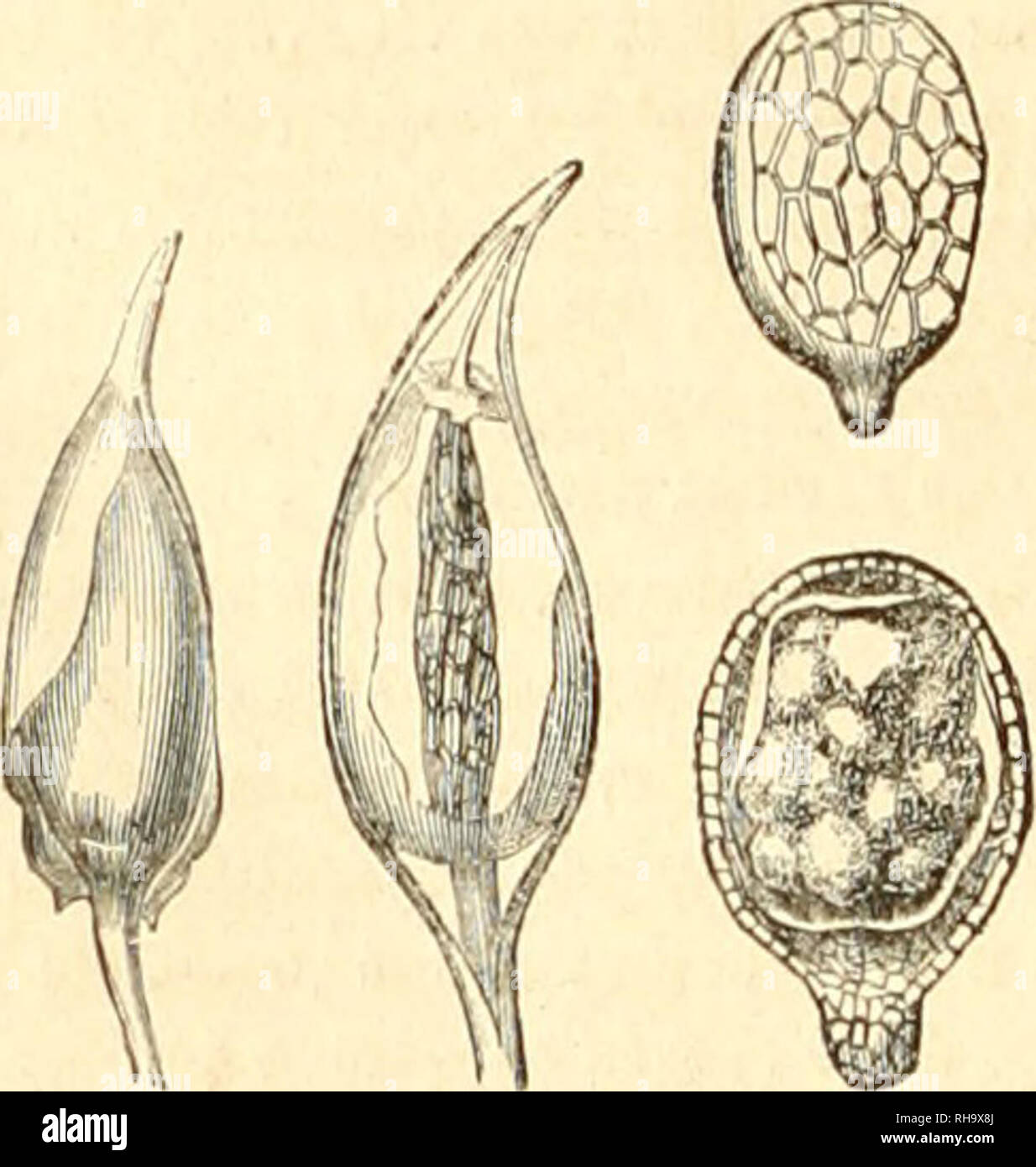 . Botanique cryptogamique, ou Histoire des familles naturelles des plantes infrieures. . 7G8. l'hascum stnil uni (poil). 770. Voitîa ni ( sporange ). 771.772. Archidium. 775. Bruchia vogesiaca globiferum (sporange), (sporangeeteoiffe). ARCHIDIUM. BB1D. Calyptra imperfecta, lacera, partiin sporangio partim vnginulÅ adhÅrens. Sporangium sessile. globosuni. Columella nulla. SporÅ ninxinue. EPHEMERUM, UAMPE. Calyptra conica vel <li- midiala , tenerrima. Sporangium subsessile globoso-acuminatuD). Columella nulla. Sporx majusculse. phascum. SCHREB. Calyptra conica vel dimi- diata. Sporangium su Stock Photohttps://www.alamy.com/image-license-details/?v=1https://www.alamy.com/botanique-cryptogamique-ou-histoire-des-familles-naturelles-des-plantes-infrieures-7g8-lhascum-stnil-uni-poil-770-voita-ni-sporange-771772-archidium-775-bruchia-vogesiaca-globiferum-sporange-sporangeeteoiffe-archidium-bb1d-calyptra-imperfecta-lacera-partiin-sporangio-partim-vnginul-adhrens-sporangium-sessile-globosuni-columella-nulla-spor-ninxinue-ephemerum-uampe-calyptra-conica-vel-ltli-midiala-tenerrima-sporangium-subsessile-globoso-acuminatud-columella-nulla-sporx-majusculse-phascum-schreb-calyptra-conica-vel-dimi-diata-sporangium-su-image234402130.html
. Botanique cryptogamique, ou Histoire des familles naturelles des plantes infrieures. . 7G8. l'hascum stnil uni (poil). 770. Voitîa ni ( sporange ). 771.772. Archidium. 775. Bruchia vogesiaca globiferum (sporange), (sporangeeteoiffe). ARCHIDIUM. BB1D. Calyptra imperfecta, lacera, partiin sporangio partim vnginulÅ adhÅrens. Sporangium sessile. globosuni. Columella nulla. SporÅ ninxinue. EPHEMERUM, UAMPE. Calyptra conica vel <li- midiala , tenerrima. Sporangium subsessile globoso-acuminatuD). Columella nulla. Sporx majusculse. phascum. SCHREB. Calyptra conica vel dimi- diata. Sporangium su Stock Photohttps://www.alamy.com/image-license-details/?v=1https://www.alamy.com/botanique-cryptogamique-ou-histoire-des-familles-naturelles-des-plantes-infrieures-7g8-lhascum-stnil-uni-poil-770-voita-ni-sporange-771772-archidium-775-bruchia-vogesiaca-globiferum-sporange-sporangeeteoiffe-archidium-bb1d-calyptra-imperfecta-lacera-partiin-sporangio-partim-vnginul-adhrens-sporangium-sessile-globosuni-columella-nulla-spor-ninxinue-ephemerum-uampe-calyptra-conica-vel-ltli-midiala-tenerrima-sporangium-subsessile-globoso-acuminatud-columella-nulla-sporx-majusculse-phascum-schreb-calyptra-conica-vel-dimi-diata-sporangium-su-image234402130.htmlRMRH9X8J–. Botanique cryptogamique, ou Histoire des familles naturelles des plantes infrieures. . 7G8. l'hascum stnil uni (poil). 770. Voitîa ni ( sporange ). 771.772. Archidium. 775. Bruchia vogesiaca globiferum (sporange), (sporangeeteoiffe). ARCHIDIUM. BB1D. Calyptra imperfecta, lacera, partiin sporangio partim vnginulÅ adhÅrens. Sporangium sessile. globosuni. Columella nulla. SporÅ ninxinue. EPHEMERUM, UAMPE. Calyptra conica vel <li- midiala , tenerrima. Sporangium subsessile globoso-acuminatuD). Columella nulla. Sporx majusculse. phascum. SCHREB. Calyptra conica vel dimi- diata. Sporangium su
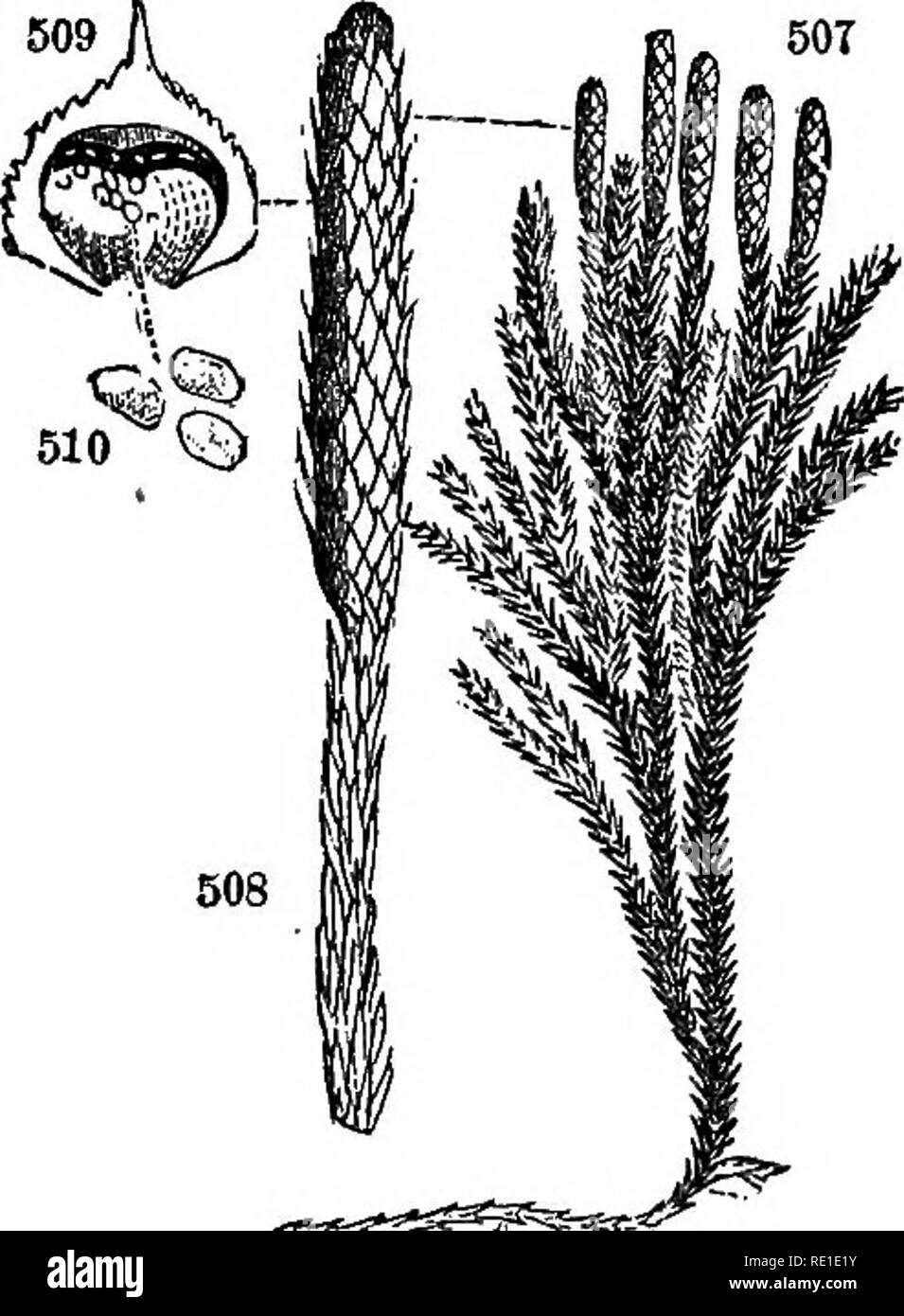 . Class-book of botany : being outlines of the structure, physiology and classification of plants : with a flora of the United States and Canada . Botany; Botany; Botany. 502 503 504 502, Equisetum arvense. 503, E. sylvaticum. 504. Section of the spike. 505, A sporange. 506, A sporo with its elators coiled.. 607, Lyoopodium dendroideum. 508, A single spike. 509, a scale with its sporange bursting. 610, Spores. 624. Classes. The tribe last mentioned are embraced in the class Acrogens, so named by Lindley from their manner of growth {d,Kp6v, point or summit), lengthening into an axis. The remain Stock Photohttps://www.alamy.com/image-license-details/?v=1https://www.alamy.com/class-book-of-botany-being-outlines-of-the-structure-physiology-and-classification-of-plants-with-a-flora-of-the-united-states-and-canada-botany-botany-botany-502-503-504-502-equisetum-arvense-503-e-sylvaticum-504-section-of-the-spike-505-a-sporange-506-a-sporo-with-its-elators-coiled-607-lyoopodium-dendroideum-508-a-single-spike-509-a-scale-with-its-sporange-bursting-610-spores-624-classes-the-tribe-last-mentioned-are-embraced-in-the-class-acrogens-so-named-by-lindley-from-their-manner-of-growth-dkp6v-point-or-summit-lengthening-into-an-axis-the-remain-image232372951.html
. Class-book of botany : being outlines of the structure, physiology and classification of plants : with a flora of the United States and Canada . Botany; Botany; Botany. 502 503 504 502, Equisetum arvense. 503, E. sylvaticum. 504. Section of the spike. 505, A sporange. 506, A sporo with its elators coiled.. 607, Lyoopodium dendroideum. 508, A single spike. 509, a scale with its sporange bursting. 610, Spores. 624. Classes. The tribe last mentioned are embraced in the class Acrogens, so named by Lindley from their manner of growth {d,Kp6v, point or summit), lengthening into an axis. The remain Stock Photohttps://www.alamy.com/image-license-details/?v=1https://www.alamy.com/class-book-of-botany-being-outlines-of-the-structure-physiology-and-classification-of-plants-with-a-flora-of-the-united-states-and-canada-botany-botany-botany-502-503-504-502-equisetum-arvense-503-e-sylvaticum-504-section-of-the-spike-505-a-sporange-506-a-sporo-with-its-elators-coiled-607-lyoopodium-dendroideum-508-a-single-spike-509-a-scale-with-its-sporange-bursting-610-spores-624-classes-the-tribe-last-mentioned-are-embraced-in-the-class-acrogens-so-named-by-lindley-from-their-manner-of-growth-dkp6v-point-or-summit-lengthening-into-an-axis-the-remain-image232372951.htmlRMRE1E1Y–. Class-book of botany : being outlines of the structure, physiology and classification of plants : with a flora of the United States and Canada . Botany; Botany; Botany. 502 503 504 502, Equisetum arvense. 503, E. sylvaticum. 504. Section of the spike. 505, A sporange. 506, A sporo with its elators coiled.. 607, Lyoopodium dendroideum. 508, A single spike. 509, a scale with its sporange bursting. 610, Spores. 624. Classes. The tribe last mentioned are embraced in the class Acrogens, so named by Lindley from their manner of growth {d,Kp6v, point or summit), lengthening into an axis. The remain
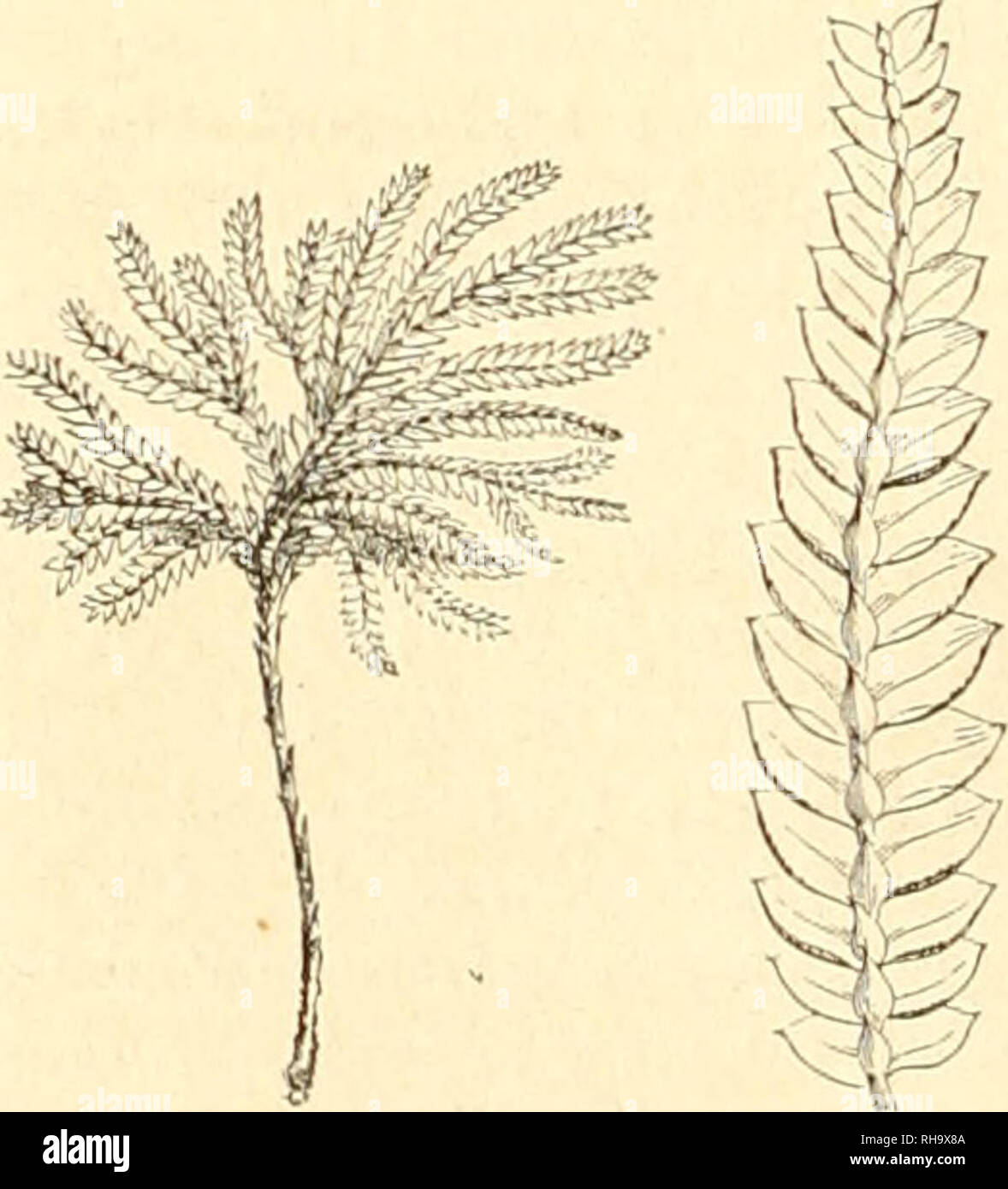 . Botanique cryptogamique, ou Histoire des familles naturelles des plantes infrieures. 7G8. l'hascum stnil uni (poil). 770. Voitîa ni ( sporange ). 771.772. Archidium. 775. Bruchia vogesiaca globiferum (sporange), (sporangeeteoiffe). ARCHIDIUM. BB1D. Calyptra imperfecta, lacera, partiin sporangio partim vnginulÅ adhÅrens. Sporangium sessile. globosuni. Columella nulla. SporÅ ninxinue. EPHEMERUM, UAMPE. Calyptra conica vel <li- midiala , tenerrima. Sporangium subsessile globoso-acuminatuD). Columella nulla. Sporx majusculse. phascum. SCHREB. Calyptra conica vel dimi- diata. Sporangium subs Stock Photohttps://www.alamy.com/image-license-details/?v=1https://www.alamy.com/botanique-cryptogamique-ou-histoire-des-familles-naturelles-des-plantes-infrieures-7g8-lhascum-stnil-uni-poil-770-voita-ni-sporange-771772-archidium-775-bruchia-vogesiaca-globiferum-sporange-sporangeeteoiffe-archidium-bb1d-calyptra-imperfecta-lacera-partiin-sporangio-partim-vnginul-adhrens-sporangium-sessile-globosuni-columella-nulla-spor-ninxinue-ephemerum-uampe-calyptra-conica-vel-ltli-midiala-tenerrima-sporangium-subsessile-globoso-acuminatud-columella-nulla-sporx-majusculse-phascum-schreb-calyptra-conica-vel-dimi-diata-sporangium-subs-image234402122.html
. Botanique cryptogamique, ou Histoire des familles naturelles des plantes infrieures. 7G8. l'hascum stnil uni (poil). 770. Voitîa ni ( sporange ). 771.772. Archidium. 775. Bruchia vogesiaca globiferum (sporange), (sporangeeteoiffe). ARCHIDIUM. BB1D. Calyptra imperfecta, lacera, partiin sporangio partim vnginulÅ adhÅrens. Sporangium sessile. globosuni. Columella nulla. SporÅ ninxinue. EPHEMERUM, UAMPE. Calyptra conica vel <li- midiala , tenerrima. Sporangium subsessile globoso-acuminatuD). Columella nulla. Sporx majusculse. phascum. SCHREB. Calyptra conica vel dimi- diata. Sporangium subs Stock Photohttps://www.alamy.com/image-license-details/?v=1https://www.alamy.com/botanique-cryptogamique-ou-histoire-des-familles-naturelles-des-plantes-infrieures-7g8-lhascum-stnil-uni-poil-770-voita-ni-sporange-771772-archidium-775-bruchia-vogesiaca-globiferum-sporange-sporangeeteoiffe-archidium-bb1d-calyptra-imperfecta-lacera-partiin-sporangio-partim-vnginul-adhrens-sporangium-sessile-globosuni-columella-nulla-spor-ninxinue-ephemerum-uampe-calyptra-conica-vel-ltli-midiala-tenerrima-sporangium-subsessile-globoso-acuminatud-columella-nulla-sporx-majusculse-phascum-schreb-calyptra-conica-vel-dimi-diata-sporangium-subs-image234402122.htmlRMRH9X8A–. Botanique cryptogamique, ou Histoire des familles naturelles des plantes infrieures. 7G8. l'hascum stnil uni (poil). 770. Voitîa ni ( sporange ). 771.772. Archidium. 775. Bruchia vogesiaca globiferum (sporange), (sporangeeteoiffe). ARCHIDIUM. BB1D. Calyptra imperfecta, lacera, partiin sporangio partim vnginulÅ adhÅrens. Sporangium sessile. globosuni. Columella nulla. SporÅ ninxinue. EPHEMERUM, UAMPE. Calyptra conica vel <li- midiala , tenerrima. Sporangium subsessile globoso-acuminatuD). Columella nulla. Sporx majusculse. phascum. SCHREB. Calyptra conica vel dimi- diata. Sporangium subs
![. Class-book of botany [microform] : being outlines of the structure, physiology, and classification of plants : with a flora of the United States and Canada. Botany; Botany; Plants; Plants; Botanique; Botanique; Plantes; Botanique. THE CRYPTOOAMIA OB FLOWERLESS PLANTS. 127. HcpaticsB. 623, Marchantia, sterile plant. 624-5, Fertile plant B9fi v *⢠, ., the fertil.recept.c)c ; 527, of a perianth, showing the sporange burst n- 52S On TT. *' wuh four spores. 629, Portion of it highly magnified. °"'-st'nâ. 523, One of the clatora of tlie flowering pUnts. In the mosses, liver- "** '^ wo Stock Photo . Class-book of botany [microform] : being outlines of the structure, physiology, and classification of plants : with a flora of the United States and Canada. Botany; Botany; Plants; Plants; Botanique; Botanique; Plantes; Botanique. THE CRYPTOOAMIA OB FLOWERLESS PLANTS. 127. HcpaticsB. 623, Marchantia, sterile plant. 624-5, Fertile plant B9fi v *⢠, ., the fertil.recept.c)c ; 527, of a perianth, showing the sporange burst n- 52S On TT. *' wuh four spores. 629, Portion of it highly magnified. °"'-st'nâ. 523, One of the clatora of tlie flowering pUnts. In the mosses, liver- "** '^ wo Stock Photo](https://c8.alamy.com/comp/REPM4J/class-book-of-botany-microform-being-outlines-of-the-structure-physiology-and-classification-of-plants-with-a-flora-of-the-united-states-and-canada-botany-botany-plants-plants-botanique-botanique-plantes-botanique-the-cryptooamia-ob-flowerless-plants-127-hcpaticsb-623-marchantia-sterile-plant-624-5-fertile-plant-b9fi-v-the-fertilreceptcc-527-of-a-perianth-showing-the-sporange-burst-n-52s-on-tt-wuh-four-spores-629-portion-of-it-highly-magnified-quot-stn-523-one-of-the-clatora-of-tlie-flowering-punts-in-the-mosses-liver-quot-wo-REPM4J.jpg) . Class-book of botany [microform] : being outlines of the structure, physiology, and classification of plants : with a flora of the United States and Canada. Botany; Botany; Plants; Plants; Botanique; Botanique; Plantes; Botanique. THE CRYPTOOAMIA OB FLOWERLESS PLANTS. 127. HcpaticsB. 623, Marchantia, sterile plant. 624-5, Fertile plant B9fi v *⢠, ., the fertil.recept.c)c ; 527, of a perianth, showing the sporange burst n- 52S On TT. *' wuh four spores. 629, Portion of it highly magnified. °"'-st'nâ. 523, One of the clatora of tlie flowering pUnts. In the mosses, liver- "** '^ wo Stock Photohttps://www.alamy.com/image-license-details/?v=1https://www.alamy.com/class-book-of-botany-microform-being-outlines-of-the-structure-physiology-and-classification-of-plants-with-a-flora-of-the-united-states-and-canada-botany-botany-plants-plants-botanique-botanique-plantes-botanique-the-cryptooamia-ob-flowerless-plants-127-hcpaticsb-623-marchantia-sterile-plant-624-5-fertile-plant-b9fi-v-the-fertilreceptcc-527-of-a-perianth-showing-the-sporange-burst-n-52s-on-tt-wuh-four-spores-629-portion-of-it-highly-magnified-quot-stn-523-one-of-the-clatora-of-tlie-flowering-punts-in-the-mosses-liver-quot-wo-image232838722.html
. Class-book of botany [microform] : being outlines of the structure, physiology, and classification of plants : with a flora of the United States and Canada. Botany; Botany; Plants; Plants; Botanique; Botanique; Plantes; Botanique. THE CRYPTOOAMIA OB FLOWERLESS PLANTS. 127. HcpaticsB. 623, Marchantia, sterile plant. 624-5, Fertile plant B9fi v *⢠, ., the fertil.recept.c)c ; 527, of a perianth, showing the sporange burst n- 52S On TT. *' wuh four spores. 629, Portion of it highly magnified. °"'-st'nâ. 523, One of the clatora of tlie flowering pUnts. In the mosses, liver- "** '^ wo Stock Photohttps://www.alamy.com/image-license-details/?v=1https://www.alamy.com/class-book-of-botany-microform-being-outlines-of-the-structure-physiology-and-classification-of-plants-with-a-flora-of-the-united-states-and-canada-botany-botany-plants-plants-botanique-botanique-plantes-botanique-the-cryptooamia-ob-flowerless-plants-127-hcpaticsb-623-marchantia-sterile-plant-624-5-fertile-plant-b9fi-v-the-fertilreceptcc-527-of-a-perianth-showing-the-sporange-burst-n-52s-on-tt-wuh-four-spores-629-portion-of-it-highly-magnified-quot-stn-523-one-of-the-clatora-of-tlie-flowering-punts-in-the-mosses-liver-quot-wo-image232838722.htmlRMREPM4J–. Class-book of botany [microform] : being outlines of the structure, physiology, and classification of plants : with a flora of the United States and Canada. Botany; Botany; Plants; Plants; Botanique; Botanique; Plantes; Botanique. THE CRYPTOOAMIA OB FLOWERLESS PLANTS. 127. HcpaticsB. 623, Marchantia, sterile plant. 624-5, Fertile plant B9fi v *⢠, ., the fertil.recept.c)c ; 527, of a perianth, showing the sporange burst n- 52S On TT. *' wuh four spores. 629, Portion of it highly magnified. °"'-st'nâ. 523, One of the clatora of tlie flowering pUnts. In the mosses, liver- "** '^ wo
 . A handbook of cryptogamic botany. Cryptogams. CCENOBIE^ 297 protoplasm again breaks up into zoospores, which swarm about for twenty or forty minutes within a sac which protrudes out of the protoplasm. When they come to rest, they arrange themselves within the sac into a small net consisting of from 200 to 300 cells, which gradually grows to. Fig. 260.—Hydrodictyon idricnlatujii Roth. A, net (natural size). B^ mesh ( x lo). C, mepazoo sporange (x 300). D, megazoospores (x 600). E^ gametange with zoogameles (X 300). (After Cohn.) one of the ordinary size. In some of the polyhedra smaller and Stock Photohttps://www.alamy.com/image-license-details/?v=1https://www.alamy.com/a-handbook-of-cryptogamic-botany-cryptogams-ccenobie-297-protoplasm-again-breaks-up-into-zoospores-which-swarm-about-for-twenty-or-forty-minutes-within-a-sac-which-protrudes-out-of-the-protoplasm-when-they-come-to-rest-they-arrange-themselves-within-the-sac-into-a-small-net-consisting-of-from-200-to-300-cells-which-gradually-grows-to-fig-260hydrodictyon-idricnlatujii-roth-a-net-natural-size-b-mesh-x-lo-c-mepazoo-sporange-x-300-d-megazoospores-x-600-e-gametange-with-zoogameles-x-300-after-cohn-one-of-the-ordinary-size-in-some-of-the-polyhedra-smaller-and-image232416018.html
. A handbook of cryptogamic botany. Cryptogams. CCENOBIE^ 297 protoplasm again breaks up into zoospores, which swarm about for twenty or forty minutes within a sac which protrudes out of the protoplasm. When they come to rest, they arrange themselves within the sac into a small net consisting of from 200 to 300 cells, which gradually grows to. Fig. 260.—Hydrodictyon idricnlatujii Roth. A, net (natural size). B^ mesh ( x lo). C, mepazoo sporange (x 300). D, megazoospores (x 600). E^ gametange with zoogameles (X 300). (After Cohn.) one of the ordinary size. In some of the polyhedra smaller and Stock Photohttps://www.alamy.com/image-license-details/?v=1https://www.alamy.com/a-handbook-of-cryptogamic-botany-cryptogams-ccenobie-297-protoplasm-again-breaks-up-into-zoospores-which-swarm-about-for-twenty-or-forty-minutes-within-a-sac-which-protrudes-out-of-the-protoplasm-when-they-come-to-rest-they-arrange-themselves-within-the-sac-into-a-small-net-consisting-of-from-200-to-300-cells-which-gradually-grows-to-fig-260hydrodictyon-idricnlatujii-roth-a-net-natural-size-b-mesh-x-lo-c-mepazoo-sporange-x-300-d-megazoospores-x-600-e-gametange-with-zoogameles-x-300-after-cohn-one-of-the-ordinary-size-in-some-of-the-polyhedra-smaller-and-image232416018.htmlRMRE3D02–. A handbook of cryptogamic botany. Cryptogams. CCENOBIE^ 297 protoplasm again breaks up into zoospores, which swarm about for twenty or forty minutes within a sac which protrudes out of the protoplasm. When they come to rest, they arrange themselves within the sac into a small net consisting of from 200 to 300 cells, which gradually grows to. Fig. 260.—Hydrodictyon idricnlatujii Roth. A, net (natural size). B^ mesh ( x lo). C, mepazoo sporange (x 300). D, megazoospores (x 600). E^ gametange with zoogameles (X 300). (After Cohn.) one of the ordinary size. In some of the polyhedra smaller and
 . Botanique cryptogamique, ou Histoire des familles naturelles des plantes infrieures. . S88. 889. 890. Cinclidotus fonlinaloides port, sporange et coif e, péristomej. 91. Dahelyma falcala f péristome). Ml* 892. t'ontinalis antipyretica (péristome). Les Hydropogonées sont des plantes équinoxiales riées appartiennent au nord des deux continents. de l'Amérique; les Fontina'.es el les Ripa-. Please note that these images are extracted from scanned page images that may have been digitally enhanced for readability - coloration and appearance of these illustrations may not perfectly resemble the ori Stock Photohttps://www.alamy.com/image-license-details/?v=1https://www.alamy.com/botanique-cryptogamique-ou-histoire-des-familles-naturelles-des-plantes-infrieures-s88-889-890-cinclidotus-fonlinaloides-port-sporange-et-coif-e-pristomej-91-dahelyma-falcala-f-pristome-ml-892-tontinalis-antipyretica-pristome-les-hydropogones-sont-des-plantes-quinoxiales-ries-appartiennent-au-nord-des-deux-continents-de-lamrique-les-fontinaes-el-les-ripa-please-note-that-these-images-are-extracted-from-scanned-page-images-that-may-have-been-digitally-enhanced-for-readability-coloration-and-appearance-of-these-illustrations-may-not-perfectly-resemble-the-ori-image234401791.html
. Botanique cryptogamique, ou Histoire des familles naturelles des plantes infrieures. . S88. 889. 890. Cinclidotus fonlinaloides port, sporange et coif e, péristomej. 91. Dahelyma falcala f péristome). Ml* 892. t'ontinalis antipyretica (péristome). Les Hydropogonées sont des plantes équinoxiales riées appartiennent au nord des deux continents. de l'Amérique; les Fontina'.es el les Ripa-. Please note that these images are extracted from scanned page images that may have been digitally enhanced for readability - coloration and appearance of these illustrations may not perfectly resemble the ori Stock Photohttps://www.alamy.com/image-license-details/?v=1https://www.alamy.com/botanique-cryptogamique-ou-histoire-des-familles-naturelles-des-plantes-infrieures-s88-889-890-cinclidotus-fonlinaloides-port-sporange-et-coif-e-pristomej-91-dahelyma-falcala-f-pristome-ml-892-tontinalis-antipyretica-pristome-les-hydropogones-sont-des-plantes-quinoxiales-ries-appartiennent-au-nord-des-deux-continents-de-lamrique-les-fontinaes-el-les-ripa-please-note-that-these-images-are-extracted-from-scanned-page-images-that-may-have-been-digitally-enhanced-for-readability-coloration-and-appearance-of-these-illustrations-may-not-perfectly-resemble-the-ori-image234401791.htmlRMRH9WTF–. Botanique cryptogamique, ou Histoire des familles naturelles des plantes infrieures. . S88. 889. 890. Cinclidotus fonlinaloides port, sporange et coif e, péristomej. 91. Dahelyma falcala f péristome). Ml* 892. t'ontinalis antipyretica (péristome). Les Hydropogonées sont des plantes équinoxiales riées appartiennent au nord des deux continents. de l'Amérique; les Fontina'.es el les Ripa-. Please note that these images are extracted from scanned page images that may have been digitally enhanced for readability - coloration and appearance of these illustrations may not perfectly resemble the ori
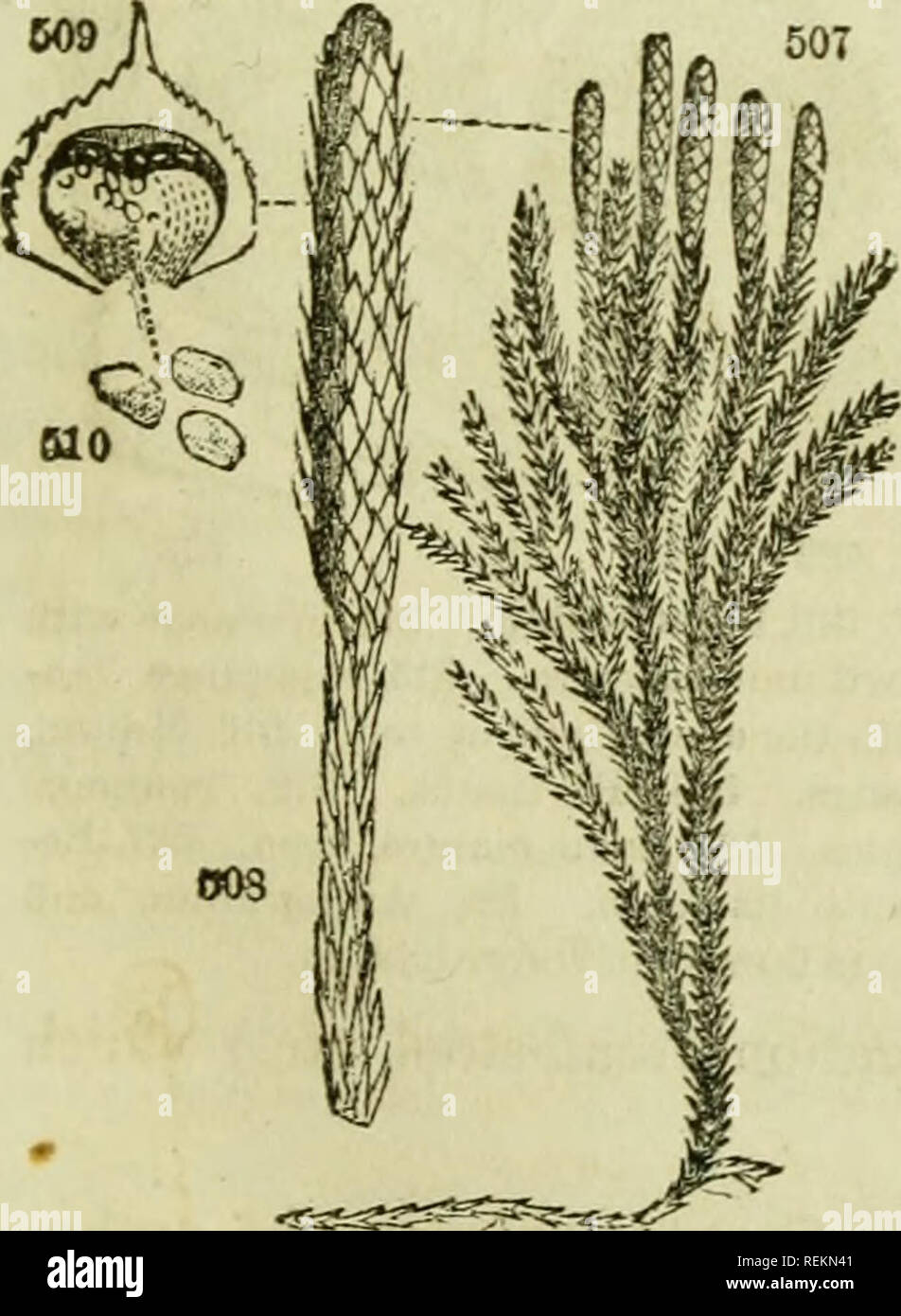 . Class-book of botany: being outlines of the structure, physiology and classification of plants; with a flora of the United States and Canada. Botany; Plants; Plants. 504 506 502 503 502, Equisetum arvense. 503, E. sylvaticum. 504. Section of the spike. 505, A sporange. 506, A sporo with its elators coiled.. 807, Lycopodium dendroideum. 50S, A single spike. 509, a. scale with its sporange bursting. 510, Spores. 624. Classes. The tribe last mentioned are embraced in the class Acrogens, so named by Lindley from their manner of growth (dtcpov, point or summit), lengthening into an axis. The rema Stock Photohttps://www.alamy.com/image-license-details/?v=1https://www.alamy.com/class-book-of-botany-being-outlines-of-the-structure-physiology-and-classification-of-plants-with-a-flora-of-the-united-states-and-canada-botany-plants-plants-504-506-502-503-502-equisetum-arvense-503-e-sylvaticum-504-section-of-the-spike-505-a-sporange-506-a-sporo-with-its-elators-coiled-807-lycopodium-dendroideum-50s-a-single-spike-509-a-scale-with-its-sporange-bursting-510-spores-624-classes-the-tribe-last-mentioned-are-embraced-in-the-class-acrogens-so-named-by-lindley-from-their-manner-of-growth-dtcpov-point-or-summit-lengthening-into-an-axis-the-rema-image232773633.html
. Class-book of botany: being outlines of the structure, physiology and classification of plants; with a flora of the United States and Canada. Botany; Plants; Plants. 504 506 502 503 502, Equisetum arvense. 503, E. sylvaticum. 504. Section of the spike. 505, A sporange. 506, A sporo with its elators coiled.. 807, Lycopodium dendroideum. 50S, A single spike. 509, a. scale with its sporange bursting. 510, Spores. 624. Classes. The tribe last mentioned are embraced in the class Acrogens, so named by Lindley from their manner of growth (dtcpov, point or summit), lengthening into an axis. The rema Stock Photohttps://www.alamy.com/image-license-details/?v=1https://www.alamy.com/class-book-of-botany-being-outlines-of-the-structure-physiology-and-classification-of-plants-with-a-flora-of-the-united-states-and-canada-botany-plants-plants-504-506-502-503-502-equisetum-arvense-503-e-sylvaticum-504-section-of-the-spike-505-a-sporange-506-a-sporo-with-its-elators-coiled-807-lycopodium-dendroideum-50s-a-single-spike-509-a-scale-with-its-sporange-bursting-510-spores-624-classes-the-tribe-last-mentioned-are-embraced-in-the-class-acrogens-so-named-by-lindley-from-their-manner-of-growth-dtcpov-point-or-summit-lengthening-into-an-axis-the-rema-image232773633.htmlRMREKN41–. Class-book of botany: being outlines of the structure, physiology and classification of plants; with a flora of the United States and Canada. Botany; Plants; Plants. 504 506 502 503 502, Equisetum arvense. 503, E. sylvaticum. 504. Section of the spike. 505, A sporange. 506, A sporo with its elators coiled.. 807, Lycopodium dendroideum. 50S, A single spike. 509, a. scale with its sporange bursting. 510, Spores. 624. Classes. The tribe last mentioned are embraced in the class Acrogens, so named by Lindley from their manner of growth (dtcpov, point or summit), lengthening into an axis. The rema
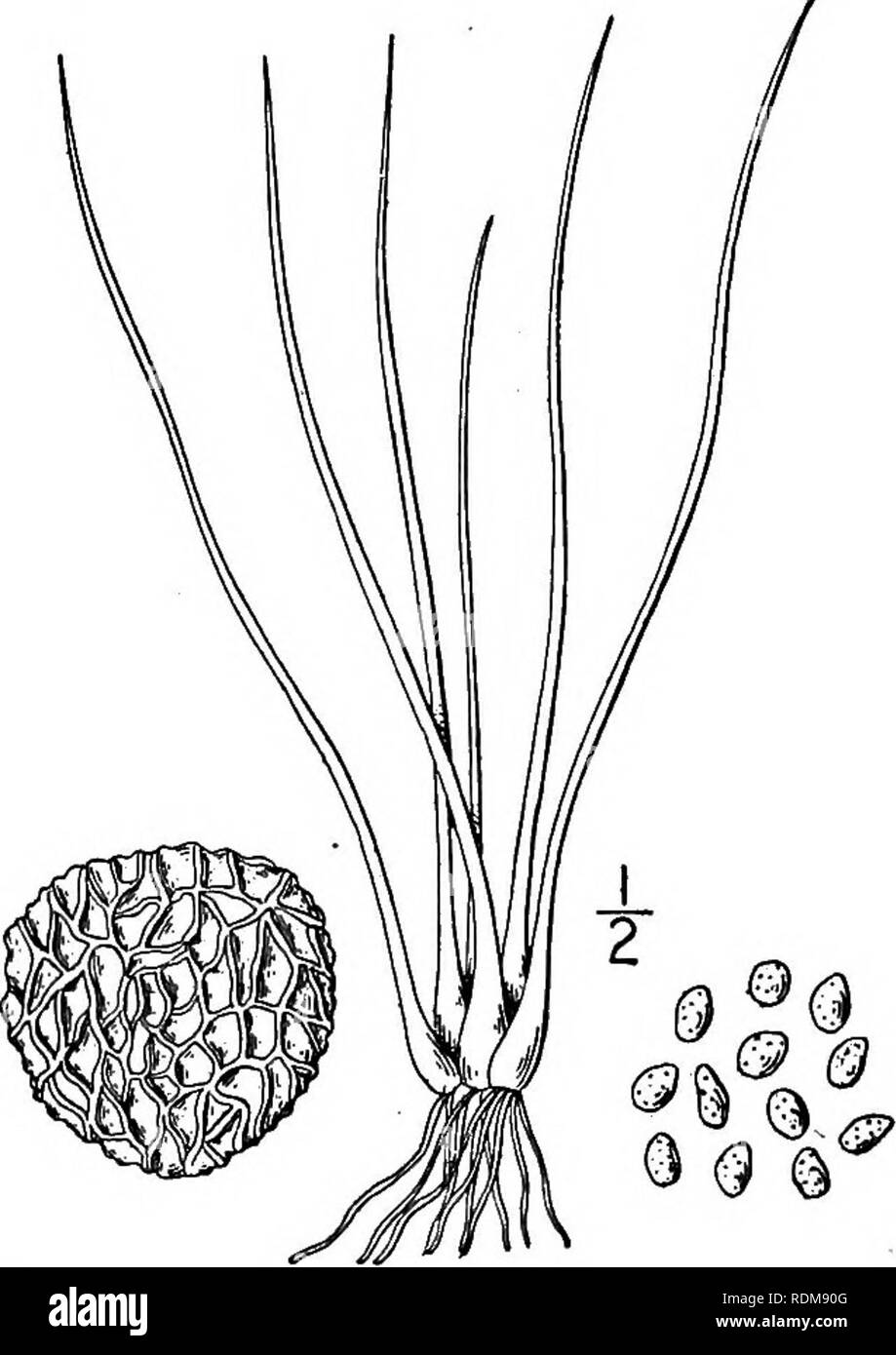 . An illustrated flora of the northern United States, Canada and the British possessions, from Newfoundland to the parallel of the southern boundary of Virginia, and from the Atlantic Ocean westward to the 102d meridian. Botany; Botany. 5. Isoetes saccharata Engelm. Sugary Quill- wort. Fig. 122. Isoetes saccharata Engelm. in A. Gray, Man. Ed. 5, 676. 1867. Amphibious or uliginous with a flat depressed trunk. Leaves' 10-30, green, pale at the base, spreading, 2-3' long, quadrangular, bearing numerous stomata; sporange oblong, unspotted, with a narrow velum covering only one-fourth or one-third Stock Photohttps://www.alamy.com/image-license-details/?v=1https://www.alamy.com/an-illustrated-flora-of-the-northern-united-states-canada-and-the-british-possessions-from-newfoundland-to-the-parallel-of-the-southern-boundary-of-virginia-and-from-the-atlantic-ocean-westward-to-the-102d-meridian-botany-botany-5-isoetes-saccharata-engelm-sugary-quill-wort-fig-122-isoetes-saccharata-engelm-in-a-gray-man-ed-5-676-1867-amphibious-or-uliginous-with-a-flat-depressed-trunk-leaves-10-30-green-pale-at-the-base-spreading-2-3-long-quadrangular-bearing-numerous-stomata-sporange-oblong-unspotted-with-a-narrow-velum-covering-only-one-fourth-or-one-third-image232171424.html
. An illustrated flora of the northern United States, Canada and the British possessions, from Newfoundland to the parallel of the southern boundary of Virginia, and from the Atlantic Ocean westward to the 102d meridian. Botany; Botany. 5. Isoetes saccharata Engelm. Sugary Quill- wort. Fig. 122. Isoetes saccharata Engelm. in A. Gray, Man. Ed. 5, 676. 1867. Amphibious or uliginous with a flat depressed trunk. Leaves' 10-30, green, pale at the base, spreading, 2-3' long, quadrangular, bearing numerous stomata; sporange oblong, unspotted, with a narrow velum covering only one-fourth or one-third Stock Photohttps://www.alamy.com/image-license-details/?v=1https://www.alamy.com/an-illustrated-flora-of-the-northern-united-states-canada-and-the-british-possessions-from-newfoundland-to-the-parallel-of-the-southern-boundary-of-virginia-and-from-the-atlantic-ocean-westward-to-the-102d-meridian-botany-botany-5-isoetes-saccharata-engelm-sugary-quill-wort-fig-122-isoetes-saccharata-engelm-in-a-gray-man-ed-5-676-1867-amphibious-or-uliginous-with-a-flat-depressed-trunk-leaves-10-30-green-pale-at-the-base-spreading-2-3-long-quadrangular-bearing-numerous-stomata-sporange-oblong-unspotted-with-a-narrow-velum-covering-only-one-fourth-or-one-third-image232171424.htmlRMRDM90G–. An illustrated flora of the northern United States, Canada and the British possessions, from Newfoundland to the parallel of the southern boundary of Virginia, and from the Atlantic Ocean westward to the 102d meridian. Botany; Botany. 5. Isoetes saccharata Engelm. Sugary Quill- wort. Fig. 122. Isoetes saccharata Engelm. in A. Gray, Man. Ed. 5, 676. 1867. Amphibious or uliginous with a flat depressed trunk. Leaves' 10-30, green, pale at the base, spreading, 2-3' long, quadrangular, bearing numerous stomata; sporange oblong, unspotted, with a narrow velum covering only one-fourth or one-third
 . Bulletin du Muséum national d'histoire naturelle. Natural history. ^ ;«*. g?-*- s^-?-; ^* W^ y^gg?. Fig. 3. â Bacillus ozodeus ad!)érent à la membrane interne d'un sporange de Fougère. a, b. Bacilles adultes. c. Bacilles en voie de développement.. Please note that these images are extracted from scanned page images that may have been digitally enhanced for readability - coloration and appearance of these illustrations may not perfectly resemble the original work.. Muséum national d'histoire naturelle (France). Paris : Imprimerie nationale Stock Photohttps://www.alamy.com/image-license-details/?v=1https://www.alamy.com/bulletin-du-musum-national-dhistoire-naturelle-natural-history-g-s-w-ygg-fig-3-bacillus-ozodeus-ad!rent-la-membrane-interne-dun-sporange-de-fougre-a-b-bacilles-adultes-c-bacilles-en-voie-de-dveloppement-please-note-that-these-images-are-extracted-from-scanned-page-images-that-may-have-been-digitally-enhanced-for-readability-coloration-and-appearance-of-these-illustrations-may-not-perfectly-resemble-the-original-work-musum-national-dhistoire-naturelle-france-paris-imprimerie-nationale-image234027325.html
. Bulletin du Muséum national d'histoire naturelle. Natural history. ^ ;«*. g?-*- s^-?-; ^* W^ y^gg?. Fig. 3. â Bacillus ozodeus ad!)érent à la membrane interne d'un sporange de Fougère. a, b. Bacilles adultes. c. Bacilles en voie de développement.. Please note that these images are extracted from scanned page images that may have been digitally enhanced for readability - coloration and appearance of these illustrations may not perfectly resemble the original work.. Muséum national d'histoire naturelle (France). Paris : Imprimerie nationale Stock Photohttps://www.alamy.com/image-license-details/?v=1https://www.alamy.com/bulletin-du-musum-national-dhistoire-naturelle-natural-history-g-s-w-ygg-fig-3-bacillus-ozodeus-ad!rent-la-membrane-interne-dun-sporange-de-fougre-a-b-bacilles-adultes-c-bacilles-en-voie-de-dveloppement-please-note-that-these-images-are-extracted-from-scanned-page-images-that-may-have-been-digitally-enhanced-for-readability-coloration-and-appearance-of-these-illustrations-may-not-perfectly-resemble-the-original-work-musum-national-dhistoire-naturelle-france-paris-imprimerie-nationale-image234027325.htmlRMRGMT6N–. Bulletin du Muséum national d'histoire naturelle. Natural history. ^ ;«*. g?-*- s^-?-; ^* W^ y^gg?. Fig. 3. â Bacillus ozodeus ad!)érent à la membrane interne d'un sporange de Fougère. a, b. Bacilles adultes. c. Bacilles en voie de développement.. Please note that these images are extracted from scanned page images that may have been digitally enhanced for readability - coloration and appearance of these illustrations may not perfectly resemble the original work.. Muséum national d'histoire naturelle (France). Paris : Imprimerie nationale
 . An illustrated flora of the northern United States, Canada and the British possessions, from Newfoundland to the parallel of the southern boundary of Virginia, and from the Atlantic Ocean westward to the 102d meridian. Botany; Botany. Q^o 3. Isoetes hieroglyphica A. A. Eaton. Warty Quillwort. Fig. 120. Isoetes hieroglyphica A. A. Eaton, Fernwort Papers 10. 1900. Submerged with a bilobed trunk. Leaves 10-20, 2i'-3' long, blunt at the apex, without stomata; sporange spotted with dark cells, covered one-third to two-thirds by the velum; macrospores 486-720 p in diameter, polished, covered with Stock Photohttps://www.alamy.com/image-license-details/?v=1https://www.alamy.com/an-illustrated-flora-of-the-northern-united-states-canada-and-the-british-possessions-from-newfoundland-to-the-parallel-of-the-southern-boundary-of-virginia-and-from-the-atlantic-ocean-westward-to-the-102d-meridian-botany-botany-qo-3-isoetes-hieroglyphica-a-a-eaton-warty-quillwort-fig-120-isoetes-hieroglyphica-a-a-eaton-fernwort-papers-10-1900-submerged-with-a-bilobed-trunk-leaves-10-20-2i-3-long-blunt-at-the-apex-without-stomata-sporange-spotted-with-dark-cells-covered-one-third-to-two-thirds-by-the-velum-macrospores-486-720-p-in-diameter-polished-covered-with-image232171434.html
. An illustrated flora of the northern United States, Canada and the British possessions, from Newfoundland to the parallel of the southern boundary of Virginia, and from the Atlantic Ocean westward to the 102d meridian. Botany; Botany. Q^o 3. Isoetes hieroglyphica A. A. Eaton. Warty Quillwort. Fig. 120. Isoetes hieroglyphica A. A. Eaton, Fernwort Papers 10. 1900. Submerged with a bilobed trunk. Leaves 10-20, 2i'-3' long, blunt at the apex, without stomata; sporange spotted with dark cells, covered one-third to two-thirds by the velum; macrospores 486-720 p in diameter, polished, covered with Stock Photohttps://www.alamy.com/image-license-details/?v=1https://www.alamy.com/an-illustrated-flora-of-the-northern-united-states-canada-and-the-british-possessions-from-newfoundland-to-the-parallel-of-the-southern-boundary-of-virginia-and-from-the-atlantic-ocean-westward-to-the-102d-meridian-botany-botany-qo-3-isoetes-hieroglyphica-a-a-eaton-warty-quillwort-fig-120-isoetes-hieroglyphica-a-a-eaton-fernwort-papers-10-1900-submerged-with-a-bilobed-trunk-leaves-10-20-2i-3-long-blunt-at-the-apex-without-stomata-sporange-spotted-with-dark-cells-covered-one-third-to-two-thirds-by-the-velum-macrospores-486-720-p-in-diameter-polished-covered-with-image232171434.htmlRMRDM90X–. An illustrated flora of the northern United States, Canada and the British possessions, from Newfoundland to the parallel of the southern boundary of Virginia, and from the Atlantic Ocean westward to the 102d meridian. Botany; Botany. Q^o 3. Isoetes hieroglyphica A. A. Eaton. Warty Quillwort. Fig. 120. Isoetes hieroglyphica A. A. Eaton, Fernwort Papers 10. 1900. Submerged with a bilobed trunk. Leaves 10-20, 2i'-3' long, blunt at the apex, without stomata; sporange spotted with dark cells, covered one-third to two-thirds by the velum; macrospores 486-720 p in diameter, polished, covered with
 . An illustrated flora of the northern United States, Canada and the British possessions, from Newfoundland to the parallel of the southern boundary of Virginia, and from the Atlantic Ocean westward to the 102d meridian. Botany; Botany. 13. Isoetes Butleri Engelm. Butler's Quillwort. Fig. 130. Isoetes Butleri Engelm. Coult. Bot. Gaz. 3: 1. 1878. Terrestrial from a subglobose trunk. Leaves 8-60, bright green, paler at the base, triangular, 3-7' long, bearing numerous stomata, and with well developed peripheral bast-bundles, thick dissepiments and small air cavities within; sporange usually oblo Stock Photohttps://www.alamy.com/image-license-details/?v=1https://www.alamy.com/an-illustrated-flora-of-the-northern-united-states-canada-and-the-british-possessions-from-newfoundland-to-the-parallel-of-the-southern-boundary-of-virginia-and-from-the-atlantic-ocean-westward-to-the-102d-meridian-botany-botany-13-isoetes-butleri-engelm-butlers-quillwort-fig-130-isoetes-butleri-engelm-coult-bot-gaz-3-1-1878-terrestrial-from-a-subglobose-trunk-leaves-8-60-bright-green-paler-at-the-base-triangular-3-7-long-bearing-numerous-stomata-and-with-well-developed-peripheral-bast-bundles-thick-dissepiments-and-small-air-cavities-within-sporange-usually-oblo-image232171389.html
. An illustrated flora of the northern United States, Canada and the British possessions, from Newfoundland to the parallel of the southern boundary of Virginia, and from the Atlantic Ocean westward to the 102d meridian. Botany; Botany. 13. Isoetes Butleri Engelm. Butler's Quillwort. Fig. 130. Isoetes Butleri Engelm. Coult. Bot. Gaz. 3: 1. 1878. Terrestrial from a subglobose trunk. Leaves 8-60, bright green, paler at the base, triangular, 3-7' long, bearing numerous stomata, and with well developed peripheral bast-bundles, thick dissepiments and small air cavities within; sporange usually oblo Stock Photohttps://www.alamy.com/image-license-details/?v=1https://www.alamy.com/an-illustrated-flora-of-the-northern-united-states-canada-and-the-british-possessions-from-newfoundland-to-the-parallel-of-the-southern-boundary-of-virginia-and-from-the-atlantic-ocean-westward-to-the-102d-meridian-botany-botany-13-isoetes-butleri-engelm-butlers-quillwort-fig-130-isoetes-butleri-engelm-coult-bot-gaz-3-1-1878-terrestrial-from-a-subglobose-trunk-leaves-8-60-bright-green-paler-at-the-base-triangular-3-7-long-bearing-numerous-stomata-and-with-well-developed-peripheral-bast-bundles-thick-dissepiments-and-small-air-cavities-within-sporange-usually-oblo-image232171389.htmlRMRDM8Y9–. An illustrated flora of the northern United States, Canada and the British possessions, from Newfoundland to the parallel of the southern boundary of Virginia, and from the Atlantic Ocean westward to the 102d meridian. Botany; Botany. 13. Isoetes Butleri Engelm. Butler's Quillwort. Fig. 130. Isoetes Butleri Engelm. Coult. Bot. Gaz. 3: 1. 1878. Terrestrial from a subglobose trunk. Leaves 8-60, bright green, paler at the base, triangular, 3-7' long, bearing numerous stomata, and with well developed peripheral bast-bundles, thick dissepiments and small air cavities within; sporange usually oblo
 . Botanique cryptogamique, ou Histoire des familles naturelles des plantes infrieures. . ^-J*. S25. Pottia cavifolia (porl, iieloresceuce el feuille). 826. Pullia truncata S27. Anacalypla caespilosa (sporange). péristome). POTTIA, IJIlill. Sporangium suhglnbosu rec- tum, operculo depresso-conico instructum. Ca- lyptra cucullata. Peristomiumnullum. anacalypta ROHl. Sporangium ovale in pe- dicello recto clatnm, operculo conico vel oblique rostellato instructum. Calyptra cucullata. IV- ristomium simplex ; dentés tu e membrana basi- lari angusta plani, lanceolati, in duo crura iui- perfecte divisi Stock Photohttps://www.alamy.com/image-license-details/?v=1https://www.alamy.com/botanique-cryptogamique-ou-histoire-des-familles-naturelles-des-plantes-infrieures-j-s25-pottia-cavifolia-porl-iieloresceuce-el-feuille-826-pullia-truncata-s27-anacalypla-caespilosa-sporange-pristome-pottia-ijilill-sporangium-suhglnbosu-rec-tum-operculo-depresso-conico-instructum-ca-lyptra-cucullata-peristomiumnullum-anacalypta-rohl-sporangium-ovale-in-pe-dicello-recto-clatnm-operculo-conico-vel-oblique-rostellato-instructum-calyptra-cucullata-iv-ristomium-simplex-dents-tu-e-membrana-basi-lari-angusta-plani-lanceolati-in-duo-crura-iui-perfecte-divisi-image234401949.html
. Botanique cryptogamique, ou Histoire des familles naturelles des plantes infrieures. . ^-J*. S25. Pottia cavifolia (porl, iieloresceuce el feuille). 826. Pullia truncata S27. Anacalypla caespilosa (sporange). péristome). POTTIA, IJIlill. Sporangium suhglnbosu rec- tum, operculo depresso-conico instructum. Ca- lyptra cucullata. Peristomiumnullum. anacalypta ROHl. Sporangium ovale in pe- dicello recto clatnm, operculo conico vel oblique rostellato instructum. Calyptra cucullata. IV- ristomium simplex ; dentés tu e membrana basi- lari angusta plani, lanceolati, in duo crura iui- perfecte divisi Stock Photohttps://www.alamy.com/image-license-details/?v=1https://www.alamy.com/botanique-cryptogamique-ou-histoire-des-familles-naturelles-des-plantes-infrieures-j-s25-pottia-cavifolia-porl-iieloresceuce-el-feuille-826-pullia-truncata-s27-anacalypla-caespilosa-sporange-pristome-pottia-ijilill-sporangium-suhglnbosu-rec-tum-operculo-depresso-conico-instructum-ca-lyptra-cucullata-peristomiumnullum-anacalypta-rohl-sporangium-ovale-in-pe-dicello-recto-clatnm-operculo-conico-vel-oblique-rostellato-instructum-calyptra-cucullata-iv-ristomium-simplex-dents-tu-e-membrana-basi-lari-angusta-plani-lanceolati-in-duo-crura-iui-perfecte-divisi-image234401949.htmlRMRH9X25–. Botanique cryptogamique, ou Histoire des familles naturelles des plantes infrieures. . ^-J*. S25. Pottia cavifolia (porl, iieloresceuce el feuille). 826. Pullia truncata S27. Anacalypla caespilosa (sporange). péristome). POTTIA, IJIlill. Sporangium suhglnbosu rec- tum, operculo depresso-conico instructum. Ca- lyptra cucullata. Peristomiumnullum. anacalypta ROHl. Sporangium ovale in pe- dicello recto clatnm, operculo conico vel oblique rostellato instructum. Calyptra cucullata. IV- ristomium simplex ; dentés tu e membrana basi- lari angusta plani, lanceolati, in duo crura iui- perfecte divisi
 . Botanique cryptogamique, ou Histoire des familles naturelles des plantes infrieures. 79. Orlliolriclium llu tchinsis [ coiffej -. 78*. Oi tliolrichlitn pareils pè i-toniej. 7-0 Orthotrichum sla- nmifiiiii (vaginulej. 781. Ztgodon Uougeotii (sporange et coiffe). 783. Glyphomitrium Daviesii (péristomej. A. Calyptra milraforniis vel extiuctoriiformU, sxpe plicata. ORTHOTRICHUM. UEDW. Calyptra n.'tra'for- mis. pilis rectis numerosis, paucis vel omnino îinllis. Peristomiam simplex vel duplex: externi dentés 10, gemiiialim approximati, haud raro in 8 geminatos conglutinati, lati, plani, trans- ver Stock Photohttps://www.alamy.com/image-license-details/?v=1https://www.alamy.com/botanique-cryptogamique-ou-histoire-des-familles-naturelles-des-plantes-infrieures-79-orlliolriclium-llu-tchinsis-coiffej-78-oi-tliolrichlitn-pareils-p-i-toniej-7-0-orthotrichum-sla-nmifiiiii-vaginulej-781-ztgodon-uougeotii-sporange-et-coiffe-783-glyphomitrium-daviesii-pristomej-a-calyptra-milraforniis-vel-extiuctoriiformu-sxpe-plicata-orthotrichum-uedw-calyptra-ntrafor-mis-pilis-rectis-numerosis-paucis-vel-omnino-inllis-peristomiam-simplex-vel-duplex-externi-dents-10-gemiiialim-approximati-haud-raro-in-8-geminatos-conglutinati-lati-plani-trans-ver-image234402103.html
. Botanique cryptogamique, ou Histoire des familles naturelles des plantes infrieures. 79. Orlliolriclium llu tchinsis [ coiffej -. 78*. Oi tliolrichlitn pareils pè i-toniej. 7-0 Orthotrichum sla- nmifiiiii (vaginulej. 781. Ztgodon Uougeotii (sporange et coiffe). 783. Glyphomitrium Daviesii (péristomej. A. Calyptra milraforniis vel extiuctoriiformU, sxpe plicata. ORTHOTRICHUM. UEDW. Calyptra n.'tra'for- mis. pilis rectis numerosis, paucis vel omnino îinllis. Peristomiam simplex vel duplex: externi dentés 10, gemiiialim approximati, haud raro in 8 geminatos conglutinati, lati, plani, trans- ver Stock Photohttps://www.alamy.com/image-license-details/?v=1https://www.alamy.com/botanique-cryptogamique-ou-histoire-des-familles-naturelles-des-plantes-infrieures-79-orlliolriclium-llu-tchinsis-coiffej-78-oi-tliolrichlitn-pareils-p-i-toniej-7-0-orthotrichum-sla-nmifiiiii-vaginulej-781-ztgodon-uougeotii-sporange-et-coiffe-783-glyphomitrium-daviesii-pristomej-a-calyptra-milraforniis-vel-extiuctoriiformu-sxpe-plicata-orthotrichum-uedw-calyptra-ntrafor-mis-pilis-rectis-numerosis-paucis-vel-omnino-inllis-peristomiam-simplex-vel-duplex-externi-dents-10-gemiiialim-approximati-haud-raro-in-8-geminatos-conglutinati-lati-plani-trans-ver-image234402103.htmlRMRH9X7K–. Botanique cryptogamique, ou Histoire des familles naturelles des plantes infrieures. 79. Orlliolriclium llu tchinsis [ coiffej -. 78*. Oi tliolrichlitn pareils pè i-toniej. 7-0 Orthotrichum sla- nmifiiiii (vaginulej. 781. Ztgodon Uougeotii (sporange et coiffe). 783. Glyphomitrium Daviesii (péristomej. A. Calyptra milraforniis vel extiuctoriiformU, sxpe plicata. ORTHOTRICHUM. UEDW. Calyptra n.'tra'for- mis. pilis rectis numerosis, paucis vel omnino îinllis. Peristomiam simplex vel duplex: externi dentés 10, gemiiialim approximati, haud raro in 8 geminatos conglutinati, lati, plani, trans- ver
 . Botanique cryptogamique, ou Histoire des familles naturelles des plantes infrieures. >5L. S52. 853 Buxbaumia apbylla (limite "t zoothùque). s;,i. s.,:, 856. Buxbaumia aphylla . pi,mit- â arcbégone ,. £57. 85S. 859. Buxbaumia aphylta [él Us divers (lu sporange .. Please note that these images are extracted from scanned page images that may have been digitally enhanced for readability - coloration and appearance of these illustrations may not perfectly resemble the original work.. Payer, J. -B. (Jean-Baptiste), 1818-1860; Baillon, H. (Henri), 1827-1895. Paris : F. Savy Stock Photohttps://www.alamy.com/image-license-details/?v=1https://www.alamy.com/botanique-cryptogamique-ou-histoire-des-familles-naturelles-des-plantes-infrieures-gt5l-s52-853-buxbaumia-apbylla-limite-quott-zoothque-si-s-856-buxbaumia-aphylla-pimit-arcbgone-57-85s-859-buxbaumia-aphylta-l-us-divers-lu-sporange-please-note-that-these-images-are-extracted-from-scanned-page-images-that-may-have-been-digitally-enhanced-for-readability-coloration-and-appearance-of-these-illustrations-may-not-perfectly-resemble-the-original-work-payer-j-b-jean-baptiste-1818-1860-baillon-h-henri-1827-1895-paris-f-savy-image234401891.html
. Botanique cryptogamique, ou Histoire des familles naturelles des plantes infrieures. >5L. S52. 853 Buxbaumia apbylla (limite "t zoothùque). s;,i. s.,:, 856. Buxbaumia aphylla . pi,mit- â arcbégone ,. £57. 85S. 859. Buxbaumia aphylta [él Us divers (lu sporange .. Please note that these images are extracted from scanned page images that may have been digitally enhanced for readability - coloration and appearance of these illustrations may not perfectly resemble the original work.. Payer, J. -B. (Jean-Baptiste), 1818-1860; Baillon, H. (Henri), 1827-1895. Paris : F. Savy Stock Photohttps://www.alamy.com/image-license-details/?v=1https://www.alamy.com/botanique-cryptogamique-ou-histoire-des-familles-naturelles-des-plantes-infrieures-gt5l-s52-853-buxbaumia-apbylla-limite-quott-zoothque-si-s-856-buxbaumia-aphylla-pimit-arcbgone-57-85s-859-buxbaumia-aphylta-l-us-divers-lu-sporange-please-note-that-these-images-are-extracted-from-scanned-page-images-that-may-have-been-digitally-enhanced-for-readability-coloration-and-appearance-of-these-illustrations-may-not-perfectly-resemble-the-original-work-payer-j-b-jean-baptiste-1818-1860-baillon-h-henri-1827-1895-paris-f-savy-image234401891.htmlRMRH9X03–. Botanique cryptogamique, ou Histoire des familles naturelles des plantes infrieures. >5L. S52. 853 Buxbaumia apbylla (limite "t zoothùque). s;,i. s.,:, 856. Buxbaumia aphylla . pi,mit- â arcbégone ,. £57. 85S. 859. Buxbaumia aphylta [él Us divers (lu sporange .. Please note that these images are extracted from scanned page images that may have been digitally enhanced for readability - coloration and appearance of these illustrations may not perfectly resemble the original work.. Payer, J. -B. (Jean-Baptiste), 1818-1860; Baillon, H. (Henri), 1827-1895. Paris : F. Savy
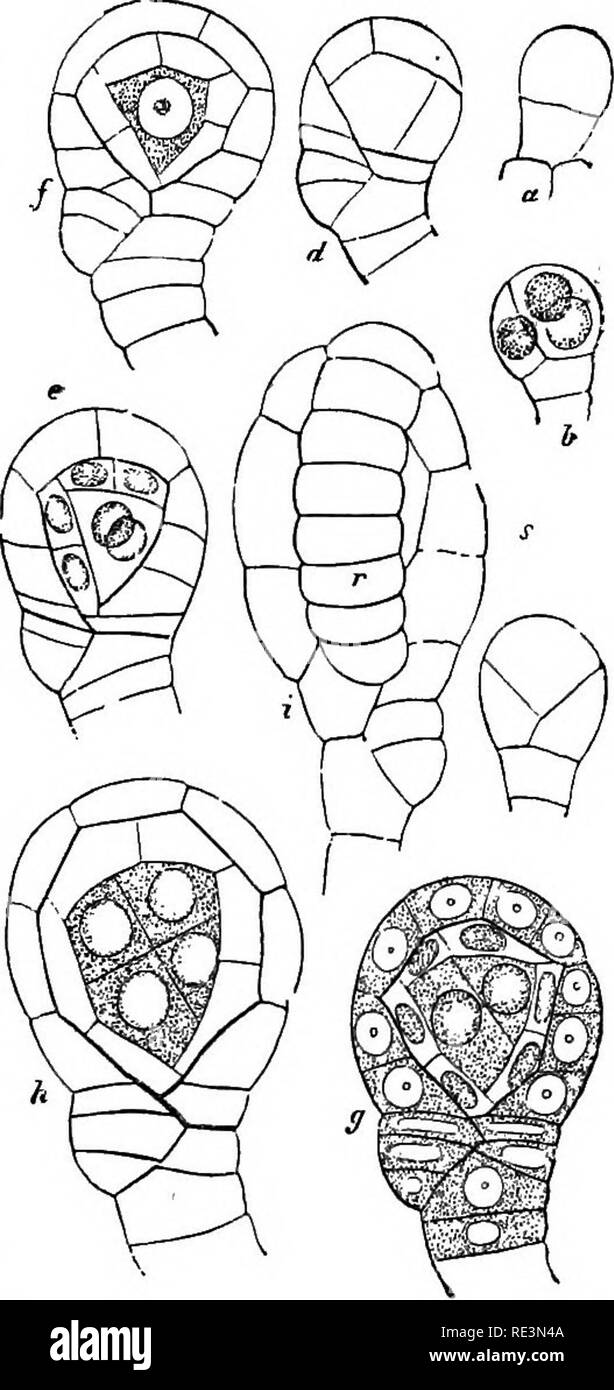 . A handbook of cryptogamic botany. Cryptogams. Fig. 55.âSporange oiAspidmmytlix- tnaSf showing annulus an, lip-cells Ic, and paraphyse attached to stalk. (After Kiindig, greatly magnified.) ranges are frequently slender seg- mented filaments, or paraphyses. T T-11 J- âiT-«'«â Fig. 56.âDevelopment of sporange of .(4«S/e- In some Polypodiace» there is a ^i^n, Tnclwmanes L. s, archespore; r, single (rarely more than one) out-â ^nnuius(x 550). (After Goebei.) growth from the stalk of the sporange, resembling a capitate hair, and sometimes septated internally. It is regarded as a paraphyse, an Stock Photohttps://www.alamy.com/image-license-details/?v=1https://www.alamy.com/a-handbook-of-cryptogamic-botany-cryptogams-fig-55sporange-oiaspidmmytlix-tnasf-showing-annulus-an-lip-cells-ic-and-paraphyse-attached-to-stalk-after-kiindig-greatly-magnified-ranges-are-frequently-slender-seg-mented-filaments-or-paraphyses-t-t-11-j-it-fig-56development-of-sporange-of-4se-in-some-polypodiace-there-is-a-in-tnclwmanes-l-s-archespore-r-single-rarely-more-than-one-out-nnuiusx-550-after-goebei-growth-from-the-stalk-of-the-sporange-resembling-a-capitate-hair-and-sometimes-septated-internally-it-is-regarded-as-a-paraphyse-an-image232422410.html
. A handbook of cryptogamic botany. Cryptogams. Fig. 55.âSporange oiAspidmmytlix- tnaSf showing annulus an, lip-cells Ic, and paraphyse attached to stalk. (After Kiindig, greatly magnified.) ranges are frequently slender seg- mented filaments, or paraphyses. T T-11 J- âiT-«'«â Fig. 56.âDevelopment of sporange of .(4«S/e- In some Polypodiace» there is a ^i^n, Tnclwmanes L. s, archespore; r, single (rarely more than one) out-â ^nnuius(x 550). (After Goebei.) growth from the stalk of the sporange, resembling a capitate hair, and sometimes septated internally. It is regarded as a paraphyse, an Stock Photohttps://www.alamy.com/image-license-details/?v=1https://www.alamy.com/a-handbook-of-cryptogamic-botany-cryptogams-fig-55sporange-oiaspidmmytlix-tnasf-showing-annulus-an-lip-cells-ic-and-paraphyse-attached-to-stalk-after-kiindig-greatly-magnified-ranges-are-frequently-slender-seg-mented-filaments-or-paraphyses-t-t-11-j-it-fig-56development-of-sporange-of-4se-in-some-polypodiace-there-is-a-in-tnclwmanes-l-s-archespore-r-single-rarely-more-than-one-out-nnuiusx-550-after-goebei-growth-from-the-stalk-of-the-sporange-resembling-a-capitate-hair-and-sometimes-septated-internally-it-is-regarded-as-a-paraphyse-an-image232422410.htmlRMRE3N4A–. A handbook of cryptogamic botany. Cryptogams. Fig. 55.âSporange oiAspidmmytlix- tnaSf showing annulus an, lip-cells Ic, and paraphyse attached to stalk. (After Kiindig, greatly magnified.) ranges are frequently slender seg- mented filaments, or paraphyses. T T-11 J- âiT-«'«â Fig. 56.âDevelopment of sporange of .(4«S/e- In some Polypodiace» there is a ^i^n, Tnclwmanes L. s, archespore; r, single (rarely more than one) out-â ^nnuius(x 550). (After Goebei.) growth from the stalk of the sporange, resembling a capitate hair, and sometimes septated internally. It is regarded as a paraphyse, an
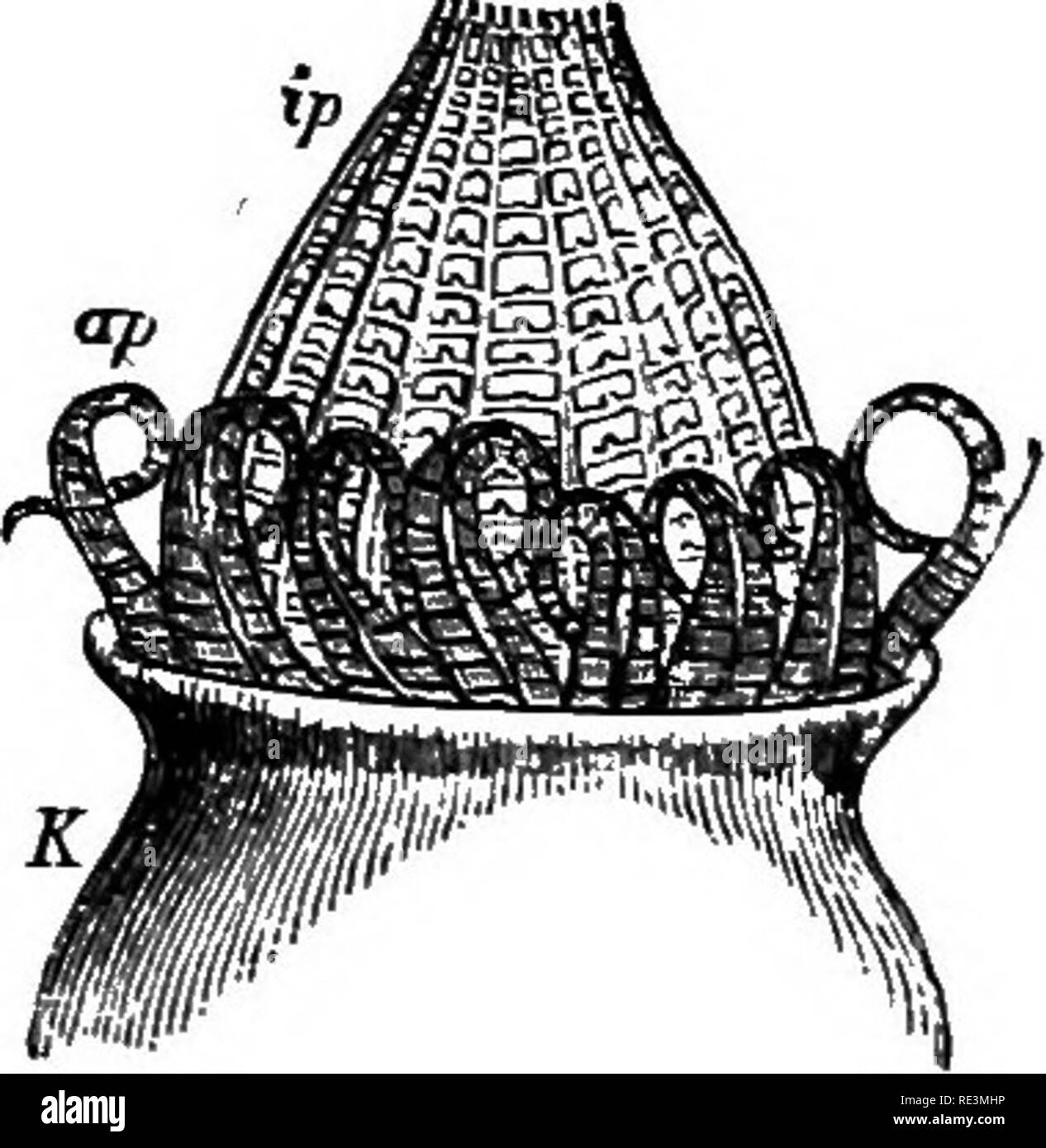 . A handbook of cryptogamic botany. Cryptogams. Fig. iio.—Fnnariti hygromeirica, A^ young plant with young sporogone. B^ mature plant with mature sporogone ; j, seta; f, sporange : Ct calypter (natural size). C, longitudinal section of sporange (greatly magnified); d, opercule; a, annulus ; p^ peristome; c, columel; 5, arche- spore ; /i, air-cavities. (After Goebel.). Fig. iti.—Mouth of sporange cS Fonti- nalis antepyyetica L., with peristome:'' ap^ teeth ; ip^ cilia (x 50), (After Schimper.) developing into the mother-Cells of the spores, from each of which are produced four spores by free-ce Stock Photohttps://www.alamy.com/image-license-details/?v=1https://www.alamy.com/a-handbook-of-cryptogamic-botany-cryptogams-fig-iiofnnariti-hygromeirica-a-young-plant-with-young-sporogone-b-mature-plant-with-mature-sporogone-j-seta-f-sporange-ct-calypter-natural-size-c-longitudinal-section-of-sporange-greatly-magnified-d-opercule-a-annulus-p-peristome-c-columel-5-arche-spore-i-air-cavities-after-goebel-fig-itimouth-of-sporange-cs-fonti-nalis-antepyyetica-l-with-peristome-ap-teeth-ip-cilia-x-50-after-schimper-developing-into-the-mother-cells-of-the-spores-from-each-of-which-are-produced-four-spores-by-free-ce-image232422002.html
. A handbook of cryptogamic botany. Cryptogams. Fig. iio.—Fnnariti hygromeirica, A^ young plant with young sporogone. B^ mature plant with mature sporogone ; j, seta; f, sporange : Ct calypter (natural size). C, longitudinal section of sporange (greatly magnified); d, opercule; a, annulus ; p^ peristome; c, columel; 5, arche- spore ; /i, air-cavities. (After Goebel.). Fig. iti.—Mouth of sporange cS Fonti- nalis antepyyetica L., with peristome:'' ap^ teeth ; ip^ cilia (x 50), (After Schimper.) developing into the mother-Cells of the spores, from each of which are produced four spores by free-ce Stock Photohttps://www.alamy.com/image-license-details/?v=1https://www.alamy.com/a-handbook-of-cryptogamic-botany-cryptogams-fig-iiofnnariti-hygromeirica-a-young-plant-with-young-sporogone-b-mature-plant-with-mature-sporogone-j-seta-f-sporange-ct-calypter-natural-size-c-longitudinal-section-of-sporange-greatly-magnified-d-opercule-a-annulus-p-peristome-c-columel-5-arche-spore-i-air-cavities-after-goebel-fig-itimouth-of-sporange-cs-fonti-nalis-antepyyetica-l-with-peristome-ap-teeth-ip-cilia-x-50-after-schimper-developing-into-the-mother-cells-of-the-spores-from-each-of-which-are-produced-four-spores-by-free-ce-image232422002.htmlRMRE3MHP–. A handbook of cryptogamic botany. Cryptogams. Fig. iio.—Fnnariti hygromeirica, A^ young plant with young sporogone. B^ mature plant with mature sporogone ; j, seta; f, sporange : Ct calypter (natural size). C, longitudinal section of sporange (greatly magnified); d, opercule; a, annulus ; p^ peristome; c, columel; 5, arche- spore ; /i, air-cavities. (After Goebel.). Fig. iti.—Mouth of sporange cS Fonti- nalis antepyyetica L., with peristome:'' ap^ teeth ; ip^ cilia (x 50), (After Schimper.) developing into the mother-Cells of the spores, from each of which are produced four spores by free-ce
![. Class-book of botany [microform] : being outlines of the structure, physiology, and classification of plants : with a flora of the United States and Canada. Botany; Botany; Plants; Plants; Botanique; Botanique; Plantes; Botanique. HcpaticsB. 623, Marchantia, sterile plant. 624-5, Fertile plant B9fi v *⢠, ., the fertil.recept.c)c ; 527, of a perianth, showing the sporange burst n- 52S On TT. *' wuh four spores. 629, Portion of it highly magnified. °"'-st'nâ. 523, One of the clatora of tlie flowering pUnts. In the mosses, liver- "** '^ worts, etc., they appear only on the full-gro Stock Photo . Class-book of botany [microform] : being outlines of the structure, physiology, and classification of plants : with a flora of the United States and Canada. Botany; Botany; Plants; Plants; Botanique; Botanique; Plantes; Botanique. HcpaticsB. 623, Marchantia, sterile plant. 624-5, Fertile plant B9fi v *⢠, ., the fertil.recept.c)c ; 527, of a perianth, showing the sporange burst n- 52S On TT. *' wuh four spores. 629, Portion of it highly magnified. °"'-st'nâ. 523, One of the clatora of tlie flowering pUnts. In the mosses, liver- "** '^ worts, etc., they appear only on the full-gro Stock Photo](https://c8.alamy.com/comp/REPKPH/class-book-of-botany-microform-being-outlines-of-the-structure-physiology-and-classification-of-plants-with-a-flora-of-the-united-states-and-canada-botany-botany-plants-plants-botanique-botanique-plantes-botanique-hcpaticsb-623-marchantia-sterile-plant-624-5-fertile-plant-b9fi-v-the-fertilreceptcc-527-of-a-perianth-showing-the-sporange-burst-n-52s-on-tt-wuh-four-spores-629-portion-of-it-highly-magnified-quot-stn-523-one-of-the-clatora-of-tlie-flowering-punts-in-the-mosses-liver-quot-worts-etc-they-appear-only-on-the-full-gro-REPKPH.jpg) . Class-book of botany [microform] : being outlines of the structure, physiology, and classification of plants : with a flora of the United States and Canada. Botany; Botany; Plants; Plants; Botanique; Botanique; Plantes; Botanique. HcpaticsB. 623, Marchantia, sterile plant. 624-5, Fertile plant B9fi v *⢠, ., the fertil.recept.c)c ; 527, of a perianth, showing the sporange burst n- 52S On TT. *' wuh four spores. 629, Portion of it highly magnified. °"'-st'nâ. 523, One of the clatora of tlie flowering pUnts. In the mosses, liver- "** '^ worts, etc., they appear only on the full-gro Stock Photohttps://www.alamy.com/image-license-details/?v=1https://www.alamy.com/class-book-of-botany-microform-being-outlines-of-the-structure-physiology-and-classification-of-plants-with-a-flora-of-the-united-states-and-canada-botany-botany-plants-plants-botanique-botanique-plantes-botanique-hcpaticsb-623-marchantia-sterile-plant-624-5-fertile-plant-b9fi-v-the-fertilreceptcc-527-of-a-perianth-showing-the-sporange-burst-n-52s-on-tt-wuh-four-spores-629-portion-of-it-highly-magnified-quot-stn-523-one-of-the-clatora-of-tlie-flowering-punts-in-the-mosses-liver-quot-worts-etc-they-appear-only-on-the-full-gro-image232838441.html
. Class-book of botany [microform] : being outlines of the structure, physiology, and classification of plants : with a flora of the United States and Canada. Botany; Botany; Plants; Plants; Botanique; Botanique; Plantes; Botanique. HcpaticsB. 623, Marchantia, sterile plant. 624-5, Fertile plant B9fi v *⢠, ., the fertil.recept.c)c ; 527, of a perianth, showing the sporange burst n- 52S On TT. *' wuh four spores. 629, Portion of it highly magnified. °"'-st'nâ. 523, One of the clatora of tlie flowering pUnts. In the mosses, liver- "** '^ worts, etc., they appear only on the full-gro Stock Photohttps://www.alamy.com/image-license-details/?v=1https://www.alamy.com/class-book-of-botany-microform-being-outlines-of-the-structure-physiology-and-classification-of-plants-with-a-flora-of-the-united-states-and-canada-botany-botany-plants-plants-botanique-botanique-plantes-botanique-hcpaticsb-623-marchantia-sterile-plant-624-5-fertile-plant-b9fi-v-the-fertilreceptcc-527-of-a-perianth-showing-the-sporange-burst-n-52s-on-tt-wuh-four-spores-629-portion-of-it-highly-magnified-quot-stn-523-one-of-the-clatora-of-tlie-flowering-punts-in-the-mosses-liver-quot-worts-etc-they-appear-only-on-the-full-gro-image232838441.htmlRMREPKPH–. Class-book of botany [microform] : being outlines of the structure, physiology, and classification of plants : with a flora of the United States and Canada. Botany; Botany; Plants; Plants; Botanique; Botanique; Plantes; Botanique. HcpaticsB. 623, Marchantia, sterile plant. 624-5, Fertile plant B9fi v *⢠, ., the fertil.recept.c)c ; 527, of a perianth, showing the sporange burst n- 52S On TT. *' wuh four spores. 629, Portion of it highly magnified. °"'-st'nâ. 523, One of the clatora of tlie flowering pUnts. In the mosses, liver- "** '^ worts, etc., they appear only on the full-gro
 . Beitrge zur Kryptogamenflora der Schweiz. 40 semble que le second cloisonnement etait reellement axial et que la pre- niiore cloison a subi iine deviatioii de 90^. La direction des plans de cloisonnement suit certaines lois generales deja anciennement formulees par Sachs '), completees par Bertrand-),. Fig. 14. — Chlorogonium eiichlorum. — Division et formation des zoospores dans le sporange (d'apres Dangeard). Lignier et expliquees dernierement par les tres interessantes recherches de Kny ^). Voir aussi le memoire de mon eleve Tchouproff ^). ') Sachs, Vorlesungen über Pflanzenphysiologie, p Stock Photohttps://www.alamy.com/image-license-details/?v=1https://www.alamy.com/beitrge-zur-kryptogamenflora-der-schweiz-40-semble-que-le-second-cloisonnement-etait-reellement-axial-et-que-la-pre-niiore-cloison-a-subi-iine-deviatioii-de-90-la-direction-des-plans-de-cloisonnement-suit-certaines-lois-generales-deja-anciennement-formulees-par-sachs-completees-par-bertrand-fig-14-chlorogonium-eiichlorum-division-et-formation-des-zoospores-dans-le-sporange-dapres-dangeard-lignier-et-expliquees-dernierement-par-les-tres-interessantes-recherches-de-kny-voir-aussi-le-memoire-de-mon-eleve-tchouproff-sachs-vorlesungen-ber-pflanzenphysiologie-p-image234764577.html
. Beitrge zur Kryptogamenflora der Schweiz. 40 semble que le second cloisonnement etait reellement axial et que la pre- niiore cloison a subi iine deviatioii de 90^. La direction des plans de cloisonnement suit certaines lois generales deja anciennement formulees par Sachs '), completees par Bertrand-),. Fig. 14. — Chlorogonium eiichlorum. — Division et formation des zoospores dans le sporange (d'apres Dangeard). Lignier et expliquees dernierement par les tres interessantes recherches de Kny ^). Voir aussi le memoire de mon eleve Tchouproff ^). ') Sachs, Vorlesungen über Pflanzenphysiologie, p Stock Photohttps://www.alamy.com/image-license-details/?v=1https://www.alamy.com/beitrge-zur-kryptogamenflora-der-schweiz-40-semble-que-le-second-cloisonnement-etait-reellement-axial-et-que-la-pre-niiore-cloison-a-subi-iine-deviatioii-de-90-la-direction-des-plans-de-cloisonnement-suit-certaines-lois-generales-deja-anciennement-formulees-par-sachs-completees-par-bertrand-fig-14-chlorogonium-eiichlorum-division-et-formation-des-zoospores-dans-le-sporange-dapres-dangeard-lignier-et-expliquees-dernierement-par-les-tres-interessantes-recherches-de-kny-voir-aussi-le-memoire-de-mon-eleve-tchouproff-sachs-vorlesungen-ber-pflanzenphysiologie-p-image234764577.htmlRMRHXCH5–. Beitrge zur Kryptogamenflora der Schweiz. 40 semble que le second cloisonnement etait reellement axial et que la pre- niiore cloison a subi iine deviatioii de 90^. La direction des plans de cloisonnement suit certaines lois generales deja anciennement formulees par Sachs '), completees par Bertrand-),. Fig. 14. — Chlorogonium eiichlorum. — Division et formation des zoospores dans le sporange (d'apres Dangeard). Lignier et expliquees dernierement par les tres interessantes recherches de Kny ^). Voir aussi le memoire de mon eleve Tchouproff ^). ') Sachs, Vorlesungen über Pflanzenphysiologie, p
 . A handbook of cryptogamic botany. Cryptogams. Fig. 9.—Salvinia naians. Longitudinal section through megaspore and prothallium. a, wall of sporange; ^, epispore, formed of hardened mucilage; c, coat of" spore ; d, diaphragm separating prothallium from spore-cavity ; ^r, prothallium; m, neck of archegone ; /, //, first two leaves of embryo ; j, scutiform leaf or cotyledon. (After Pringsheim, x 70.). Fig. io.—Archegone of Salvinia natans in three stages, a, b, c, divisions in the neck-cells ; rf, neck-canal-cell: f, oosphere ; A, neck-cells. (After Pringsheim, x ^50.) is fertilised, no oth Stock Photohttps://www.alamy.com/image-license-details/?v=1https://www.alamy.com/a-handbook-of-cryptogamic-botany-cryptogams-fig-9salvinia-naians-longitudinal-section-through-megaspore-and-prothallium-a-wall-of-sporange-epispore-formed-of-hardened-mucilage-c-coat-ofquot-spore-d-diaphragm-separating-prothallium-from-spore-cavity-r-prothallium-m-neck-of-archegone-first-two-leaves-of-embryo-j-scutiform-leaf-or-cotyledon-after-pringsheim-x-70-fig-ioarchegone-of-salvinia-natans-in-three-stages-a-b-c-divisions-in-the-neck-cells-rf-neck-canal-cell-f-oosphere-a-neck-cells-after-pringsheim-x-50-is-fertilised-no-oth-image232422620.html
. A handbook of cryptogamic botany. Cryptogams. Fig. 9.—Salvinia naians. Longitudinal section through megaspore and prothallium. a, wall of sporange; ^, epispore, formed of hardened mucilage; c, coat of" spore ; d, diaphragm separating prothallium from spore-cavity ; ^r, prothallium; m, neck of archegone ; /, //, first two leaves of embryo ; j, scutiform leaf or cotyledon. (After Pringsheim, x 70.). Fig. io.—Archegone of Salvinia natans in three stages, a, b, c, divisions in the neck-cells ; rf, neck-canal-cell: f, oosphere ; A, neck-cells. (After Pringsheim, x ^50.) is fertilised, no oth Stock Photohttps://www.alamy.com/image-license-details/?v=1https://www.alamy.com/a-handbook-of-cryptogamic-botany-cryptogams-fig-9salvinia-naians-longitudinal-section-through-megaspore-and-prothallium-a-wall-of-sporange-epispore-formed-of-hardened-mucilage-c-coat-ofquot-spore-d-diaphragm-separating-prothallium-from-spore-cavity-r-prothallium-m-neck-of-archegone-first-two-leaves-of-embryo-j-scutiform-leaf-or-cotyledon-after-pringsheim-x-70-fig-ioarchegone-of-salvinia-natans-in-three-stages-a-b-c-divisions-in-the-neck-cells-rf-neck-canal-cell-f-oosphere-a-neck-cells-after-pringsheim-x-50-is-fertilised-no-oth-image232422620.htmlRMRE3NBT–. A handbook of cryptogamic botany. Cryptogams. Fig. 9.—Salvinia naians. Longitudinal section through megaspore and prothallium. a, wall of sporange; ^, epispore, formed of hardened mucilage; c, coat of" spore ; d, diaphragm separating prothallium from spore-cavity ; ^r, prothallium; m, neck of archegone ; /, //, first two leaves of embryo ; j, scutiform leaf or cotyledon. (After Pringsheim, x 70.). Fig. io.—Archegone of Salvinia natans in three stages, a, b, c, divisions in the neck-cells ; rf, neck-canal-cell: f, oosphere ; A, neck-cells. (After Pringsheim, x ^50.) is fertilised, no oth
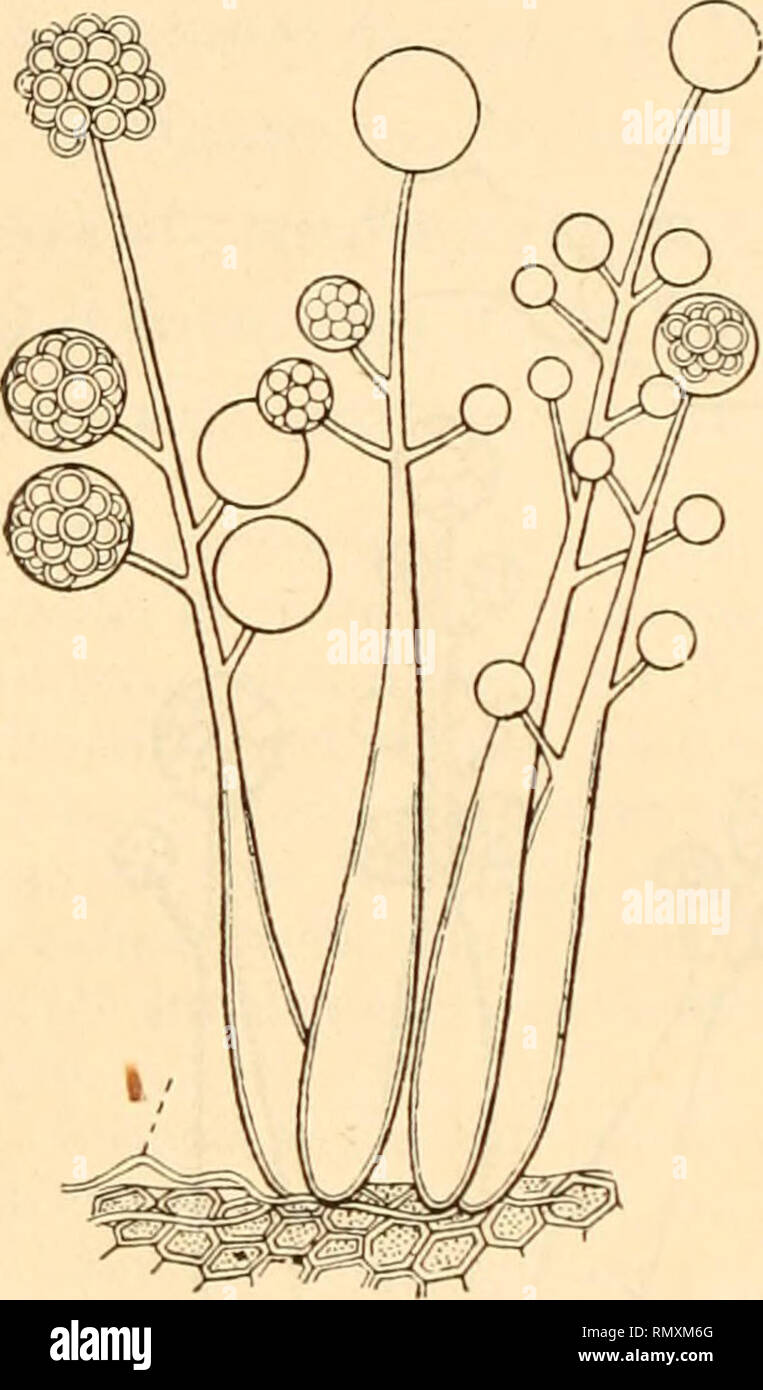 . Annales des sciences naturelles. Plants; Biology. 10 J. DAUPHIN gospores^ dépourims de rolumelles ou de néosporanges. Sjtores de mucor'inées. Le Mortierella polycephala que Cormans étudie pour la première fois est caractérisé comme il suit : <' Hyphes rampants, incolores, tirs longs, peu enchevêtrés, parfois renflés ; cellules fructifères courtes, très nombreuses, jL^roupées en faisceaux, atténuées à la partie supérieure, ramifiées ; rameaux courts, étalés, terminés par un sporange arrondi ; sporanges incolores, à demi transparents, 4-20 spores lisses ; spores ovales ou arrondies. Habitat Stock Photohttps://www.alamy.com/image-license-details/?v=1https://www.alamy.com/annales-des-sciences-naturelles-plants-biology-10-j-dauphin-gospores-dpourims-de-rolumelles-ou-de-nosporanges-sjtores-de-mucorines-le-mortierella-polycephala-que-cormans-tudie-pour-la-premire-fois-est-caractris-comme-il-suit-lt-hyphes-rampants-incolores-tirs-longs-peu-enchevtrs-parfois-renfls-cellules-fructifres-courtes-trs-nombreuses-jlroupes-en-faisceaux-attnues-la-partie-suprieure-ramifies-rameaux-courts-tals-termins-par-un-sporange-arrondi-sporanges-incolores-demi-transparents-4-20-spores-lisses-spores-ovales-ou-arrondies-habitat-image236614520.html
. Annales des sciences naturelles. Plants; Biology. 10 J. DAUPHIN gospores^ dépourims de rolumelles ou de néosporanges. Sjtores de mucor'inées. Le Mortierella polycephala que Cormans étudie pour la première fois est caractérisé comme il suit : <' Hyphes rampants, incolores, tirs longs, peu enchevêtrés, parfois renflés ; cellules fructifères courtes, très nombreuses, jL^roupées en faisceaux, atténuées à la partie supérieure, ramifiées ; rameaux courts, étalés, terminés par un sporange arrondi ; sporanges incolores, à demi transparents, 4-20 spores lisses ; spores ovales ou arrondies. Habitat Stock Photohttps://www.alamy.com/image-license-details/?v=1https://www.alamy.com/annales-des-sciences-naturelles-plants-biology-10-j-dauphin-gospores-dpourims-de-rolumelles-ou-de-nosporanges-sjtores-de-mucorines-le-mortierella-polycephala-que-cormans-tudie-pour-la-premire-fois-est-caractris-comme-il-suit-lt-hyphes-rampants-incolores-tirs-longs-peu-enchevtrs-parfois-renfls-cellules-fructifres-courtes-trs-nombreuses-jlroupes-en-faisceaux-attnues-la-partie-suprieure-ramifies-rameaux-courts-tals-termins-par-un-sporange-arrondi-sporanges-incolores-demi-transparents-4-20-spores-lisses-spores-ovales-ou-arrondies-habitat-image236614520.htmlRMRMXM6G–. Annales des sciences naturelles. Plants; Biology. 10 J. DAUPHIN gospores^ dépourims de rolumelles ou de néosporanges. Sjtores de mucor'inées. Le Mortierella polycephala que Cormans étudie pour la première fois est caractérisé comme il suit : <' Hyphes rampants, incolores, tirs longs, peu enchevêtrés, parfois renflés ; cellules fructifères courtes, très nombreuses, jL^roupées en faisceaux, atténuées à la partie supérieure, ramifiées ; rameaux courts, étalés, terminés par un sporange arrondi ; sporanges incolores, à demi transparents, 4-20 spores lisses ; spores ovales ou arrondies. Habitat
 . Botanique cryptogamique, ou Histoire des familles naturelles des plantes infrieures. 812. 813. SU. 815. 816. Cymnostomuni tenue (port, inflorescence, coiffe, sporange). GYMNOSTOMUM. HEDW. Ceilyptra cucullatavel ventricosa. Spontngium terminale, basisquale: operculum conicum vel rostratum. Peristomium imllunif. 1< Tp.irt.. UEDWIGIEES. Mousses terrestres, vivaces,à reuilles disposées sur huit rangs. Coiffe petite cucullilbrme. Péristome nul. Les Iledwigiées forment des touffes assez étendues, mais peu compactes à la surface des rechers. Leurs tiges sont plus ou moins régulièrement ra Stock Photohttps://www.alamy.com/image-license-details/?v=1https://www.alamy.com/botanique-cryptogamique-ou-histoire-des-familles-naturelles-des-plantes-infrieures-812-813-su-815-816-cymnostomuni-tenue-port-inflorescence-coiffe-sporange-gymnostomum-hedw-ceilyptra-cucullatavel-ventricosa-spontngium-terminale-basisquale-operculum-conicum-vel-rostratum-peristomium-imllunif-1lt-tpirt-uedwigiees-mousses-terrestres-vivaces-reuilles-disposes-sur-huit-rangs-coiffe-petite-cucullilbrme-pristome-nul-les-iledwigies-forment-des-touffes-assez-tendues-mais-peu-compactes-la-surface-des-rechers-leurs-tiges-sont-plus-ou-moins-rgulirement-ra-image234401982.html
. Botanique cryptogamique, ou Histoire des familles naturelles des plantes infrieures. 812. 813. SU. 815. 816. Cymnostomuni tenue (port, inflorescence, coiffe, sporange). GYMNOSTOMUM. HEDW. Ceilyptra cucullatavel ventricosa. Spontngium terminale, basisquale: operculum conicum vel rostratum. Peristomium imllunif. 1< Tp.irt.. UEDWIGIEES. Mousses terrestres, vivaces,à reuilles disposées sur huit rangs. Coiffe petite cucullilbrme. Péristome nul. Les Iledwigiées forment des touffes assez étendues, mais peu compactes à la surface des rechers. Leurs tiges sont plus ou moins régulièrement ra Stock Photohttps://www.alamy.com/image-license-details/?v=1https://www.alamy.com/botanique-cryptogamique-ou-histoire-des-familles-naturelles-des-plantes-infrieures-812-813-su-815-816-cymnostomuni-tenue-port-inflorescence-coiffe-sporange-gymnostomum-hedw-ceilyptra-cucullatavel-ventricosa-spontngium-terminale-basisquale-operculum-conicum-vel-rostratum-peristomium-imllunif-1lt-tpirt-uedwigiees-mousses-terrestres-vivaces-reuilles-disposes-sur-huit-rangs-coiffe-petite-cucullilbrme-pristome-nul-les-iledwigies-forment-des-touffes-assez-tendues-mais-peu-compactes-la-surface-des-rechers-leurs-tiges-sont-plus-ou-moins-rgulirement-ra-image234401982.htmlRMRH9X3A–. Botanique cryptogamique, ou Histoire des familles naturelles des plantes infrieures. 812. 813. SU. 815. 816. Cymnostomuni tenue (port, inflorescence, coiffe, sporange). GYMNOSTOMUM. HEDW. Ceilyptra cucullatavel ventricosa. Spontngium terminale, basisquale: operculum conicum vel rostratum. Peristomium imllunif. 1< Tp.irt.. UEDWIGIEES. Mousses terrestres, vivaces,à reuilles disposées sur huit rangs. Coiffe petite cucullilbrme. Péristome nul. Les Iledwigiées forment des touffes assez étendues, mais peu compactes à la surface des rechers. Leurs tiges sont plus ou moins régulièrement ra
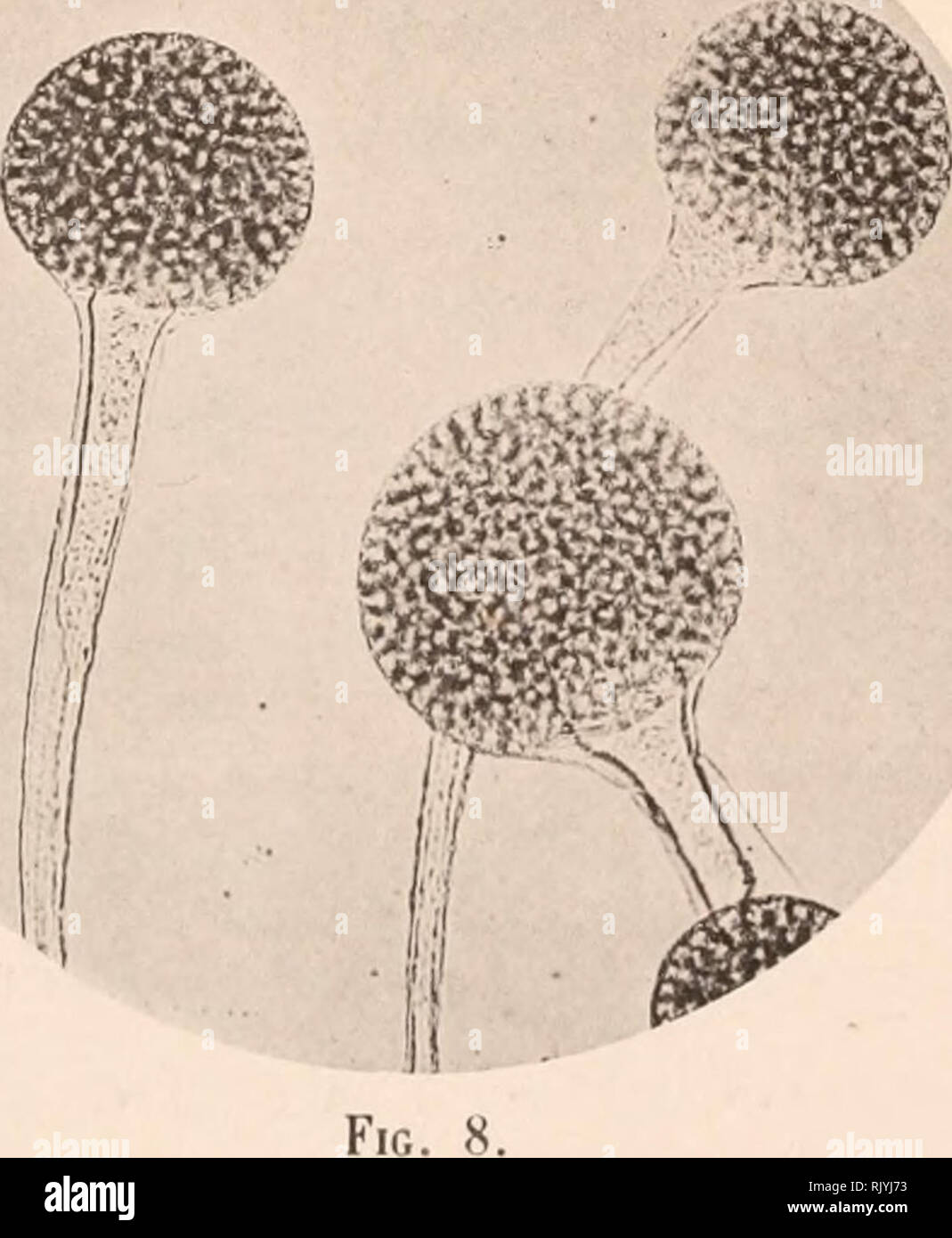 . Atlas de microbiologie ... Roussel, Georges; Microbiology. Fig. 7. Sporange jeune de Mucor spinosus (gr. 400 diam.). plus des tiges droites comme celles du Phycomyces nitens, du Mucor *r*' "'"j".. Sporanges de Mucor racemosus (gr. 2(10 diam.). mucedu ou du Mucor spinosus, niais un paquet de lilaments grisâtres où l'on remarque, à un examen attentif, de nombreux pédicelles surmontés. Please note that these images are extracted from scanned page images that may have been digitally enhanced for readability - coloration and appearance of these illustrations may not perfectly Stock Photohttps://www.alamy.com/image-license-details/?v=1https://www.alamy.com/atlas-de-microbiologie-roussel-georges-microbiology-fig-7-sporange-jeune-de-mucor-spinosus-gr-400-diam-plus-des-tiges-droites-comme-celles-du-phycomyces-nitens-du-mucor-r-quotquotjquot-sporanges-de-mucor-racemosus-gr-210-diam-mucedu-ou-du-mucor-spinosus-niais-un-paquet-de-lilaments-gristres-o-lon-remarque-un-examen-attentif-de-nombreux-pdicelles-surmonts-please-note-that-these-images-are-extracted-from-scanned-page-images-that-may-have-been-digitally-enhanced-for-readability-coloration-and-appearance-of-these-illustrations-may-not-perfectly-image235405607.html
. Atlas de microbiologie ... Roussel, Georges; Microbiology. Fig. 7. Sporange jeune de Mucor spinosus (gr. 400 diam.). plus des tiges droites comme celles du Phycomyces nitens, du Mucor *r*' "'"j".. Sporanges de Mucor racemosus (gr. 2(10 diam.). mucedu ou du Mucor spinosus, niais un paquet de lilaments grisâtres où l'on remarque, à un examen attentif, de nombreux pédicelles surmontés. Please note that these images are extracted from scanned page images that may have been digitally enhanced for readability - coloration and appearance of these illustrations may not perfectly Stock Photohttps://www.alamy.com/image-license-details/?v=1https://www.alamy.com/atlas-de-microbiologie-roussel-georges-microbiology-fig-7-sporange-jeune-de-mucor-spinosus-gr-400-diam-plus-des-tiges-droites-comme-celles-du-phycomyces-nitens-du-mucor-r-quotquotjquot-sporanges-de-mucor-racemosus-gr-210-diam-mucedu-ou-du-mucor-spinosus-niais-un-paquet-de-lilaments-gristres-o-lon-remarque-un-examen-attentif-de-nombreux-pdicelles-surmonts-please-note-that-these-images-are-extracted-from-scanned-page-images-that-may-have-been-digitally-enhanced-for-readability-coloration-and-appearance-of-these-illustrations-may-not-perfectly-image235405607.htmlRMRJYJ73–. Atlas de microbiologie ... Roussel, Georges; Microbiology. Fig. 7. Sporange jeune de Mucor spinosus (gr. 400 diam.). plus des tiges droites comme celles du Phycomyces nitens, du Mucor *r*' "'"j".. Sporanges de Mucor racemosus (gr. 2(10 diam.). mucedu ou du Mucor spinosus, niais un paquet de lilaments grisâtres où l'on remarque, à un examen attentif, de nombreux pédicelles surmontés. Please note that these images are extracted from scanned page images that may have been digitally enhanced for readability - coloration and appearance of these illustrations may not perfectly
 . Anatomie et physiologie végétales à l'usage des étudiants en sciences naturelles des universités, des élèves à l'Institut agronomique, des écoles d'agriculture, etc. Plant anatomy; Plant physiology. Fier. 1006. Fig. 1607. Fig. 1606. — a, pci'itlK'TOS jaunes d'Ascobole (Ascomycète), face et profil (grand, nat.) ; b, lilanienls sporangifères de Pilobole (Mucorinée) ; c, ampoule aqui- tiTC du tube ; (/, calotte noire du sporange (un peu grossi). Fig. 1607. — Coupe du péritbècc de l'Ascobole (Ascobolus furfuraceus). — a, pseudoparencliyine; h, unii[ue cellule ascogène et ses ramilications (/') ; Stock Photohttps://www.alamy.com/image-license-details/?v=1https://www.alamy.com/anatomie-et-physiologie-vgtales-lusage-des-tudiants-en-sciences-naturelles-des-universits-des-lves-linstitut-agronomique-des-coles-dagriculture-etc-plant-anatomy-plant-physiology-fier-1006-fig-1607-fig-1606-a-pciitlktos-jaunes-dascobole-ascomycte-face-et-profil-grand-nat-b-lilanienls-sporangifres-de-pilobole-mucorine-c-ampoule-aqui-titc-du-tube-calotte-noire-du-sporange-un-peu-grossi-fig-1607-coupe-du-pritbcc-de-lascobole-ascobolus-furfuraceus-a-pseudoparencliyine-h-unii-ue-cellule-ascogne-et-ses-ramilications-image236821573.html
. Anatomie et physiologie végétales à l'usage des étudiants en sciences naturelles des universités, des élèves à l'Institut agronomique, des écoles d'agriculture, etc. Plant anatomy; Plant physiology. Fier. 1006. Fig. 1607. Fig. 1606. — a, pci'itlK'TOS jaunes d'Ascobole (Ascomycète), face et profil (grand, nat.) ; b, lilanienls sporangifères de Pilobole (Mucorinée) ; c, ampoule aqui- tiTC du tube ; (/, calotte noire du sporange (un peu grossi). Fig. 1607. — Coupe du péritbècc de l'Ascobole (Ascobolus furfuraceus). — a, pseudoparencliyine; h, unii[ue cellule ascogène et ses ramilications (/') ; Stock Photohttps://www.alamy.com/image-license-details/?v=1https://www.alamy.com/anatomie-et-physiologie-vgtales-lusage-des-tudiants-en-sciences-naturelles-des-universits-des-lves-linstitut-agronomique-des-coles-dagriculture-etc-plant-anatomy-plant-physiology-fier-1006-fig-1607-fig-1606-a-pciitlktos-jaunes-dascobole-ascomycte-face-et-profil-grand-nat-b-lilanienls-sporangifres-de-pilobole-mucorine-c-ampoule-aqui-titc-du-tube-calotte-noire-du-sporange-un-peu-grossi-fig-1607-coupe-du-pritbcc-de-lascobole-ascobolus-furfuraceus-a-pseudoparencliyine-h-unii-ue-cellule-ascogne-et-ses-ramilications-image236821573.htmlRMRN8499–. Anatomie et physiologie végétales à l'usage des étudiants en sciences naturelles des universités, des élèves à l'Institut agronomique, des écoles d'agriculture, etc. Plant anatomy; Plant physiology. Fier. 1006. Fig. 1607. Fig. 1606. — a, pci'itlK'TOS jaunes d'Ascobole (Ascomycète), face et profil (grand, nat.) ; b, lilanienls sporangifères de Pilobole (Mucorinée) ; c, ampoule aqui- tiTC du tube ; (/, calotte noire du sporange (un peu grossi). Fig. 1607. — Coupe du péritbècc de l'Ascobole (Ascobolus furfuraceus). — a, pseudoparencliyine; h, unii[ue cellule ascogène et ses ramilications (/') ;
 . Botanique cryptogamique, ou Histoire des familles naturelles des plantes infrieures. . 812. 813. SU. 815. 816. Cymnostomuni tenue (port, inflorescence, coiffe, sporange). GYMNOSTOMUM. HEDW. Ceilyptra cucullatavel ventricosa. Spontngium terminale, basisquale: operculum conicum vel rostratum. Peristomium imllunif. 1< Tp.irt.. UEDWIGIEES. Mousses terrestres, vivaces,à reuilles disposées sur huit rangs. Coiffe petite cucullilbrme. Péristome nul. Les Iledwigiées forment des touffes assez étendues, mais peu compactes à la surface des rechers. Leurs tiges sont plus ou moins régulièrement Stock Photohttps://www.alamy.com/image-license-details/?v=1https://www.alamy.com/botanique-cryptogamique-ou-histoire-des-familles-naturelles-des-plantes-infrieures-812-813-su-815-816-cymnostomuni-tenue-port-inflorescence-coiffe-sporange-gymnostomum-hedw-ceilyptra-cucullatavel-ventricosa-spontngium-terminale-basisquale-operculum-conicum-vel-rostratum-peristomium-imllunif-1lt-tpirt-uedwigiees-mousses-terrestres-vivaces-reuilles-disposes-sur-huit-rangs-coiffe-petite-cucullilbrme-pristome-nul-les-iledwigies-forment-des-touffes-assez-tendues-mais-peu-compactes-la-surface-des-rechers-leurs-tiges-sont-plus-ou-moins-rgulirement-image234401992.html
. Botanique cryptogamique, ou Histoire des familles naturelles des plantes infrieures. . 812. 813. SU. 815. 816. Cymnostomuni tenue (port, inflorescence, coiffe, sporange). GYMNOSTOMUM. HEDW. Ceilyptra cucullatavel ventricosa. Spontngium terminale, basisquale: operculum conicum vel rostratum. Peristomium imllunif. 1< Tp.irt.. UEDWIGIEES. Mousses terrestres, vivaces,à reuilles disposées sur huit rangs. Coiffe petite cucullilbrme. Péristome nul. Les Iledwigiées forment des touffes assez étendues, mais peu compactes à la surface des rechers. Leurs tiges sont plus ou moins régulièrement Stock Photohttps://www.alamy.com/image-license-details/?v=1https://www.alamy.com/botanique-cryptogamique-ou-histoire-des-familles-naturelles-des-plantes-infrieures-812-813-su-815-816-cymnostomuni-tenue-port-inflorescence-coiffe-sporange-gymnostomum-hedw-ceilyptra-cucullatavel-ventricosa-spontngium-terminale-basisquale-operculum-conicum-vel-rostratum-peristomium-imllunif-1lt-tpirt-uedwigiees-mousses-terrestres-vivaces-reuilles-disposes-sur-huit-rangs-coiffe-petite-cucullilbrme-pristome-nul-les-iledwigies-forment-des-touffes-assez-tendues-mais-peu-compactes-la-surface-des-rechers-leurs-tiges-sont-plus-ou-moins-rgulirement-image234401992.htmlRMRH9X3M–. Botanique cryptogamique, ou Histoire des familles naturelles des plantes infrieures. . 812. 813. SU. 815. 816. Cymnostomuni tenue (port, inflorescence, coiffe, sporange). GYMNOSTOMUM. HEDW. Ceilyptra cucullatavel ventricosa. Spontngium terminale, basisquale: operculum conicum vel rostratum. Peristomium imllunif. 1< Tp.irt.. UEDWIGIEES. Mousses terrestres, vivaces,à reuilles disposées sur huit rangs. Coiffe petite cucullilbrme. Péristome nul. Les Iledwigiées forment des touffes assez étendues, mais peu compactes à la surface des rechers. Leurs tiges sont plus ou moins régulièrement
 . Annales des Sciences Naturelles Botaniques. SUR QUELQUES MYRIONÉMACÉES. 231 M. vulgare, les cellules des rhizoïdes sont toujours longues et étroites. Certains rhizoïdes sont pénétrants; ils s'enfoncent. Fig. 12. — Ulonema rhizophorum (sur Dumontia filiformis, Berwick-ou-Tweed, Batters, juin 1895). — A, Portion périphérique du thalle rampant; B, File radiale jeune montrant le développement des filaments dressés; C, File radiale montrant les filaments dressés adultes; D, Filaments dressés et sporange pluriloculaire ; E, Sporanges uniloculaires et filaments dressés de formes variées (A à E, Gro Stock Photohttps://www.alamy.com/image-license-details/?v=1https://www.alamy.com/annales-des-sciences-naturelles-botaniques-sur-quelques-myrionmaces-231-m-vulgare-les-cellules-des-rhizodes-sont-toujours-longues-et-troites-certains-rhizodes-sont-pntrants-ils-senfoncent-fig-12-ulonema-rhizophorum-sur-dumontia-filiformis-berwick-ou-tweed-batters-juin-1895-a-portion-priphrique-du-thalle-rampant-b-file-radiale-jeune-montrant-le-dveloppement-des-filaments-dresss-c-file-radiale-montrant-les-filaments-dresss-adultes-d-filaments-dresss-et-sporange-pluriloculaire-e-sporanges-uniloculaires-et-filaments-dresss-de-formes-varies-a-e-gro-image236601278.html
. Annales des Sciences Naturelles Botaniques. SUR QUELQUES MYRIONÉMACÉES. 231 M. vulgare, les cellules des rhizoïdes sont toujours longues et étroites. Certains rhizoïdes sont pénétrants; ils s'enfoncent. Fig. 12. — Ulonema rhizophorum (sur Dumontia filiformis, Berwick-ou-Tweed, Batters, juin 1895). — A, Portion périphérique du thalle rampant; B, File radiale jeune montrant le développement des filaments dressés; C, File radiale montrant les filaments dressés adultes; D, Filaments dressés et sporange pluriloculaire ; E, Sporanges uniloculaires et filaments dressés de formes variées (A à E, Gro Stock Photohttps://www.alamy.com/image-license-details/?v=1https://www.alamy.com/annales-des-sciences-naturelles-botaniques-sur-quelques-myrionmaces-231-m-vulgare-les-cellules-des-rhizodes-sont-toujours-longues-et-troites-certains-rhizodes-sont-pntrants-ils-senfoncent-fig-12-ulonema-rhizophorum-sur-dumontia-filiformis-berwick-ou-tweed-batters-juin-1895-a-portion-priphrique-du-thalle-rampant-b-file-radiale-jeune-montrant-le-dveloppement-des-filaments-dresss-c-file-radiale-montrant-les-filaments-dresss-adultes-d-filaments-dresss-et-sporange-pluriloculaire-e-sporanges-uniloculaires-et-filaments-dresss-de-formes-varies-a-e-gro-image236601278.htmlRMRMX39J–. Annales des Sciences Naturelles Botaniques. SUR QUELQUES MYRIONÉMACÉES. 231 M. vulgare, les cellules des rhizoïdes sont toujours longues et étroites. Certains rhizoïdes sont pénétrants; ils s'enfoncent. Fig. 12. — Ulonema rhizophorum (sur Dumontia filiformis, Berwick-ou-Tweed, Batters, juin 1895). — A, Portion périphérique du thalle rampant; B, File radiale jeune montrant le développement des filaments dressés; C, File radiale montrant les filaments dressés adultes; D, Filaments dressés et sporange pluriloculaire ; E, Sporanges uniloculaires et filaments dressés de formes variées (A à E, Gro
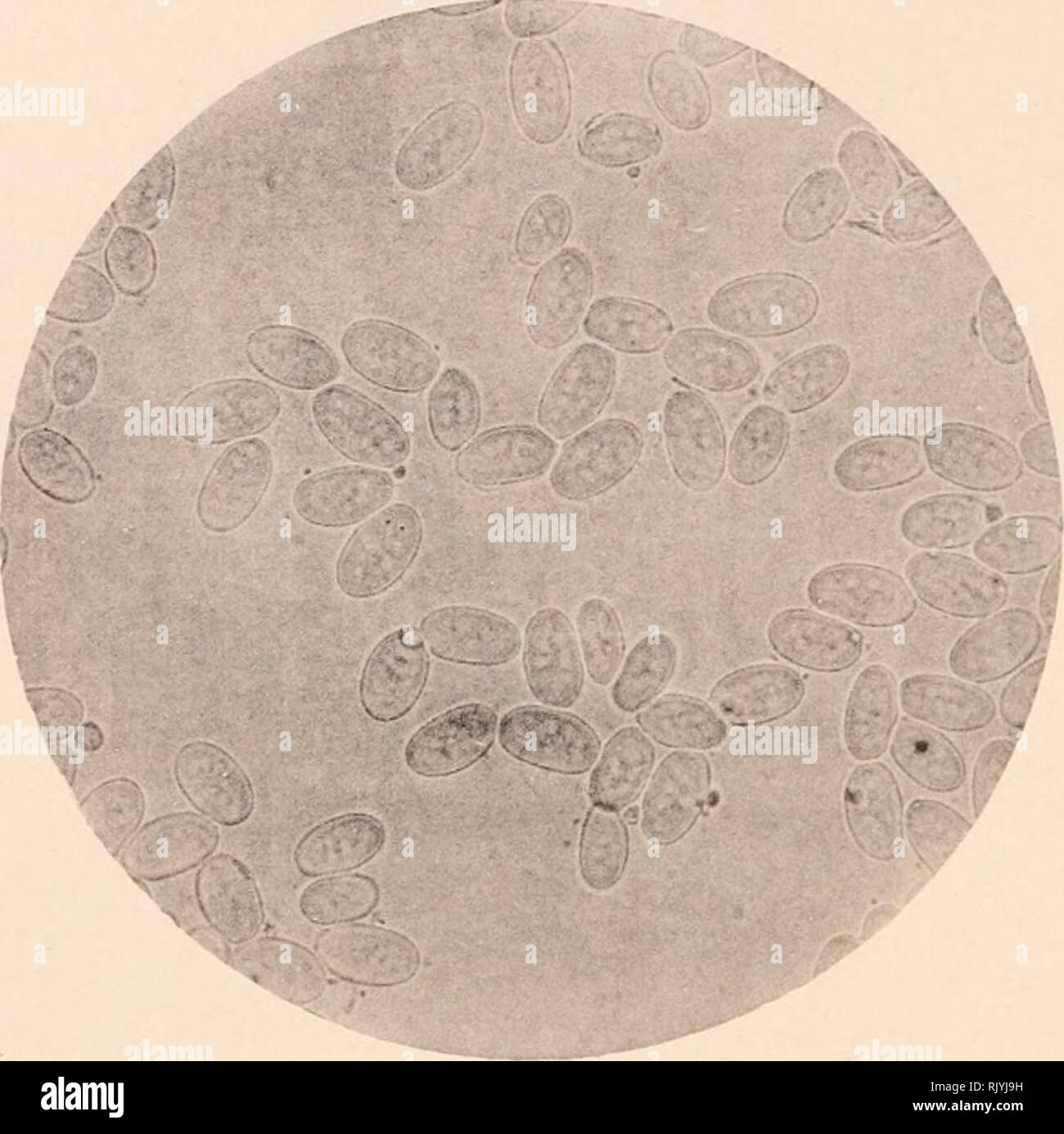 . Atlas de microbiologie ... Roussel, Georges; Microbiology. 10 ATLAS DE MICROBIOLOGIE nitens, qui viennent d'être mises en liberté par suite de l'écrasement d'un sporange sous une légère pression de la lamelle.. Fig. 4. Spores de Phycomyces nilens (gr. 400 dinm.). MUCOR SPINOSUS * Le Mucor sjrinosus est l'un des plus petits mucors connus. La figure 5 l .Oh t ff y *. Please note that these images are extracted from scanned page images that may have been digitally enhanced for readability - coloration and appearance of these illustrations may not perfectly resemble the original work.. Doyen, E. Stock Photohttps://www.alamy.com/image-license-details/?v=1https://www.alamy.com/atlas-de-microbiologie-roussel-georges-microbiology-10-atlas-de-microbiologie-nitens-qui-viennent-dtre-mises-en-libert-par-suite-de-lcrasement-dun-sporange-sous-une-lgre-pression-de-la-lamelle-fig-4-spores-de-phycomyces-nilens-gr-400-dinm-mucor-spinosus-le-mucor-sjrinosus-est-lun-des-plus-petits-mucors-connus-la-figure-5-l-oh-t-ff-y-please-note-that-these-images-are-extracted-from-scanned-page-images-that-may-have-been-digitally-enhanced-for-readability-coloration-and-appearance-of-these-illustrations-may-not-perfectly-resemble-the-original-work-doyen-e-image235405677.html
. Atlas de microbiologie ... Roussel, Georges; Microbiology. 10 ATLAS DE MICROBIOLOGIE nitens, qui viennent d'être mises en liberté par suite de l'écrasement d'un sporange sous une légère pression de la lamelle.. Fig. 4. Spores de Phycomyces nilens (gr. 400 dinm.). MUCOR SPINOSUS * Le Mucor sjrinosus est l'un des plus petits mucors connus. La figure 5 l .Oh t ff y *. Please note that these images are extracted from scanned page images that may have been digitally enhanced for readability - coloration and appearance of these illustrations may not perfectly resemble the original work.. Doyen, E. Stock Photohttps://www.alamy.com/image-license-details/?v=1https://www.alamy.com/atlas-de-microbiologie-roussel-georges-microbiology-10-atlas-de-microbiologie-nitens-qui-viennent-dtre-mises-en-libert-par-suite-de-lcrasement-dun-sporange-sous-une-lgre-pression-de-la-lamelle-fig-4-spores-de-phycomyces-nilens-gr-400-dinm-mucor-spinosus-le-mucor-sjrinosus-est-lun-des-plus-petits-mucors-connus-la-figure-5-l-oh-t-ff-y-please-note-that-these-images-are-extracted-from-scanned-page-images-that-may-have-been-digitally-enhanced-for-readability-coloration-and-appearance-of-these-illustrations-may-not-perfectly-resemble-the-original-work-doyen-e-image235405677.htmlRMRJYJ9H–. Atlas de microbiologie ... Roussel, Georges; Microbiology. 10 ATLAS DE MICROBIOLOGIE nitens, qui viennent d'être mises en liberté par suite de l'écrasement d'un sporange sous une légère pression de la lamelle.. Fig. 4. Spores de Phycomyces nilens (gr. 400 dinm.). MUCOR SPINOSUS * Le Mucor sjrinosus est l'un des plus petits mucors connus. La figure 5 l .Oh t ff y *. Please note that these images are extracted from scanned page images that may have been digitally enhanced for readability - coloration and appearance of these illustrations may not perfectly resemble the original work.. Doyen, E.
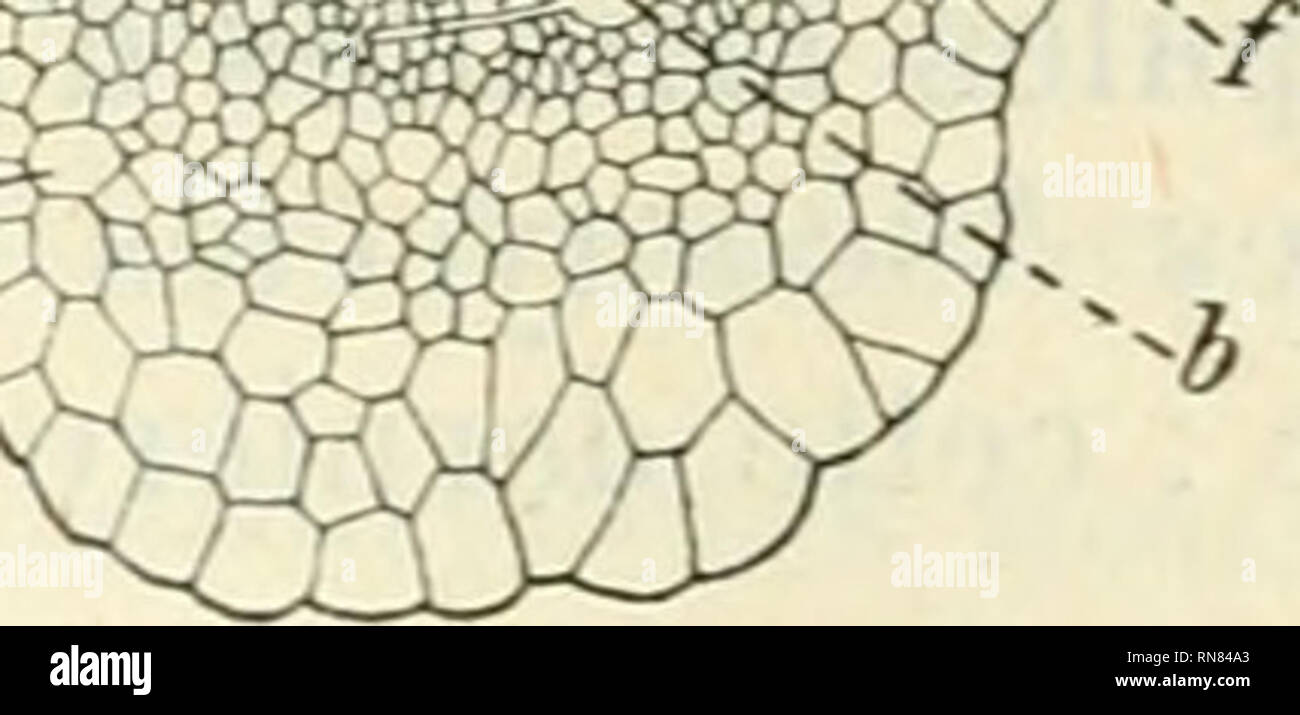 . Anatomie et physiologie végétales à l'usage des étudiants en sciences naturelles des universités, des élèves à l'Institut agronomique, des écoles d'agriculture, etc. Plant anatomy; Plant physiology. Fier. 1006. Fig. 1607. Fig. 1606. — a, pci'itlK'TOS jaunes d'Ascobole (Ascomycète), face et profil (grand, nat.) ; b, lilanienls sporangifères de Pilobole (Mucorinée) ; c, ampoule aqui- tiTC du tube ; (/, calotte noire du sporange (un peu grossi). Fig. 1607. — Coupe du péritbècc de l'Ascobole (Ascobolus furfuraceus). — a, pseudoparencliyine; h, unii[ue cellule ascogène et ses ramilications (/') ; Stock Photohttps://www.alamy.com/image-license-details/?v=1https://www.alamy.com/anatomie-et-physiologie-vgtales-lusage-des-tudiants-en-sciences-naturelles-des-universits-des-lves-linstitut-agronomique-des-coles-dagriculture-etc-plant-anatomy-plant-physiology-fier-1006-fig-1607-fig-1606-a-pciitlktos-jaunes-dascobole-ascomycte-face-et-profil-grand-nat-b-lilanienls-sporangifres-de-pilobole-mucorine-c-ampoule-aqui-titc-du-tube-calotte-noire-du-sporange-un-peu-grossi-fig-1607-coupe-du-pritbcc-de-lascobole-ascobolus-furfuraceus-a-pseudoparencliyine-h-unii-ue-cellule-ascogne-et-ses-ramilications-image236821595.html
. Anatomie et physiologie végétales à l'usage des étudiants en sciences naturelles des universités, des élèves à l'Institut agronomique, des écoles d'agriculture, etc. Plant anatomy; Plant physiology. Fier. 1006. Fig. 1607. Fig. 1606. — a, pci'itlK'TOS jaunes d'Ascobole (Ascomycète), face et profil (grand, nat.) ; b, lilanienls sporangifères de Pilobole (Mucorinée) ; c, ampoule aqui- tiTC du tube ; (/, calotte noire du sporange (un peu grossi). Fig. 1607. — Coupe du péritbècc de l'Ascobole (Ascobolus furfuraceus). — a, pseudoparencliyine; h, unii[ue cellule ascogène et ses ramilications (/') ; Stock Photohttps://www.alamy.com/image-license-details/?v=1https://www.alamy.com/anatomie-et-physiologie-vgtales-lusage-des-tudiants-en-sciences-naturelles-des-universits-des-lves-linstitut-agronomique-des-coles-dagriculture-etc-plant-anatomy-plant-physiology-fier-1006-fig-1607-fig-1606-a-pciitlktos-jaunes-dascobole-ascomycte-face-et-profil-grand-nat-b-lilanienls-sporangifres-de-pilobole-mucorine-c-ampoule-aqui-titc-du-tube-calotte-noire-du-sporange-un-peu-grossi-fig-1607-coupe-du-pritbcc-de-lascobole-ascobolus-furfuraceus-a-pseudoparencliyine-h-unii-ue-cellule-ascogne-et-ses-ramilications-image236821595.htmlRMRN84A3–. Anatomie et physiologie végétales à l'usage des étudiants en sciences naturelles des universités, des élèves à l'Institut agronomique, des écoles d'agriculture, etc. Plant anatomy; Plant physiology. Fier. 1006. Fig. 1607. Fig. 1606. — a, pci'itlK'TOS jaunes d'Ascobole (Ascomycète), face et profil (grand, nat.) ; b, lilanienls sporangifères de Pilobole (Mucorinée) ; c, ampoule aqui- tiTC du tube ; (/, calotte noire du sporange (un peu grossi). Fig. 1607. — Coupe du péritbècc de l'Ascobole (Ascobolus furfuraceus). — a, pseudoparencliyine; h, unii[ue cellule ascogène et ses ramilications (/') ;
 . Botanique cryptogamique, ou Histoire des familles naturelles des plantes infrieures. . (Port.) (Tissu de la feuille.) (Sporange.) (Coupe du sporange) SCHISTOTEGA, WEB. el il/. Calyplra mitraeformis, intégra. Sporangium basi Åquale absque aniiulo et peristomio. XIX"-Tribu. DRÃPANOPHYLLÃES. Mousses terrestres, vivaces, à feuilles distiques, engainantes comme celles de l'Iris. Coiffe en capuchon. Pensionne simple. Les DrepanophylLum forment avec les Fusillais une tribu naturelle et distincte de toutes les autres par la forme de leurs feuilles, (pie nous avons indiquée dans nos générali Stock Photohttps://www.alamy.com/image-license-details/?v=1https://www.alamy.com/botanique-cryptogamique-ou-histoire-des-familles-naturelles-des-plantes-infrieures-port-tissu-de-la-feuille-sporange-coupe-du-sporange-schistotega-web-el-il-calyplra-mitraeformis-intgra-sporangium-basi-quale-absque-aniiulo-et-peristomio-xixquot-tribu-drpanophylles-mousses-terrestres-vivaces-feuilles-distiques-engainantes-comme-celles-de-liris-coiffe-en-capuchon-pensionne-simple-les-drepanophyllum-forment-avec-les-fusillais-une-tribu-naturelle-et-distincte-de-toutes-les-autres-par-la-forme-de-leurs-feuilles-pie-nous-avons-indique-dans-nos-gnrali-image234401828.html
. Botanique cryptogamique, ou Histoire des familles naturelles des plantes infrieures. . (Port.) (Tissu de la feuille.) (Sporange.) (Coupe du sporange) SCHISTOTEGA, WEB. el il/. Calyplra mitraeformis, intégra. Sporangium basi Åquale absque aniiulo et peristomio. XIX"-Tribu. DRÃPANOPHYLLÃES. Mousses terrestres, vivaces, à feuilles distiques, engainantes comme celles de l'Iris. Coiffe en capuchon. Pensionne simple. Les DrepanophylLum forment avec les Fusillais une tribu naturelle et distincte de toutes les autres par la forme de leurs feuilles, (pie nous avons indiquée dans nos générali Stock Photohttps://www.alamy.com/image-license-details/?v=1https://www.alamy.com/botanique-cryptogamique-ou-histoire-des-familles-naturelles-des-plantes-infrieures-port-tissu-de-la-feuille-sporange-coupe-du-sporange-schistotega-web-el-il-calyplra-mitraeformis-intgra-sporangium-basi-quale-absque-aniiulo-et-peristomio-xixquot-tribu-drpanophylles-mousses-terrestres-vivaces-feuilles-distiques-engainantes-comme-celles-de-liris-coiffe-en-capuchon-pensionne-simple-les-drepanophyllum-forment-avec-les-fusillais-une-tribu-naturelle-et-distincte-de-toutes-les-autres-par-la-forme-de-leurs-feuilles-pie-nous-avons-indique-dans-nos-gnrali-image234401828.htmlRMRH9WWT–. Botanique cryptogamique, ou Histoire des familles naturelles des plantes infrieures. . (Port.) (Tissu de la feuille.) (Sporange.) (Coupe du sporange) SCHISTOTEGA, WEB. el il/. Calyplra mitraeformis, intégra. Sporangium basi Åquale absque aniiulo et peristomio. XIX"-Tribu. DRÃPANOPHYLLÃES. Mousses terrestres, vivaces, à feuilles distiques, engainantes comme celles de l'Iris. Coiffe en capuchon. Pensionne simple. Les DrepanophylLum forment avec les Fusillais une tribu naturelle et distincte de toutes les autres par la forme de leurs feuilles, (pie nous avons indiquée dans nos générali
 . Botanique cryptogamique, ou Histoire des familles naturelles des plantes infrieures. (Port.) (Sporange et cuilïe.. (Feudles.). Le péristome des Fissidens esl simple, à seize dents lancéolées'de douleur pourpre. Ces dents sonl fendues jusqu'au milieu en deux branches inégales, disposées de façon que la plus petite de l'une des dents soil à -côté de la plus petite de la denl voisine.. Please note that these images are extracted from scanned page images that may have been digitally enhanced for readability - coloration and appearance of these illustrations may not perfectly resemble th Stock Photohttps://www.alamy.com/image-license-details/?v=1https://www.alamy.com/botanique-cryptogamique-ou-histoire-des-familles-naturelles-des-plantes-infrieures-port-sporange-et-cuile-feudles-le-pristome-des-fissidens-esl-simple-seize-dents-lancolesde-douleur-pourpre-ces-dents-sonl-fendues-jusquau-milieu-en-deux-branches-ingales-disposes-de-faon-que-la-plus-petite-de-lune-des-dents-soil-ct-de-la-plus-petite-de-la-denl-voisine-please-note-that-these-images-are-extracted-from-scanned-page-images-that-may-have-been-digitally-enhanced-for-readability-coloration-and-appearance-of-these-illustrations-may-not-perfectly-resemble-th-image234401811.html
. Botanique cryptogamique, ou Histoire des familles naturelles des plantes infrieures. (Port.) (Sporange et cuilïe.. (Feudles.). Le péristome des Fissidens esl simple, à seize dents lancéolées'de douleur pourpre. Ces dents sonl fendues jusqu'au milieu en deux branches inégales, disposées de façon que la plus petite de l'une des dents soil à -côté de la plus petite de la denl voisine.. Please note that these images are extracted from scanned page images that may have been digitally enhanced for readability - coloration and appearance of these illustrations may not perfectly resemble th Stock Photohttps://www.alamy.com/image-license-details/?v=1https://www.alamy.com/botanique-cryptogamique-ou-histoire-des-familles-naturelles-des-plantes-infrieures-port-sporange-et-cuile-feudles-le-pristome-des-fissidens-esl-simple-seize-dents-lancolesde-douleur-pourpre-ces-dents-sonl-fendues-jusquau-milieu-en-deux-branches-ingales-disposes-de-faon-que-la-plus-petite-de-lune-des-dents-soil-ct-de-la-plus-petite-de-la-denl-voisine-please-note-that-these-images-are-extracted-from-scanned-page-images-that-may-have-been-digitally-enhanced-for-readability-coloration-and-appearance-of-these-illustrations-may-not-perfectly-resemble-th-image234401811.htmlRMRH9WW7–. Botanique cryptogamique, ou Histoire des familles naturelles des plantes infrieures. (Port.) (Sporange et cuilïe.. (Feudles.). Le péristome des Fissidens esl simple, à seize dents lancéolées'de douleur pourpre. Ces dents sonl fendues jusqu'au milieu en deux branches inégales, disposées de façon que la plus petite de l'une des dents soil à -côté de la plus petite de la denl voisine.. Please note that these images are extracted from scanned page images that may have been digitally enhanced for readability - coloration and appearance of these illustrations may not perfectly resemble th
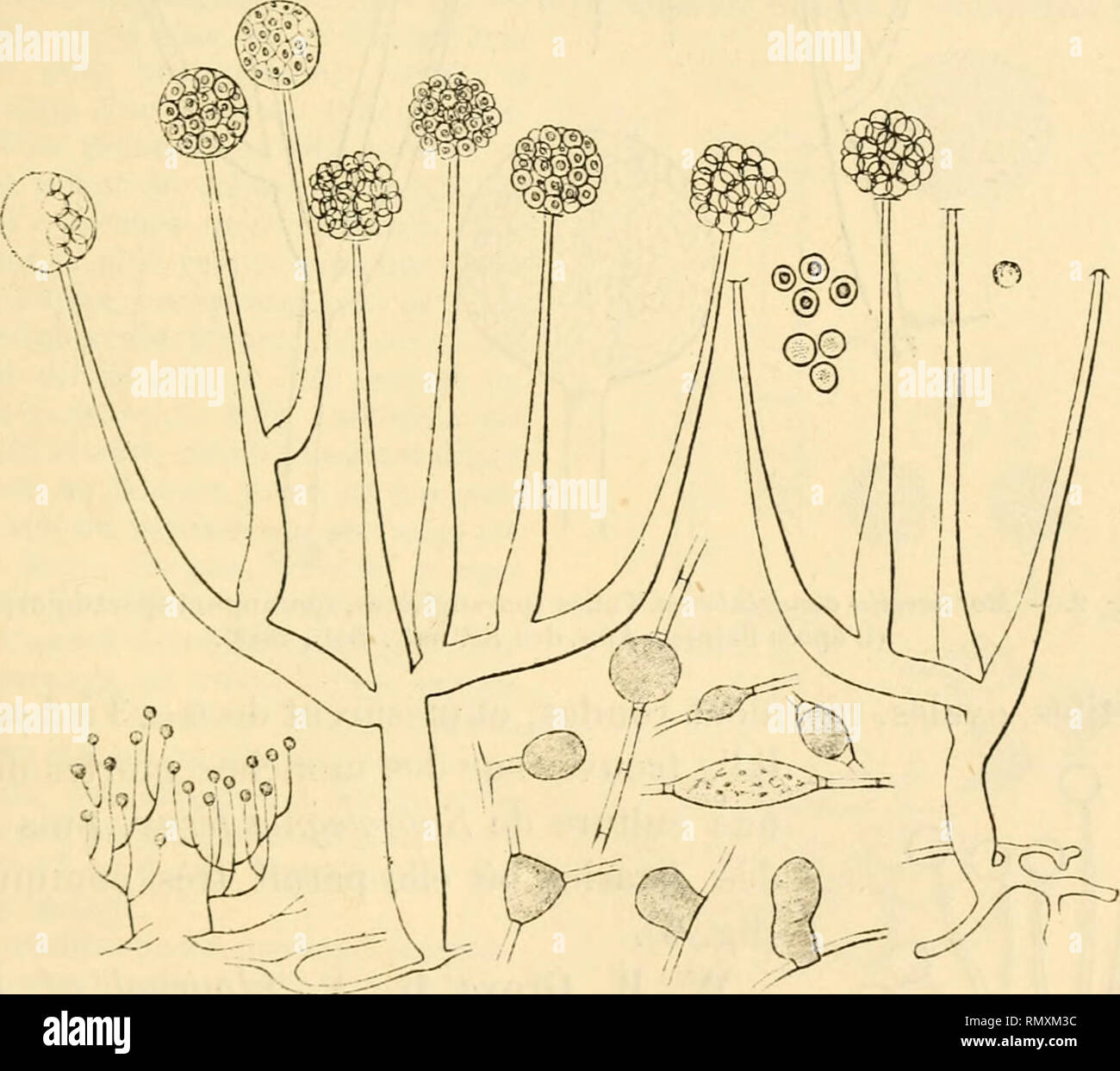 . Annales des sciences naturelles. Plants; Biology. CONTRIBUTION A L ETUDE DES MORTIÉRELLÉES 15 sporange. Après la déhiscence, la membrane du sporange laisse souvent une petite cupule adhérente autour du boulon (|ui termine le tube. Les stylospores sont pédicellées, à membrane épaisse échinulée, d'environ IG a de diamètre. Les chlamydospores aquatiques, plus ou moins ari-ondies, transparentes, remplies dun protoplasma granuleux, qui parfois se divise en masses polyédriques, ont un diamètre d'environ 10 à 12 ;j.. Habitat: Sur du terreau humide (lig. 7). Mortierella candelabrum (Van Tiegliem et Stock Photohttps://www.alamy.com/image-license-details/?v=1https://www.alamy.com/annales-des-sciences-naturelles-plants-biology-contribution-a-l-etude-des-mortirelles-15-sporange-aprs-la-dhiscence-la-membrane-du-sporange-laisse-souvent-une-petite-cupule-adhrente-autour-du-boulon-ui-termine-le-tube-les-stylospores-sont-pdicelles-membrane-paisse-chinule-denviron-ig-a-de-diamtre-les-chlamydospores-aquatiques-plus-ou-moins-ari-ondies-transparentes-remplies-dun-protoplasma-granuleux-qui-parfois-se-divise-en-masses-polydriques-ont-un-diamtre-denviron-10-12-j-habitat-sur-du-terreau-humide-lig-7-mortierella-candelabrum-van-tiegliem-et-image236614432.html
. Annales des sciences naturelles. Plants; Biology. CONTRIBUTION A L ETUDE DES MORTIÉRELLÉES 15 sporange. Après la déhiscence, la membrane du sporange laisse souvent une petite cupule adhérente autour du boulon (|ui termine le tube. Les stylospores sont pédicellées, à membrane épaisse échinulée, d'environ IG a de diamètre. Les chlamydospores aquatiques, plus ou moins ari-ondies, transparentes, remplies dun protoplasma granuleux, qui parfois se divise en masses polyédriques, ont un diamètre d'environ 10 à 12 ;j.. Habitat: Sur du terreau humide (lig. 7). Mortierella candelabrum (Van Tiegliem et Stock Photohttps://www.alamy.com/image-license-details/?v=1https://www.alamy.com/annales-des-sciences-naturelles-plants-biology-contribution-a-l-etude-des-mortirelles-15-sporange-aprs-la-dhiscence-la-membrane-du-sporange-laisse-souvent-une-petite-cupule-adhrente-autour-du-boulon-ui-termine-le-tube-les-stylospores-sont-pdicelles-membrane-paisse-chinule-denviron-ig-a-de-diamtre-les-chlamydospores-aquatiques-plus-ou-moins-ari-ondies-transparentes-remplies-dun-protoplasma-granuleux-qui-parfois-se-divise-en-masses-polydriques-ont-un-diamtre-denviron-10-12-j-habitat-sur-du-terreau-humide-lig-7-mortierella-candelabrum-van-tiegliem-et-image236614432.htmlRMRMXM3C–. Annales des sciences naturelles. Plants; Biology. CONTRIBUTION A L ETUDE DES MORTIÉRELLÉES 15 sporange. Après la déhiscence, la membrane du sporange laisse souvent une petite cupule adhérente autour du boulon (|ui termine le tube. Les stylospores sont pédicellées, à membrane épaisse échinulée, d'environ IG a de diamètre. Les chlamydospores aquatiques, plus ou moins ari-ondies, transparentes, remplies dun protoplasma granuleux, qui parfois se divise en masses polyédriques, ont un diamètre d'environ 10 à 12 ;j.. Habitat: Sur du terreau humide (lig. 7). Mortierella candelabrum (Van Tiegliem et
 . Beitrge zur Kryptogamenflora der Schweiz. 32 On observe aussi cette formation sur le sporange, notamment aiix depens de la columelle. Lorsqu'elle se produit sur le mycelium, la chlamydospore est ordinairement plus reguliere, ovale, quoique de dimensions variables. Dans chaque cas, le contenu est tres fortement granuleux, refringent; les matieres de reserve sont representees par des gouttelettes d'huile. La presence ou l'absence de ces cellules, la facilite avec laquelle elles se forment souvent, permettent de differencier nettement cer- taines especes. Conservant longtemps leur facultö germi Stock Photohttps://www.alamy.com/image-license-details/?v=1https://www.alamy.com/beitrge-zur-kryptogamenflora-der-schweiz-32-on-observe-aussi-cette-formation-sur-le-sporange-notamment-aiix-depens-de-la-columelle-lorsquelle-se-produit-sur-le-mycelium-la-chlamydospore-est-ordinairement-plus-reguliere-ovale-quoique-de-dimensions-variables-dans-chaque-cas-le-contenu-est-tres-fortement-granuleux-refringent-les-matieres-de-reserve-sont-representees-par-des-gouttelettes-dhuile-la-presence-ou-labsence-de-ces-cellules-la-facilite-avec-laquelle-elles-se-forment-souvent-permettent-de-differencier-nettement-cer-taines-especes-conservant-longtemps-leur-facult-germi-image234785797.html
. Beitrge zur Kryptogamenflora der Schweiz. 32 On observe aussi cette formation sur le sporange, notamment aiix depens de la columelle. Lorsqu'elle se produit sur le mycelium, la chlamydospore est ordinairement plus reguliere, ovale, quoique de dimensions variables. Dans chaque cas, le contenu est tres fortement granuleux, refringent; les matieres de reserve sont representees par des gouttelettes d'huile. La presence ou l'absence de ces cellules, la facilite avec laquelle elles se forment souvent, permettent de differencier nettement cer- taines especes. Conservant longtemps leur facultö germi Stock Photohttps://www.alamy.com/image-license-details/?v=1https://www.alamy.com/beitrge-zur-kryptogamenflora-der-schweiz-32-on-observe-aussi-cette-formation-sur-le-sporange-notamment-aiix-depens-de-la-columelle-lorsquelle-se-produit-sur-le-mycelium-la-chlamydospore-est-ordinairement-plus-reguliere-ovale-quoique-de-dimensions-variables-dans-chaque-cas-le-contenu-est-tres-fortement-granuleux-refringent-les-matieres-de-reserve-sont-representees-par-des-gouttelettes-dhuile-la-presence-ou-labsence-de-ces-cellules-la-facilite-avec-laquelle-elles-se-forment-souvent-permettent-de-differencier-nettement-cer-taines-especes-conservant-longtemps-leur-facult-germi-image234785797.htmlRMRHYBK1–. Beitrge zur Kryptogamenflora der Schweiz. 32 On observe aussi cette formation sur le sporange, notamment aiix depens de la columelle. Lorsqu'elle se produit sur le mycelium, la chlamydospore est ordinairement plus reguliere, ovale, quoique de dimensions variables. Dans chaque cas, le contenu est tres fortement granuleux, refringent; les matieres de reserve sont representees par des gouttelettes d'huile. La presence ou l'absence de ces cellules, la facilite avec laquelle elles se forment souvent, permettent de differencier nettement cer- taines especes. Conservant longtemps leur facultö germi
RMRHY93Y–. Beitrge zur Kryptogamenflora der Schweiz. 147 presque quadratique, ä faces planes, presque plane (?) et les anglea prolonges en pointes. Silesie, pres d'Oppeln. Pliacotus Perty 1852. Kl. Lebensformen. Tab. XI, fig. 3 ; Dangeard, Chlamydomonadine'es, 118. Zoospores lenticulaires, biconvexes; membrane epaisse forme'e de deux valves rugueuses de couleur sombre, ä couches concentriques, sepa- res du corps par iin large Intervalle ou non separees. Chromatophore massif ne laissant libre que le tiers anterieur; pyrenoide, un seul ou plusieurs. Multiplication: Sporange ä 2—8 zoospores (16 ?) formees
 . Bulletin biologique de la France et de la Belgique. Biology; Natural history. 122 A- GUILLIERMOND. dépend, constitue tout l'appareil végétatif du parasite, lequel ne renferme jamais qu'un seul noyau. Celui-ci, après un certain temps, donnera soit un sporange, soit une zygospore.. Pjo. (3. — Polyphfif/iis ciKjJcnne. — 1, individu adulte dont les pseudopodes communiquent avec des Euglènes ; 2, sporange ; 3, zoospore ; 4. germination d'une zoospore (d'après Dangeard). Examinons donc comment se forme les zygospores. Les individus qui jouent le rôle do gamètes sont toujours uninucléés. Le gamète Stock Photohttps://www.alamy.com/image-license-details/?v=1https://www.alamy.com/bulletin-biologique-de-la-france-et-de-la-belgique-biology-natural-history-122-a-guilliermond-dpend-constitue-tout-lappareil-vgtatif-du-parasite-lequel-ne-renferme-jamais-quun-seul-noyau-celui-ci-aprs-un-certain-temps-donnera-soit-un-sporange-soit-une-zygospore-pjo-3-polyphfifiis-cikjjcnne-1-individu-adulte-dont-les-pseudopodes-communiquent-avec-des-euglnes-2-sporange-3-zoospore-4-germination-dune-zoospore-daprs-dangeard-examinons-donc-comment-se-forme-les-zygospores-les-individus-qui-jouent-le-rle-do-gamtes-sont-toujours-uninucls-le-gamte-image234100653.html
. Bulletin biologique de la France et de la Belgique. Biology; Natural history. 122 A- GUILLIERMOND. dépend, constitue tout l'appareil végétatif du parasite, lequel ne renferme jamais qu'un seul noyau. Celui-ci, après un certain temps, donnera soit un sporange, soit une zygospore.. Pjo. (3. — Polyphfif/iis ciKjJcnne. — 1, individu adulte dont les pseudopodes communiquent avec des Euglènes ; 2, sporange ; 3, zoospore ; 4. germination d'une zoospore (d'après Dangeard). Examinons donc comment se forme les zygospores. Les individus qui jouent le rôle do gamètes sont toujours uninucléés. Le gamète Stock Photohttps://www.alamy.com/image-license-details/?v=1https://www.alamy.com/bulletin-biologique-de-la-france-et-de-la-belgique-biology-natural-history-122-a-guilliermond-dpend-constitue-tout-lappareil-vgtatif-du-parasite-lequel-ne-renferme-jamais-quun-seul-noyau-celui-ci-aprs-un-certain-temps-donnera-soit-un-sporange-soit-une-zygospore-pjo-3-polyphfifiis-cikjjcnne-1-individu-adulte-dont-les-pseudopodes-communiquent-avec-des-euglnes-2-sporange-3-zoospore-4-germination-dune-zoospore-daprs-dangeard-examinons-donc-comment-se-forme-les-zygospores-les-individus-qui-jouent-le-rle-do-gamtes-sont-toujours-uninucls-le-gamte-image234100653.htmlRMRGT5NH–. Bulletin biologique de la France et de la Belgique. Biology; Natural history. 122 A- GUILLIERMOND. dépend, constitue tout l'appareil végétatif du parasite, lequel ne renferme jamais qu'un seul noyau. Celui-ci, après un certain temps, donnera soit un sporange, soit une zygospore.. Pjo. (3. — Polyphfif/iis ciKjJcnne. — 1, individu adulte dont les pseudopodes communiquent avec des Euglènes ; 2, sporange ; 3, zoospore ; 4. germination d'une zoospore (d'après Dangeard). Examinons donc comment se forme les zygospores. Les individus qui jouent le rôle do gamètes sont toujours uninucléés. Le gamète
 . Annales des sciences naturelles. Plants; Biology. Les tubes sporangifères ne dépassent pas O"^™,! <le hauteur; ils sont très grêles; ils naissent direc- tement sans appendices en c.ecum. Le sporange ne contient qu'un petit nombre de spores sphériques ou irrégulières à membrane lisse de 8 à 10 ;j. de diamètre V'ig. 10. — Mtj)'liei'e/la fu- sispora. Tube sporanyi- lere, .sporange, spores et stylospore. (D'api'ès Van Tieghem, Ann. Se. nat., 187(i.). Please note that these images are extracted from scanned page images that may have been digitally enhanced for readability - coloration and Stock Photohttps://www.alamy.com/image-license-details/?v=1https://www.alamy.com/annales-des-sciences-naturelles-plants-biology-les-tubes-sporangifres-ne-dpassent-pas-oquot!-ltle-hauteur-ils-sont-trs-grles-ils-naissent-direc-tement-sans-appendices-en-cecum-le-sporange-ne-contient-quun-petit-nombre-de-spores-sphriques-ou-irrgulires-membrane-lisse-de-8-10-j-de-diamtre-vig-10-mtjlieiela-fu-sispora-tube-sporanyi-lere-sporange-spores-et-stylospore-dapis-van-tieghem-ann-se-nat-187i-please-note-that-these-images-are-extracted-from-scanned-page-images-that-may-have-been-digitally-enhanced-for-readability-coloration-and-image236614293.html
. Annales des sciences naturelles. Plants; Biology. Les tubes sporangifères ne dépassent pas O"^™,! <le hauteur; ils sont très grêles; ils naissent direc- tement sans appendices en c.ecum. Le sporange ne contient qu'un petit nombre de spores sphériques ou irrégulières à membrane lisse de 8 à 10 ;j. de diamètre V'ig. 10. — Mtj)'liei'e/la fu- sispora. Tube sporanyi- lere, .sporange, spores et stylospore. (D'api'ès Van Tieghem, Ann. Se. nat., 187(i.). Please note that these images are extracted from scanned page images that may have been digitally enhanced for readability - coloration and Stock Photohttps://www.alamy.com/image-license-details/?v=1https://www.alamy.com/annales-des-sciences-naturelles-plants-biology-les-tubes-sporangifres-ne-dpassent-pas-oquot!-ltle-hauteur-ils-sont-trs-grles-ils-naissent-direc-tement-sans-appendices-en-cecum-le-sporange-ne-contient-quun-petit-nombre-de-spores-sphriques-ou-irrgulires-membrane-lisse-de-8-10-j-de-diamtre-vig-10-mtjlieiela-fu-sispora-tube-sporanyi-lere-sporange-spores-et-stylospore-dapis-van-tieghem-ann-se-nat-187i-please-note-that-these-images-are-extracted-from-scanned-page-images-that-may-have-been-digitally-enhanced-for-readability-coloration-and-image236614293.htmlRMRMXKXD–. Annales des sciences naturelles. Plants; Biology. Les tubes sporangifères ne dépassent pas O"^™,! <le hauteur; ils sont très grêles; ils naissent direc- tement sans appendices en c.ecum. Le sporange ne contient qu'un petit nombre de spores sphériques ou irrégulières à membrane lisse de 8 à 10 ;j. de diamètre V'ig. 10. — Mtj)'liei'e/la fu- sispora. Tube sporanyi- lere, .sporange, spores et stylospore. (D'api'ès Van Tieghem, Ann. Se. nat., 187(i.). Please note that these images are extracted from scanned page images that may have been digitally enhanced for readability - coloration and
 . Botanique cryptogamique, ou Histoire des familles naturelles des plantes infrieures. (Port.) (Tissu de la feuille.) (Sporange.) (Coupe du sporange) SCHISTOTEGA, WEB. el il/. Calyplra mitraeformis, intégra. Sporangium basi Åquale absque aniiulo et peristomio. XIX"-Tribu. DRÃPANOPHYLLÃES. Mousses terrestres, vivaces, à feuilles distiques, engainantes comme celles de l'Iris. Coiffe en capuchon. Pensionne simple. Les DrepanophylLum forment avec les Fusillais une tribu naturelle et distincte de toutes les autres par la forme de leurs feuilles, (pie nous avons indiquée dans nos généralità Stock Photohttps://www.alamy.com/image-license-details/?v=1https://www.alamy.com/botanique-cryptogamique-ou-histoire-des-familles-naturelles-des-plantes-infrieures-port-tissu-de-la-feuille-sporange-coupe-du-sporange-schistotega-web-el-il-calyplra-mitraeformis-intgra-sporangium-basi-quale-absque-aniiulo-et-peristomio-xixquot-tribu-drpanophylles-mousses-terrestres-vivaces-feuilles-distiques-engainantes-comme-celles-de-liris-coiffe-en-capuchon-pensionne-simple-les-drepanophyllum-forment-avec-les-fusillais-une-tribu-naturelle-et-distincte-de-toutes-les-autres-par-la-forme-de-leurs-feuilles-pie-nous-avons-indique-dans-nos-gnralit-image234401821.html
. Botanique cryptogamique, ou Histoire des familles naturelles des plantes infrieures. (Port.) (Tissu de la feuille.) (Sporange.) (Coupe du sporange) SCHISTOTEGA, WEB. el il/. Calyplra mitraeformis, intégra. Sporangium basi Åquale absque aniiulo et peristomio. XIX"-Tribu. DRÃPANOPHYLLÃES. Mousses terrestres, vivaces, à feuilles distiques, engainantes comme celles de l'Iris. Coiffe en capuchon. Pensionne simple. Les DrepanophylLum forment avec les Fusillais une tribu naturelle et distincte de toutes les autres par la forme de leurs feuilles, (pie nous avons indiquée dans nos généralità Stock Photohttps://www.alamy.com/image-license-details/?v=1https://www.alamy.com/botanique-cryptogamique-ou-histoire-des-familles-naturelles-des-plantes-infrieures-port-tissu-de-la-feuille-sporange-coupe-du-sporange-schistotega-web-el-il-calyplra-mitraeformis-intgra-sporangium-basi-quale-absque-aniiulo-et-peristomio-xixquot-tribu-drpanophylles-mousses-terrestres-vivaces-feuilles-distiques-engainantes-comme-celles-de-liris-coiffe-en-capuchon-pensionne-simple-les-drepanophyllum-forment-avec-les-fusillais-une-tribu-naturelle-et-distincte-de-toutes-les-autres-par-la-forme-de-leurs-feuilles-pie-nous-avons-indique-dans-nos-gnralit-image234401821.htmlRMRH9WWH–. Botanique cryptogamique, ou Histoire des familles naturelles des plantes infrieures. (Port.) (Tissu de la feuille.) (Sporange.) (Coupe du sporange) SCHISTOTEGA, WEB. el il/. Calyplra mitraeformis, intégra. Sporangium basi Åquale absque aniiulo et peristomio. XIX"-Tribu. DRÃPANOPHYLLÃES. Mousses terrestres, vivaces, à feuilles distiques, engainantes comme celles de l'Iris. Coiffe en capuchon. Pensionne simple. Les DrepanophylLum forment avec les Fusillais une tribu naturelle et distincte de toutes les autres par la forme de leurs feuilles, (pie nous avons indiquée dans nos généralitÃ
 . Beitrge zur Kryptogamenflora der Schweiz. 251 Conocliaete Klebahn 1893.. Fig. 177. Conocliaete Klehahnn (d'apres Schmidle). Petit thalle, dont le 5"*« sporange, a droite, est vide. Zur Kritik einiger Algen- gattuDgen in Prings- heims Jahrb. f. Wiss. Bot. Bd, XXV. 278- 321. Tab. XIV, 1893. Thalle uni ou pauci- cellulaire, entoure d'une gelee generale portant des mamelons coniques du som- met desquels partent des flagellums caducs (un par cöne); cellule comme dans les genres precedents, ä. Please note that these images are extracted from scanned page images that may have been digitally en Stock Photohttps://www.alamy.com/image-license-details/?v=1https://www.alamy.com/beitrge-zur-kryptogamenflora-der-schweiz-251-conocliaete-klebahn-1893-fig-177-conocliaete-klehahnn-dapres-schmidle-petit-thalle-dont-le-5quot-sporange-a-droite-est-vide-zur-kritik-einiger-algen-gattudgen-in-prings-heims-jahrb-f-wiss-bot-bd-xxv-278-321-tab-xiv-1893-thalle-uni-ou-pauci-cellulaire-entoure-dune-gelee-generale-portant-des-mamelons-coniques-du-som-met-desquels-partent-des-flagellums-caducs-un-par-cne-cellule-comme-dans-les-genres-precedents-please-note-that-these-images-are-extracted-from-scanned-page-images-that-may-have-been-digitally-en-image234713117.html
. Beitrge zur Kryptogamenflora der Schweiz. 251 Conocliaete Klebahn 1893.. Fig. 177. Conocliaete Klehahnn (d'apres Schmidle). Petit thalle, dont le 5"*« sporange, a droite, est vide. Zur Kritik einiger Algen- gattuDgen in Prings- heims Jahrb. f. Wiss. Bot. Bd, XXV. 278- 321. Tab. XIV, 1893. Thalle uni ou pauci- cellulaire, entoure d'une gelee generale portant des mamelons coniques du som- met desquels partent des flagellums caducs (un par cöne); cellule comme dans les genres precedents, ä. Please note that these images are extracted from scanned page images that may have been digitally en Stock Photohttps://www.alamy.com/image-license-details/?v=1https://www.alamy.com/beitrge-zur-kryptogamenflora-der-schweiz-251-conocliaete-klebahn-1893-fig-177-conocliaete-klehahnn-dapres-schmidle-petit-thalle-dont-le-5quot-sporange-a-droite-est-vide-zur-kritik-einiger-algen-gattudgen-in-prings-heims-jahrb-f-wiss-bot-bd-xxv-278-321-tab-xiv-1893-thalle-uni-ou-pauci-cellulaire-entoure-dune-gelee-generale-portant-des-mamelons-coniques-du-som-met-desquels-partent-des-flagellums-caducs-un-par-cne-cellule-comme-dans-les-genres-precedents-please-note-that-these-images-are-extracted-from-scanned-page-images-that-may-have-been-digitally-en-image234713117.htmlRMRHT2Y9–. Beitrge zur Kryptogamenflora der Schweiz. 251 Conocliaete Klebahn 1893.. Fig. 177. Conocliaete Klehahnn (d'apres Schmidle). Petit thalle, dont le 5"*« sporange, a droite, est vide. Zur Kritik einiger Algen- gattuDgen in Prings- heims Jahrb. f. Wiss. Bot. Bd, XXV. 278- 321. Tab. XIV, 1893. Thalle uni ou pauci- cellulaire, entoure d'une gelee generale portant des mamelons coniques du som- met desquels partent des flagellums caducs (un par cöne); cellule comme dans les genres precedents, ä. Please note that these images are extracted from scanned page images that may have been digitally en
 . Anatomie et physiologie végétales à l'usage des étudiants en sciences naturelles des universités, des élèves à l'Institut agronomique, des écoles d'agriculture, etc. Plant anatomy; Plant physiology. Fis. lo42. Fis. li)43. Fig. Ia42. — Cultui'C mûre de Pliyoomyce (Phycomijces /iite)ifi. Mucorinée), développée sur une tranche do pain : on voit les noinhrouv tubes fructifères drossés, portant chacun un sporange (hauteur : 12 contimotres). Fig. 1543. — Pliycomvce brillant (Ph>jcom>jces ni(ens). — I. a, branches ijui iint produit les gamètes; c. (puf ; b. premiers poils diehotomos bruns. — Stock Photohttps://www.alamy.com/image-license-details/?v=1https://www.alamy.com/anatomie-et-physiologie-vgtales-lusage-des-tudiants-en-sciences-naturelles-des-universits-des-lves-linstitut-agronomique-des-coles-dagriculture-etc-plant-anatomy-plant-physiology-fis-lo42-fis-li43-fig-ia42-cultuic-mre-de-pliyoomyce-phycomijces-iiteifi-mucorine-dveloppe-sur-une-tranche-do-pain-on-voit-les-noinhrouv-tubes-fructifres-drosss-portant-chacun-un-sporange-hauteur-12-contimotres-fig-1543-pliycomvce-brillant-phgtjcomgtjces-niens-i-a-branches-ijui-iint-produit-les-gamtes-c-puf-b-premiers-poils-diehotomos-bruns-image236807784.html
. Anatomie et physiologie végétales à l'usage des étudiants en sciences naturelles des universités, des élèves à l'Institut agronomique, des écoles d'agriculture, etc. Plant anatomy; Plant physiology. Fis. lo42. Fis. li)43. Fig. Ia42. — Cultui'C mûre de Pliyoomyce (Phycomijces /iite)ifi. Mucorinée), développée sur une tranche do pain : on voit les noinhrouv tubes fructifères drossés, portant chacun un sporange (hauteur : 12 contimotres). Fig. 1543. — Pliycomvce brillant (Ph>jcom>jces ni(ens). — I. a, branches ijui iint produit les gamètes; c. (puf ; b. premiers poils diehotomos bruns. — Stock Photohttps://www.alamy.com/image-license-details/?v=1https://www.alamy.com/anatomie-et-physiologie-vgtales-lusage-des-tudiants-en-sciences-naturelles-des-universits-des-lves-linstitut-agronomique-des-coles-dagriculture-etc-plant-anatomy-plant-physiology-fis-lo42-fis-li43-fig-ia42-cultuic-mre-de-pliyoomyce-phycomijces-iiteifi-mucorine-dveloppe-sur-une-tranche-do-pain-on-voit-les-noinhrouv-tubes-fructifres-drosss-portant-chacun-un-sporange-hauteur-12-contimotres-fig-1543-pliycomvce-brillant-phgtjcomgtjces-niens-i-a-branches-ijui-iint-produit-les-gamtes-c-puf-b-premiers-poils-diehotomos-bruns-image236807784.htmlRMRN7EMT–. Anatomie et physiologie végétales à l'usage des étudiants en sciences naturelles des universités, des élèves à l'Institut agronomique, des écoles d'agriculture, etc. Plant anatomy; Plant physiology. Fis. lo42. Fis. li)43. Fig. Ia42. — Cultui'C mûre de Pliyoomyce (Phycomijces /iite)ifi. Mucorinée), développée sur une tranche do pain : on voit les noinhrouv tubes fructifères drossés, portant chacun un sporange (hauteur : 12 contimotres). Fig. 1543. — Pliycomvce brillant (Ph>jcom>jces ni(ens). — I. a, branches ijui iint produit les gamètes; c. (puf ; b. premiers poils diehotomos bruns. —
 . Beitrge zur Kryptogamenflora der Schweiz. 105 sporange non diffluente, mafs se fracturant pres de l'equateur en lais- sant une large collerette basilaire. Elle est incrustee et legerement brunätre. Columelles cylindro-coniques ou piriformes, concrescentes ä la base. Spores spheriqiies, 6—8 fi de diam., lisses, gris bleuätre ou brunätres lorsqu'elles sont plus ägees. Los zi/gospores ^) prennent nais- sance sur des filaments dresses, distincts des filaments sporangiferes. Ces ramifications se bifurquent et sur deux branches voisines se for- ment des ampoules (Fig. 37) qui s'allongent en arriva Stock Photohttps://www.alamy.com/image-license-details/?v=1https://www.alamy.com/beitrge-zur-kryptogamenflora-der-schweiz-105-sporange-non-diffluente-mafs-se-fracturant-pres-de-lequateur-en-lais-sant-une-large-collerette-basilaire-elle-est-incrustee-et-legerement-bruntre-columelles-cylindro-coniques-ou-piriformes-concrescentes-la-base-spores-spheriqiies-68-fi-de-diam-lisses-gris-bleutre-ou-bruntres-lorsquelles-sont-plus-gees-los-zigospores-prennent-nais-sance-sur-des-filaments-dresses-distincts-des-filaments-sporangiferes-ces-ramifications-se-bifurquent-et-sur-deux-branches-voisines-se-for-ment-des-ampoules-fig-37-qui-sallongent-en-arriva-image234785602.html
. Beitrge zur Kryptogamenflora der Schweiz. 105 sporange non diffluente, mafs se fracturant pres de l'equateur en lais- sant une large collerette basilaire. Elle est incrustee et legerement brunätre. Columelles cylindro-coniques ou piriformes, concrescentes ä la base. Spores spheriqiies, 6—8 fi de diam., lisses, gris bleuätre ou brunätres lorsqu'elles sont plus ägees. Los zi/gospores ^) prennent nais- sance sur des filaments dresses, distincts des filaments sporangiferes. Ces ramifications se bifurquent et sur deux branches voisines se for- ment des ampoules (Fig. 37) qui s'allongent en arriva Stock Photohttps://www.alamy.com/image-license-details/?v=1https://www.alamy.com/beitrge-zur-kryptogamenflora-der-schweiz-105-sporange-non-diffluente-mafs-se-fracturant-pres-de-lequateur-en-lais-sant-une-large-collerette-basilaire-elle-est-incrustee-et-legerement-bruntre-columelles-cylindro-coniques-ou-piriformes-concrescentes-la-base-spores-spheriqiies-68-fi-de-diam-lisses-gris-bleutre-ou-bruntres-lorsquelles-sont-plus-gees-los-zigospores-prennent-nais-sance-sur-des-filaments-dresses-distincts-des-filaments-sporangiferes-ces-ramifications-se-bifurquent-et-sur-deux-branches-voisines-se-for-ment-des-ampoules-fig-37-qui-sallongent-en-arriva-image234785602.htmlRMRHYBC2–. Beitrge zur Kryptogamenflora der Schweiz. 105 sporange non diffluente, mafs se fracturant pres de l'equateur en lais- sant une large collerette basilaire. Elle est incrustee et legerement brunätre. Columelles cylindro-coniques ou piriformes, concrescentes ä la base. Spores spheriqiies, 6—8 fi de diam., lisses, gris bleuätre ou brunätres lorsqu'elles sont plus ägees. Los zi/gospores ^) prennent nais- sance sur des filaments dresses, distincts des filaments sporangiferes. Ces ramifications se bifurquent et sur deux branches voisines se for- ment des ampoules (Fig. 37) qui s'allongent en arriva
 . Anatomie et physiologie végétales à l'usage des étudiants en sciences naturelles des universités, des élèves à l'Institut agronomique, des écoles d'agriculture, etc. Plant anatomy; Plant physiology. Fier. 1540. Fis. loi!. Fig. 1540. — a, périlhèccs jaunes d'Ascobole (Ascomycète), face et pi'oiil (grand, nat.) ; b. filaments sporangiféres de Pilobole (Mucorinée) ; c, am- poule du tube ; d, calotte cutinisée nuire du sporange (un peu grossi). Fig. 1541. — 1, c. filament sporangifère de Pilobole (Pilobolus roridus); b, renfiement qui le termine ; a, calotte noire, bérissée d'aiguilles d"ox Stock Photohttps://www.alamy.com/image-license-details/?v=1https://www.alamy.com/anatomie-et-physiologie-vgtales-lusage-des-tudiants-en-sciences-naturelles-des-universits-des-lves-linstitut-agronomique-des-coles-dagriculture-etc-plant-anatomy-plant-physiology-fier-1540-fis-loi!-fig-1540-a-prilhccs-jaunes-dascobole-ascomycte-face-et-pioiil-grand-nat-b-filaments-sporangifres-de-pilobole-mucorine-c-am-poule-du-tube-d-calotte-cutinise-nuire-du-sporange-un-peu-grossi-fig-1541-1-c-filament-sporangifre-de-pilobole-pilobolus-roridus-b-renfiement-qui-le-termine-a-calotte-noire-brisse-daiguilles-dquotox-image236807829.html
. Anatomie et physiologie végétales à l'usage des étudiants en sciences naturelles des universités, des élèves à l'Institut agronomique, des écoles d'agriculture, etc. Plant anatomy; Plant physiology. Fier. 1540. Fis. loi!. Fig. 1540. — a, périlhèccs jaunes d'Ascobole (Ascomycète), face et pi'oiil (grand, nat.) ; b. filaments sporangiféres de Pilobole (Mucorinée) ; c, am- poule du tube ; d, calotte cutinisée nuire du sporange (un peu grossi). Fig. 1541. — 1, c. filament sporangifère de Pilobole (Pilobolus roridus); b, renfiement qui le termine ; a, calotte noire, bérissée d'aiguilles d"ox Stock Photohttps://www.alamy.com/image-license-details/?v=1https://www.alamy.com/anatomie-et-physiologie-vgtales-lusage-des-tudiants-en-sciences-naturelles-des-universits-des-lves-linstitut-agronomique-des-coles-dagriculture-etc-plant-anatomy-plant-physiology-fier-1540-fis-loi!-fig-1540-a-prilhccs-jaunes-dascobole-ascomycte-face-et-pioiil-grand-nat-b-filaments-sporangifres-de-pilobole-mucorine-c-am-poule-du-tube-d-calotte-cutinise-nuire-du-sporange-un-peu-grossi-fig-1541-1-c-filament-sporangifre-de-pilobole-pilobolus-roridus-b-renfiement-qui-le-termine-a-calotte-noire-brisse-daiguilles-dquotox-image236807829.htmlRMRN7EPD–. Anatomie et physiologie végétales à l'usage des étudiants en sciences naturelles des universités, des élèves à l'Institut agronomique, des écoles d'agriculture, etc. Plant anatomy; Plant physiology. Fier. 1540. Fis. loi!. Fig. 1540. — a, périlhèccs jaunes d'Ascobole (Ascomycète), face et pi'oiil (grand, nat.) ; b. filaments sporangiféres de Pilobole (Mucorinée) ; c, am- poule du tube ; d, calotte cutinisée nuire du sporange (un peu grossi). Fig. 1541. — 1, c. filament sporangifère de Pilobole (Pilobolus roridus); b, renfiement qui le termine ; a, calotte noire, bérissée d'aiguilles d"ox
 . Beitrge zur Kryptogamenflora der Schweiz. 353 allongee et terminee en pointe aigue. C'est donc un veritable poil. Dans la region centrale, les poils steriles alternent avec des poils fertiles Courts. Les uns sont unicellulaires et transformes en zoosporanges, les autres sont courtement pedicelles (1-2 cellules). Le sporange est cehii de la plupart des Trentepohliacees. Cette curieuse espece amene tout naturellement aux genres Phyco- peltis et Cephaleuros.. Fig. 258. — T. arhorum. Phycopeltis est le genre qui comprend les especes ä tlialle orbicu- laire ou lobe, mais ä structure continue. Ce Stock Photohttps://www.alamy.com/image-license-details/?v=1https://www.alamy.com/beitrge-zur-kryptogamenflora-der-schweiz-353-allongee-et-terminee-en-pointe-aigue-cest-donc-un-veritable-poil-dans-la-region-centrale-les-poils-steriles-alternent-avec-des-poils-fertiles-courts-les-uns-sont-unicellulaires-et-transformes-en-zoosporanges-les-autres-sont-courtement-pedicelles-1-2-cellules-le-sporange-est-cehii-de-la-plupart-des-trentepohliacees-cette-curieuse-espece-amene-tout-naturellement-aux-genres-phyco-peltis-et-cephaleuros-fig-258-t-arhorum-phycopeltis-est-le-genre-qui-comprend-les-especes-tlialle-orbicu-laire-ou-lobe-mais-structure-continue-ce-image234751681.html
. Beitrge zur Kryptogamenflora der Schweiz. 353 allongee et terminee en pointe aigue. C'est donc un veritable poil. Dans la region centrale, les poils steriles alternent avec des poils fertiles Courts. Les uns sont unicellulaires et transformes en zoosporanges, les autres sont courtement pedicelles (1-2 cellules). Le sporange est cehii de la plupart des Trentepohliacees. Cette curieuse espece amene tout naturellement aux genres Phyco- peltis et Cephaleuros.. Fig. 258. — T. arhorum. Phycopeltis est le genre qui comprend les especes ä tlialle orbicu- laire ou lobe, mais ä structure continue. Ce Stock Photohttps://www.alamy.com/image-license-details/?v=1https://www.alamy.com/beitrge-zur-kryptogamenflora-der-schweiz-353-allongee-et-terminee-en-pointe-aigue-cest-donc-un-veritable-poil-dans-la-region-centrale-les-poils-steriles-alternent-avec-des-poils-fertiles-courts-les-uns-sont-unicellulaires-et-transformes-en-zoosporanges-les-autres-sont-courtement-pedicelles-1-2-cellules-le-sporange-est-cehii-de-la-plupart-des-trentepohliacees-cette-curieuse-espece-amene-tout-naturellement-aux-genres-phyco-peltis-et-cephaleuros-fig-258-t-arhorum-phycopeltis-est-le-genre-qui-comprend-les-especes-tlialle-orbicu-laire-ou-lobe-mais-structure-continue-ce-image234751681.htmlRMRHWT4H–. Beitrge zur Kryptogamenflora der Schweiz. 353 allongee et terminee en pointe aigue. C'est donc un veritable poil. Dans la region centrale, les poils steriles alternent avec des poils fertiles Courts. Les uns sont unicellulaires et transformes en zoosporanges, les autres sont courtement pedicelles (1-2 cellules). Le sporange est cehii de la plupart des Trentepohliacees. Cette curieuse espece amene tout naturellement aux genres Phyco- peltis et Cephaleuros.. Fig. 258. — T. arhorum. Phycopeltis est le genre qui comprend les especes ä tlialle orbicu- laire ou lobe, mais ä structure continue. Ce